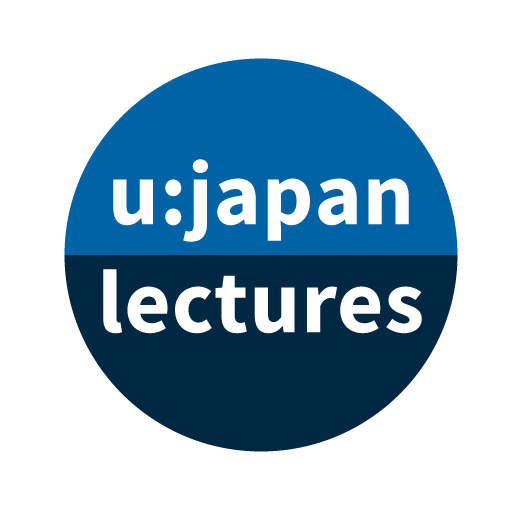Search Database by keyword
Browse Database Table
| Poster | lecture | ID | Date | Language | Name | Affiliation | Biographie | Lecture Title | Abstract | Video | Country | Mode | lecture_link | Research Question | Discipline | Methodology | Keywords | Primary Material | Literature | Stream | Material | Filter | Factsheet |
|---|---|---|---|---|---|---|---|---|---|---|---|---|---|---|---|---|---|---|---|---|---|---|---|
| Pre-Season | Spring-Summer 2020 | s00e01 | 18/05/2020 | en | Nakao Maika | Nagasaki University | Maika Nakao is Assistant Professor at Nagasaki University and currently Research Fellow at the University of Vienna's history department. She is working on the cultural history of nuclear science and technology. After receiving her Ph.D. in history of science from the University of Tokyo (2015), she published two books,『核の誘惑: 戦前日本の科学文化と「原子力ユートピア」の出現』[Allure of Nuclear: Science Culture in Prewar Japan and the Emergence of "Atomic Utopia"] (Keisō Shōbō, 2015) and『科学者と魔法使いの弟子ー科学と非科学の境界ー』[Scientists and the Sorcerer's Apprentice: The Border between Science and Non-Science] (Seidosha, 2019). | Tracing Atomic Utopia and Dystopia in Japan | In prewar Japan, radiation was considered having positive effects on the human health and during the war, there were discourses embracing the production of atomic bombs. How was this positive image of radiation and nuclear weapons before and during the war created and what changed after the war? This talk explores the background and transition of the image of radiation and nuclear energy in Japan and shows how scientists, media, and the public were involved in the emergence of atomic utopia and dystopia | https://ustream.univie.ac.at/paella7/ui/watch.html?id=6dfbab01-9eb2-49a0-95ab-f5798d024614 | jp | online | https://japanologie.univie.ac.at/ujapanlectures/s00/#e01 | Science and Technology Studies (STS) and Digital Humanities, Sociology and Social Sciences, History and Archaeology | Has Video | |||||||||
| Pre-Season | Spring-Summer 2020 | s00e02 | 04/06/2020 | en | Marianna Zanetta | University of Turin | Marianna Zanetta is an independent researcher at the University of Turin (Dept. Cultures, Politics and Society) and a visiting scholar at Hosei Daigaku (International Studies). She obtained the PhD in 2016 at the Ecole Pratique des Hautes Etudes (Paris Sorbonne) in co-tutoring with the University of Turin, in Religious Anthropology and Far Eastern Studies. The PhD project focused mainly on the itako practices of northeast Japan, and their connection with family and ancestors. Today, she is working on two different areas: funeral and ritual practices in contemporary Japan, and the phenomenon of hikikomori in a comparative perspective with the Italian situation. | Shamanic practices in contemporary Japan: Local habits and national fascination | Contemporary Japan still cherishes a significant variety of the so called “minkan fusha”, popular religions practitioners (often translated with the term “shaman”) who work as mediators between the world of the living and the dimension of the sacred. They are mainly women, and their role went through some significant transformations in the course of the last three centuries. Today, these shamans (heiresses of older traditions) are facing different challenges, while their profession is evolving to answer the new needs and questions of their clients. This talk explores the transformative and inventive process of these practices, and how in today Japan minkan fusha are regarded in the local communities and at a national level. | https://ustream.univie.ac.at/paella7/ui/watch.html?id=3dc2e5ca-1065-43b3-83ad-afae42e74be7 | it | online | https://japanologie.univie.ac.at/ujapanlectures/s00/#e02 | Religion and Philosophy, Anthropology and Ethnography | Has Video | |||||||||
| Pre-Season | Spring-Summer 2020 | s00e03 | 18/06/2020 | en | Marc Yamada | Brigham Young University | Marc Yamada is Associate Professor of Interdisciplinary Humanities at Brigham Young University. He received a PhD in Japanese Literature & Film from UC Berkeley. He has published articles on modern Japanese literature, film, and manga and a book on Japan's Heisei Period. He is currently working on a book on filmmaker Kore-eda Hirokazu. | Locating Heisei in Japanese Film: The Historical Imagination of the Lost Decades | Through an examination of the films of major Heisei filmmakers—including Kurosawa Kiyoshi, Ichikawa Jun, Kore-eda Hirokazu, Sono Shion, and others—it explores the dissonance between the dominant history of Japan’s recent past and the representation of this past in the popular imagination of the period. Along with posing a challenge to normative accounts of history, Heisei film, this presentation will also suggest, explores new forms of referentiality between contemporary Japan and its past. | https://ustream.univie.ac.at/paella7/ui/watch.html?id=d078e565-a29f-4308-b373-69b374684b40 | us | online | https://japanologie.univie.ac.at/ujapanlectures/s00/#e03 | Literature and Media Studies, Arts (visual arts and performing arts) and Art History | Has Video | |||||||||
| Pre-Season | Spring-Summer 2020 | s00e04 | 25/06/2020 | en | Arthur Mitteau | Paris EHESS’s Centre for Studies on Corea, China and Japan (CCJ) | Arthur Mitteau is a junior research associate at Paris EHESS’s Centre for Studies on Corea, China and Japan (CCJ), and will be working as an associate professor at France Aix-Marseille University from next fall. He studies the history of aesthetics, defined as ideas and discourses on art, while also collaborating to researches on art history and cultural history, mainly around the worlds of painting and of tea gatherings in Meiji era Japan. Recent works include articles in French, and participation to CIHA (International Committee for Art History)’s 34th international symposium in Tokyo in 2019. He is currently working on a book, which projected content will be the topic of the lecture. | From Fenollosa to kokubungaku – aesthetics and the birth of the utsukushii Nihon | In this lecture, we will explore the shift from the generation building, in the 1880s and 1890s, the first iterations of modern aesthetical discourse, with writers such as Ernest Fenollosa, Tsubouchi Shôyô and Okakura Tenshin, to another group in the 1920s and the 1930s, men that first held the newly created chairs of aesthetics at Imperial Universities, such as Ôtsuka Yasuji or Ônishi Yoshinori. This shift has implications for contemporary Japan, down to politics of identity, since that second generation was responsible for the “re-invention” of aesthetical notions picked in Japan’s past, such as wabi, yûgen and aware. How did we come from a model that included, in the first half of Meiji era, almost nothing of what is considered today as hallmarks of Japanese aesthetical characteristics, such as minimalism, the sense of nature or sensibility projected within objects (aware), to our actual set of representations that build up, around such stereotypes, an image of Japan as the land of beauty, with the blessing of some of nowadays’ political speeches and cultural policy? | https://ustream.univie.ac.at/paella7/ui/watch.html?id=621dbd02-f994-4408-ae64-7d5ce4697ae6 | fr | online | https://japanologie.univie.ac.at/ujapanlectures/s00/#e04 | Religion and Philosophy, History and Archaeology | Has Video | |||||||||
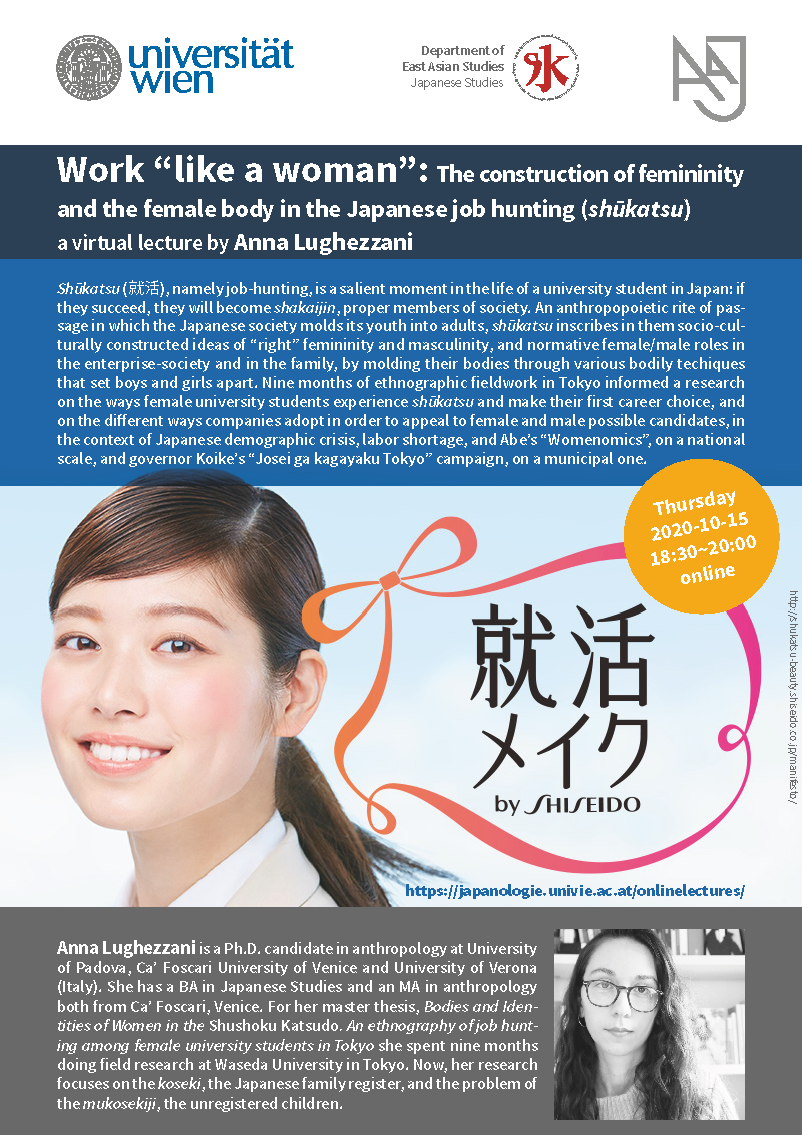 |
Season 1 | Autumn-Winter 2020/21 | s01e01 | 15/10/2020 | en | Anna Lughezzani | University of Padova, Ca’ Foscari University of Venice and University of Verona | Anna Lughezzani is a Ph.D. candidate in anthropology at University of Padova, Ca’ Foscari University of Venice and University of Verona (Italy). She has a BA in Japanese Studies and an MA in anthropology both from Ca’ Foscari, Venice. For her master thesis, Bodies and Identities of Women in the Shūshoku Katsudo. An ethnography of job hunting among female university students in Tokyo she spent nine months doing field research at Waseda University in Tokyo. Now, her research focuses on the koseki, the Japanese family register, and the problem of the mukosekiji, the unregistered children. | Work "like a woman": The construction of femininity and the female body in the Japanese job hunting | Shūkatsu (就活), namely job-hunting, is a salient moment in the life of a university student in Japan: if they succeed, they will become shakaijin, proper members of society. An anthropopoietic rite of passage in which the Japanese society molds its youth into adults, shūkatsu inscribes in them socio-culturally constructed ideas of “right” femininity and masculinity, and normative female/male roles in the enterprise-society and in the family, by molding their bodies through various bodily techiques that set boys and girls apart. Nine months of ethnographic fieldwork in Tokyo informed a research on the ways female university students experience shūkatsu and make their first career choice, and on the different ways companies adopt in order to appeal to female and male possible candidates, in the context of Japanese demographic crisis, labor shortage, and Abe’s “Womenomics”, on a national scale, and governor Koike’s “Josei ga kagayaku Tokyo” campaign, on a municipal one. | https://ustream.univie.ac.at/paella7/ui/watch.html?id=79e66db2-313b-47e4-81d4-c9505e8b02cb | it | online | https://japanologie.univie.ac.at/ujapanlectures/s01/#e01 | How are job hunting activities related to the reproduction of normative femininity in contemporary Japan? | Gender Studies and Minority Studies, Economics and Business Studies, Sociology and Social Sciences | ethnography, fieldwork observation, interviews | shūkatsu (job hunting), normative femininity, employment discrimination, techniques of the body, secular ritual | Fieldwork observation (job fairs, seminars), Interviews with female and male students, liaison administrators, human resource managers, Manuals and other documents on the job application process (print and online) | Kawanishi, Yuko. 2020. ‘Shūkatsu utsu, the Psychological Toll of Job-Hunting in Japan,’ electronic journal of contemporary japanese studies 20/3. https://japanesestudies.org.uk/ejcjs/vol20/iss3/kawanishi.html | Has Video, Has classroom material | |||
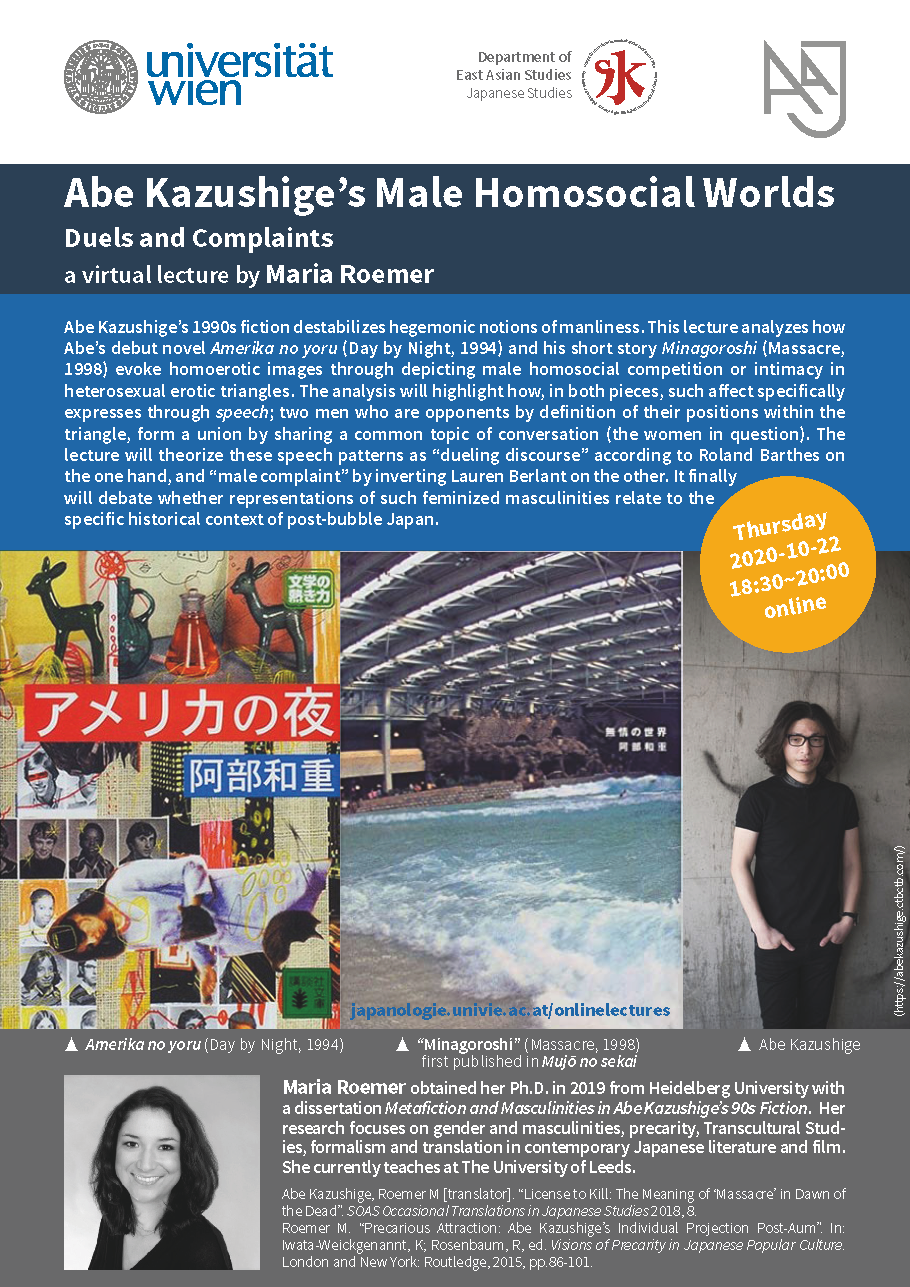 |
Season 1 | Autumn-Winter 2020/21 | s01e02 | 22/10/2020 | en | Maria Roemer | University of Leeds | Maria Roemer obtained her Ph.D. in 2019 from Heidelberg University with a dissertation Metafiction and Masculinities in Abe Kazushige's 90s Fiction. Her research focuses on gender and masculinities, precarity, Transcultural Studies, formalism and translation in contemporary Japanese literature and film. She currently teaches at The University of Leeds. | Abe Kazushige’s Male Homosocial Worlds: Duels and Complaints | Abe Kazushige’s 1990s fiction destabilizes hegemonic notions of manliness. This lecture analyzes how Abe’s debut novel Amerika no yoru (Day by Night, 1994) and his short story Minagoroshi (Massacre, 1998) evoke homoerotic images through depicting male homosocial competition or intimacy in heterosexual erotic triangles. The analysis will highlight how, in both pieces, such affect specifically expresses through speech; two men who are opponents by definition of their positions within the triangle, form a union by sharing a common topic of conversation (the women in question). The lecture will theorize these speech patterns as “dueling discourse” according to Roland Barthes on the one hand, and “male complaint” by inverting Lauren Berlant on the other. It finally will debate whether representations of such feminized masculinities relate to the specific historical context of post-bubble Japan. | https://ustream.univie.ac.at/paella7/ui/watch.html?id=0a88f8f9-482d-4506-b68e-edd9a9aa729d | uk | online | https://japanologie.univie.ac.at/ujapanlectures/s01/#e02 | Literature and Media Studies, Gender Studies and Minority Studies | Has Video | ||||||||
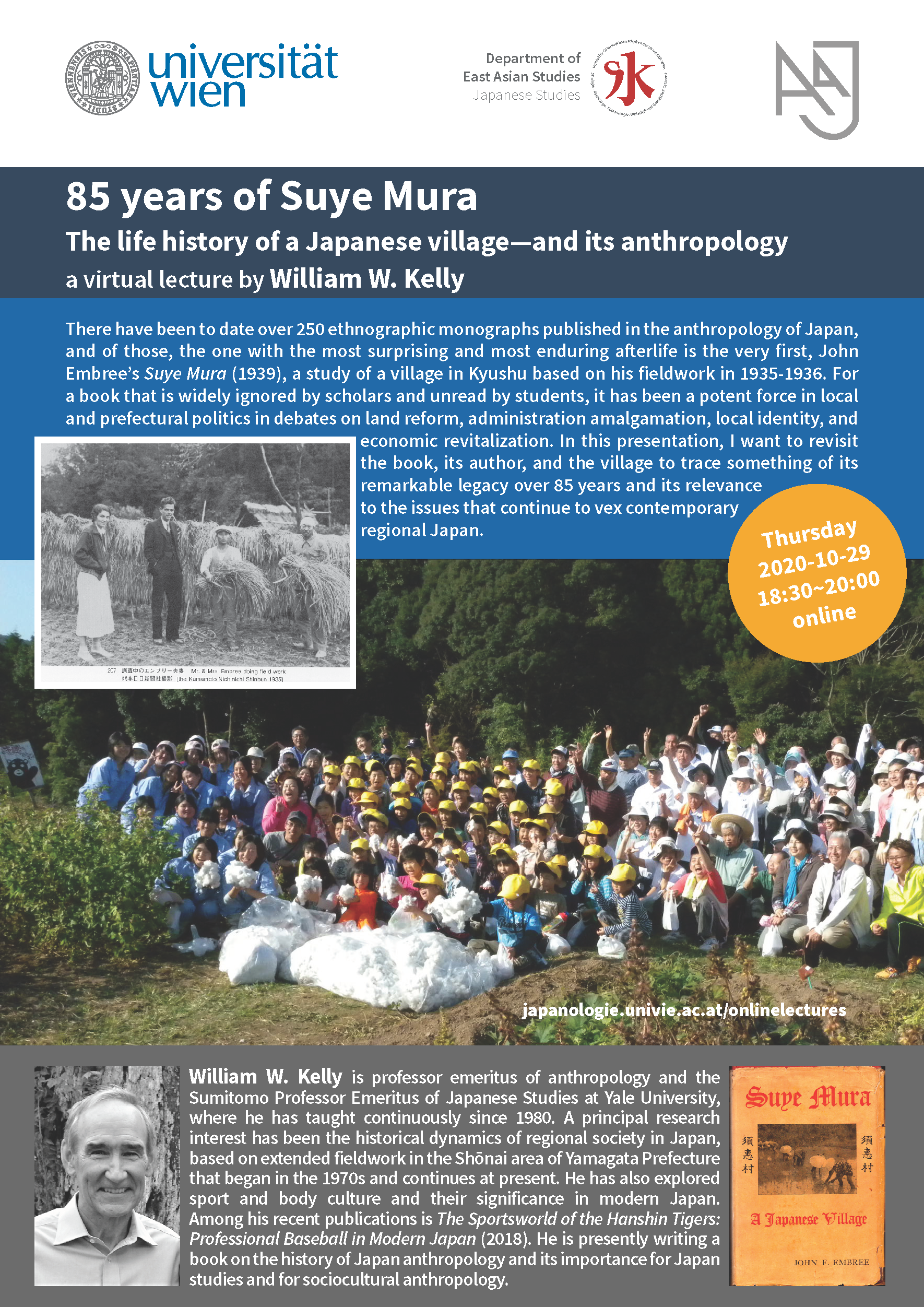 |
Season 1 | Autumn-Winter 2020/21 | s01e03 | 29/10/2020 | en | William Kelly | Yale University | William W. Kelly is professor emeritus of anthropology and the Sumitomo Professor Emeritus of Japanese Studies at Yale University, where he has taught continuously since 1980. A principal research interest has been the historical dynamics of regional society in Japan, based on extended fieldwork in the Shōnai area of Yamagata Prefecture that began in the 1970s and continues at present. He has also explored sport and body culture and their significance in modern Japan. Among his recent publications is The Sportsworld of the Hanshin Tigers: Professional Baseball in Modern Japan (2018). He is presently writing a book on the history of Japan anthropology and its importance for Japan studies and for sociocultural anthropology. | 85 years of Suye Mura: The life history of a Japanese village—and its anthropology | There have been to date over 250 ethnographic monographs published in the anthropology of Japan, and of those, the one with the most surprising and most enduring afterlife is the very first, John Embree’s Suye Mura (1939), a study of a village in Kyushu based on his fieldwork in 1935-1936. For a book that is widely ignored by scholars and unread by students, it has been a potent force in local and prefectural politics in debates on land reform, administration amalgamation, local identity, and economic revitalization. In this presentation, I want to revisit the book, its author, and the village to trace something of its remarkable legacy over 85 years and its relevance to the issues that continue to vex contemporary regional Japan. | https://ustream.univie.ac.at/paella7/ui/watch.html?id=0390cd6a-5cf2-4c61-88b5-b249dcd89b39 | us | online | https://japanologie.univie.ac.at/ujapanlectures/s01/#e03 | Anthropology and Ethnography, Sociology and Social Sciences, History and Archaeology | Has Video | ||||||||
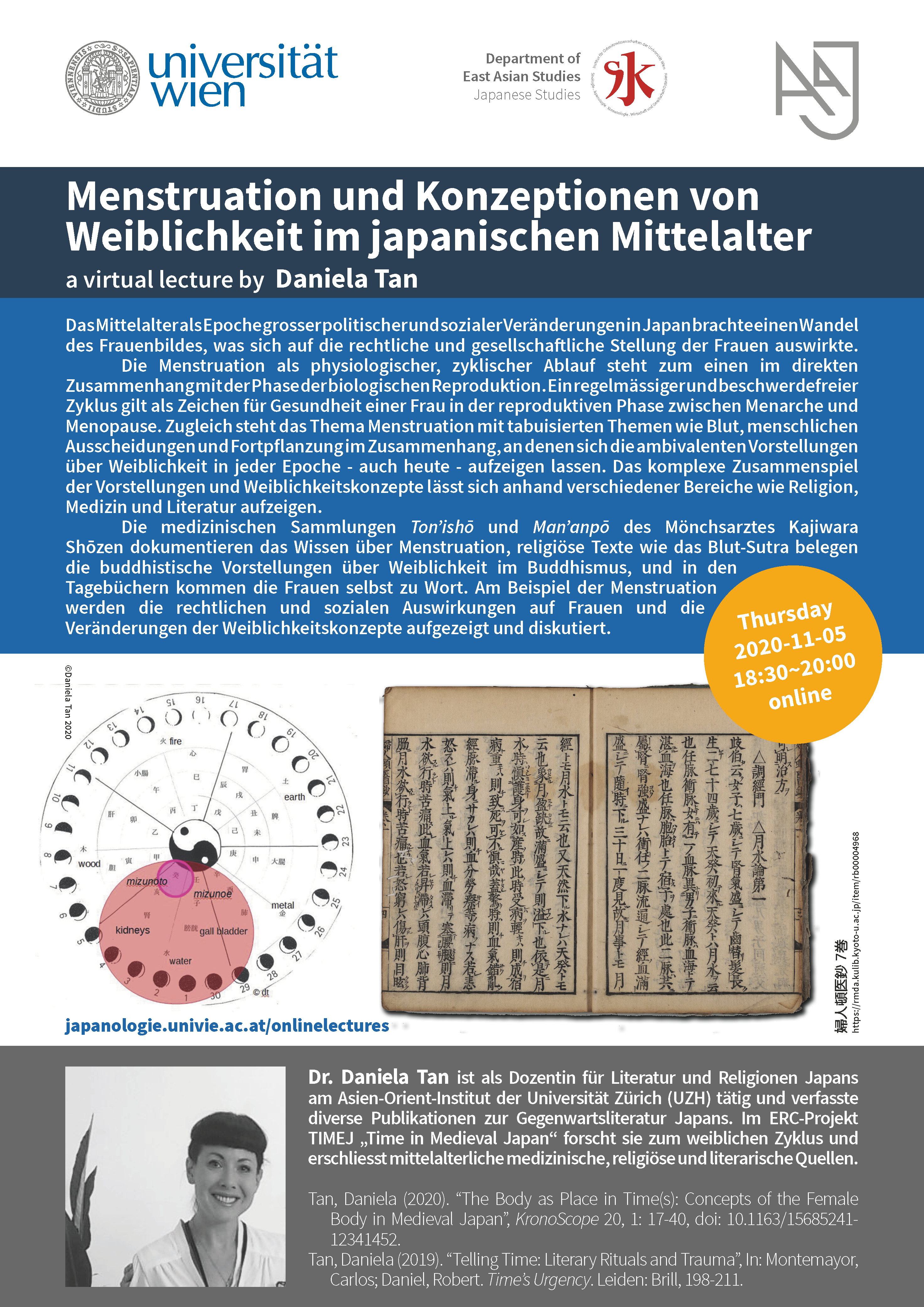 |
Season 1 | Autumn-Winter 2020/21 | s01e04 | 05/11/2020 | de | Daniela Tan | Universität Zürich (UZH) | Dr. Daniela Tan ist als Dozentin für Literatur und Religionen Japans am Asien-Orient-Institut der Universität Zürich (UZH) tätig und verfasste diverse Publikationen zur Gegenwartsliteratur Japans. Im ERC-Projekt TIMEJ „Time in Medieval Japan“ forscht sie zum weiblichen Zyklus und erschliesst mittelalterliche medizinische, religiöse und literarische Quellen. | Menstruation und Konzeptionen von Weiblichkeit im japanischen Mittelalter | Das Mittelalter als Epoche grosser politischer und sozialer Veränderungen in Japan brachte einen Wandel des Frauenbildes, was sich auf die rechtliche und gesellschaftliche Stellung der Frauen auswirkte. Die Menstruation als physiologischer, zyklischer Ablauf steht zum einen im direkten Zusammenhang mit der Phase der biologischen Reproduktion. Ein regelmässiger und beschwerdefreier Zyklus gilt als Zeichen für Gesundheit einer Frau in der reproduktiven Phase zwischen Menarche und Menopause. Zugleich steht das Thema Menstruation mit tabuisierten Themen wie Blut, menschlichen Ausscheidungen und Fortpflanzung im Zusammenhang, an denen sich die ambivalenten Vorstellungen über Weiblichkeit in jeder Epoche - auch heute - aufzeigen lassen. Das komplexe Zusammenspiel der Vorstellungen und Weiblichkeitskonzepte lässt sich anhand verschiedener Bereiche wie Religion, Medizin und Literatur aufzeigen. Die medizinischen Sammlungen Ton'ishō und Man'anpō des Mönchsarztes Kajiwara Shōzen dokumentieren das Wissen über Menstruation, religiöse Texte wie das Blut-Sutra belegen die buddhistische Vorstellungen über Weiblichkeit im Buddhismus, und in den Tagebüchern kommen die Frauen selbst zu Wort. Am Beispiel der Menstruation werden die rechtlichen und sozialen Auswirkungen auf Frauen und die Veränderungen der Weiblichkeitskonzepte aufgezeigt und diskutiert. Am Beispiel der Menstruation werden die rechtlichen und sozialen Auswirkungen auf Frauen und die Veränderungen der Weiblichkeitskonzepte aufgezeigt und diskutiert. | ch | online | https://japanologie.univie.ac.at/ujapanlectures/s01/#e04 | Gender Studies and Minority Studies, History and Archaeology | ||||||||||
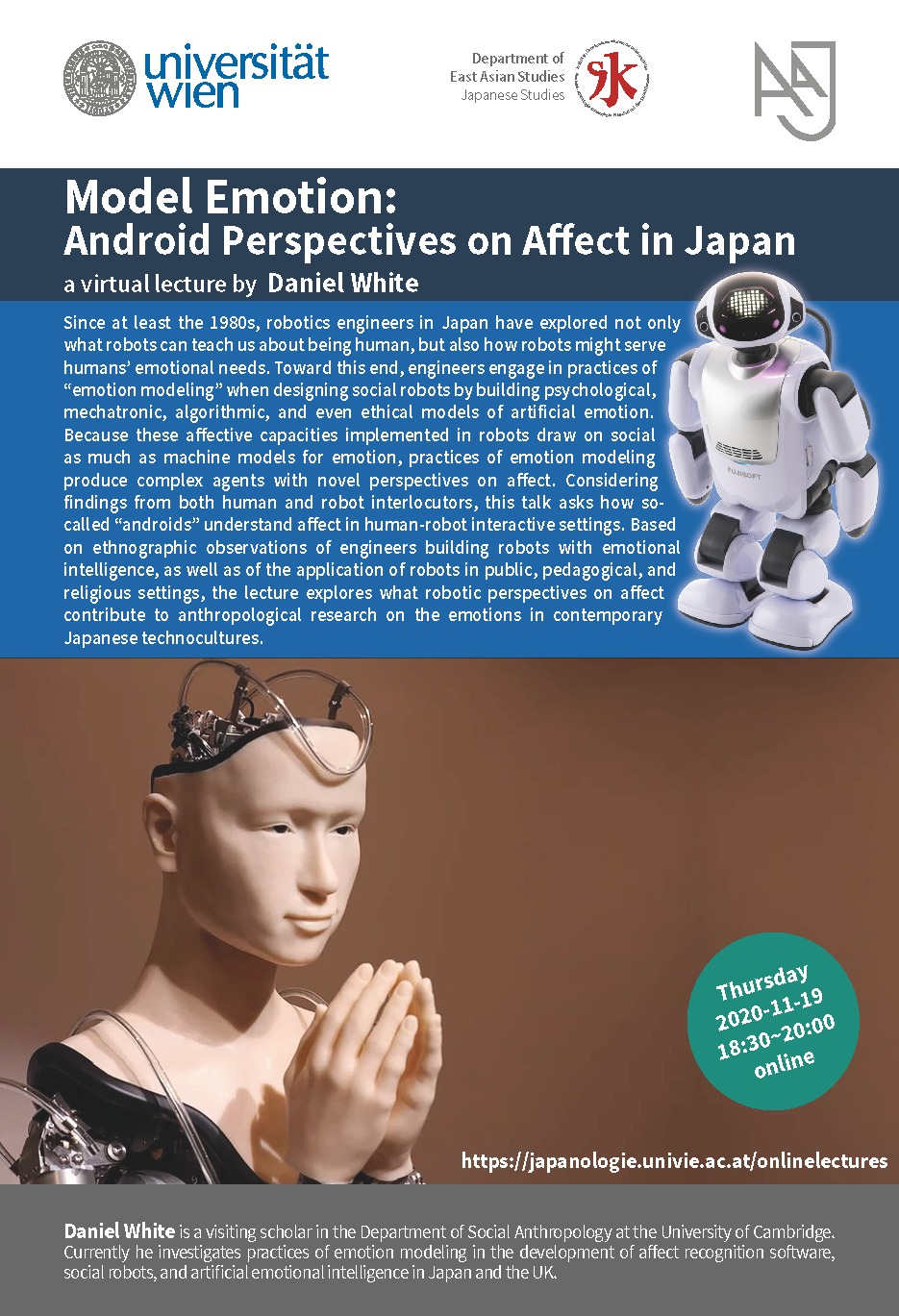 |
Season 1 | Autumn-Winter 2020/21 | s01e05 | 19/11/2020 | en | Daniel White | University of Cambridge | Daniel White is a visiting scholar in the Department of Social Anthropology at the University of Cambridge. Currently he investigates practices of emotion modeling in the development of affect recognition software, social robots, and artificial emotional intelligence in Japan and the UK. | Model Emotion: Android Perspectives on Affect in Japan | Since at least the 1980s, robotics engineers in Japan have explored not only what robots can teach us about being human, but also how robots might serve humans’ emotional needs. Toward this end, engineers engage in practices of “emotion modeling” when designing social robots by building psychological, mechatronic, algorithmic, and even ethical models of artificial emotion. Because these affective capacities implemented in robots draw on social as much as machine models for emotion, practices of emotion modeling produce complex agents with novel perspectives on affect. Considering findings from both human and robot interlocutors, this talk asks how so-called “androids” understand affect in human-robot interactive settings. Based on ethnographic observations of engineers building robots with emotional intelligence, as well as of the application of robots in public, pedagogical, and religious settings, the lecture explores what robotic perspectives on affect contribute to anthropological research on the emotions in contemporary Japanese technocultures. | https://ustream.univie.ac.at/paella7/ui/watch.html?id=ca7aaadc-16b9-48c2-b82f-e9968d1633ca | uk | online | https://japanologie.univie.ac.at/ujapanlectures/s01/#e05 | Science and Technology Studies (STS) and Digital Humanities, Anthropology and Ethnography | Has Video | ||||||||
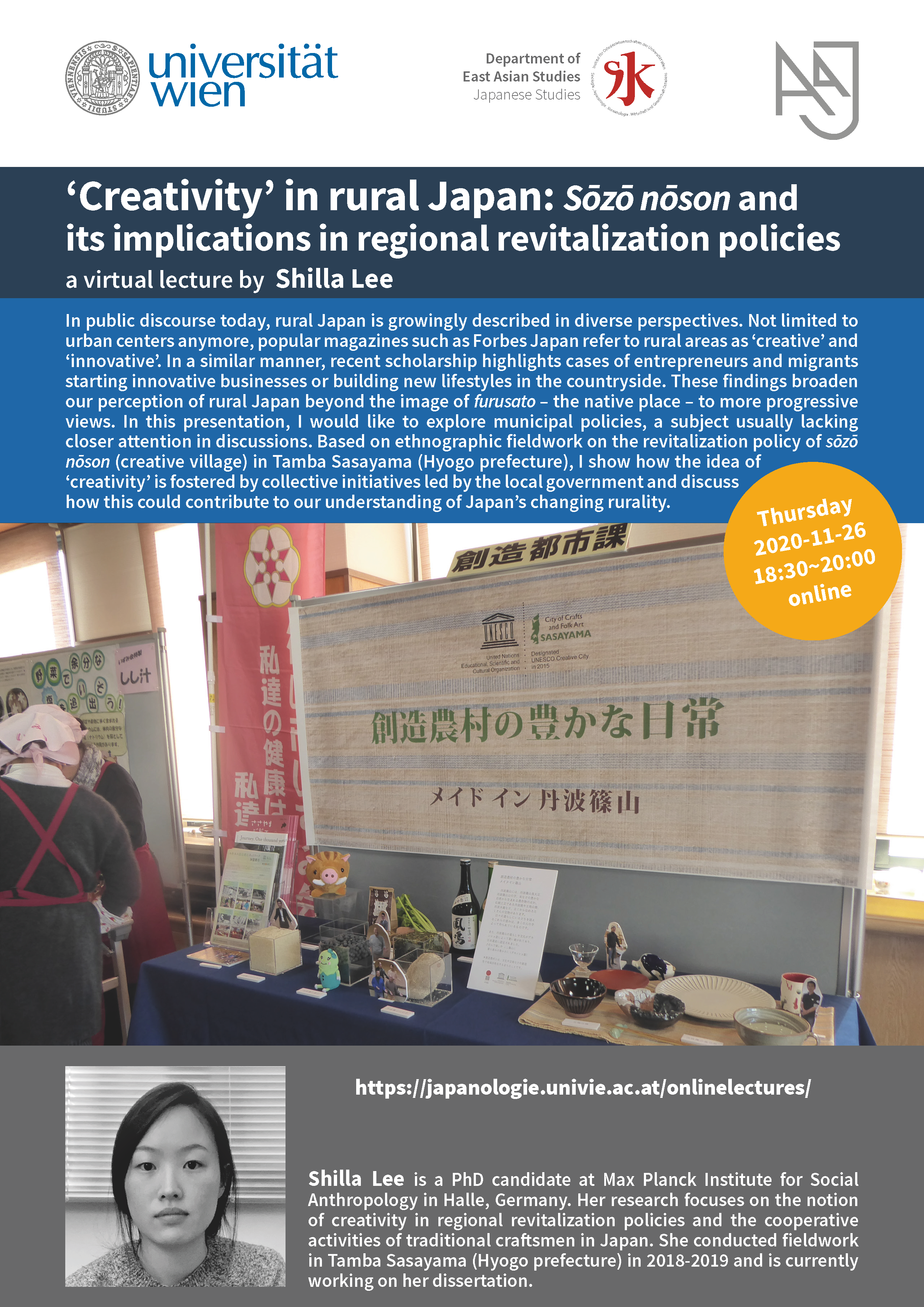 |
Season 1 | Autumn-Winter 2020/21 | s01e06 | 26/11/2020 | en | Shilla Lee | Max Planck Institute for Social Anthropology | Shilla Lee is a PhD candidate at Max Planck Institute for Social Anthropology in Halle, Germany. Her research focuses on the notion of creativity in regional revitalization policies and the cooperative activities of traditional craftsmen in Japan. She conducted fieldwork in Tamba Sasayama (Hyogo prefecture) in 2018-2019 and is currently working on her dissertation. | ‘Creativity’ in rural Japan: Sōzō nōson and its implications in regional revitalization policies | In public discourse today, rural Japan is growingly described in diverse perspectives. Not limited to urban centers anymore, popular magazines such as Forbes Japan refer to rural areas as ‘creative’ and ‘innovative’. In a similar manner, recent scholarship highlights cases of entrepreneurs and migrants starting innovative businesses or building new lifestyles in the countryside. These findings broaden our perception of rural Japan beyond the image of furusato – the native place – to more progressive views. In this presentation, I would like to explore municipal policies, a subject usually lacking closer attention in discussions. Based on ethnographic fieldwork on the revitalization policy of sōzō nōson (creative village) in Tamba Sasayama (Hyogo prefecture), I show how the idea of ‘creativity’ is fostered by collective initiatives led by the local government and discuss how this could contribute to our understanding of Japan’s changing rurality. | https://ustream.univie.ac.at/paella7/ui/watch.html?id=bffdb211-4f61-4c20-9427-e6f59c0c4251 | de | online | https://japanologie.univie.ac.at/ujapanlectures/s01/#e06 | Sociology and Social Sciences, Economics and Business Studies | Has Video | ||||||||
 |
Season 1 | Autumn-Winter 2020/21 | s01e07 | 10/12/2020 | en | Paulina Kolata | University of Manchester / Lund University | Paulina Kolata obtained her PhD in 2019 from The University of Manchester. She is a Postdoctoral Research Associate at Manchester Metropolitan University and an Early Career Research Fellow at The University of Manchester. Her doctoral work investigated the religious, economic, and social impact of depopulation and demographic ageing in Buddhist temple communities in regional Japan. Currently she is developing a book manuscript based on her doctoral research. | Storehouses of value: materiality of belonging in Japanese Buddhist temples | What, how, and why people “store” at local Buddhist temples? Can biographies of things deposited at a local temple tell a story of a community? How do people’s individual material histories become matters of communal concern? While walking a fine line between memory and abandonment, we will discover and map out the material and affective networks of community preservation in Japan’s depopulating regions. We will travel to rural Hiroshima Prefecture to imagine Japanese Buddhist temple communities as storehouses of value and consider Buddhist institutions’ role as anchors of people’s belonging in contemporary Japan. By stepping into the shoes of a local Buddhist priest at Myōkoji temple, we will walk down the corridors of donated artwork, photo albums, plane propellers, Buddhist altars, people’s ashes, and entire households to reveal physical, karmic, and emotional connections people strive to maintain and, in turn, make sense of the anticipated decline in their communities. | https://ustream.univie.ac.at/paella7/ui/watch.html?id=6fa09ec6-3dfa-4c8c-b995-5bbf324e6e95 | uk, se | online | https://japanologie.univie.ac.at/ujapanlectures/s01/#e07 | Religion and Philosophy, Anthropology and Ethnography | Has Video | ||||||||
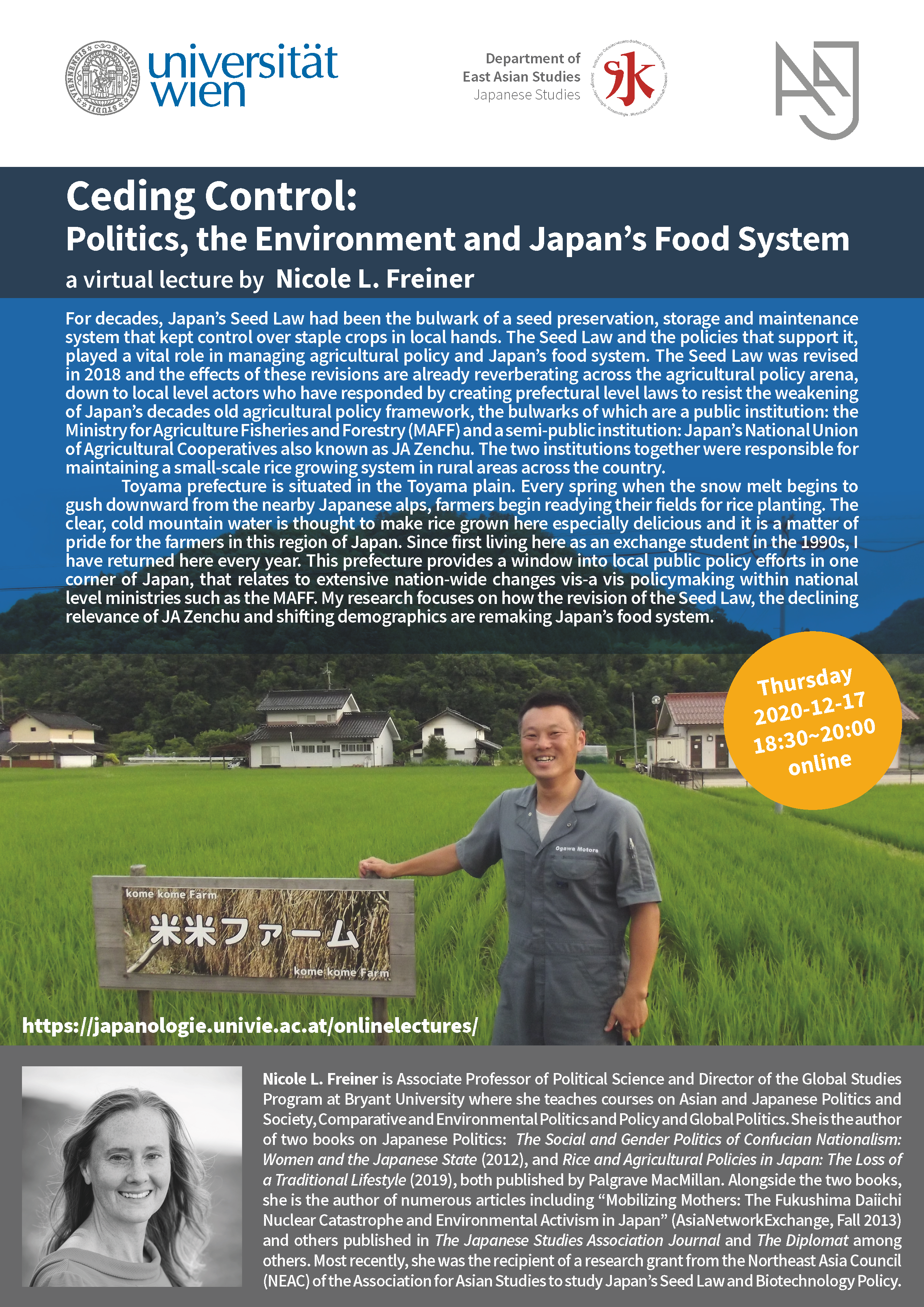 |
Season 1 | Autumn-Winter 2020/21 | s01e08 | 17/12/2020 | en | Nicole Freiner | Bryant University | Nicole L. Freiner is Associate Professor of Political Science and Director of the Global Studies Program at Bryant University where she teaches courses on Asian and Japanese Politics and Society, Comparative and Environmental Politics and Policy and Global Politics. She is the author of two books on Japanese Politics: The Social and Gender Politics of Confucian Nationalism: Women and the Japanese State (2012), and Rice and Agricultural Policies in Japan: The Loss of a Traditional Lifestyle (2019), both published by Palgrave MacMillan. Alongside the two books, she is the author of numerous articles including “Mobilizing Mothers: The Fukushima Daiichi Nuclear Catastrophe and Environmental Activism in Japan” (AsiaNetworkExchange, Fall 2013) and others published in The Japanese Studies Association Journal and The Diplomat among others. Most recently, she was the recipient of a research grant from the Northeast Asia Council (NEAC) of the Association for Asian Studies to study Japan’s Seed Law and Biotechnology Policy. | Ceding Control: Politics, the Environment and Japan’s Food System | For decades, Japan’s Seed Law had been the bulwark of a seed preservation, storage and maintenance system that kept control over staple crops in local hands. The Seed Law and the policies that support it, played a vital role in managing agricultural policy and Japan’s food system. The Seed Law was revised in 2018 and the effects of these revisions are already reverberating across the agricultural policy arena, down to local level actors who have responded by creating prefectural level laws to resist the weakening of Japan’s decades old agricultural policy framework, the bulwarks of which are a public institution: the Ministry for Agriculture Fisheries and Forestry (MAFF) and a semi-public institution: Japan’s National Union of Agricultural Cooperatives also known as JA Zenchu. The two institutions together were responsible for maintaining a small-scale rice growing system in rural areas across the country. Toyama prefecture is situated in the Toyama plain. Every spring when the snow melt begins to gush downward from the nearby Japanese alps, farmers begin readying their fields for rice planting. The clear, cold mountain water is thought to make rice grown here especially delicious and it is a matter of pride for the farmers in this region of Japan. Since first living here as an exchange student in the 1990s, I have returned here every year. This prefecture provides a window into local public policy efforts in one corner of Japan, that relates to extensive nation-wide changes vis-a vis policymaking within national level ministries such as the MAFF. My research focuses on how the revision of the Seed Law, the declining relevance of JA Zenchu and shifting demographics are remaking Japan’s food system. | us | online | https://japanologie.univie.ac.at/ujapanlectures/s01/#e08 | Agriculture and Rural Studies, Science and Technology Studies (STS) and Digital Humanities, Sociology and Social Sciences | ||||||||||
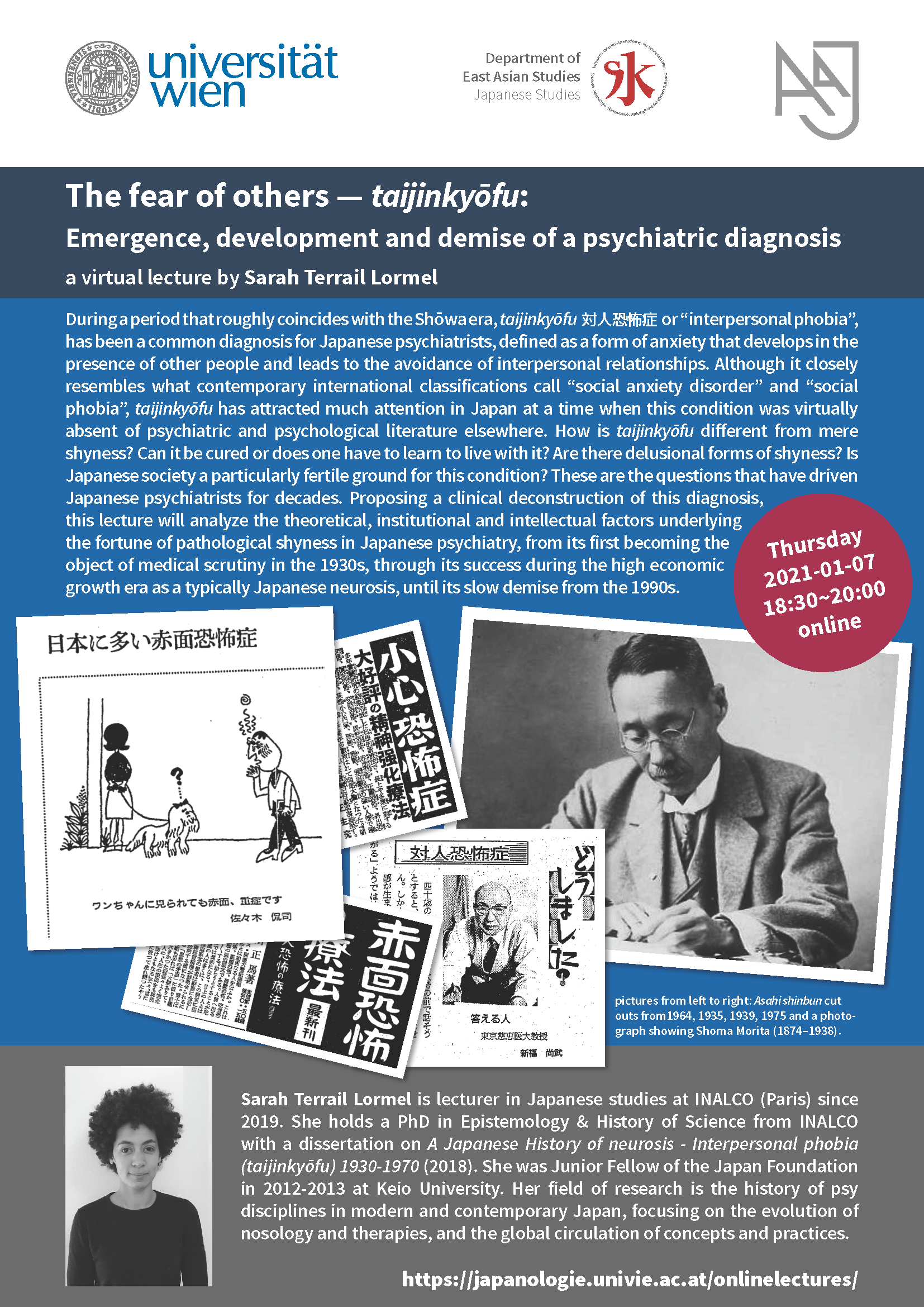 |
Season 1 | Autumn-Winter 2020/21 | s01e09 | 07/01/2021 | en | Sarah Terrail Lormel | INALCO (Paris) | Sarah Terrail Lormel is lecturer in Japanese studies at INALCO (Paris) since 2019. She holds a PhD in Epistemology & History of Science from INALCO with a dissertation on A Japanese History of neurosis - Interpersonal phobia (taijinkyōfu) 1930-1970 (2018). She was Junior Fellow of the Japan Foundation in 2012-2013 at Keio University. Her field of research is the history of psy disciplines in modern and contemporary Japan, focusing on the evolution of nosology and therapies, and the global circulation of concepts and practices | The fear of others – Taijinkyōfu: Emergence, development and demise of a psychiatric diagnosis | During a period that roughly coincides with the Shōwa era, taijinkyōfu or “interpersonal phobia”, has been a common diagnosis for Japanese psychiatrists, defined as a form of anxiety that develops in the presence of other people and leads to the avoidance of interpersonal relationships. Although it closely resembles what contemporary international classifications call “social anxiety disorder” and “social phobia”, taijinkyōfu has attracted much attention in Japan at a time when this condition was virtually absent of psychiatric and psychological literature elsewhere. How is taijinkyōfu different from mere shyness? Can it be cured or does one have to learn to live with it? Are there delusional forms of shyness? Is Japanese society a particularly fertile ground for this condition? These are the questions that have driven Japanese psychiatrists for decades. Proposing a clinical deconstruction of this diagnosis, this lecture will analyze the theoretical, institutional and intellectual factors underlying the fortune of pathological shyness in Japanese psychiatry, from its first becoming the object of medical scrutiny in the 1930s, through its success during the high economic growth era as a typically Japanese neurosis, until its slow demise from the 1990s. | https://ustream.univie.ac.at/paella7/ui/watch.html?id=1acc3c95-97bc-46a9-bd6e-f628d6e74557 | fr | online | https://japanologie.univie.ac.at/ujapanlectures/s01/#e09 | Psychology and Medicine, History and Archaeology | Has Video | ||||||||
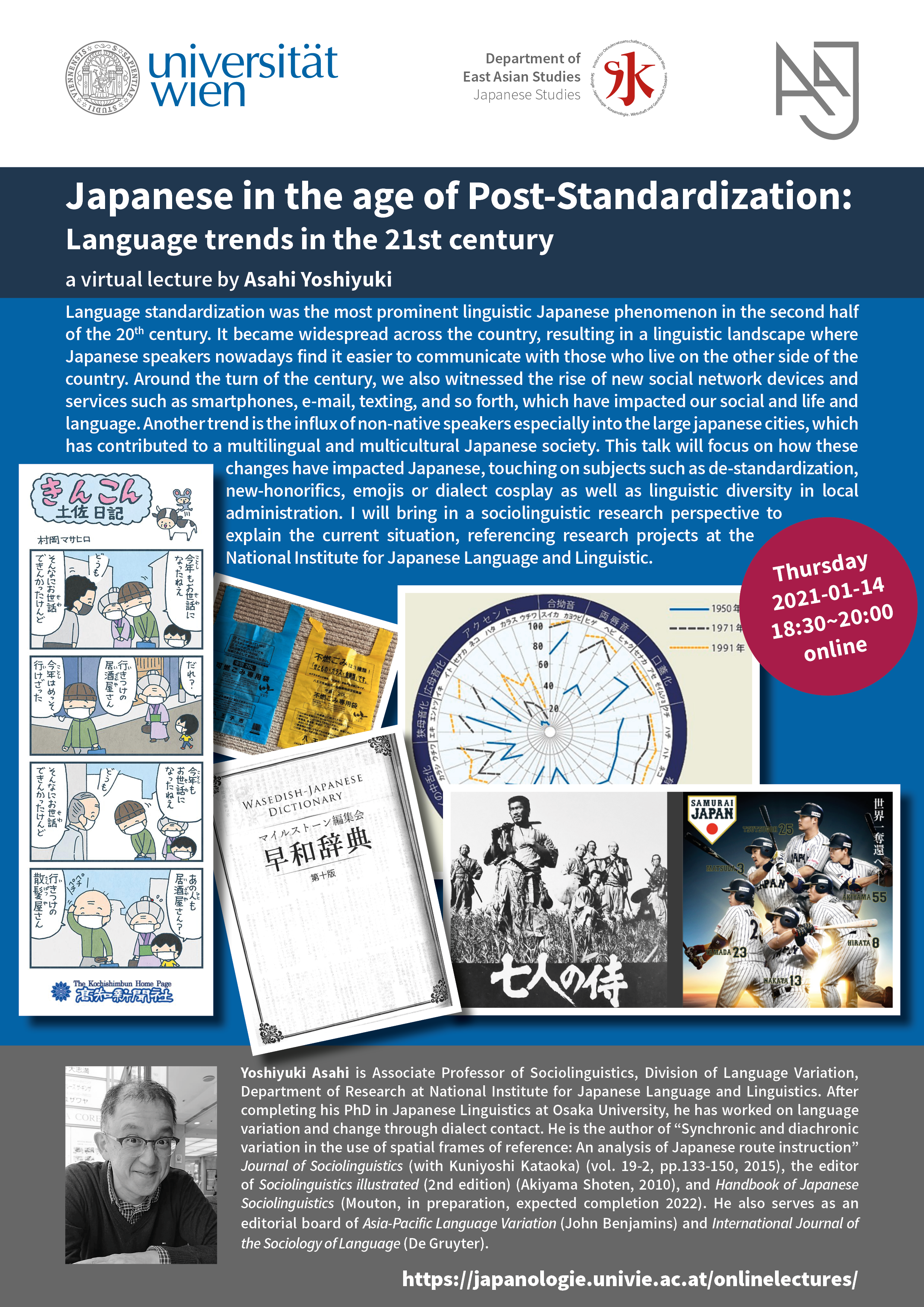 |
Season 1 | Autumn-Winter 2020/21 | s01e10 | 14/01/2021 | en | Asahi Yoshiyuki | National Institute for Japanese Language and Linguistics | Yoshiyuki Asahi is Associate Professor of Sociolinguistics, Division of Language Variation, Department of Research at National Institute for Japanese Language and Linguistics. After completing his PhD in Japanese Linguistics at Osaka University, he has worked on language variation and change through dialect contact. He is the author of “Synchronic and diachronic variation in the use of spatial frames of reference: An analysis of Japanese route instruction” Journal of Sociolinguistics (with Kuniyoshi Kataoka) (vol. 19-2, pp.133-150, 2015), “Towards an integration of studies in honorifics and real-time language change studies”, The Japanese Journal of Language in Society, (with Kenjiro Matsuda) (Vol.11. no.1, pp.39-50, 2008), Saharin-ni Nokosareta Nihongo Karafuto Hogen [A Japanese dialect of Karafuto in Sakhalin Russia] (Meiji Shoin, 2012), Nyutaun Kotoba no Keisei-ni Kansuru Shakaigengogakuteki Kenkyu [A sociolinguistic study on the formation of a new town koine] (Hituzi Syobo, 2008), and the editor of Sociolinguistics illustrated (2nd edition) (Akiyama Shoten, 2010), and Handbook of Japanese Sociolinguistics (Mouton, in preparation, expected completion 2022). He also serves as an editorial board of Asia-Pacific Language Variation (John Benjamins) and International Journal of the Sociology of Language (De Gruyter). | Japanese in the Age of Post-Standardization: Language Trends in the 21st Century | Language standardization was the most prominent linguistic Japanese phenomenon in the second half of the 20th century. It became widespread across the country, resulting in a linguistic landscape where Japanese speakers nowadays find it easier to communicate with those who live on the other side of the country. Around the turn of the century, we also witnessed the rise of new social network devices and services such as smartphones, e-mail, texting, and so forth, which have impacted our social and life and language. Another trend is the influx of non-native speakers especially into the large japanese cities, which has contributed to a multilingual and multicultural Japanese society. This talk will focus on how these changes have impacted Japanese, touching on subjects such as de-standardization, new-honorifics, emojis or dialect cosplay as well as linguistic diversity in local administration. I will bring in a sociolinguistic research perspective to explain the current situation, referencing research projects at the National Institute for Japanese Language and Linguistics. | https://ustream.univie.ac.at/paella7/ui/watch.html?id=990e78f3-6545-4784-98b5-965477098cc7 | jp | online | https://japanologie.univie.ac.at/ujapanlectures/s01/#e10 | Wie verlief die Standardisierung der japanischen Sprache im 20. Jahrhundert, und welche Formen der De-Standardisierung lassen sich aktuell beobachten? | Linguistics and Language Education, Sociology and Social Sciences | Medienanalyse & Quantitative Umfrage (random sample survey; panel survey) | Japanisch (Japanese), Standardisierung (Standardization), Post-Standardisierung (Post-Standardization), De-Standardisierung (De-Standardization), Sprachentrends (Language Trends) | Eichinger, Ludwig. 2015. „Normierung und Standardisierung der deutschen Sprache – Eine lange Geschichte kurz erzählt“, Wenjan Jia u.a. (Hg.): Sprache als Brücke der Kulturen. Sprachpolitik und Sprachwirklichkeit in Deutschland und China. Peking: ltrp.com, 168-184. | Asahi, Yoshiyuki, Usami Mayuma und Inoue Fumio (Hg.) 2022 Handbook of Japanese Sociolinguistics. Berlin und Bosten: De Gruyter. Asahi, Yoshiyuki und Kuniyoshi Kataoka | Has Video, Has classroom material | |||
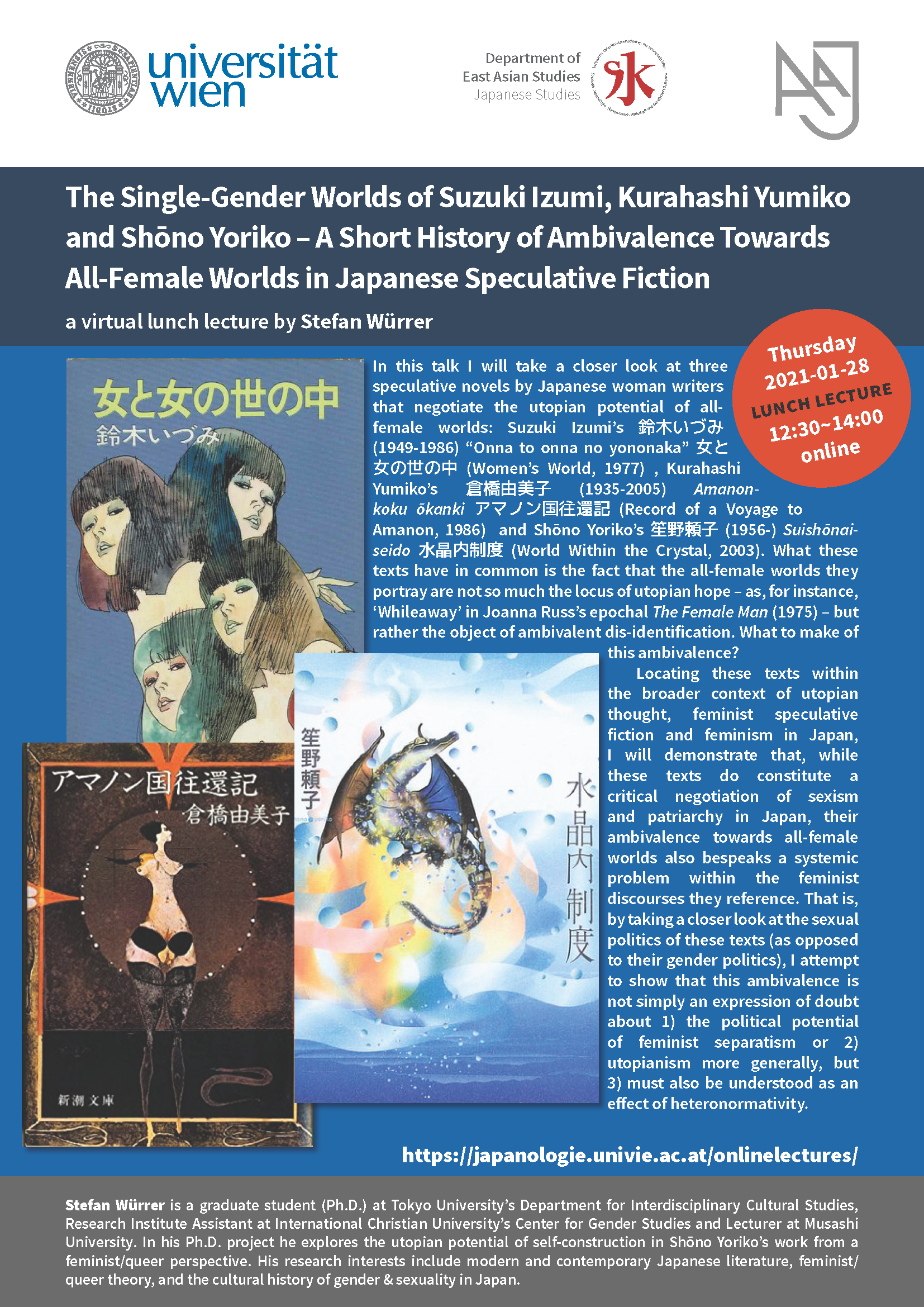 |
Season 1 | Autumn-Winter 2020/21 | s01e11 | 28/01/2021 | en | Stefan Würrer | International Christian University | Stefan Würrer is a graduate student (Ph.D.) at Tokyo University’s Department for Interdisciplinary Cultural Studies, Research Institute Assistant at International Christian University’s Center for Gender Studies and Lecturer at Musashi University. In his Ph.D. project he explores the utopian potential of self-construction in Shōno Yoriko’s work from a feminist/queer perspective. His research interests include modern and contemporary Japanese literature, feminist/queer theory, and the cultural history of gender & sexuality in Japan. | The Single-Gender Worlds of Suzuki Izumi, Kurahashi Yumiko and Shōno Yoriko – A Short History of Ambivalence Towards All-Female Worlds in Japanese Speculative Fiction | In this talk I will take a closer look at three speculative novels by Japanese woman writers that negotiate the utopian potential of all-female worlds: Suzuki Izumi’s 鈴木いづみ (1949-1986) “Onna to onna no yononaka” 女と女の世の中 (Women’s World, 1977) , Kurahashi Yumiko’s 倉橋由美子 (1935-2005) Amanon-koku ōkanki アマノン国往還記 (Record of a Voyage to Amanon, 1986) and Shōno Yoriko’s 笙野頼子 (1956-) Suishōnai-seido 水晶内制度 (World Within the Crystal, 2003). What these texts have in common is the fact that the all-female worlds they portray are not so much the locus of utopian hope – as, for instance, ‘Whileaway’ in Joanna Russ’s epochal The Female Man (1975) – but rather the object of ambivalent dis-identification. What to make of this ambivalence. Locating these texts within the broader context of utopian thought, feminist speculative fiction and feminism in Japan, I will demonstrate that, while these texts do constitute a critical negotiation of sexism and patriarchy in Japan, their ambivalence towards all-female worlds also bespeaks a systemic problem within the feminist discourses they reference. That is, by taking a closer look at the sexual politics of these texts (as opposed to their gender politics), I attempt to show that this ambivalence is not simply an expression of doubt about 1) the political potential of feminist separatism or 2) utopianism more generally, but 3) must also be understood as an effect of heteronormativity. | https://ustream.univie.ac.at/paella7/ui/watch.html?id=943370ba-9d95-44a1-b26b-512e846760e0 | jp | online | https://japanologie.univie.ac.at/ujapanlectures/s01/#e11 | Literature and Media Studies, Gender Studies and Minority Studies | Has Video | ||||||||
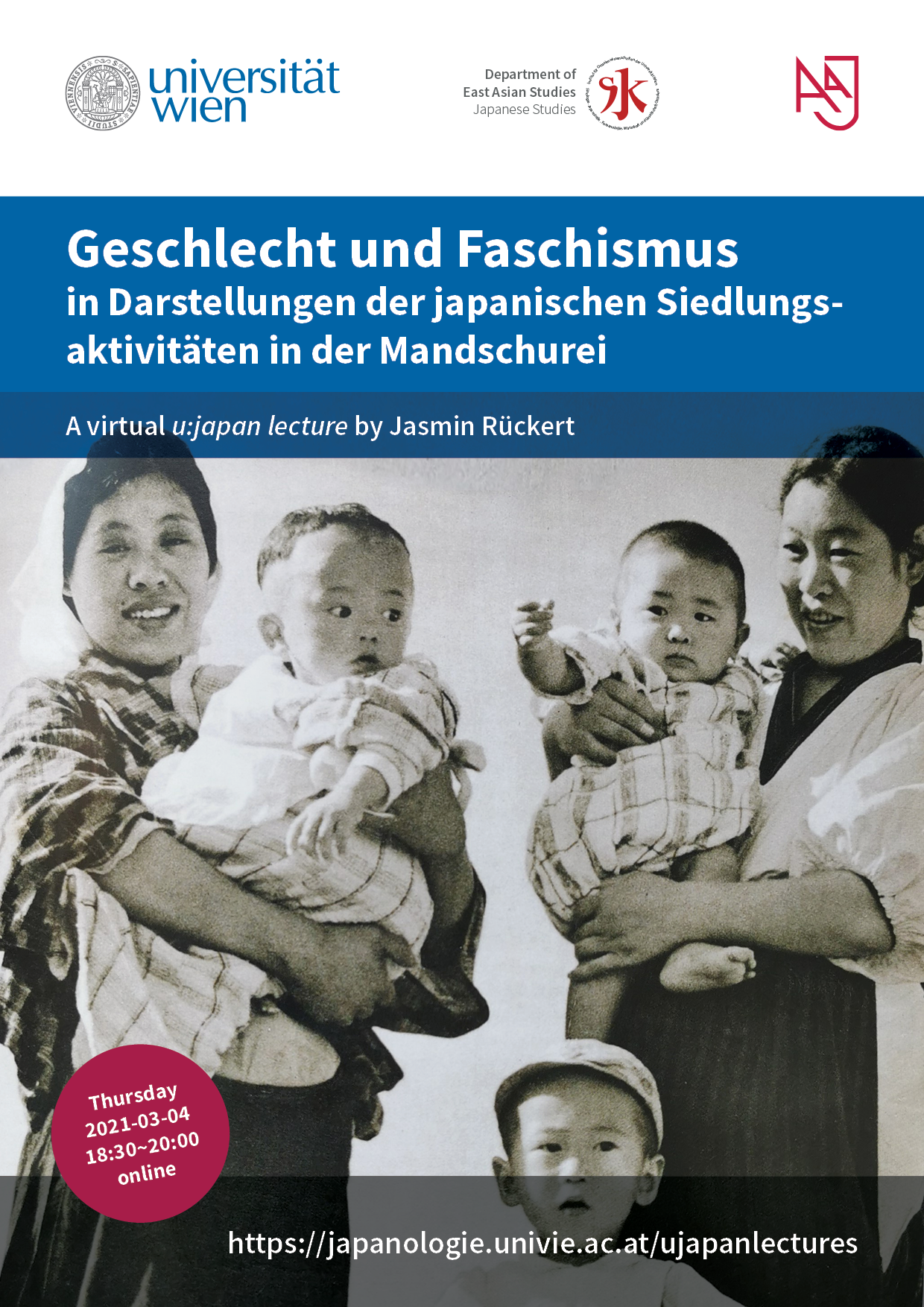 |
Season 2 | Spring 2021 | s02e01 | 04/03/2021 | de | Jasmin Rückert | Heinrich Heine University Düsseldorf | Jasmin Rückert studierte an der Universität Wien und der Universität Paris VII Diderot Japanologie, Kunstgeschichte und Gender Studies. Seit 2017 arbeitet sie als wissenschaftliche Mitarbeiterin an der Heinrich Heine Universität Düsseldorf und ist dort Projektmitarbeiterin bei Prof. Dr. Andrea Germer in dem Forschungsprojekt „Faschismus und Geschlecht: Visuelle Propaganda im Japan der Kriegszeit“. | Geschlecht und Faschismus in Darstellungen der japanischen Siedlungsaktivitäten in der Mandschurei | Während des Bestehens des „Puppenstaats“ Manchukuo investierten der japanische Staat und in der Mandschurei ansässige japanische Firmen mit unterschiedlichen Mitteln in die Verbreitung propagandistischer Repräsentationen der Region. Ein Beispiel für solche Propagandaproduktionen ist die Zeitschrift Manshū Gurafu („Manchuria Graph“), die im Mittelpunkt dieses Vortrages steht und unter Berücksichtigung des zeitgeschichtlichen Kontextes vorgestellt wird. Manshū Gurafu wurde zwischen 1932 und 1944 herausgegeben und von der Südmandschurischen Eisenbahn finanziert. Der frühere Avantgarde-Fotograf Fuchikami Hakuyō und seine Kollegen in der Mandschurischen Gesellschaft für Amateurfotographie prägten das Magazin maßgeblich. Sie bedienten sich stilistisch unter anderem aus dem Kanon sowjetischer Propaganda um die technologische Überlegenheit und einen von Japan angeleiteten Modernisierungsprozess des besetzten Gebiets zu demonstrieren. Gleichzeitig wurde über Manshū Gurafu auch das Bild eines idyllischen, utopischen und zur Besiedlung durch japanische Siedler bereitstehenden Landes vermittelt. Die Darstellungen der japanischen Siedler und Siedlungsaktivitäten stehen im Fokus dieses Vortrags. Insbesondere wird dabei die Inszenierung von Geschlecht, Jugend und Gemeinschaft und deren ideologische Aufladung in den Blick genommen. Die Analyse der Zeitschrift ist Teil eines DFG-geförderten Projekts zur Untersuchung visueller japanischer Propaganda unter besonderer Berücksichtigung von Ästhetiken, die sich geschlechtlicher Darstellungen bedienen. | https://ustream.univie.ac.at/paella7/ui/watch.html?id=b4a07e34-adeb-4bee-9009-b80ac35ddf15 | de | online | https://japanologie.univie.ac.at/ujapanlectures/s02/#e01 | Gender Studies and Minority Studies, Literature and Media Studies, History and Archaeology | Has Video | ||||||||
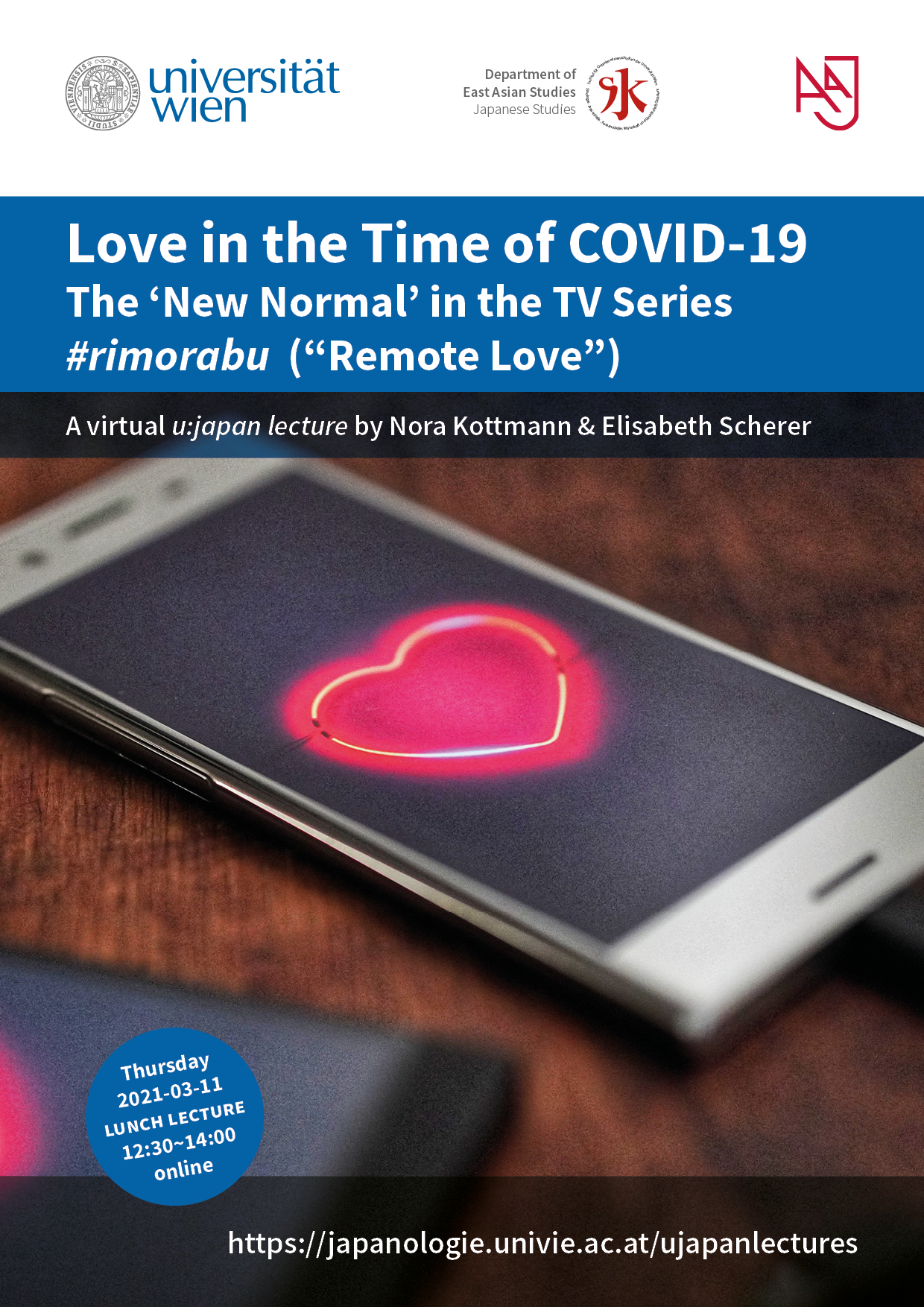 |
Season 2 | Spring 2021 | s02e02 | 11/03/2021 | en | Elisabeth Scherer & Nora Kottmann | Heinrich Heine University Düsseldorf & DIJ Tokyo | Elisabeth Scherer is a Japanese studies researcher and e-learning professional at Heinrich Heine University Düsseldorf. Her areas of research interest include popular culture, intermedia, rituals and gender studies. She is the editor of Reconsidering the Cultural Significance of NHK’s Morning Dramas (special issue of East Asian Journal of Popular Culture, 2019). Nora Kottmann is Senior Research Fellow at the German Institute for Japanese Studies (DIJ) in Tokyo. Her research focuses on issues related to gender, intimacy, mobility, space, and (not) belonging. Recent publications include the co-edited volume Studying Japan. Handbook of Research Designs, Fieldwork and Methods (2020; with Cornelia Reiher). | Love in the Time of COVID-19: The ‘New Normal’ in the TV Series #rimorabu (“Remote Love”) | Television series in Japan frequently deal with life plans and life choices of (young) adults and, in so doing, serve as a way to negotiate societal normality. Often, one focus of these series is on unmarried women (‚singles’) of different age groups. One such example is the recent television series #rimorabu. Futsū no koi wa jadō (#remote love. Ordinary love is a wrong course; NTV 2020) which aired from mid-October to late December 2020. The series is situated in the context of the ongoing pandemic and discusses how calls for self-restraint and the avoidance of ‘the 3Cs’ – closed spaces, crowds and close contact situations – affect the dating- and love-life of unmarried individuals. In our talk, we address challenges on the production side, critically discuss depictions of a ‘new normal’ in the context of current single- and gender-discourses in Japan and show that the series, while being extremely up-to date on the one hand, falls back on old narrative patterns on the other hand. | de, jp | online | https://japanologie.univie.ac.at/ujapanlectures/s02/#e02 | Literature and Media Studies, Sociology and Social Sciences | ||||||||||
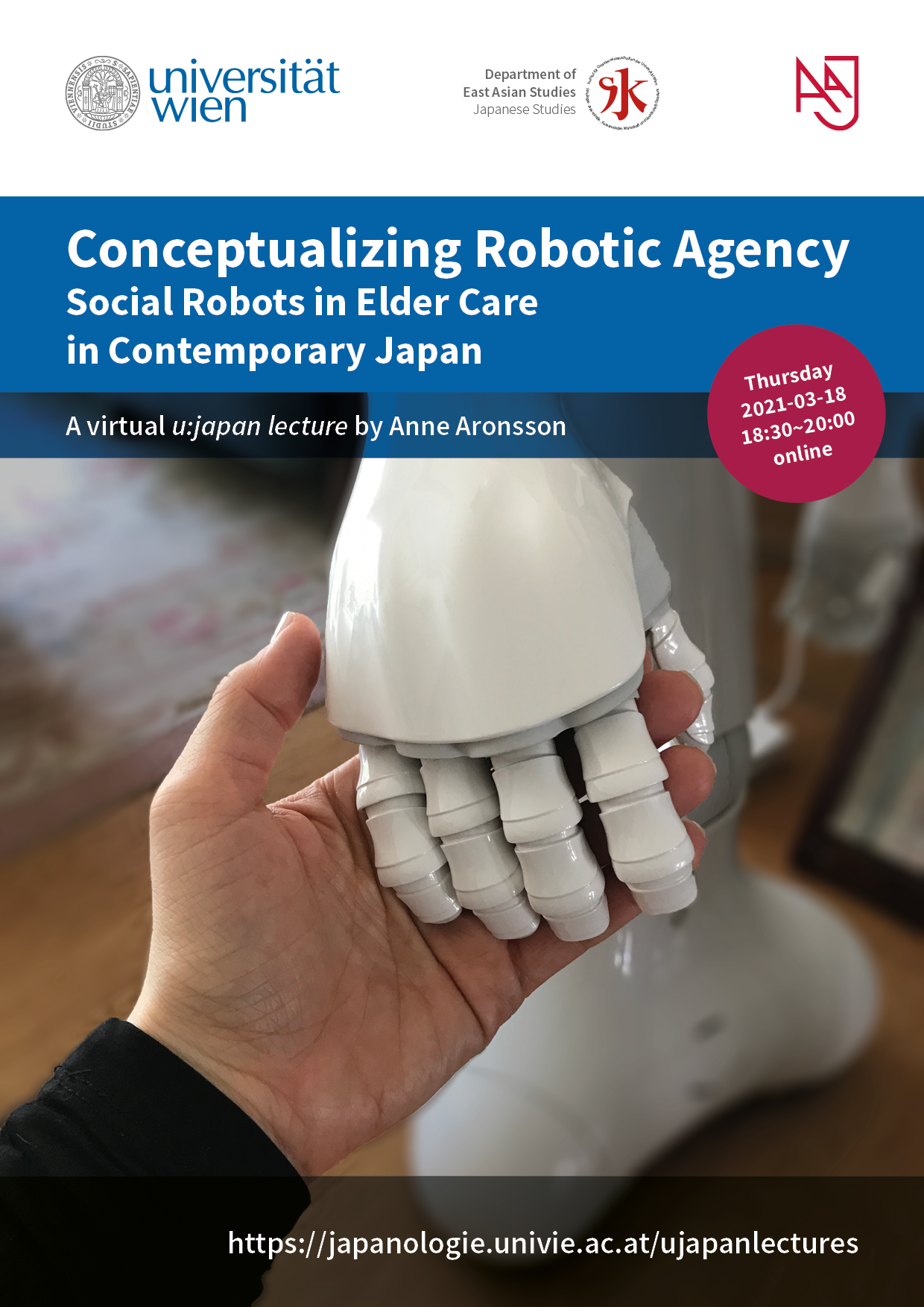 |
Season 2 | Spring 2021 | s02e03 | 18/03/2021 | en | Anne Aronsson | University of Zurich / Universität Bern | Dr. Anne Stefanie Aronsson is a postdoctoral fellow in the Institute of Asian and Oriental Studies at the University of Zurich and her current research focuses on elderly care in Japan and the use of robotic care devices, with a focus on social robots and emerging emotional technologies. She obtained her doctor‘s degree in socio-cultural anthropology from Yale University, United States. She has authored several publications, including “Social Robots in Elderly Care: The Turn Toward Machines in Contemporary Japan,” Japanese Review of Cultural Anthropology, as well as her monograph Career Women in Contemporary Japan: Pursuing Identities, Fashioning Lives. New York: Routledge. | Conceptualizing Robotic Agency: Social Robots in Elder Care in Contemporary Japan | Japan is a hyper-aging society; it has one of the highest life expectancies in the world and is undergoing a demographic transition that Western nations have yet to experience. The Japanese government is encouraging robotic solutions to address its elder care labor shortage, and authorities have therefore adopted an agenda of introducing social robots. However, increasing numbers of people in Japan are becoming emotionally attached to anthropomorphic machines, and their introduction into elder care may thus be perceived as contentious by elders, caregivers, and family members. By exploring human engagement with social robots in the care context, this presentation argues that rapid technological advances in the twenty-first century will see robots achieve some level of agency, contributing to human society by carving out unique roles for themselves and by bonding with humans. Nevertheless, the questions remain of whether there should be a difference between humans attributing agency to a being and those beings having the inherent ability to produce agency and how we might understand that difference if unable to access the minds of other humans, let alone nonhumans, some of which are not even alive in the classical sense. Using the example of an interaction between an elderly woman and a social robot, I engage with these questions; discuss linguistic, attributed, and inherent agencies; and suggest that a processual type of agency might be most appropriate for understanding human–robot interaction. Machines are already embedded in our lives, but, as we start to treat machines as if they are almost human, we may begin to develop habits that cause us to treat humans as almost machines. We therefore need to consider not only what social robots can do, both now and in the future, but also what humans will become by increasingly forming relationships with machines. I suggest that elderly people can develop an emotional attachment to social robots by attributing agency to them, and, as machine-learning routines grow more sophisticated, those robots will eventually interact with humans in such an insightful way that the division between attributed and inherent nonhuman agency might become meaningless. | https://ustream.univie.ac.at/paella7/ui/watch.html?id=348d57dc-0f15-403b-8eec-f05dfb8a95dd | ch | online | https://japanologie.univie.ac.at/ujapanlectures/s02/#e03 | Science and Technology Studies (STS) and Digital Humanities, Anthropology and Ethnography, Sociology and Social Sciences | Has Video | ||||||||
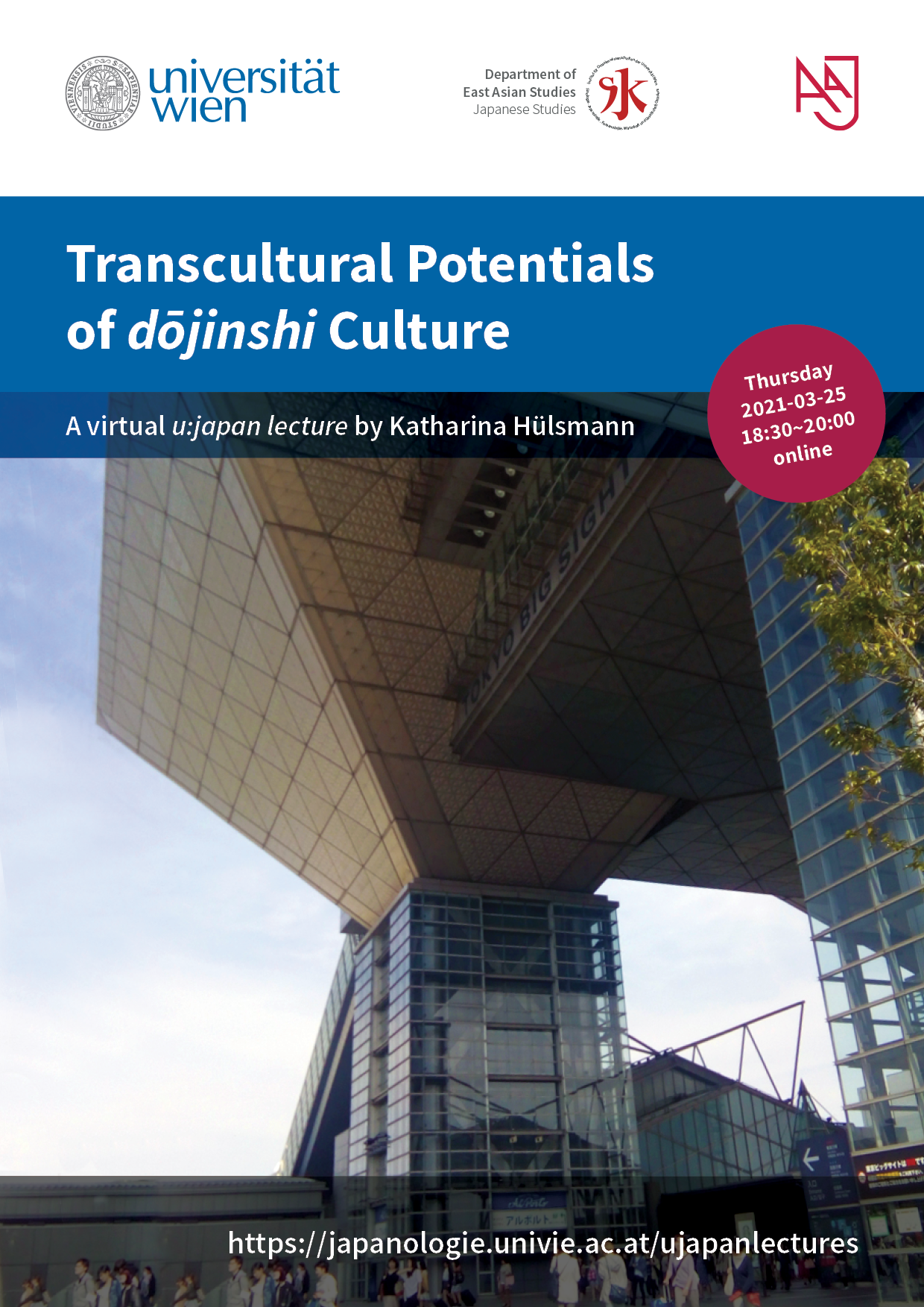 |
Season 2 | Spring 2021 | s02e04 | 25/03/2021 | en | Katharina Hülsmann | Heinrich Heine University Düsseldorf | Katharina Hülsmann is a PhD candidate at Heinrich Heine University Düsseldorf, Germany. She is co-editor of the German-language volume Japanische Populärkultur und Gender [Japanese Popular Culture and Gender] (2016). In 2017 she conducted field work supported by a PhD grant from the German Institute for Japanese Studies in Tokyo (DIJ). Her research interests include representations of gender in popular culture and fannish works, fan/producer relationships in the digital age, comics studies, as well as transcultural dynamics of fandom. | Transcultural Potentials of dōjinshi Culture | In this talk I will present findings of an ethnographic study of dōjinshi (amateur comics) culture that I conducted for my PhD thesis. Dōjinshi is a term that is used to describe subcultural publications in Japan that are usually self-published and exchanged at specialised events. Most of the works exchanged at these gatherings make use of scenarios and characters from commercially published media, such as manga, anime, games, movies or television series and can be classified as fan works, poaching from media franchises and offering a vehicle for creative expression. What sets these works apart from fannish forms of expression, like fan fiction, in the anglophone sphere, is, that they are mainly being exchanged in printed form and not digitally over the internet. The fan artists thus utilise a robust infrastructure to produce and exchange their works with like-minded fans. I will illustrate how Japanese dōjinshi artists produce cultural capital and social capital within their communities and how they navigate conflicts with outsiders, such as media right holders, and within their own community. For my field study, I focussed on Japanese dōjinshi artists who produce fan works based on western entertainment media franchises, such as the Marvel Cinematic Universe. One of the focus points of my study was to trace the potentials for transcultural spreading of Japanese fan works and fannish exchange within local and global fan communities. The talk thus aims to give a brief overview of how dōjinshi exchange and the local community functions, and then delves deeper into the examination of dōjinshi culture as a potentially transcultural phenomenon. | de | online | https://japanologie.univie.ac.at/ujapanlectures/s02/#e04 | Literature and Media Studies, Sociology and Social Sciences | ||||||||||
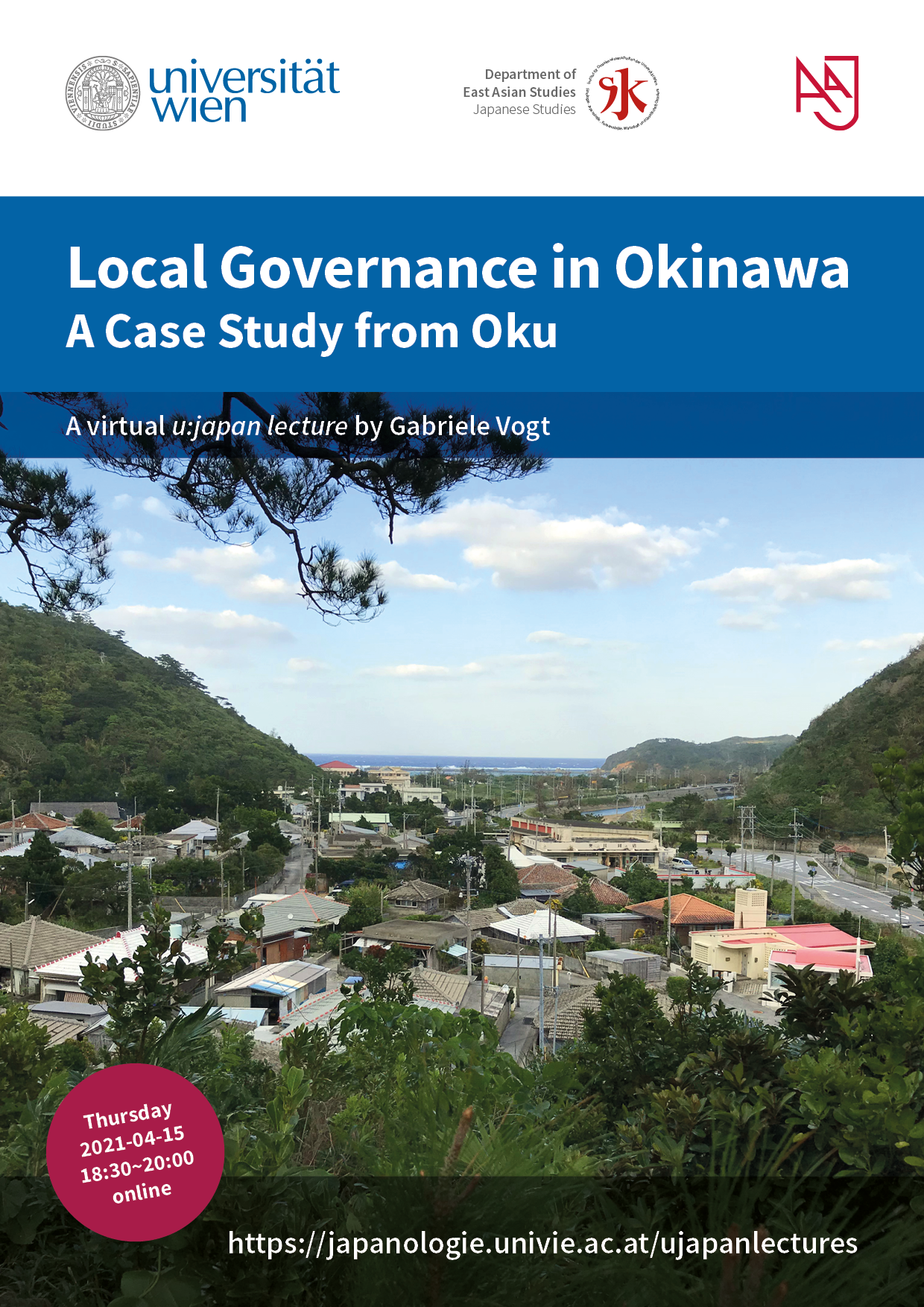 |
Season 2 | Spring 2021 | s02e05 | 15/04/2021 | en | Gabriele Vogt | LMU Munich | Gabriele Vogt holds the Chair of Japanese Studies / Social Sciences at Ludwig Maximilian University in Munich, Germany. She has been studying local politics and civic engagement in Okinawa for more than twenty years, and has also extensively researched population aging, eldercare and international migration to Japan. Among her recent publications is a co-authored piece with Ken V. L. Hijino, "Identity politics in Okinawan elections: The emergence of regional populism" (Japan Forum, 33:1, 2021), and a monograph entitled Population aging and international health-caregiver migration to Japan (Springer, 2018). | Local Governance in Okinawa: A Case Study from Oku | Oku, a hamlet of less than 200 inhabitants in Okinawa’s Yanbaru region, is known as a place of alternative economy, rich social capital and vivid local self-governance. The basis to this is the hamlet’s local shop, the so-called kyōdōten (共同店). Founded in the early 20th century as a private initiative, to ensure the distribution of Oku’s rich forest resources, and later of agricultural products such as tea and citrus fruits, the kyōdōten as a cooperatively run shop has taken over a central economic position in the hamlet. It has served as a meeting point for the hamlet’s inhabitants and various local organizations, thereby providing a space for community-building. Its organizational structure, which is based on principles of direct democracy has expanded beyond the shop administration and shaped the model of governance within the hamlet itself. The Oku kyōdōten model has spread in Okinawa and occasionally beyond, and today, while several shops already had to close their shutters amidst population aging, outmigration and the wider distribution of chain supermarkets, several dozen cooperatively run shops still persist. In this case study, I apply the concept of place-making to address the historic and contemporary relevance of the Oku kyōdōten. I argue that the cooperatively run shop over the course of the past century has insured Oku’s economic wealth, tight social networks and its relative administrative autonomy from outside governance on a municipal level. Today, however, against the backdrop of demographic change and developmental initiatives in Yanbaru, the store’s future is anything but certain. By analyzing the kyōdōten model, I assess the potential and the limitations of economic vitality, social support and political autonomy in the marginalized regions of Japan. | https://ustream.univie.ac.at/paella7/ui/watch.html?id=fb224a09-823c-4ac9-befd-bdc251380c80 | de | online | https://japanologie.univie.ac.at/ujapanlectures/s02/#e05 | Political Science and Law, Agriculture and Rural Studies | Has Video | ||||||||
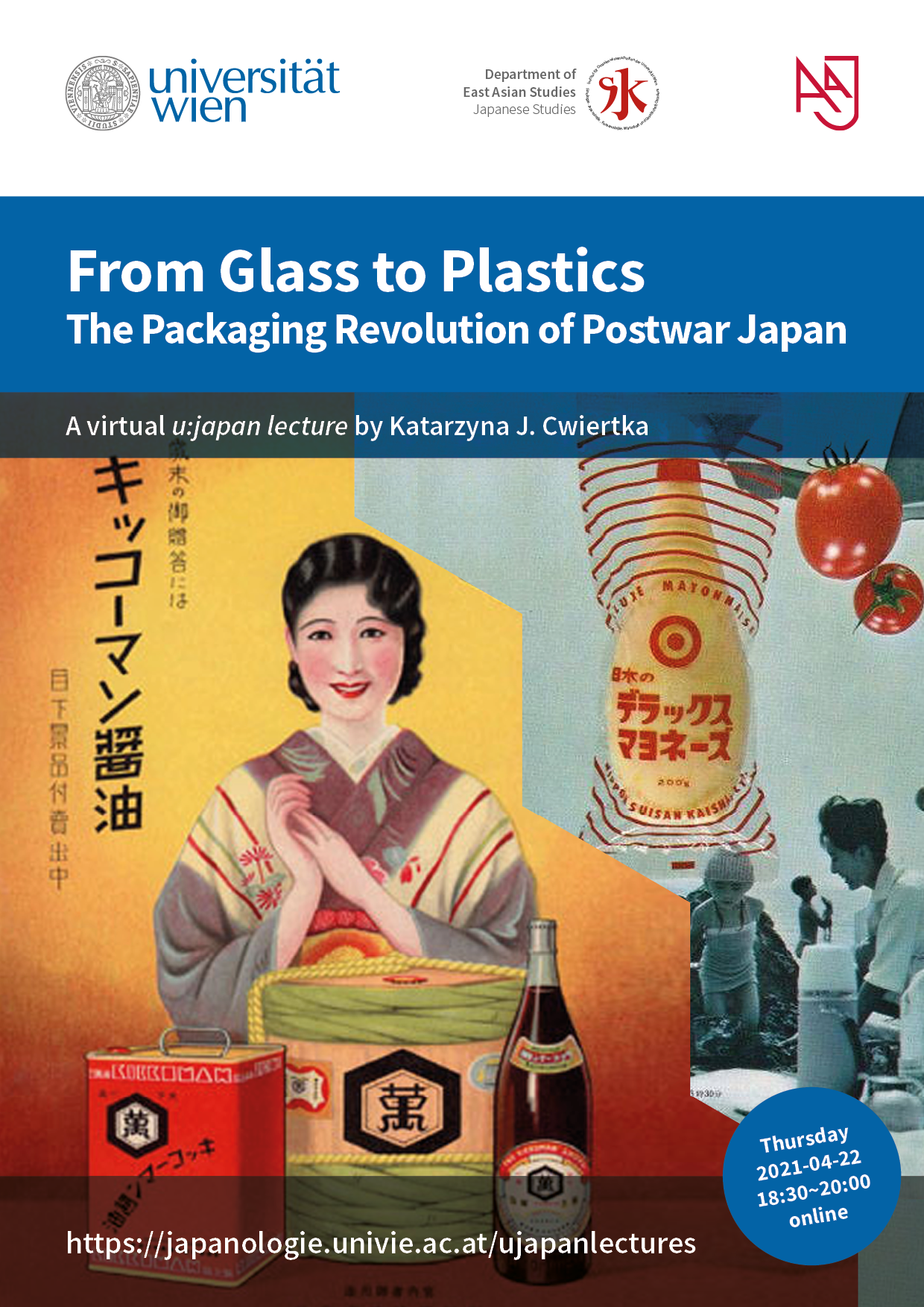 |
Season 2 | Spring 2021 | s02e06 | 22/04/2021 | en | Katarzyna J. Cwiertka | Leiden University | Katarzyna J. Cwiertka is Chair of Modern Japan Studies at Leiden University. She is an expert on food history of modern Japan and Korea, both as a domain of culture and as a window into historical inquiry that extends beyond the realm of cuisine and nutrition. Cwiertka is the author of Modern Japanese Cuisine: Food, Power and National Identity (Reaktion Books 2006), Cuisine, Colonialism and Cold War: Food in Twentieth Century Korea (Reaktion Books 2012), Himerareta washokushi (Shinsensha 2016), and Branding Japanese Food: From Meibutsu to Washoku (University of Hawaii Press 2020). She has also edited several volumes with a larger geographical focus, including Asian Food: The Global and the Local (University of Hawai‘i Press 2002), Critical Readings on Food in East Asia (Brill 2012), Food and War in Mid-Twentieth-Century East Asia (Ashgate 2013), and Consuming Life Post-Bubble Japan: A Trans-disciplinary Perspective (Amsterdam University Press 2018). Currently, Cwiertka is working on a book manuscript on the history of food packaging in Japan. Recent Podcasts also feature Katarzyna J. Cwiertka and her work on Branding Japan’s Food (https://newbooksnetwork.com/katarzyna-j-cwiertka-branding-japans-food-from-meibutsu-to-washoku-u-hawaii-press-2020/) and washoku (https://www.japankyo.com/2021/04/about-unesco-washoku-japanese-cuisine/). | From Glass to Plastics: The Packaging Revolution of Postwar Japan | In May 2020 the Abe government launched an ambitious strategy of reducing Japan’s disposable plastic waste by 25 percent within the next decade. Although it remains to be seen how far the government will succeed in this mission, a much more interesting question is why the country has turned into the world’s second-highest user per capita of plastic packaging. Plastic has infiltrated the Japanese packaging market at a phenomenal speed. In terms of quantity (expressed in weight), its share more than doubled during the last three decades of the twentieth century, from around 9% in the 1970s to around 19% in the early 2000s. Since plastic is relatively light compared to other packaging materials, its success becomes even more apparent from the perspective of value. Comprising just 4.6% of the total value of Japanese packaging industry in 1958, by 2005 it skyrocketed to 30%. This paper will explore the forces behind the packaging revolution that took place in Japan during the 1950s and 1960, and the impact of these early decades on the rise of the culture of wrapping as we know it today. | https://ustream.univie.ac.at/paella7/ui/watch.html?id=e23462c5-9033-45ef-bb1f-35c2b1aca492 | nl | online | https://japanologie.univie.ac.at/ujapanlectures/s02/#e06 | Science and Technology Studies (STS) and Digital Humanities, History and Archaeology, Economics and Business Studies | Has Video | ||||||||
 |
Season 2 | Spring 2021 | s02e07 | 29/04/2021 | en | Edward Mack | University of Washington | Edward Mack is Associate Professor of Japanese at the University of Washington in Seattle. His first book, Manufacturing Modern Japanese Literature: Publishing, Prizes, and the Ascription of Literary Value (Duke, 2010), combined an empirical study of the literary publishing industry in Japan with a disciplinary critique focused on the notion of literary "purity." His forthcoming book, Acquired Alterity: Migration, Identity, and Literary Nationalism (California, 2021), is structured similarly, combining a history of Japanese-language literary activities in Brazil with a continuation of the disciplinary critique, this time focused on the concept of the nation as it is applied to literary texts. | Japanese Literary Nationalism and Brazil, 1908-1941 | In this talk I will present a history of the marketplace for Japanese-language literary texts in Brazil, prior to the Second World War, and an analysis of an award-winning story written there during that period, Sonobe Takeo's "An Age of Speculative Farming" (1932) [園部武夫の「賭博農時代」1932年], after which I will speak briefly about what I think they tell us about “modern Japanese literature.” The talk will add to a growing discourse on the colonial and minority literary practices that challenges a naturalized conception of a homogeneous ethnic nation-state and an unproblematic national literary culture. This study tries to extend this challenge, by drawing attention to another “marginal” element, that of the migrant, or diasporic, communities in the Americas. Rather than merely making the rubric of national literature more inclusive, or proposing an alternative rubric, however, I will speculate on the necessity and impact of such collective rubrics themselves. | us | online | https://japanologie.univie.ac.at/ujapanlectures/s02/#e07 | Literature and Media Studies, History and Archaeology | ||||||||||
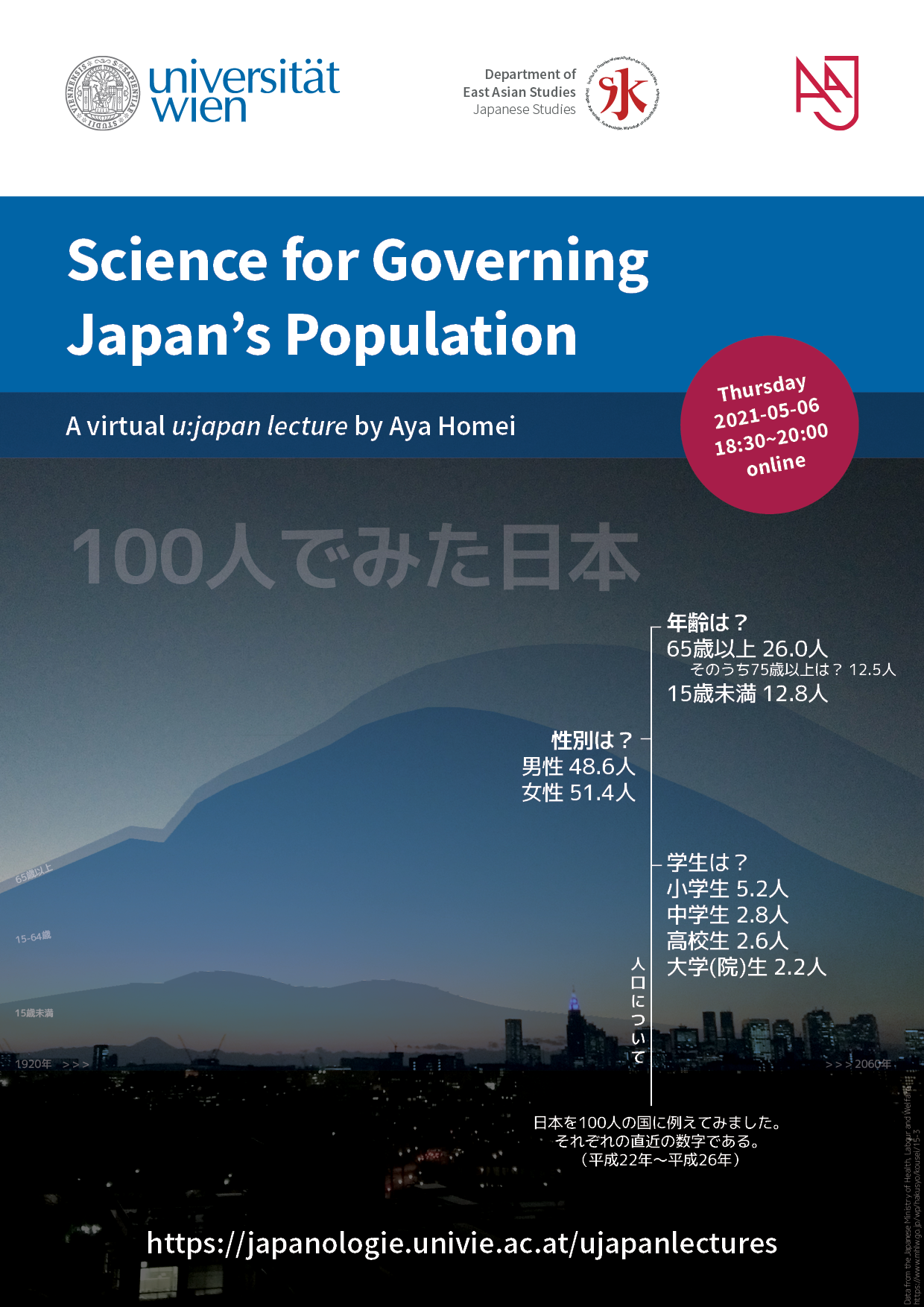 |
Season 2 | Spring 2021 | s02e08 | 06/05/2021 | en | Aya Homei | Manchester University | Aya Homei is Lecturer in Japanese Studies at the University of Manchester. She has been studying the politics and practice of reproduction and population in modern Japan, and more recently, family planning, development politics and health diplomacy in northeastern Asia. Among her recent works include the special issue she co-edited with Professor Yoko Matsubara at Ritsumeikan University (“Critical approaches to reproduction and population in post-war Japan”, Japan Forum, 2021). Currently, Aya is preparing a monograph, Science for Governing Japan’s Population. | Science for Governing Japan’s Population | In Japan and elsewhere, population is seen as a fundamental index for a nation’s political economy. Also, the demographic knowledge is regarded as key to understand the societies that comprise the nation. For this reason, population issues such as ageing population and low fertility have been a matter of concern for the government for long, and policymakers have collaborated with population experts to come up with solutions to these problems. But where do these assumptions about, and political actions for, the population come from historically? What role has the science of population played in the governing of Japan’s population? In this presentation, I will tackle these questions by reviewing the medico-scientific fields and practices emerged in Japan between the 1860s and 1950s that were mobilized by the concept of population. I show how the notion of population we are familiar with today – in Japanese, jinkō – and the fact that population became a natural object of state inquiry and policy, are both a product of the political transformation of Japan into a modern nation state and an empire in the latter half of the nineteenth century and the development of modern science and medicine that kept a symbiotic relationship with the political change. By showing the symbiotic relationship between science and the state’s effort to govern Japan’s population, I argue that the science of population was directly shaped by the ideologies, institutional agendas and socio-political conditions that surrounded the science, and that the official policies established as a result of this symbiotic relationship ultimately became somewhat detached from the demands of people’s everyday lives. | https://ustream.univie.ac.at/paella7/ui/watch.html?id=57fbc55c-d2b8-4f9e-ac20-51157e5ad372 | uk | online | https://japanologie.univie.ac.at/ujapanlectures/s02/#e08 | Science and Technology Studies (STS) and Digital Humanities, Psychology and Medicine, Sociology and Social Sciences | Has Video | ||||||||
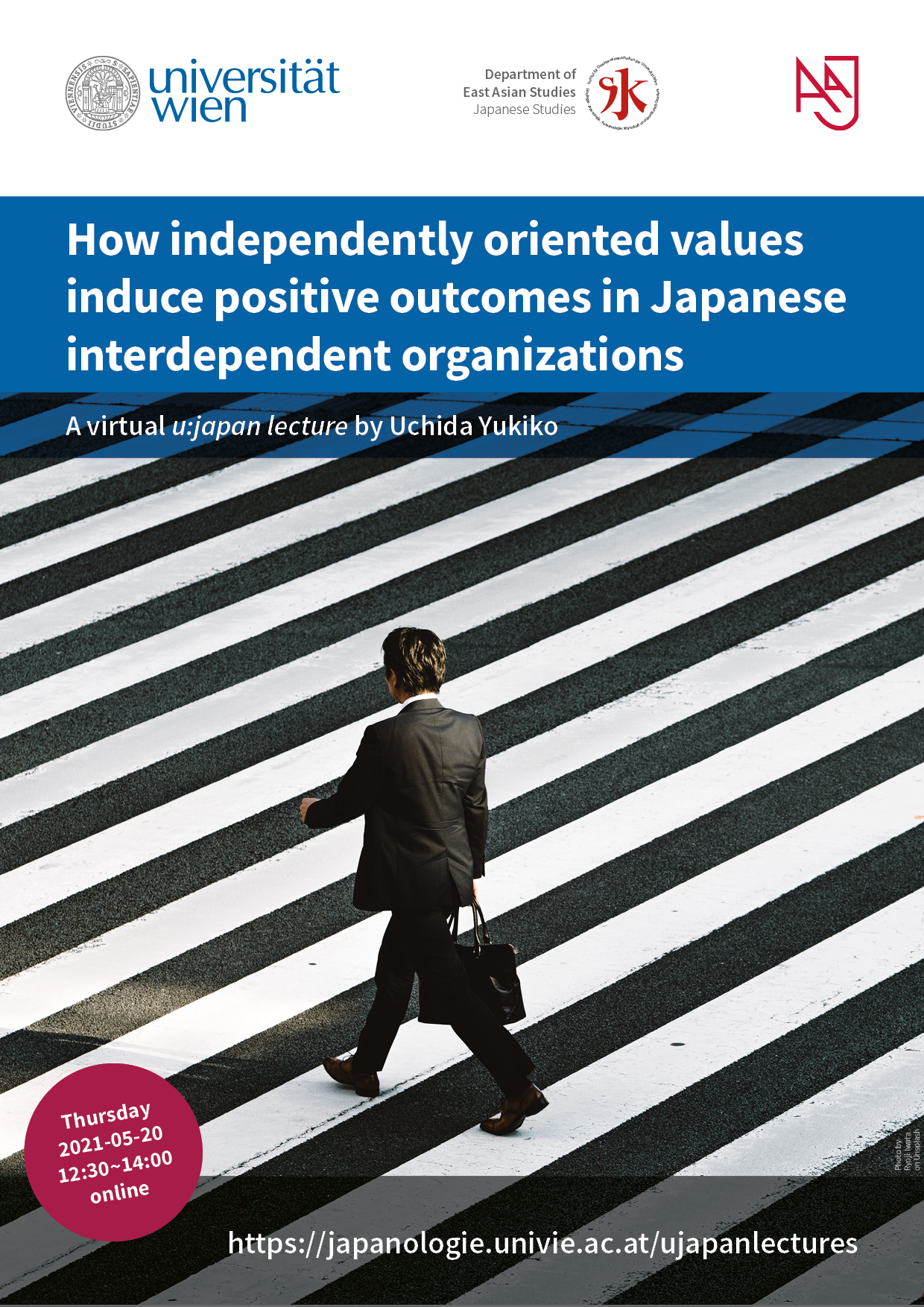 |
Season 2 | Spring 2021 | s02e09 | 20/05/2021 | en | Uchida Yukiko | Kyoto University | Dr. Uchida Yukiko is currently a professor of social and cultural psychology at the Kokoro Research Center, Kyoto University. Upon receiving her PhD in social psychology from Kyoto University in 2003, she started her academic career as a visiting researcher at the University of Michigan and Stanford University. Since 2008, she has been based at the Kokoro Research Center. As a cultural psychologist, she studies the psychological mechanisms behind the experience of emotions like well-being. She is a 2019-20 Berggruen fellow at CASBS, Stanford University. (http://kokoro.kyoto-u.ac.jp/en2/staff-en/yukiko-uchida-en/) | How independently oriented values induce positive outcomes in Japanese interdependent organizations | How do Japanese workers seek and feel well-being? How do we foster and maintain cultural values (e.g., independence, interdependence) in our daily activities? This talk aims to provide direct evidence for the theoretical assumption that cultural values and systems exist at the group level (organization) and that they are functionated under the corresponding socio-ecological contexts such as job mobility. We collected data from various business organizations in Japan. Each organization has its own values. For example, in some organizations, independent-oriented culture (e.g., promotion-oriented, competition-oriented) could become dominant, while other organizations are more likely to sustain traditional interdependent-oriented culture (e.g., prevention-focused, group harmony-oriented). Using a large-scale survey with a sample over 3.000 employees working in Japanese organizations, we examined the prediction that independence orientation at the organization-level promotes positive outcomes (e.g. cooperative social interactions) only under high job mobility environments. Our findings carry important theoretical implications in understanding how cultural psychological constructs interact with local socio-ecological environments to constitute self-sustaining cultural systems. | jp | online | https://japanologie.univie.ac.at/ujapanlectures/s02/#e09 | Psychology and Medicine, Sociology and Social Sciences | ||||||||||
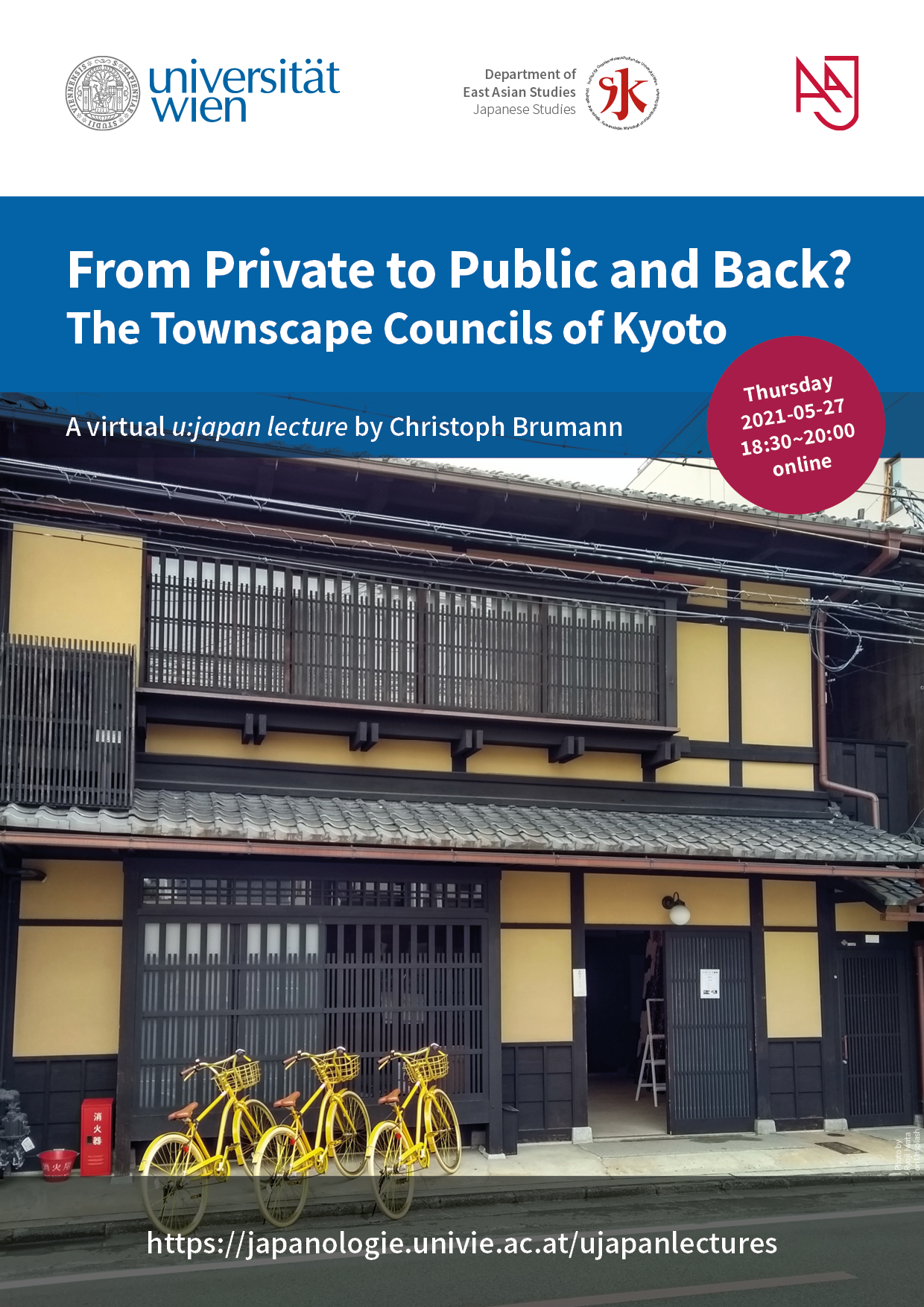 |
Season 2 | Spring 2021 | s02e10 | 27/05/2021 | en | Christoph Brumann | Max Planck Institute for Social Anthropology | Christoph Brumann is Head of Research Group at the Max Planck Institute for Social Anthropology, Halle, and Honorary Professor of Anthropology at the University of Halle-Wittenberg. His earlier work on Japan led to the book Tradition, Democracy and the Townscape of Kyoto: Claiming A Right to the Past (2012), the co-edited volumes Making Japanese Heritage (2010) and Urban Spaces in Japan: Cultural and Social Perspectives (2012), and articles and book chapters on these topics as well as on utopian communes and gift-giving practices. He also wrote The Best We Share: Nation, Culture and World-Making in the UNESCO World Heritage Arena (2021) and Die Kunst des Teilens: Eine vergleichende Untersuchung zu den Überlebensbedingungen kommunitärer Gruppen (1998), co-edited World Heritage on the Ground: Ethnographic Perspectives (2016) and Monks, Money, and Morality: The Balancing Act of Contemporary Buddhism (2021), and published numerous anthropological journal articles, including on the concept of culture and the cultural consequences of globalisation. | From Private to Public and Back? The Townscape Councils of Kyoto | For over half a century, Kyoto has not just been a stronghold of history and tradition but also of conflicts about the built environment and how to shape it. The famous townscape debates (keikan ronsō) reached a climax around 2000 and provoked the new building code of 2007 that regulated heights, shapes, designs and views to a degree unseen in Japan. Daring as this imposition of public control on privately owned urban space appeared at the time, it is widely seen as a success today. Instead of following up with more fine-grained rules for individual neighbourhoods, however, Kyoto City introduced the "local townscape councils" (chiiki keikanzukuri kyōgikai) of which there are a dozen by now. Whenever such a group forms and receives the mayor's blessing, builders must consult it for building anything within their territory, in the assumption that locals know best what fits their area. Building on two decades of ethnographic fieldwork, the lecture discusses the experience and significance of these townscape councils. The city's move of empowering the locals may appear regressive, as a re-privatisation of what had just been made more public. Closer inspection reveals, however, that the councils are not the local layperson's voice they are made to be, and tacit cooperation with city officials also arises. Reviewing cases observed in 2019/20, I will show that the councils, despite the non-binding nature of the consultations, can achieve major improvements. When builders do not care for their local reputation and instead wish to profit from real estate speculation and hotel construction fed by the (pre-Covid) tourist boom, however, limitations are obvious and frustration is mounting. A full sharing of urban space therefore has still some way to go, even in the Japanese city that has gone furthest in making it a public concern. | https://ustream.univie.ac.at/paella7/ui/watch.html?id=33dfb573-e6cf-44c5-9db4-3178cbc2e6ac | de | online | https://japanologie.univie.ac.at/ujapanlectures/s02/#e10 | Architecture and Urban Studies, Anthropology and Ethnography | Has Video | ||||||||
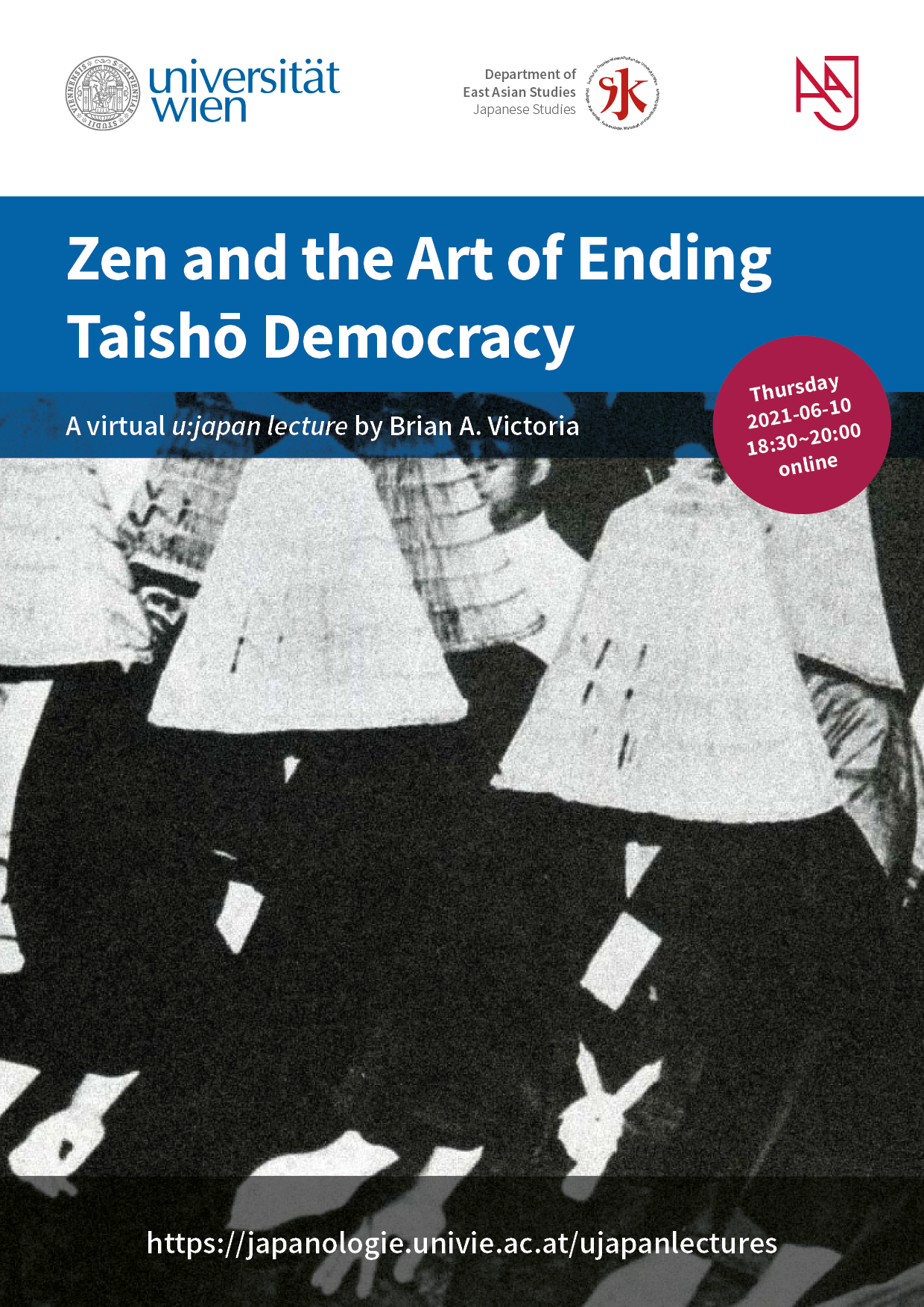 |
Season 2 | Spring 2021 | s02e11 | 10/06/2021 | en | Brian Victoria | Oxford Centre for Buddhist Studies | Brian Victoria is a native of Omaha, Nebraska and graduate of Nebraska Wesleyan University. He holds a M.A. in Buddhist Studies from Sōtō Zen sect-affiliated Komazawa University in Tokyo, and a Ph.D. from the Department of Religious Studies at Temple University. Brian’s major writings include Zen Terror in Prewar Japan: Portrait of an Assassin (Rowman & Littlefield, 2020), Zen At War (Rowman & Littlefield, 2006); Zen War Stories (RoutledgeCurzon, 2003); Zen Master Dōgen, coauthored with Yokoi Yūhō (Weatherhill, 1976); and a translation of The Zen Life by Sato Koji (Weatherhill, 1972). In addition, many of Brian’s journal articles may be found on thezensite here: http://www.thezensite.com/MainPages/critical_zen.html. Brian is currently a non-resident Senior Research Fellow at the Oxford Centre for Buddhist Studies and a fully ordained Buddhist priest in the Sōtō Zen sect. | Zen and the Art of Ending Taish? Democracy | In the case of Germany, the manner in which the Nazi’s rose to power has been carefully researched and documented. With the notable exception of the role the Nazis may have played in the Reichstag fire of February 27, 1933, there remains little to be discovered. However, in the case of Japan, the same cannot be said. That is to say, the debate continues as to what led to, and who was responsible for, the demise of democratic governance in Japan, a period popularly known as “Taishō democracy” (1926-1933). There can be little doubt that the Blood Oath Corps Incident (Ketsumeidan Jiken) of spring 1932 played an important role in Japan’s gradual slide into totalitarianism. The importance of this incident is further strengthened by the May 15th Incident of 1932, for in reality it was but the second stage of the Blood Oath Corps Incident. While the first incident resulted in the deaths of only two Japanese leaders, a politician and a businessman, the second stage resulted in the death of Japan’s prime minister, Inukai Tsuyoshi. Taken together, the death of these three men brought an end to political party-based cabinets reflecting the will of the voters. From then on, through the end of WW II, Emperor Hirohito and his advisors appointed and removed successive prime ministers. Until the recent publication of my book, Zen Terror in Prewar Japan: Portrait of an Assassin, the role the Zen school of Buddhism played in the incidents described above has remained completely unknown. That said, the claim is not made that the Zen faith of Inoue Nisshō, leader of the terrorist band, was the cause of the killings that took place. Instead, Zen is identified as what may be called an “enabling mechanism” whose doctrines, as well as praxis, served to make the killings possible, i.e., by providing both the ethical justification and the spiritual/mental strength required for the band’s terrorist acts. This presentation will begin with an introduction to the political and historical dimensions of the two incidents described above. Thereafter, the focus will shift to an examination of the nature of Zen in prewar Japan that enabled it to serve as an enabling mechanism for terrorist acts and, concurrently, the demise of democracy in prewar Japan. | https://ustream.univie.ac.at/paella7/ui/watch.html?id=4071ac73-d2d0-40e6-ac74-39f324544e1f | jp | online | https://japanologie.univie.ac.at/ujapanlectures/s02/#e11 | Religion and Philosophy, History and Archaeology | Has Video | ||||||||
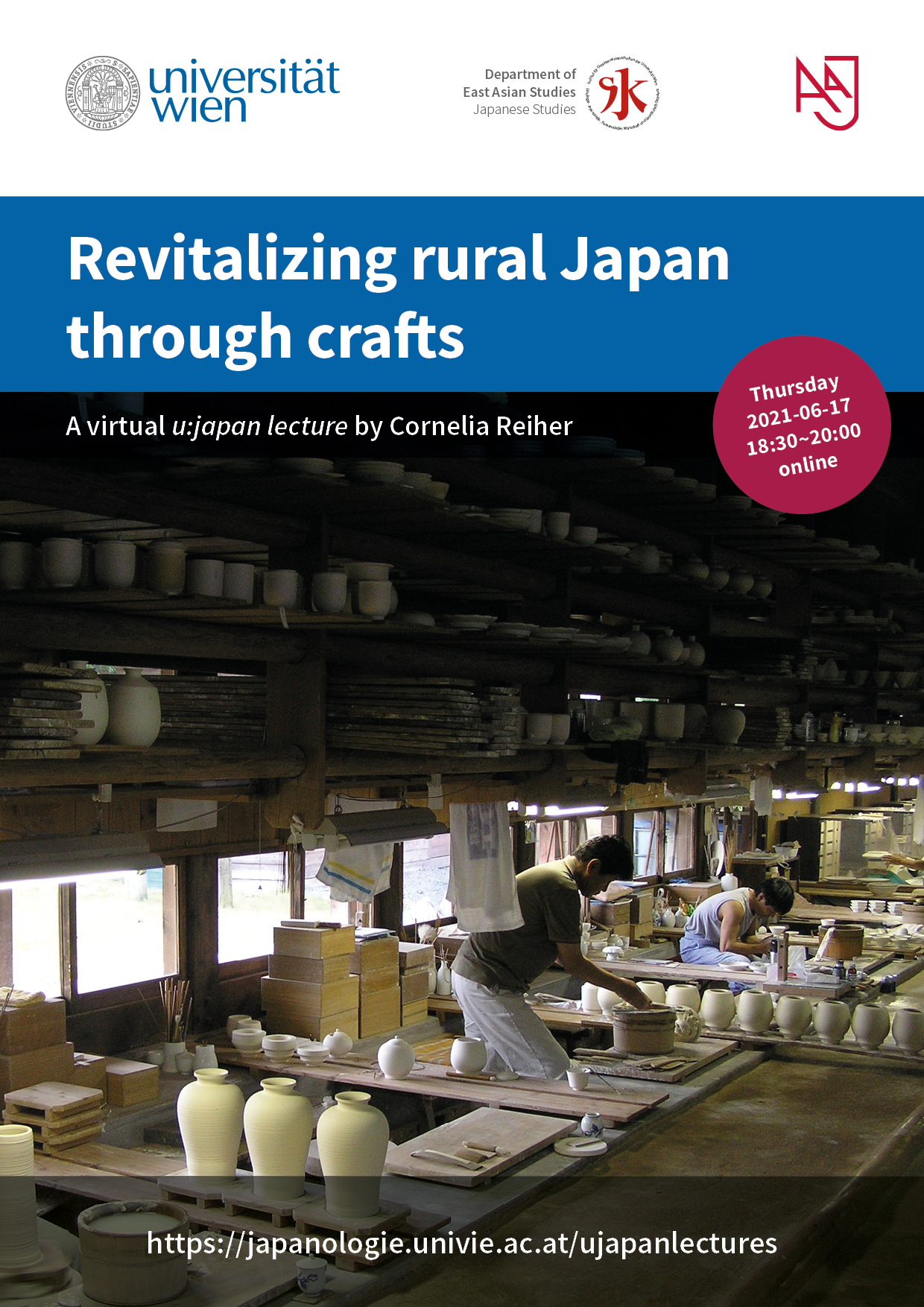 |
Season 2 | Spring 2021 | s02e12 | 17/06/2021 | en | Cornelia Reiher | FU Berlin | Cornelia Reiher is professor of Japanese Studies at Freie Universität Berlin and vice director of the Graduate School of East Asian Studies. Her main research interests include rural Japan, food studies, globalization and science and technology studies. Her recent publications include a special issue on fieldwork in Japan (2018), book chapters on transnational protest movement(s) in Asia (2019), and urban-rural migration in Japan (2020) and the methods handbook Studying Japan: Handbook of research designs, fieldwork and methods (2020, co-edited with Nora Kottmann). | Revitalizing rural Japan through crafts | National revitalization programs and policies for rural areas in Japan are based on the concept of homogenous and single-issued local identities. This approach has proved to be inapt to fight regional inequality, economic decline in rural areas and related problems such as depopulation and aging. Nevertheless, revitalization strategies in rural Japan often reduce local complexity to one or two features/products. These features can be “traditional” crafts like pottery, lacquer ware, Japanese paper (washi) or textiles. Japanese crafts are admired for their high quality and those preserving traditional crafts techniques are designated bearers of intangible cultural property (or “living national treasures”) under the national Law for the Protection of Cultural Properties. This title comes with privileges, but also constrains creativity and excludes new and innovative actors. In my presentation, I compare two towns in rural Kyūshū and their different approaches to “traditional” crafts and art in their revitalization strategies to discuss how cultural heritage in the realm of crafts can enable or constrain rural revitalization in Japan. While Arita (Saga Prefecture) is famous for its 400 years of porcelain production and home of several “living national treasures”, Taketa (Ōita Prefecture) has no acknowledged crafts tradition. However, the town’s mayor is inviting urbanites with new ideas for the revitalization/establishment of a local crafts tradition in order to attract tourists and to revitalize the local economy. The emerging hybrid forms of “traditional” crafts in both cases will shed light on the power relations between national and local policymakers, craftsmen and the institutions shaping and preserving cultural heritage and “traditional” crafts in Japan. | https://ustream.univie.ac.at/paella7/ui/watch.html?id=84773e0c-eec1-4ded-9bff-b2199f47cddd | de | online | https://japanologie.univie.ac.at/ujapanlectures/s02/#e12 | Agriculture and Rural Studies, Sociology and Social Sciences | Has Video | ||||||||
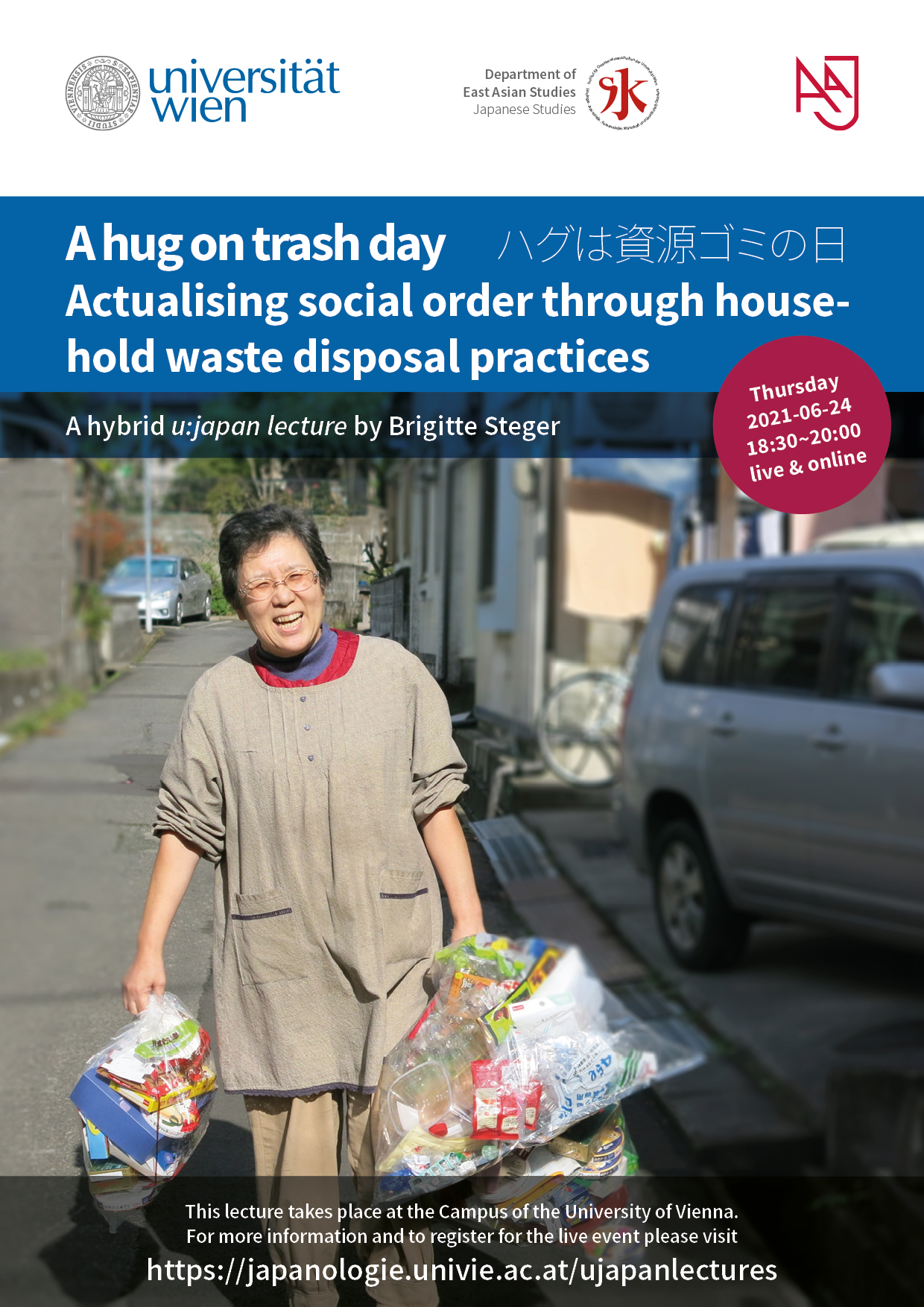 |
Season 2 | Spring 2021 | s02e13 | 24/06/2021 | en | Brigitte Steger | University of Cambridge | Brigitte Steger (PhD Vienna) is a Senior Lecturer (Associate Professor) in Modern Japanese Studies at the University of Cambridge and a Fellow of Downing College. In her research, she has always been intrigued by questions of the cultural and social embeddedness of seemingly natural, bodily matters and daily life. Her main research projects have dealt with notions of sleep, time and cleanliness, which have also guided her investigation of life in tsunami evacuation shelters in Yamada town, Iwate prefecture. Steger is the chair of the Japanese Gender Research Group at Cambridge, which recently published Beyond Kawaii: Studying Japanese Femininities at Cambridge (Lit 2020), and is also Secretary General of JAWS, the Japan Anthropology Workshop. She is a Co-Investigator at the Cambridge Circular Plastics Centre (CirPlas) and leads a project on ‘Cleanliness, convenience and good citizenship: Plastic and waste in everyday life’. Her project team has launched the publication of the special collection titled ‘The bag and beyond: Social science and the social life of plastic’ in Worldwide Waste: Journal of Interdisciplinary Studies (2021). Steger has recently published an article on the ethnologist Oka Masao, the founder in 1938 of the Institut für Japankunde at the University of Vienna, and is currently working on a book-length manuscript on sleep habits during the Heian period. | A hug on trash day (ハグは資源ゴミの日): Actualising social order through household waste disposal practices | ‘We hug on Tuesdays. That’s easy to remember as it is recyclables rubbish day.’ This is how Mikuri in the popular TV drama ‘Nigeru wa haji da ga yaku ni tatsu’ (‘The Full-time Wife Escapist’; TBS 2016) lays out one of the contractual conditions for her marriage of convenience. In so doing, she inadvertently indicates the extent to which waste disposal and recycling practices structure daily life in Japan. Following the realisation that Japan needed to increase recycling rates in order to deal with its growing amount of household waste, the ‘Containers and Packaging Recycling Law’ (Yōki hōsō risaikuru-hō) that was implemented in 1997 has reorganised waste disposal and recycling practices. Municipalities are now in charge of collecting and handling waste, and residents follow detailed rules that govern the sorting and disposal of their household waste. There are considerable regional differences, but the two basic categories are ‘rubbish’ (gomi), which is mostly incinerated before being taken to landfill, and ‘resources’ (shigen), which are collected for recycling. In this presentation Steger analyses notions of cleanliness and the categorisation of household waste and examines how individuals, households and neighbourhoods deal with their rubbish. Steger argues that cleanliness and litter-free streets are not simply a cultural characteristic of Japanese society but the result of everyday practices of waste sorting and disposal that actualise the social order. The presentation is based on the preliminary findings of her ongoing research project ‘Rubbish! Disposing waste, negotiating community’. | https://ustream.univie.ac.at/paella7/ui/watch.html?id=0f3e8531-1d52-43e5-bdae-0ab52c9c58fb | uk | hybrid | https://japanologie.univie.ac.at/ujapanlectures/s02/#e13 | Anthropology and Ethnography, Sociology and Social Sciences | Has Video | ||||||||
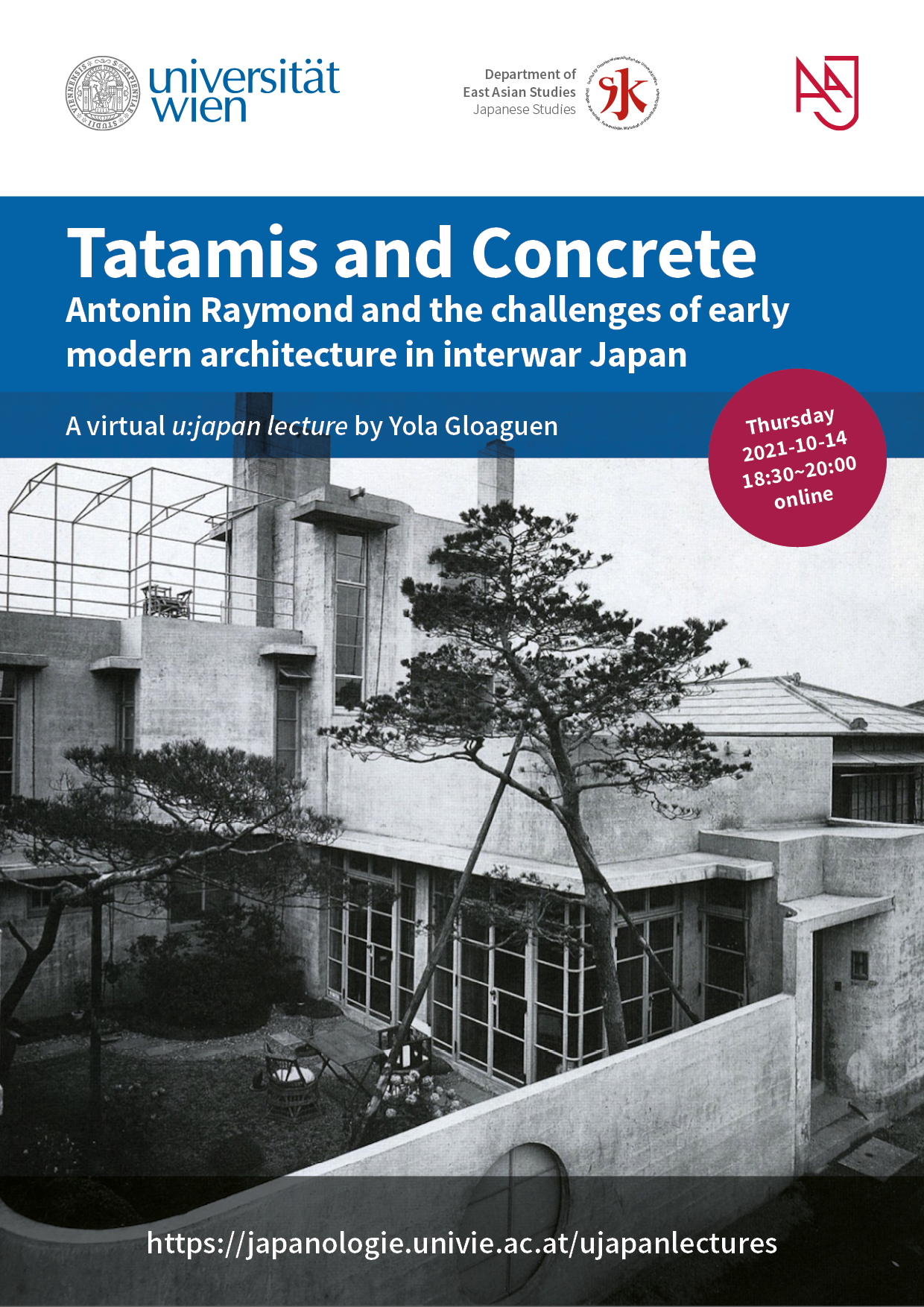 |
Season 3 | Fall-Winter 2021/22 | s03e01 | 14/10/2021 | en | Yola Gloaguen | CRCAO | Yola Gloaguen is a post-doctoral researcher at the East Asian Civilizations Research Centre in Paris, France. After receiving her degree in Architecture from Paris La Villette School of Architecture, she became a postgraduate student at Kyoto University and studied the history of modern architecture in Japan, with a focus on cultural and technological exchange between Japan and the Western world. In this context, she took a particular interest in the work of Czech born American architect Antonin Raymond (1888-1976), who lived and practised in Tokyo for 43 years, starting in 1921. In 2016, Yola Gloaguen obtained a PhD from École Pratique des Hautes Études in Paris, with her dissertation entitled Les villas réalisées par Antonin Raymond dans le Japon des années 1920 et 1930. Une synthèse entre modernisme occidental et habitat vernaculaire japonais (Villas designed by Antonin Raymond in interwar Japan – A Synthesis between Western Modernism and the Japanese Vernacular). Since then she has regularly contributed papers and book chapters to publications on the history of Japanese architecture and landscape. She is currently preparing the publication of a monograph based on her PhD dissertation. | Tatamis and Concrete – Antonin Raymond and the challenges of early modern architecture in interwar Japan | Antonin Raymond is one of few Western architects who allow us to explore the dynamics at work in the development of modern architecture in a non-Western context. Together with his wife and work partner Noemi Pernessin, the Czech born American architect arrived in Japan on the eve of 1920 to join Frank Lloyd’s international team and assist with the building of the new Imperial Hotel in Tokyo. Soon, Raymond opened his own office in the capital, setting out to become one of the pioneers of modern architecture in Japan. The human and technical challenges taken on by the architect and his international team are embodied in a large body of work produced between 1921 and 1938, particularly a large number of private houses and villas designed in Tokyo and its surrounding resort areas. Such works reflect the increasing demand for the design of a dwelling suited to both a Western and Japanese lifestyles by Tokyo’s international elites. It also reveals the technical challenges of fire and earthquake-proof construction in the domestic field. This is reflected in both the spatial design and construction techniques adopted by Raymond and his office over the first 15 years of his practice, drawing both on the international modernist idiom of the interwar period and the characteristics of premodern local architecture. After a brief presentation of Raymond’s pre-Japan background, the talk will focus on the architect’s design process, from a spatial and technical point of view, as well as his role in the genesis of modern Japanese architecture. The presentation of various architectural examples will highlight the way Raymond and his team developed a way of design based on the appropriation and adaptation of selected elements of the Japanese vernacular into the Western modernist idiom, which itself had to be re-evaluated in the particular context of Japan. Through the medium of architecture, this talk offers a reflection on the reassessment of the usual binaries of Western influence and Japanese adaptation. | https://ustream.univie.ac.at/paella7/ui/watch.html?id=fc31b72d-fd21-4fd6-871e-e2d359947250 | fr | online | https://japanologie.univie.ac.at/ujapanlectures/s03/#e01 | Architecture and Urban Studies, Arts (visual arts and performing arts) and Art History, History and Archaeology | Has Video | ||||||||
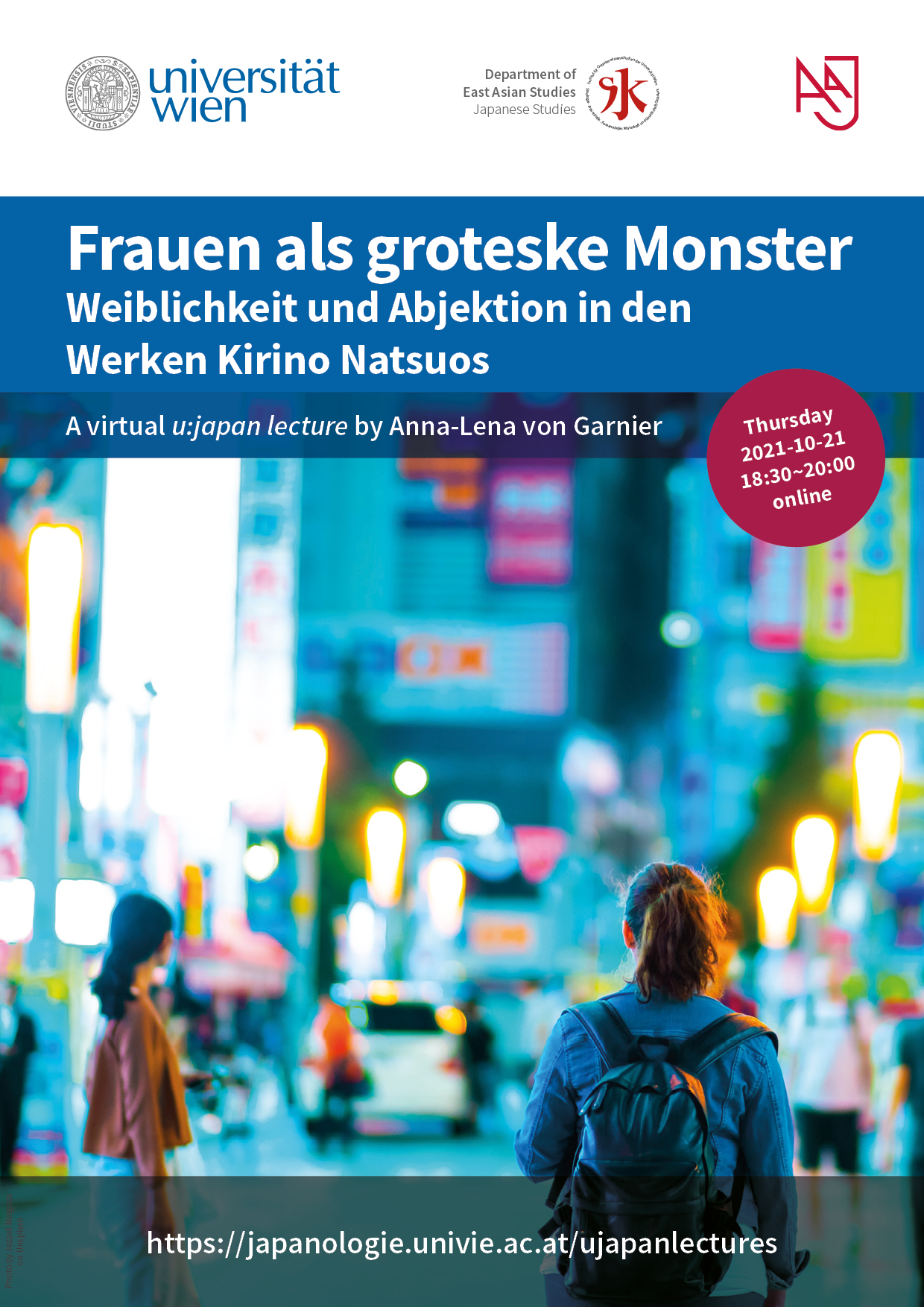 |
Season 3 | Fall-Winter 2021/22 | s03e02 | 21/10/2021 | de | Anna-Lena von Garnier | Universität Düsseldorf | Anna-Lena von Garnier studierte von 2007 bis 2014 Modernes Japan und Kunstgeschichte an der Heinrich-Heine-Universität Düsseldorf. Während des Studiums absolvierte sie von 2009 bis 2010 ein Auslandsjahr an der Ryûkyû-Universität in Okinawa, Japan. Seit 2016 ist sie Promotionsstudentin und am Institut für Modernes Japan der Heinrich-Heine-Universität Düsseldorf. In ihrem Dissertationsvorhaben beschäftigt sie sich mit der Inszenierung weiblicher Körper in der Literatur moderner japanischer Autorinnen am Beispiel von Kôno Taeko, Kirino Natsuo und Kanehara Hitomi. | Frauen als groteske Monster – Weiblichkeit und Abjektion in den Werken Kirino Natsuos | Die japanische Autorin Kirino Natsuo (*1951) erhebt sich in ihrer Literatur bewusst gegen die patriarchalen Machtstrukturen Japans, das sie als „Bubblonia“ bezeichnet, in Anlehnung an die Wirtschaftsblase der 80er Jahre und ihr Platzen im Jahr 1990, was wirtschaftliche Stagnation und sozialen Verfall nach sich zog. Sie ist größtenteils bekannt durch ihre Kriminalgeschichten, die sich dem so genannten „gesellschaftskritischen Krimi“ (shakaiha) zuschreiben lassen. Kirino zeichnet in ihren Werken ein dystopisches Bild Japans, in dem ihre Figuren mit Prekariat, Einsamkeit und der Unmenschlichkeit des kapitalistischen Systems konfrontiert werden. Obwohl Kirino sich nicht als feministische Autorin versteht, stehen gender-orientierte Thematiken in ihren Werken häufig im Vordergrund und in den Lebensgeschichten ihrer Figuren zeichnet sie unter anderem strukturelle, sexistische Diskriminierung am Arbeitsplatz, Sexualisierung und die Abwertung älterer Frauen in einer männerdominierten Gesellschaft nach. Ihre Herangehensweise ist meist intersektional und zeigt auch Schwierigkeiten anderer marginalisierter Gruppen auf. Die starke Zäsur durch den Zusammenbruch der Wirtschaftsblase 1990 wird in Kirinos Werken besonders deutlich. Im Vortrag beschäftige ich mich mit ihren Werken „Out“ (1997) und „Grotesque“ (2003), in denen Kirino ihre weiblichen Protagonistinnen in einem patriarchalen System agieren lässt, das keine weibliche Agenda zulässt und Frauen, die von der traditionellen Geschlechterrolle der Hausfrau und Mutter abweichen, bestraft. Weibliche Figuren, die in die männlich dominierte Arbeitswelt vordringen oder sexuelle Selbstbestimmung entwickeln möchten, werden als „Monster“ und „grotesk“ bezeichnet und die Subversion gegen bestehende Geschlechterrollen skandalisiert und abgewertet. Dies erinnert stark an Julia Kristevas Theorien zum Abjekten. Kristeva definiert das Abjekte als einen Zusammenbruch der symbolischen Ordnung, der durch den Verlust der Unterscheidung zwischen Subjekt und Objekt hervorgerufen wird und sich meist durch Gefühle des Ekels äußert. Die grundlegendste Form von Abjektion stellt dabei Ekel vor Essen oder Verwesung dar, jedoch findet sich Abjektion auch in der Störung bestehender gesellschaftlicher Ordnungen und in diesem Sinne können auch feministische Strömungen und Subversionen gegen bestehende Geschlechterrollen als abjekt gedeutet werden. Im Vortrag soll daher herausgearbeitet werden, inwiefern weibliche Handlungen und Lebensentwürfe innerhalb der patriarchalen Welt Kirinos als subversiv und somit abjekt gelesen werden können. | https://ustream.univie.ac.at/paella7/ui/watch.html?id=89097b70-0629-4083-bdaa-e6efe5e14565 | de | online | https://japanologie.univie.ac.at/ujapanlectures/s03/#e02 | Wie werden weibliche Figuren bzw. deren Körper in den Werken der japanischen Gegenwartsautorin Kirino Natsuo dargestellt? | Gender Studies and Minority Studies, Literature and Media Studies | Literaturanalyse (close reading) | Abjektion, feministische Literatur, Weiblichkeitskonstruktionen, „male gaze“, Körperbilder, Horror, Mord | Krino, Natsuo. 2003. Die Umarmung des Todes. München: Wilhelm Goldmann. | Gymnich, Marion. 2010. „Methoden der feministischen Literaturwissenschaft und der Gender Studies“, Vera Nünning, Ansgar Nünning, und Irina Bauder-Begerow (Hg.) Methoden der literatur- und kulturwissenschaftlichen Textanalyse. Stuttgart: J.B. Metzler, 251-69. https://link.springer.com/chapter/10.1007/978-3-476-00205-1_12 | Has Video, Has classroom material | |||
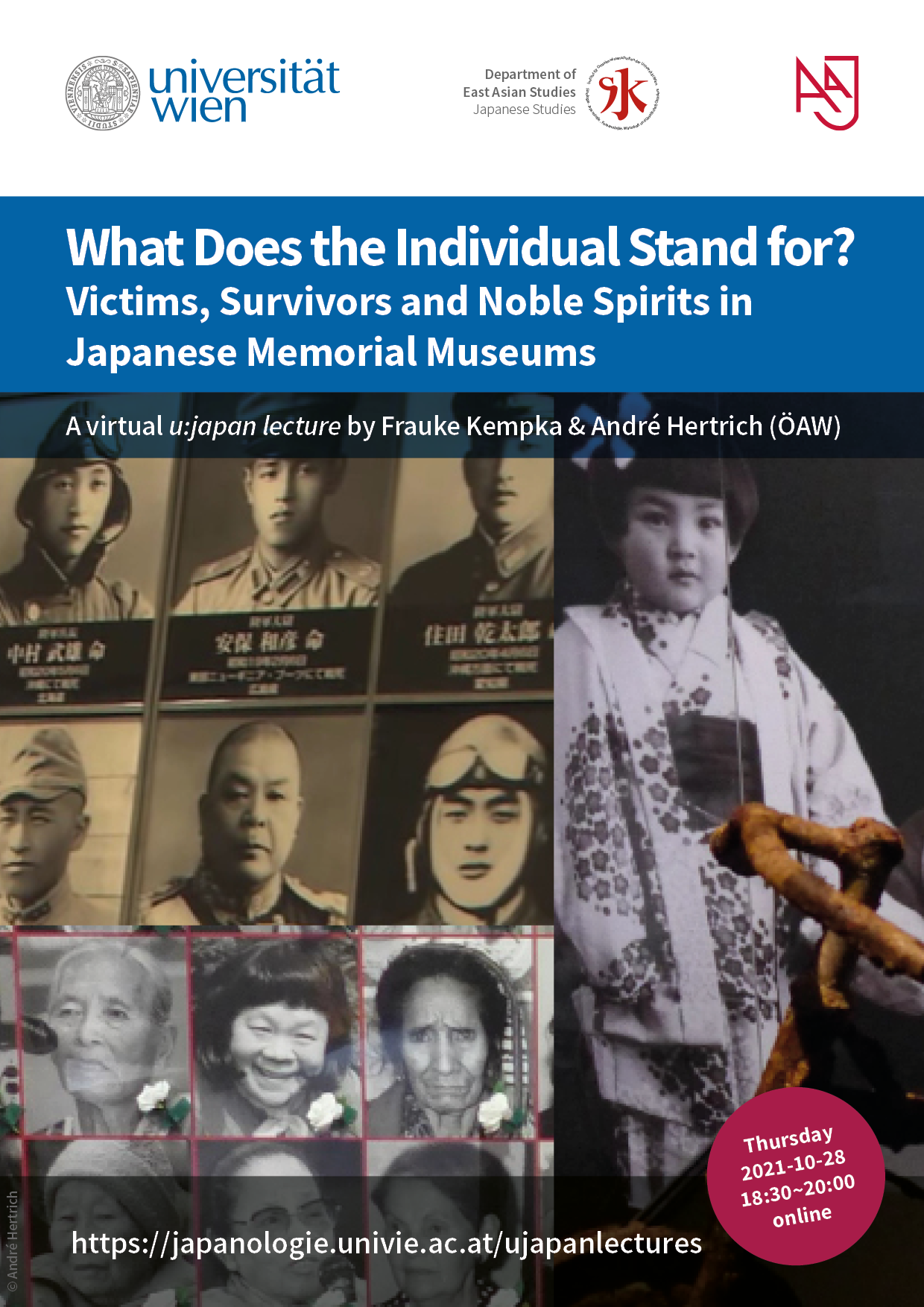 |
Season 3 | Fall-Winter 2021/22 | s03e03 | 28/10/2021 | en | Frauke Kempka & André Hertrich | ÖAW | Frauke Kempka is an Associated Researcher with the Globalized Memorial Museums ERC project at the Institute of Culture Studies and Theatre History, Austrian Academy of Sciences. She holds a Ph.D. in Japanese Studies from Martin-Luther-University Halle-Wittenberg, Germany and an M.A. degree in East Asian Art History and Japanese Studies from Freie Universität Berlin. André Hertrich is a Post-Doc Researcher with the Globalized Memorial Museums ERC project at the Institute of Culture Studies and Theatre History, Austrian Academy of Sciences. He holds an M.A. in Modern History and Japanese Studies from the Ludwig-Maximilians University (Munich), an M.A. in Peace and Conflict Studies from the Philips University (Marburg) and a Ph.D. degree in Japanese Studies from the University of Hamburg. | What Does the Individual Stand for? Victims, Survivors and Noble Spirits in Japanese Memorial Museums | Emotionally highly charged representations of individuals have become a prominent feature in many museums commemorating atrocities around the world. However, similar exhibition designs do not necessarily imply similarities in the contents of an exhibition or in its contributions to debates on commemoration. As a means to convey very divergent narratives about the war we will focus on representations of individuals at the Women's Active Museum (WAM), the Yûshûkan and Hiroshima Peace Memorial Museum. All three museums refer to WWII, but are otherwise worlds apart in their contributions to debates on how to commemorate the war in Japan. The WAM is a small private museum. It commemorates women who were exploited for sexual slavery by the Imperial Japanese Military around Asia, the so-called comfort women. Its exhibition places a strong emphasis on Japanese perpetratorship and the victimization of the women survivors. Since the state's involvement in and responsibility for the systematic perpetration of sexual slavery is often broadly rejected by conservative or right-wing actors in debates on WWII commemoration, the WAM is taking a critical stance towards mainstream debates. The Yûshûkan however represents a completely different brand of war memorialization. It is part of the Yasukuni Shinto Shrine, where the spirits of 2.5 million Japanese war dead are enshrined and deified. The Yûshûkan exhibits artifacts that are attributed to the individuals worshipped as “noble spirits” at Yasukuni Shrine. The exhibition stresses their humanity as loving husbands or dutiful sons and daughters and highlights their death as the ultimate sacrifice for their loved ones, alongside emperor and nation. Whereas the Yûshûkan seeks to present its "noble spirits" as role models for today's generation, the Hiroshima Peace Memorial Museum places its focus on the victimization of the city's population by the atomic bomb and the horrors of nuclear warfare. Especially the new exhibition which opened doors after an intensive renovation in 2019, puts the stories of beloved ones killed by the atomic bomb in the centre of its attention. Thus, the exhibition aims at “psychologically impact and […] emotionally grip the visitors” (City of Hiroshima) by concentrating on the individual victim and the feeling of loss and grief. We are therefore presenting findings from three Japanese museums that are representing opposing ways of commemorating WWII. Yet, individual photographs, personal artifacts and biographies are on display in all three exhibitions. In our presentation we are unravelling the different expositions of individuals within the WAM, the Yûshûkan and the Hiroshima Peace Memorial Museum. Assuming that “an exposition is always also an argument” (Bal 1996), we outline the museums' arguments as a contribution to the ongoing debates on how to commemorate WWII in Japan. | https://ustream.univie.ac.at/paella7/ui/watch.html?id=68454855-9fa3-4f83-b4d8-4ac6653e3106 | at | online | https://japanologie.univie.ac.at/ujapanlectures/s03/#e03 | History and Archaeology | Has Video | ||||||||
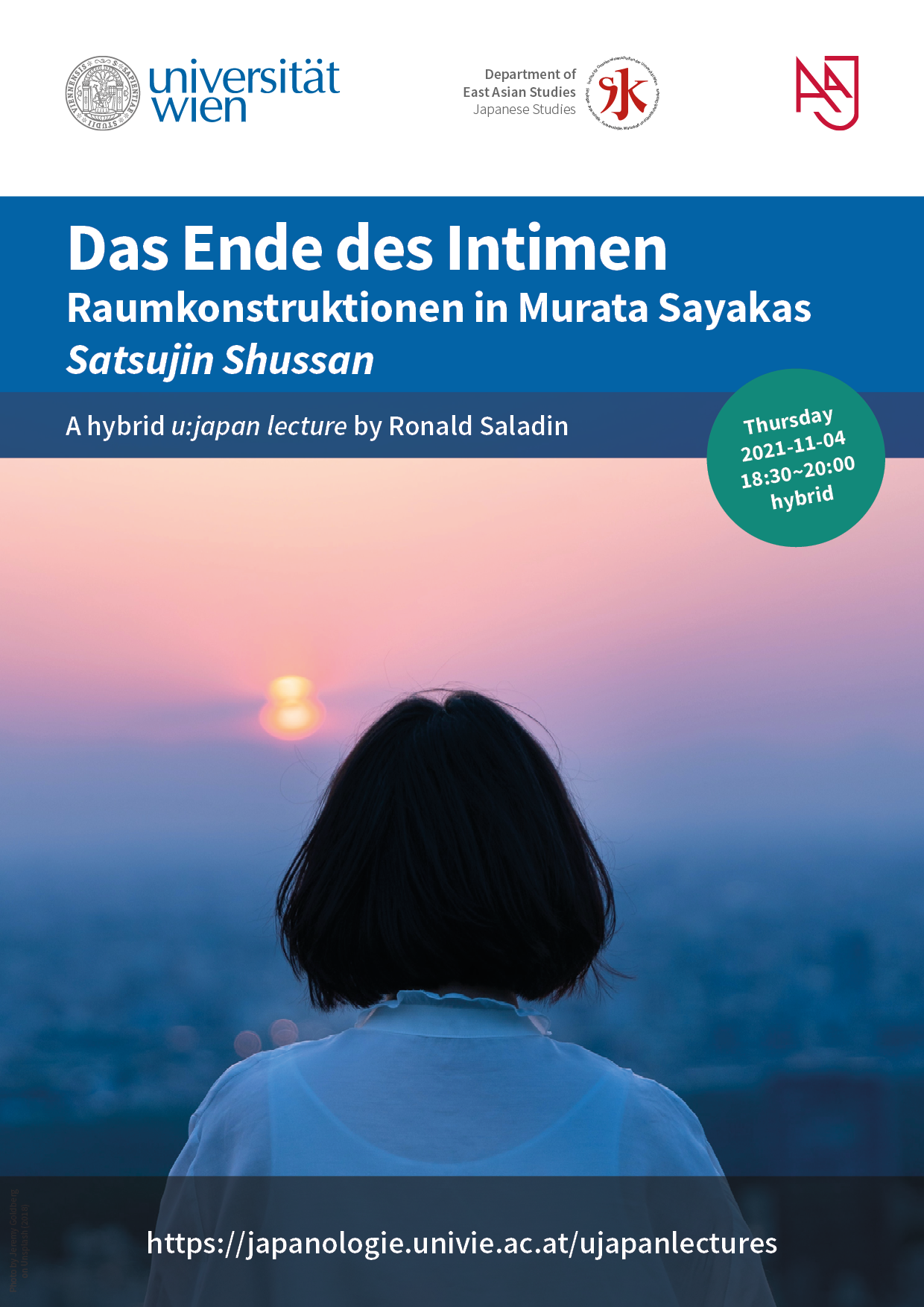 |
Season 3 | Fall-Winter 2021/22 | s03e04 | 04/11/2021 | de | Ronald Saladin | Universität Trier | Ronald Saladin ist Juniorprofessor für Japanologie an der Universität Trier. In Forschung und Lehre beschäftigt er sich mit japanischer Gegenwartsliteratur, Medien und Populärkultur, die er unter anderem aus Perspektive der Sozialwissenschaft, Gender Studies und Cultural Studies untersucht. Seine Dissertation ist 2019 unter dem Titel Young Men and Masculinities in Japanese Media – Unconscious Hegemony bei Palgrave Macmillan erschienen. | Das Ende des Intimen - Raumkonstruktionen in Murata Sayakas Satsujin Shussan | Murata Sayaka, die spätestens mit ihrem Roman Konbini ningen (2016, dt. „Die Ladenhüterin“) einen großen internationalen Erfolg gefeiert und damit auch außerhalb Japans Bekanntheit erlangt hat, wird angetrieben von dem in Frage stellen gegebener Tabus. Für sie persönlich ist das Schreiben ein Weg zu ergründen, woher die negativen Gefühle stammen, die durch diese Tabus evoziert werden. So fragt sie beispielsweise, wieso Notwehr oder aber die Todesstrafe erlaubt sind, wenn Mord doch eigentlich als Tabu gilt? Es ist typisch für Muratas Schaffen, sich mit den Spannungen zu befassen, die zwischen dem auftreten, was als soziale Norm verstanden wird, und Dingen oder Menschen, die sich aus irgendeinem Grund nicht daran anpassen können oder wollen. In Ihrer Kurzgeschichtensammlung Satsujin Shussan [Mordgeburt] beleuchtet Murata das Thema Liebe und Sexualität. Dabei handelt es sich um Themen, die die Autorin grundlegend in den meisten ihrer Werke behandelt. Bei den Kurzgeschichten dieses Bandes geht es vor allem darum, wie Liebe und Sexualität im Spannungsverhältnis zu Gesellschaft und Staat stehen. Dies trifft insbesondere auf die Geschichte zu, die dem Band ihren Namen gibt. In diesem Vortrag werde ich die Kurzgeschichte Satsujin Shussan mit einem Fokus auf Raumkonstruktionen analysieren. Dabei werde ich sowohl unter Bezug auf Foucaults Konzept der Heterotopie, Lotmanns Semiosphäre als auch narratologisch untersuchen, inwiefern Murata Raumkonstruktionen nutzt, um das Spannungsgefüge zwischen Individuum und Gesellschaft anhand von Sexualität und Fortpflanzung zu thematisieren und zu fokussieren. Dabei fragt sie nicht nur danach, wo Privates endet und öffentlicher Einfluss auf intimste Bereiche des Lebens beginnt, sondern karikiert ebenso, inwiefern „Normales“ unumstößlich als „normal“ angesehen werden kann. | https://ustream.univie.ac.at/paella7/ui/watch.html?id=4f187238-7b1f-42e8-af51-1feeefc28a4c | de | hybrid | https://japanologie.univie.ac.at/ujapanlectures/s03/#e04 | Literature and Media Studies | Has Video | ||||||||
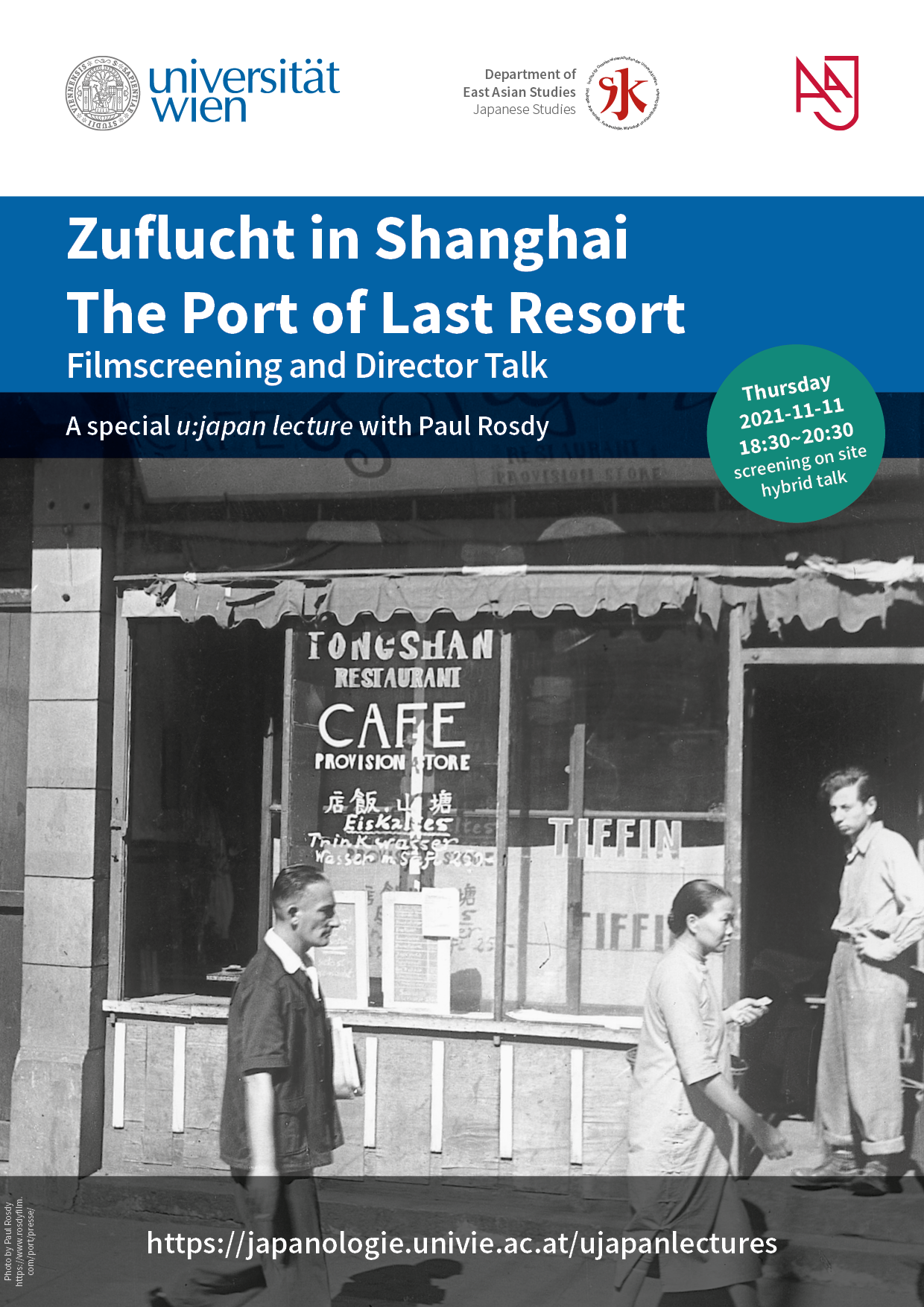 |
Season 3 | Fall-Winter 2021/22 | s03e05 | 11/11/2021 | de | Paul Rosdy "ZUFLUCHT IN SHANGHAI" | freischaffender Filmemacher, Wien | Geboren und aufgewachsen in Wien, war Paul Rosdy zunächst in der Tourismusbranche tätig. In den 1980er Jahren bereiste er für American Express die Welt: Sowjetunion, China, USA. Dann hatte er genug und übersiedelte nach Vancouver (Kanada), wo er einen Filmlehrgang abschloss. Sein erster Film hieß You Don’t Look for Street Signs When You’re in a Jungle (1991), gefolgt von Release Day (1992) – beide Filme setzten sich mit dem Leben im Gefängnis auseinander. In New York gründete er mit Joan Grossman Pinball Films und kam 1998 mit The Port of Last Resort – Zuflucht in Shanghai heraus, einem Film über die rund 20.000 Juden, die vor den Nazis nach Shanghai geflüchtete waren. Anschließend richtete er seinen Blick auf Mittel- und Südosteuropa und es entstand Neue Welt (2005), eine Fahrt durch die Mitte Europas, von der alten Welt in eine neue. 2009 machte er Çernobílá Barevná (Schwarzweiss Farbe), eine tschechische Auftragsproduktion über die Veränderungen in Zeit und Raum in den nordböhmischen Braunkohlegebieten. 2011 Der letzte Jude von Drohobytsch: ein Portrait über Alfred Schreyer, der eine Geschichte zu erzählen hat, so unglaublich, dass ein Leben nicht ausreicht, sie zu fassen. 2012 begann eine lange Reise durch die Kinolandschaft und -geschichte Wiens von 1896 bis heute. 2018 feiert Kino Wien Film beim Viennale Film Festival Premiere. | Zuflucht in Shanghai - The Port of Last Resort | THE PORT OF LAST RESORT presents the little-known story of nearly 20,000 European Jewish refugees who fled to Shanghai in the years 1938-41. Shanghai was a free port that did not require papers for entry, and became the “last resort” to find a safe haven from the Nazis. This lost world is revealed through the memories of four survivors, and through a collage of rare and remarkable film footage. Extraordinary images of refugees and uncommon views of Chinese life create a compelling vantage point for understanding and experiencing this story of survival. ... more about the film https://www.rosdyfilm.com/port and the trailer https://www.rosdyfilm.com/port/en/zuflucht-2/#trailer | at | on site | https://japanologie.univie.ac.at/ujapanlectures/s03/#e05 | Literature and Media Studies, Arts (visual arts and performing arts) and Art History, History and Archaeology | ||||||||||
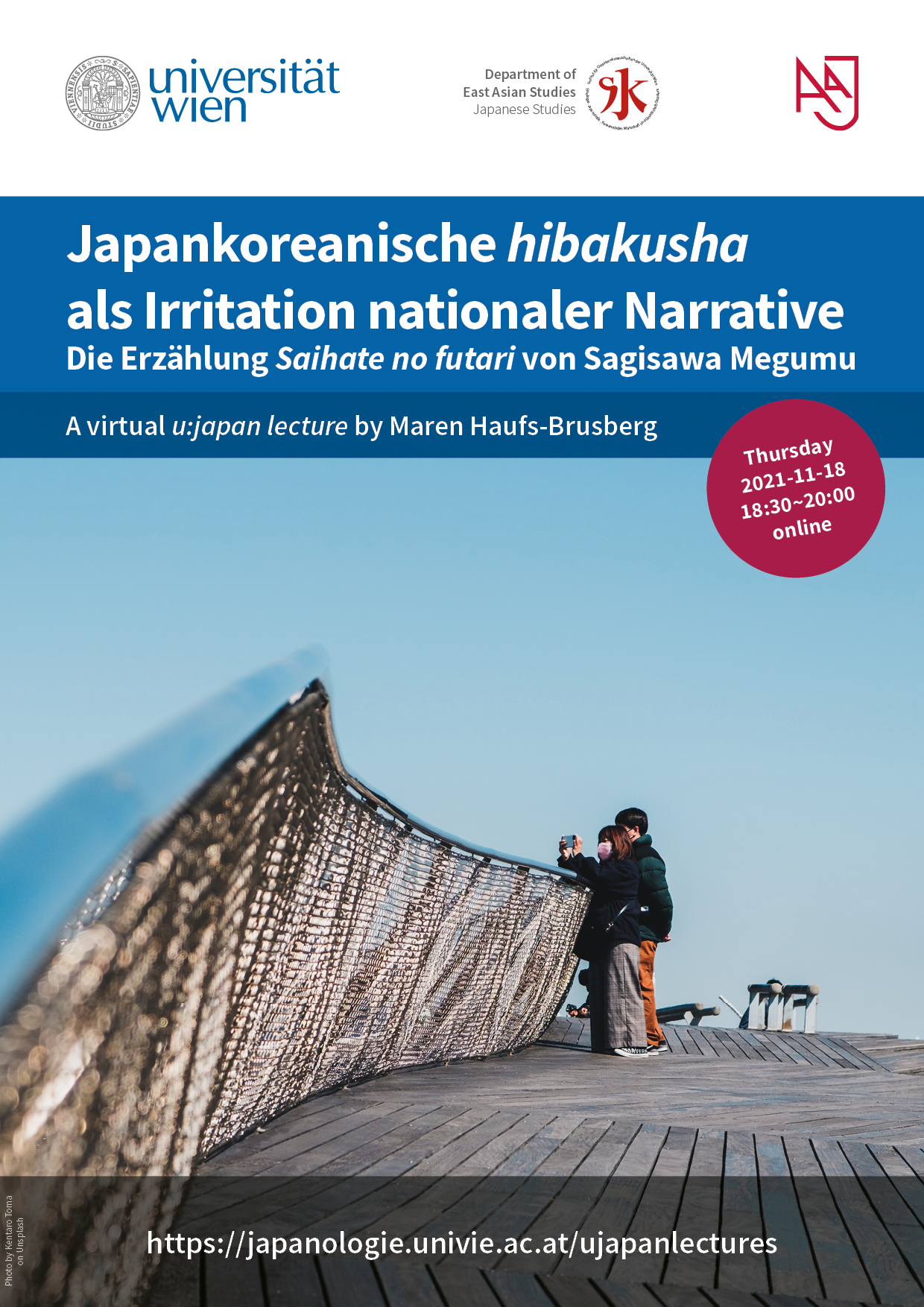 |
Season 3 | Fall-Winter 2021/22 | s03e06 | 18/11/2021 | de | Maren Haufs-Brusberg | Universität Düsseldorf | Maren Haufs-Brusberg M.A. studierte mit interdisziplinärer Ausrichtung Japanologie, Politikwissenschaften, Philosophie und Soziologie an der Universität Trier. 2007/2008 absolvierte sie als DAAD-Stipendiatin ein Studienjahr an der Tōkyō kokusai daigaku in Kawagoe, Saitama. Nach ihrem Studium war sie von 2013 bis 2018 als Lehrbeauftragte in der Japanologie der Universität Trier tätig, wo sie auch ihr Promotionsvorhaben zu Verflechtungen von Ethnizität und Gender in der japankoreanischen Gegenwartsliteratur begann. Von August bis Oktober 2018 forschte sie hierfür als Stipendiatin am Deutschen Institut für Japanstudien (DIJ) in Tokyo. Seit ihrer Rückkehr nach Deutschland ist sie wissenschaftliche Mitarbeiterin am Institut für Modernes Japan an der Heinrich-Heine-Universität Düsseldorf. | Japankoreanische hibakusha als Irritation nationaler Narrative: Die Erzählung Saihate no futari („Zwei Menschen am Rande“, 1999) von Sagisawa Megumu | Die Schriftstellerin Sagisawa Megumu (鷺沢萠, 1968-2004) gilt sowohl als Autorin von Prekariatsliteratur als auch von japankoreanischer Literatur. Nachdem sie erst nach ihrem frühen literarischen Debut 1987 entdeckte, dass ihre Großmutter väterlicherseits koreanischer Herkunft war, begann sie, sich intensiv mit der japankoreanischen Minderheit in Japan zu beschäftigen und ab 1994 Texte hierzu zu veröffentlichen. In meinem Vortrag setze ich mich mit Sagisawas 1999 publizierter Erzählung Saihate no futari („Zwei Menschen am Rande“) auseinander. Im Mittelpunkt der Erzählung steht eine junge Frau, die ein uneheliches Kind eines US-Soldaten und einer Japanerin ist. Sie arbeitet in einer Bar, wo sie sich in einen Gast verliebt, einen Japankoreaner, der deutlich älter ist als sie. Die Beziehung zwischen beiden währt jedoch nur wenige Monate, da der Japankoreaner bald an Leukämie verstirbt. Wie sich im Nachhinein herausstellt, war er der Nachkomme einer hibakusha, denn seine ebenfalls in mittleren Jahren verstorbene Mutter war eine Überlebende des Atombombenabwurfs auf Nagasaki. Die Erzählung endet damit, dass die Protagonistin bemerkt, dass sie schwanger ist. Wie anhand der knappen Zusammenfassung der Erzählung deutlich wird, entwirft Saihate no futari bereits durch die Figurenkonstellation ein komplexes Netz an Beziehungen und Verweisen, dessen Fäden gewissermaßen in der Figur des Ungeborenen zusammenlaufen: Dessen Vorfahren väterlicherseits sind koreanischer Herkunft. Seine Großeltern emigrierten als Folge der Kolonialisierung Koreas und des von Japan geführten Pazifikkriegs nach Japan, wo die Großmutter Opfer des US-amerikanischen Atombombenabwurfs auf Japan wurde. Dieser bedeutete für Japan die rasche Kapitulation, für die USA den Sieg und für Korea die Befreiung von der japanischen Kolonialherrschaft. Seine Großmutter mütterlicherseits hingegen ist Japanerin und der Großvater mütterlicherseits ein US-Soldat, der im Zuge des Vietnamkriegs in Japan stationiert war, womit auch auf den Kalten Krieg, in dem die nukleare Bedrohung eine wesentliche Rolle spielte, verwiesen wird. In meinem Vortrag richte ich meinen Fokus auf die Figuren der japankoreanischen hibakusha in der Erzählung, nämlich der Mutter des Japankoreaners als hibakusha der ersten Generation und ihren Sohn als hibakusha der sogenannten zweiten Generation, und arbeite heraus, inwiefern diese vor dem Hintergrund der geschilderten komplexen Figurenkonstellation sowohl vorherrschende nationale japanische Narrative als auch US-amerikanische Narrative der Atombombenabwürfe irritieren. | https://ustream.univie.ac.at/paella7/ui/watch.html?id=fc07798f-83ef-4bca-91ee-2128bfc50c3e | de | online | https://japanologie.univie.ac.at/ujapanlectures/s03/#e06 | Literature and Media Studies, History and Archaeology | Has Video | ||||||||
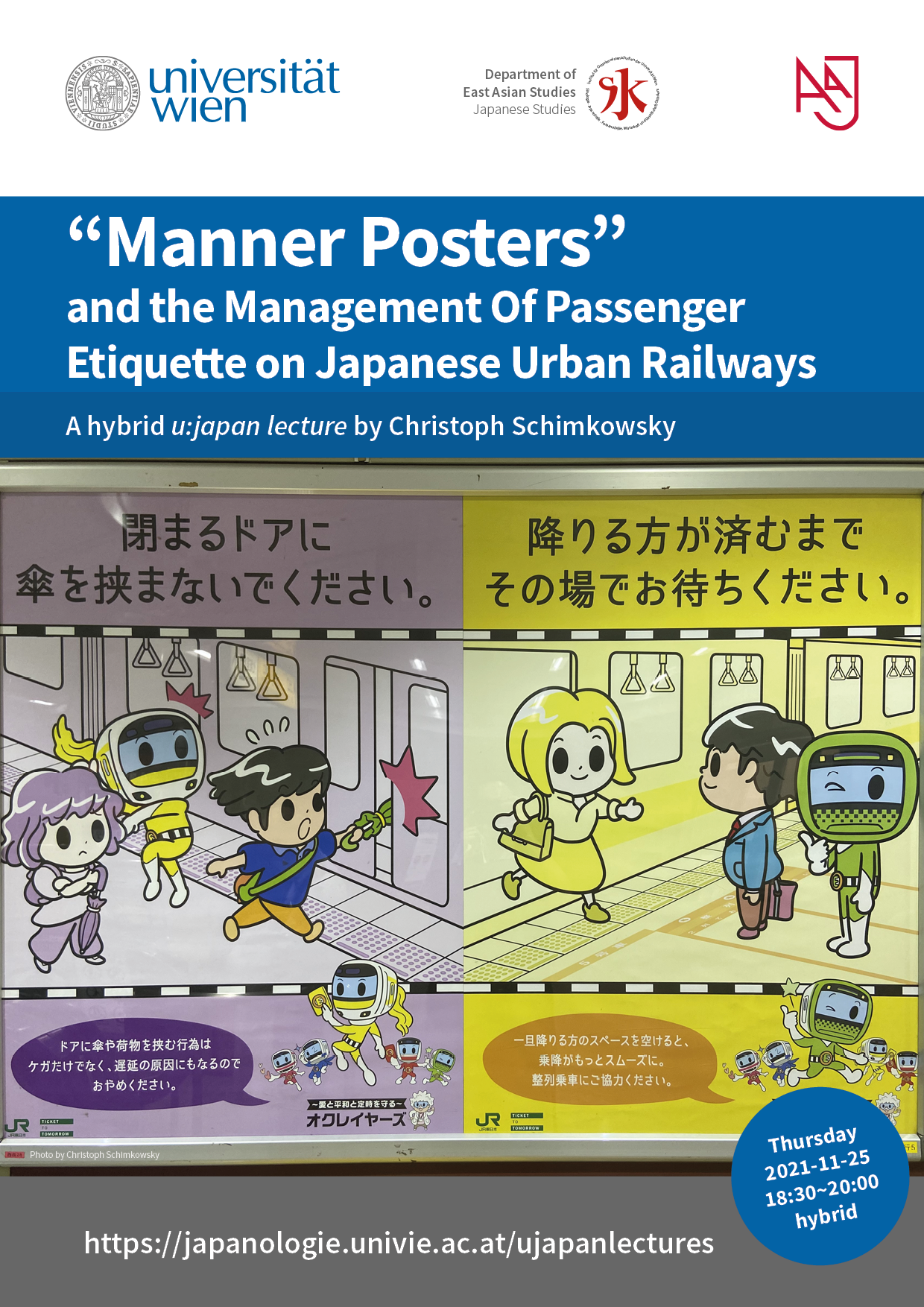 |
Season 3 | Fall-Winter 2021/22 | s03e07 | 25/11/2021 | en | Christoph Schimkowsky | University of Sheffield | Christoph Schimkowsky is a PhD researcher in the Department of Sociological Studies and the School of East Asian Studies at the University of Sheffield studying passenger manner improvement initiatives by Japanese railway providers. He holds MA degrees in Anthropological Research Methods (SOAS, University of London) and International Relations (Waseda University), as well as a BA degree in Political Science & Social and Cultural Anthropology (University of Göttingen) and was a visiting research fellow at Keio University and Waseda University when conducting fieldwork for his doctoral thesis. Christoph’s work has appeared in Japanese Studies, Contemporary Japan, and Mobilities, among others. His research interests include urban mobilities, visual communication, and the management of everyday conduct and public life in contemporary cities. | “Manner Posters” and the Management of Passenger Etiquette on Japanese Urban Railways | Illustrated posters appealing to passenger conduct – so-called “manner posters” (manā posutā) – are ubiquitous in Japanese public transport spaces. Usually issued by public transport providers, Japanese manner posters target a broad range of potentially problematic passenger behaviours such as the “correct” way to transport luggage or hold a smartphone on a crowded train. Notably, manner posters usually avoid straightforward prohibitions or modes of address that could be perceived as moralizing by passengers. Instead, they attempt to encourage desirable commuter conduct in a polite, friendly, or humorous manner. To do so, manner posters employ highly creative designs featuring cultural references, cute characters or elaborate drawings. This has repeatedly brought them to public attention in Japan and abroad, as seen in Tokyo Metro’s well-known “Please do it at home” poster series or Seibu Railway’s series of woodblock print (ukiyo-e)-themed posters. This lecture provides an introduction to manner posters as a friendly yet pervasive media presence in Japanese urban transport environments. It offers a glimpse behind the curtain of manner poster production by exploring the corporate and creative considerations driving poster design and deployment. Drawing on expert interviews with transport, advertising and design professionals, alongside analysis of archival materials, the talk provides an overview of the content, production pathways, history, and design motivations of manner posters. While there is a tendency in popular and academic discourse to understand manner posters as a strategy of social control, this lecture contends that corporate manner improvement poster initiatives are not primarily concerned with disciplining passengers but satisfying customer sensibilities. It examines company and designer perspectives on posters’ content, design, and limitations to argue that manner poster production is not driven by normative conceptions of “good” and “bad” passenger behaviour, but is primarily shaped by concerns about customer sensibilities and satisfaction. | https://ustream.univie.ac.at/paella7/ui/watch.html?id=ace77031-6e91-4e50-ac06-0da8c4532ff7 | uk | online | https://japanologie.univie.ac.at/ujapanlectures/s03/#e07 | Architecture and Urban Studies, Literature and Media Studies | Has Video | ||||||||
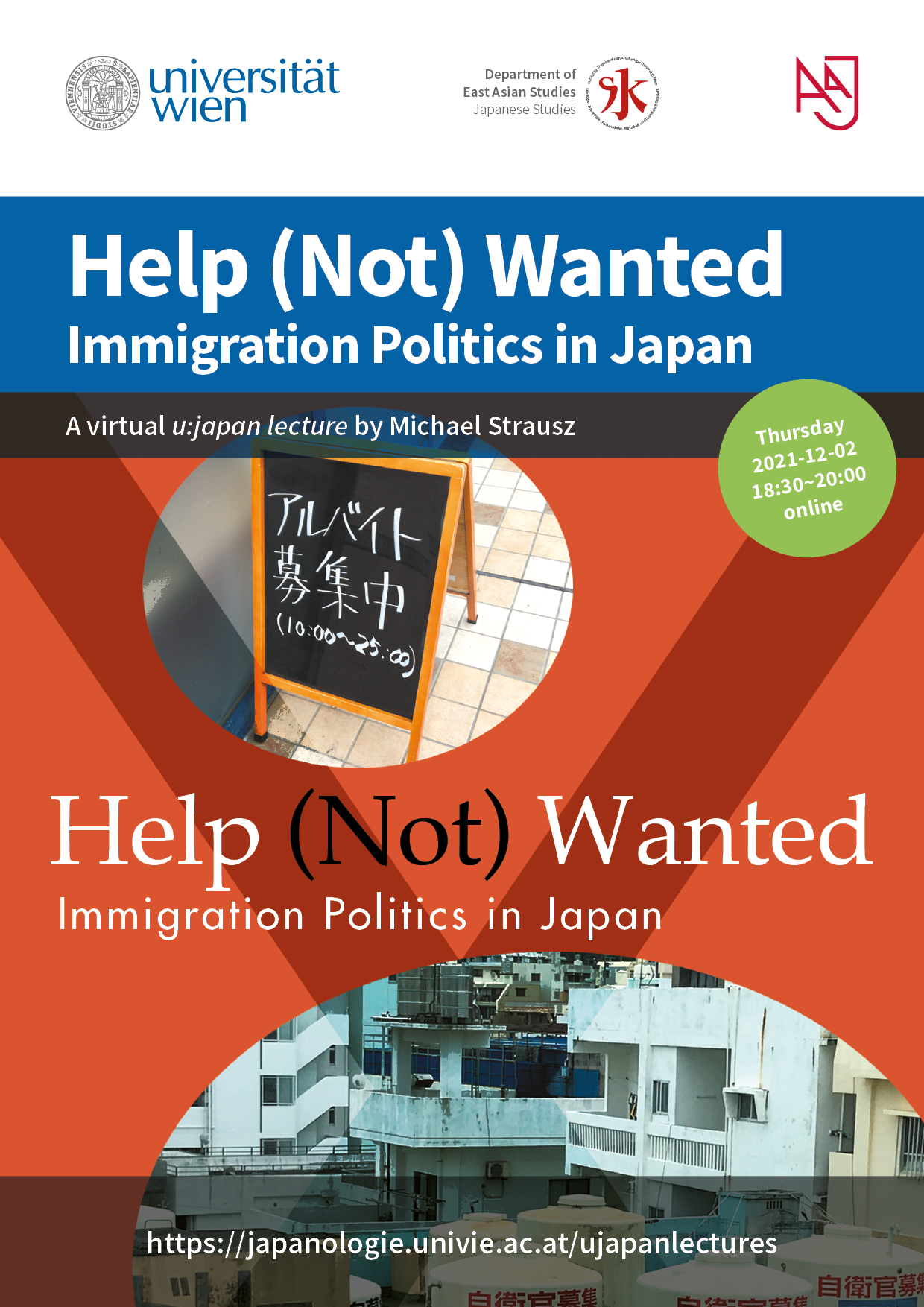 |
Season 3 | Fall-Winter 2021/22 | s03e08 | 02/12/2021 | en | Michael Strausz | Texas Christian University | Michael Strausz is an Associate Professor of Political Science and the Director of Asian Studies at Texas Christian University. He earned his PhD in Political Science from the University of Washington in 2007. He is currently editing a collection of essays by an interdisciplinary group of scholars tentatively titled The Past and Future of Immigration in Japan which aims to put recent immigration reforms into context. His book Help (Not) Wanted: Immigration Politics in Japan was published in 2019 with SUNY Press. | Help (Not) Wanted: Immigration Politics in Japan | Why has Japan’s immigration policy remained so restrictive, especially in light of economic, demographic, and international political forces that are pushing Japan to admit more immigrants? Michael Strausz will answer this question by drawing on insights from nearly two years of intensive field research in Japan. In addition to answering this question by outlining the central argument of his 2019 book, Help (Not) Wanted: Immigration Politics in Japan, this presentation provide context to recent developments in Japanese immigration policy – particularly the December 2018 decision to admit more than 300,000 foreign manual laborers, the immigration policy response to the COVID pandemic, and the role of immigration in the 2021 House of Representatives election. | https://ustream.univie.ac.at/paella7/ui/watch.html?id=9b23ef9e-2424-4661-9dd2-e4179c106a26 | us | online | https://japanologie.univie.ac.at/ujapanlectures/s03/#e08 | Political Science and Law, Economics and Business Studies, Sociology and Social Sciences | Has Video | ||||||||
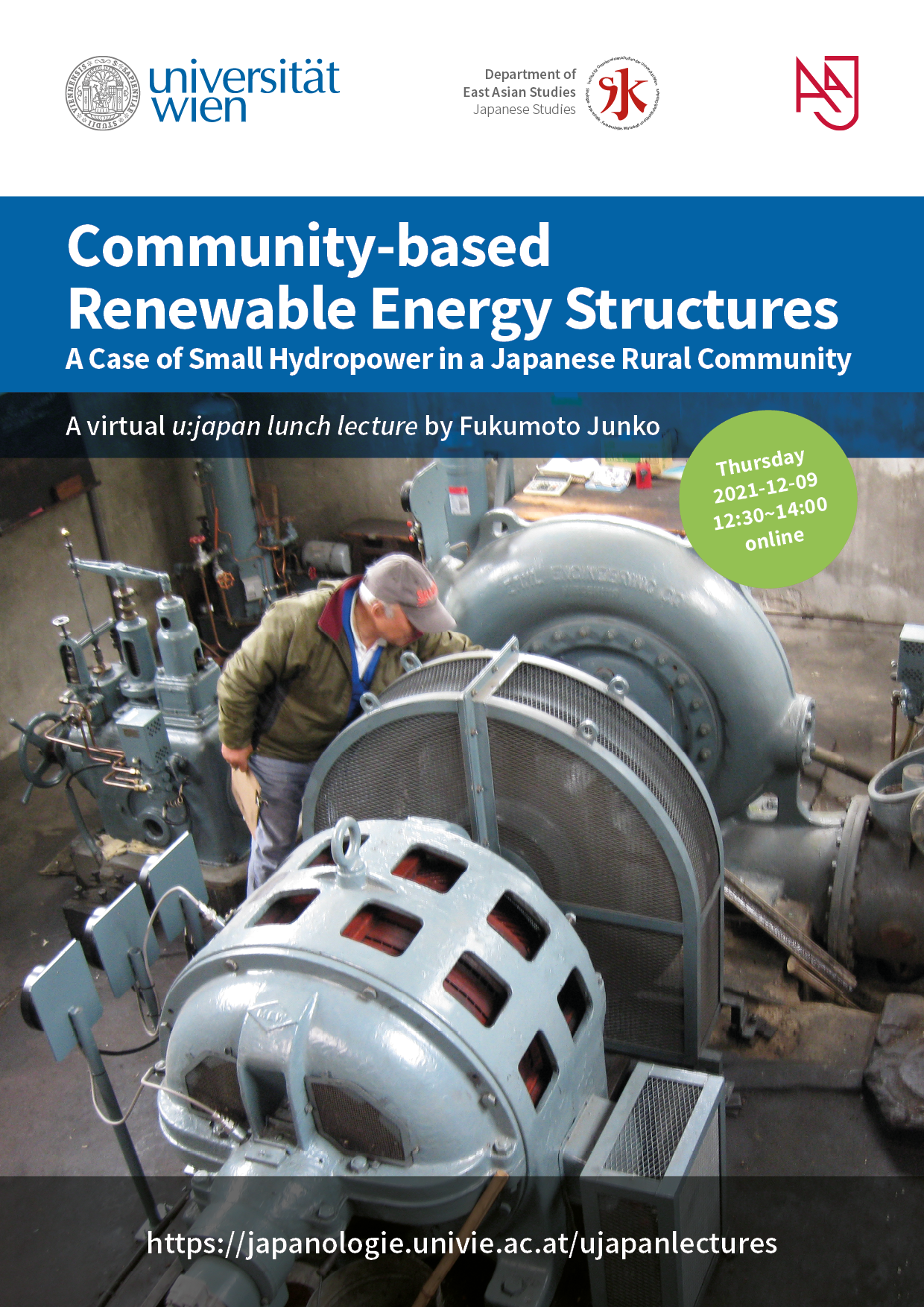 |
Season 3 | Fall-Winter 2021/22 | s03e09 | 09/12/2021 | en | Junko Fukumoto | Fukuoka Prefectural University | Junko Fukumoto is a lecturer at Fukuoka Prefectural University. After graduating from Waseda University, she continued her studies at Kumamoto University, specializing in Community Sociology, Environmental Sociology and Rural Sociology. Using ethnographic fieldwork, she focusses mainly on research regarding depopulated rural hamlets, the application of renewable energy and topics regarding life in rural areas, such as the problems surrounding agricultural leaders and damages due to wildlife. | Community-based Renewable Energy Structures: A Case of Small Hydropower in a Japanese Rural Community | Since the Fukushima nuclear accident in 2011, Japan has started to turn its attention towards renewable energy. Before the accident, renewable energy attracted little attention in Japan, and the rate of expanding energy production in that direction was very low. Unlike Austria or Germany, Japan has been slow to implement new institutional or political measures to stimulate the expansion of renewable energy, which is why it is still not among the popular ways of energy production. Further, the public’s interest regarding renewable energy is rather low and the popularization due to social movements cannot be anticipated anytime soon. Due to Japan’s rather steep topography, one might expect small hydropower generation to be an obvious choice of energy production. However, just like other forms of renewable energy, the introduction of small hydropower generation is still scarce. However, while their numbers remain low, it is indisputable, that small hydropower plants are looking back on a long history within Japan. How are they being sustained, even though they receive neither favorable treatment by official the government, nor support by citizen’s high environmental consciousness? In this presentation I will use an ethnographic case-study to disclose, how the preservation of small hydropower plants hinges on the traditional ways in rural communities throughout Japan. In order to find a realistic way to expand the usage of renewable energy in Japan it is essential to first understand the current state of rural communities. While considering the aspects mentioned above, I will introduce the structures and equality of rice cultivation in rural hamlets in Japan. | https://ustream.univie.ac.at/paella7/ui/watch.html?id=de0d8587-6769-4418-b708-3aafccc7291e | jp | online | https://japanologie.univie.ac.at/ujapanlectures/s03/#e09 | Agriculture and Rural Studies, Sociology and Social Sciences | Has Video | ||||||||
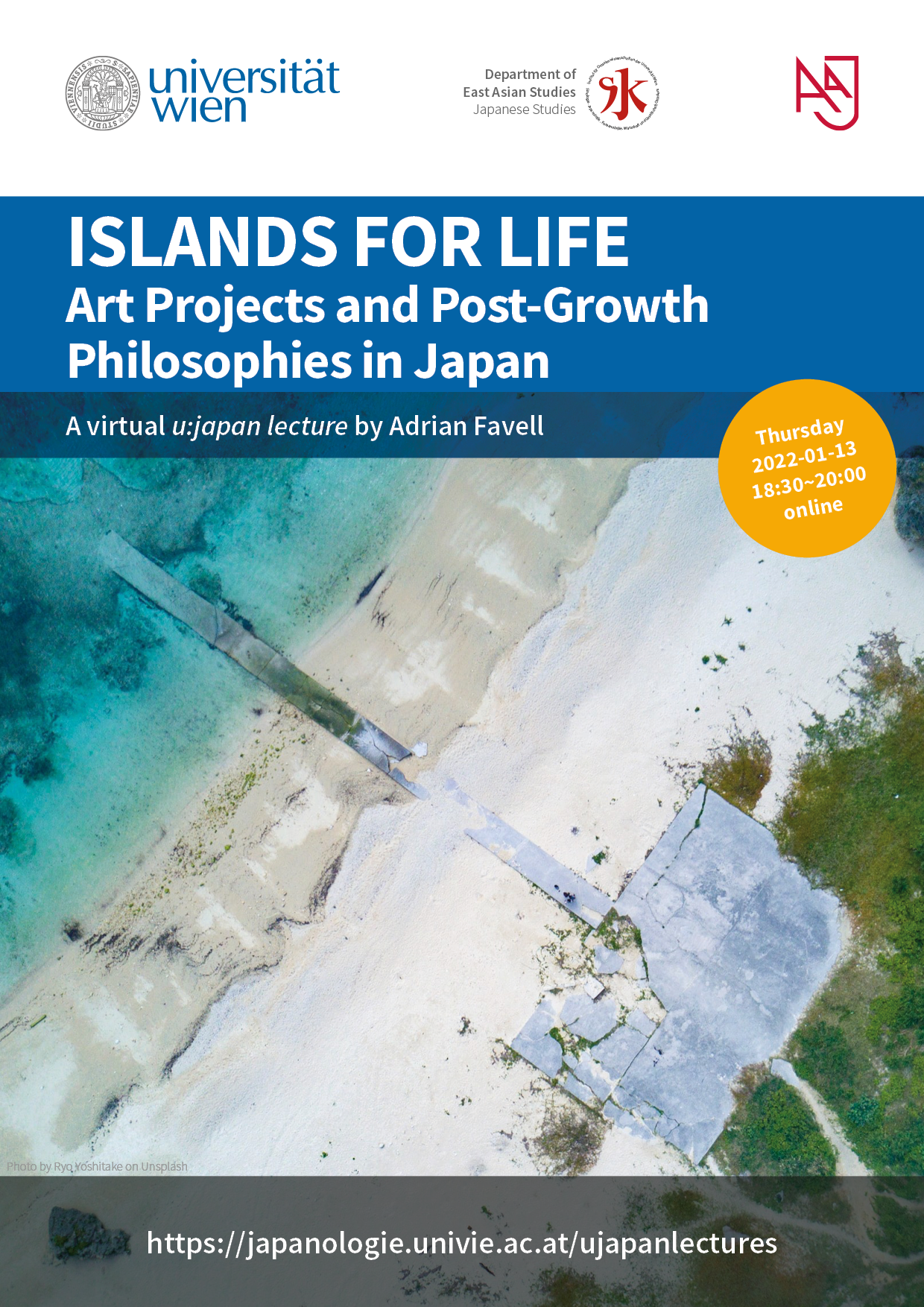 |
Season 3 | Fall-Winter 2021/22 | s03e11 | 13/01/2022 | en | Adrian Favell | University of Leeds | Adrian Favell is Chair in Sociology and Social Theory at the University of Leeds, UK and Director of the Bauman Institute. He is the author of various works on immigration politics, citizenship, multiculturalism and cosmopolitanism. In 2006-7 he was a Japan Foundation Abe Fellow in Tokyo, leading to the publication of Before and After Superflat: A Short History of Japanese Contemporary Art 1990-2011 (2012). A revised, updated and expanded 2nd edition of this book, including a full discussion of more recent post-disaster and post-growth art projects since 2011, will be published in 2022 by the Sainsbury Institute for the Study of Japanese Arts and Cultures (SISJAC). He has also published essays in Art in America, Bijutsu Techo, Impressions, Artforum, ART-iT online, and for the catalogue of a exhibition in 2021 on Tokyo: Art and Photography at the Ashmolean Museum, Oxford. He is currently working on a book about "post-growth" art and architecture in Japan, a long term collaboration with the architect Julian Worrall, University of Tasmania. More info: www.adrianfavell.com | ISLANDS FOR LIFE: Art Projects and Post-Growth Philosophies in Japan | Japan offers one of the most dramatic examples of population decline and urban/rural polarization in the world. Although mostly off the radar of contemporary art theory discussions abour "socially engaged art", this context has provided some of the most creative international examples of bi/tri-ennales and art projects working in remote locations with socially isolated, ageing populations. My presentation will discuss in particular the ideas and practice developed by art producer Fram Kitagawa in Niigata's Echigo Tsumari (a triennale that has been running since 2000), as well as the Seto island based art projects of the artist Yukinori Yanagi, including one I have participated in, the Momoshima Art Base. While these projects draw on the almost limitless resources offered by the voluntary participation of young "lost generation(s)" artists and creatives as well as abundant empty properties in remote locations, a younger generation have responded in their own way to Japan's stagnation and dilemmas over housing and art careers, with anarchist-like ideas of autonomous self-sufficiency and collective organisation. Here I consider the examples of Chaos Lounge, Kyohei Sakaguchi, Parplume and Shibu House. These various projects raise interesting questions about the progressive intention of their ideas about the post-growth condition in Japan, as well as the particular politics of art organisation and participation in these contexts. RECOMMENDED READING: "Echigo-Tsumari and the art of the possible: the Fram Kitagawa philosophy in theory and practice", in Fram Kitagawa, Lynne Breslin, Adrian Favell et al, Art Place Japan: The Echigo-Tsumari Triennial. Reconnecting Art and Nature. New York: Princeton Architectural Press, pp.142-173. | https://ustream.univie.ac.at/paella7/ui/watch.html?id=d9c01db5-5e06-4de9-945b-e24640cbc668 | uk | online | https://japanologie.univie.ac.at/ujapanlectures/s03/#e11 | Arts (visual arts and performing arts) and Art History, Religion and Philosophy, Sociology and Social Sciences | Has Video | ||||||||
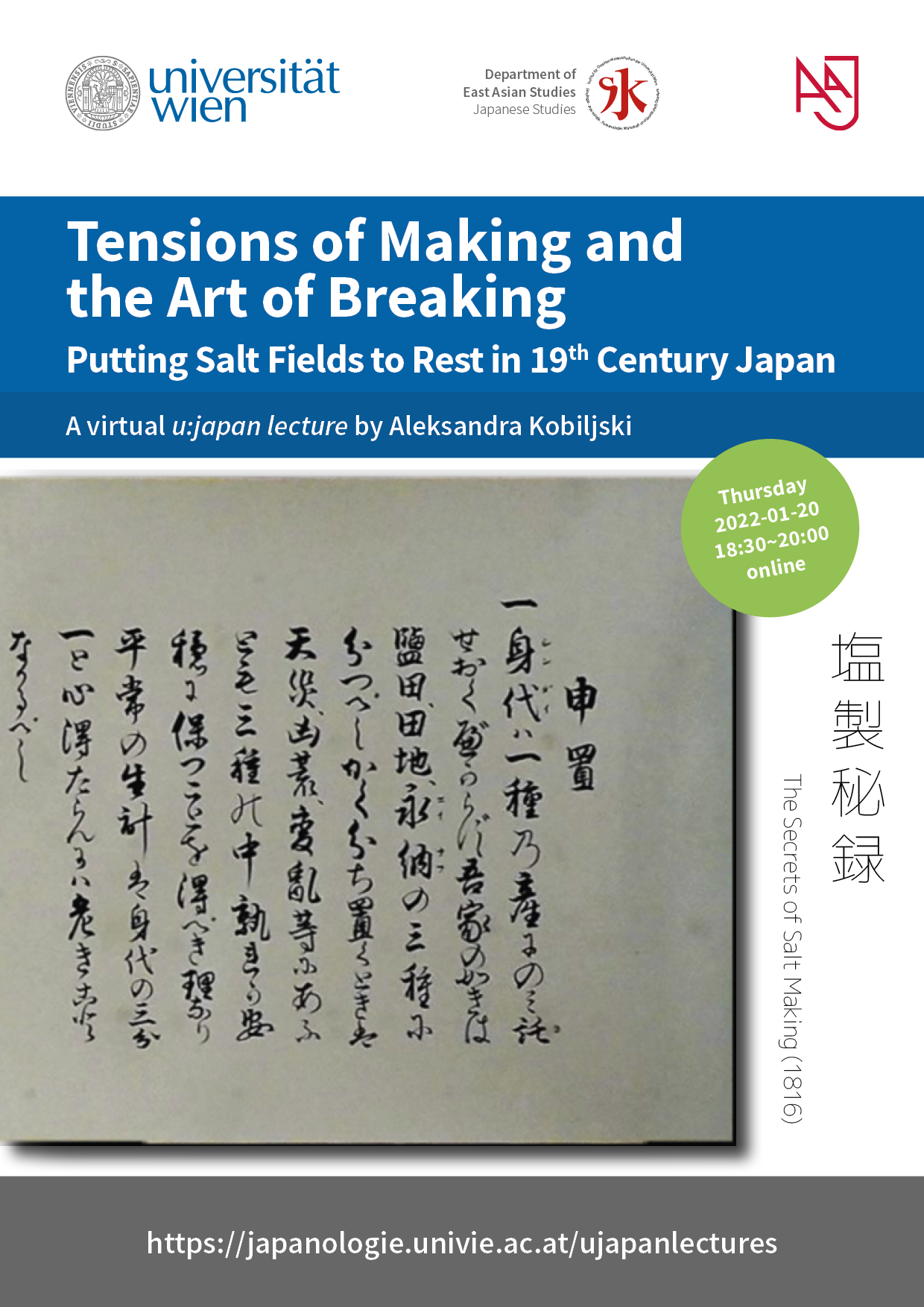 |
Season 3 | Fall-Winter 2021/22 | s03e12 | 20/01/2022 | en | Aleksandra Kobiljski | EHESS | Aleksandra Kobiljski is Senior Researcher in Modern and Contemporary History at the French National Centre for Scientific Research (CNRS). Before joining the CNRS she taught at University of Belgrade and Harvard University. Since 2022, she is the Principal Investigator of J-InnovaTech, a European Research Council (ERC) funded project which explores structuring characteristics of Japan's early industry from 1800 to 1885 (ERC StG GA 805098). | Tensions of Making and the Art of Breaking: Putting Salt Fields to Rest in 19th Century Japan | Drawing on a preliminary reading of The Secrets of Salt Making 塩製秘録, an 1816 salt-making manual by a little-known Japanese salt-maker Miura Genzô 三浦源蔵 (?-1835), this lecture seeks to address the change in production dynamics in the Seto Inland Sea region in the first half of the 19th century. In so doing, this talk contributes to the rethinking of the nature of Japan's early industry and conceptualization of profit. | fr | online | https://japanologie.univie.ac.at/ujapanlectures/s03/#e12 | History and Archaeology, Science and Technology Studies (STS) and Digital Humanities | ||||||||||
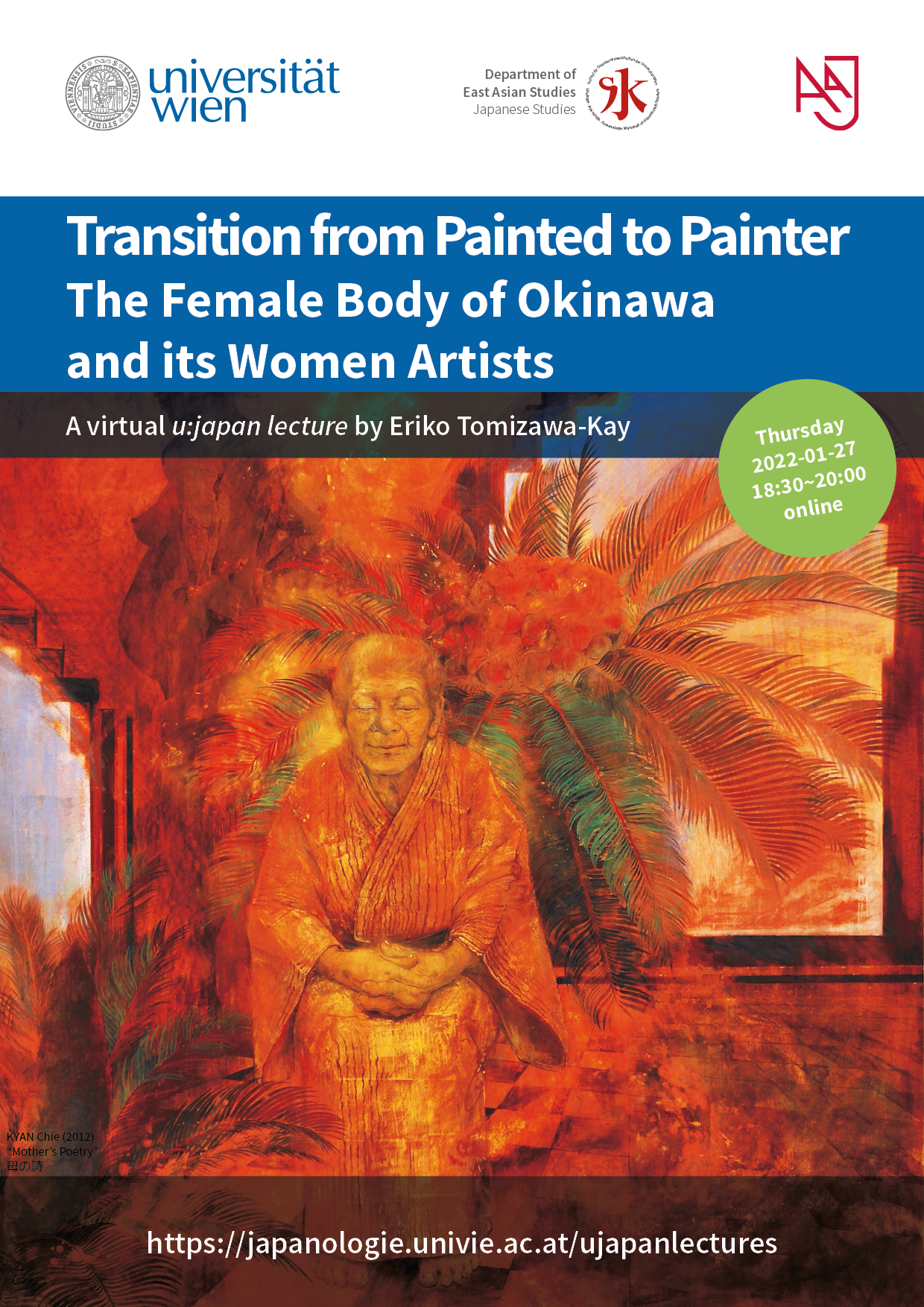 |
Season 3 | Fall-Winter 2021/22 | s03e13 | 27/01/2022 | en | Eriko Tomizawa-Kay | University of East Anglia | Eriko Tomizawa-Kay is lecturer in Japanese Language and Culture, at School of Politics, Philosophy, Language and Communication Studies, the University of East Anglia. She specializes in modern Japanese art history, particularly nihonga (Japanese style painting): She is the organizer of 2019 international conference, entitled "Okinawan Art in its Regional Context: Historical Overview and Contemporary Practice". The conference report (Japanese/English) will be available on the website shortly as Sainsbury Institute Occasional Papers 2. Her publications include ‘Reinventing Localism, Tradition, and Identity: The Role of Modern Okinawan Painting (1630s - 1960s)’ In East Asian Art History in a Transnational Context, edited by Tomizawa-Kay, E. & Watanabe, T. Routledge, 2019. | Transition from Painted to Painter: The Female Body of Okinawa and its Women Artists | In pre-war Okinawa, while male painters were striving to be recognized and acknowledged by central art circles, with the exception of female students under the tutelage of Okinawan male teachers, opportunities for Okinawan women as artists were extremely limited. The emergence of Okinawan female artists had to wait until the post-war period. This paper discusses the significance of depictions of Okinawan women wearing Ryukyuan apparel - a favourite subject of both Japanese painters and Okinawan male painters during the war emergency period (1930s and 1940s) - in order to elucidate the social complexities of Okinawan women at that time when Okinawa was under the dominion of the Japanese Empire. This paper examines three issues: first, how the representations of the Okinawan female body were appropriated to express the relationship between subjugated Okinawa and mainland Japan, and justify discrimination against the Okinawan people. Secondly, during the post-war period, how Okinawan female artists establish their careers and identity under the periphery of the nation-states of Japan and the patriarchy in Okinawa. Finally, I discuss contemporary Nihonga, which is also labelled as contemporary Ryukyu painting, painted by female artists in Okinawa. This presentation will also reconsider contemporary Okinawan painting by female painters in relation to both Japanese and East Asian art histories in order to cast a new view of Okinawan painting as the living Traditional Painting, and also Modern Okinawan Painting as a descendant of Ryukyu. | https://ustream.univie.ac.at/paella7/ui/watch.html?id=6267d5e5-e878-4061-9184-e4e061fc1b68 | uk | online | https://japanologie.univie.ac.at/ujapanlectures/s03/#e13 | Arts (visual arts and performing arts) and Art History, Gender Studies and Minority Studies | Has Video | ||||||||
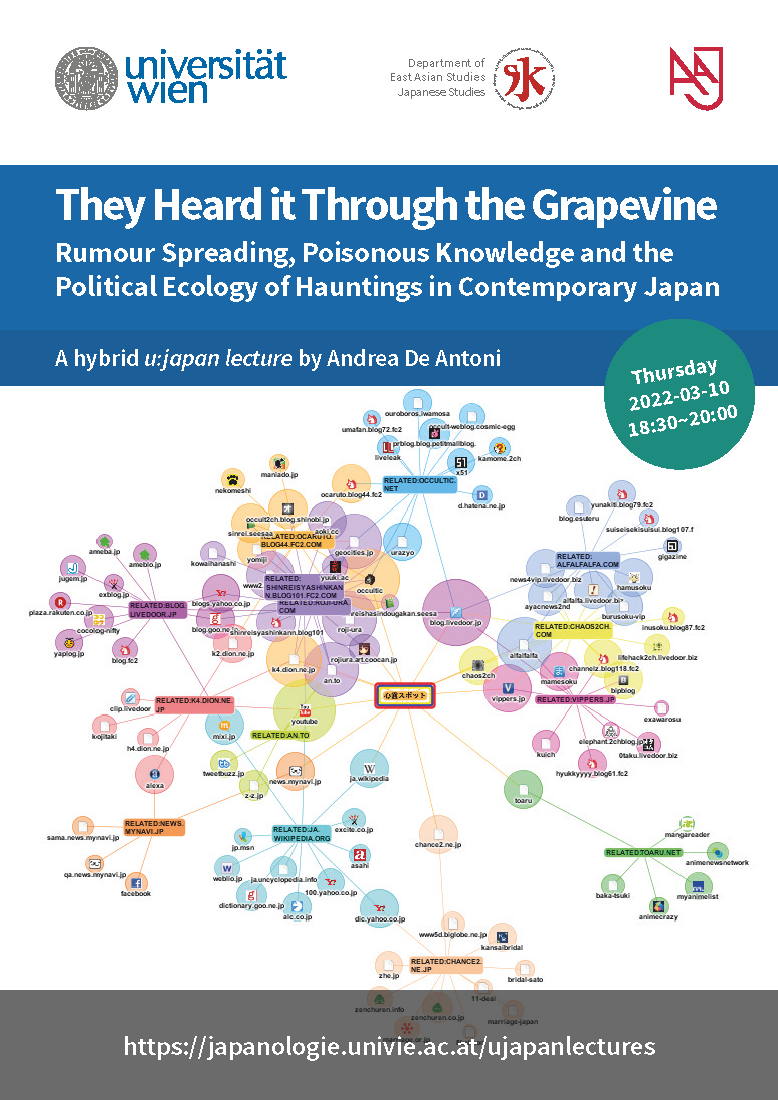 |
Season 4 | Spring 2022 | s04e01 | 10/03/2022 | en | Andrea de Antoni | Kyoto University | Andrea De Antoni (Ph.D.) is an Italian socio-cultural anthropologist with a main interest in religion and spirituality, and currently associate professor at Kyoto University. His main research area is contemporary Japan, but he has carried out ethnographic research also in Italy and Austria. His fields of inquiry include experiences with spirits and social suffering, especially in relation to the perception of space and place (particularly places related to death and the afterlife, as well as haunted places), rumors and discrimination, construction of social memory and “tradition”, tourism and commodification, spirit/demonic possession, exorcism and religious/spiritual healing. From a theoretical perspective, he focuses on the anthropology of the body, the perception of the environment, affect and emotions. He published extensively on these topics in English and Japanese. He authored Going to Hell in Contemporary Japan: Feeling Landscapes of the Afterlife, Othering, Memory and Materiality (Routledge, forthcoming 2022), and co-edited several books and special issues of academic journals. He is also the coordinator of the international networks “Skills of Feeling with the World: Anthropological Research on the Senses, Affect and Materiality,” and of a research group on affect and religious/spiritual healing based at Kyoto University. | They Heard it Through the Grapevine: Rumour Spreading, Poisonous Knowledge and the Political Ecology of Hauntings in Contemporary Japan | Anthropological research on rumours and gossip has pointed out their relation with formations of identity, politics and resistance. Recent studies have argued that a focus on gossip allows an understanding of politics “from below,” especially from the viewpoint of the people whose voices are rarely heard in the public sphere. Rumours are also entangled with the re-creation of social memory, especially in relation to what anthropologist Veena Das (2007) termed “poisonous knowledge”, i.e. knowledge that emerges after ways of being with others have been brutally damaged, and that is not openly talked about. Similarly, anthropological studies of hauntings have focused on rumours as ways of re-creating memories related to perceived injustice. Such studies, however, tend to provide a comparatively “flat” representation of rumours. While relying on ethnographic data gathered through fieldwork in Kyoto and Mutsu (Aomori Prefecture), in this presentation I will propose a more situated and relational approach for a political ecology of rumours. I will show that, while rumours about ghosts in contemporary Japan share generalized connections with “poisonous knowledge” such as memories of unsettled deaths or discrimination, the “poisonous-ness” of such knowledge varies greatly according to the networks through which rumours spread. I will argue that rumours partake in processes of formation and othering of neighbourhoods and localities, for their agency relies not only on acts of telling, but also on the material aspects of the environment. | https://ustream.univie.ac.at/paella7/ui/watch.html?id=317c6b6b-d92c-43bb-ab45-35a0eb265036 | jp | hybrid | https://japanologie.univie.ac.at/ujapanlectures/s04/#e01 | Anthropology and Ethnography, Religion and Philosophy | Has Video | ||||||||
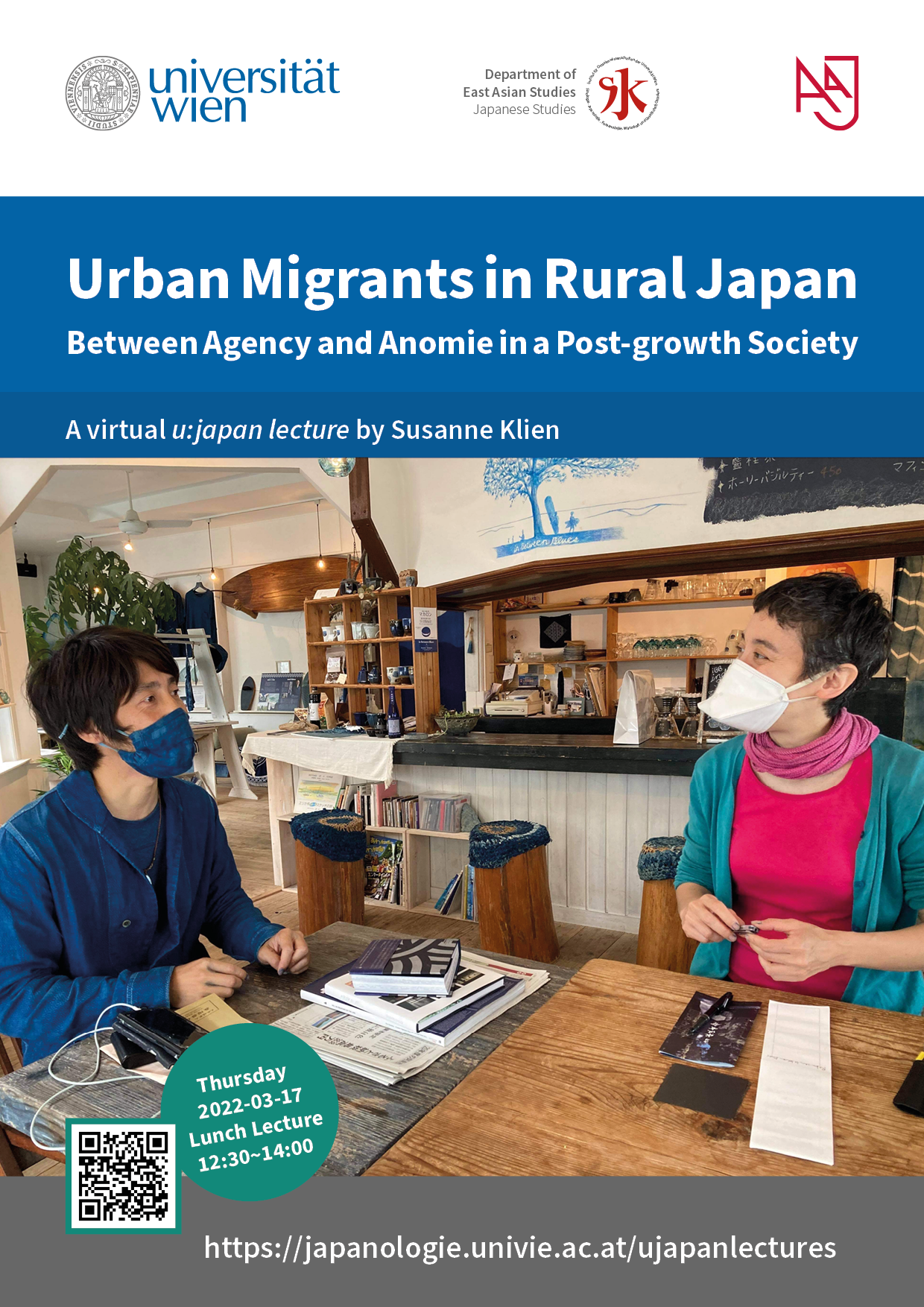 |
Season 4 | Spring 2022 | s04e02 | 17/03/2022 | en | Susanne Klien | Hokkaido University | Susanne Klien (PhD, University of Vienna) is Associate Professor at the Modern Japanese Studies Program, Hokkaido University. Her main research interests include transnational lifestyle migration, intangible cultural heritage, regional revitalization and emerging forms of tourism, demographic change and alternative forms of living and working in post-growth Japan. Her monograph Urban Migrants in Rural Japan: Between Agency and Anomie in a Post-growth Society (State University of New York Press 2020) was awarded the 2020 Choice Outstanding Academic Title. She recently co-edited a special issue on the theme of Exploring Rural Japan as Heterotopia with Paul S. Hansen in Asian Anthropology (2022). | Urban Migrants in Rural Japan: Between Agency and Anomie in a Post-growth Society | Rural areas have generally been associated with stagnation, depopulation and lack of perspectives. In my book, published by SUNY Press in 2020, I aim to radically rethink the stereotype image of countryside in Japan and beyond. Drawing on nine years of multi-sited ethnographic fieldwork across the country, I argue that the Lehman Shock in 2008, the Great East Japan Earthquake in 2011 and increasingly harsh conditions of the job market have set the path for a new role of rural areas as experimental grounds for innovative projects. I will focus on three themes that feature in the book. I will introduce selected narratives by urban newcomers to show the paradox between aspiration to a better work-life-balance and the reality of persistent overwork and (self-)exploitation. Second, I will discuss changes in the way rural Japan has recently been presented in various media. Third, I will examine entrepreneurial projects and discuss how budding entrepreneurs negotiate their daily lives between self-determination and structural constraints. Last, I will reflect on fieldwork in rural Japan during the pandemic and the insights I have obtained through follow-up interviews with my interlocutors in 2021. More details about the book: http://www.sunypress.edu/p-6846-urban-migrants-in-rural-japan.aspx | https://ustream.univie.ac.at/paella7/ui/watch.html?id=f8c6ca94-6d78-4fc8-b672-0296ec63e94a | jp | online | https://japanologie.univie.ac.at/ujapanlectures/s04/#e02 | Agriculture and Rural Studies, Sociology and Social Sciences | Has Video | ||||||||
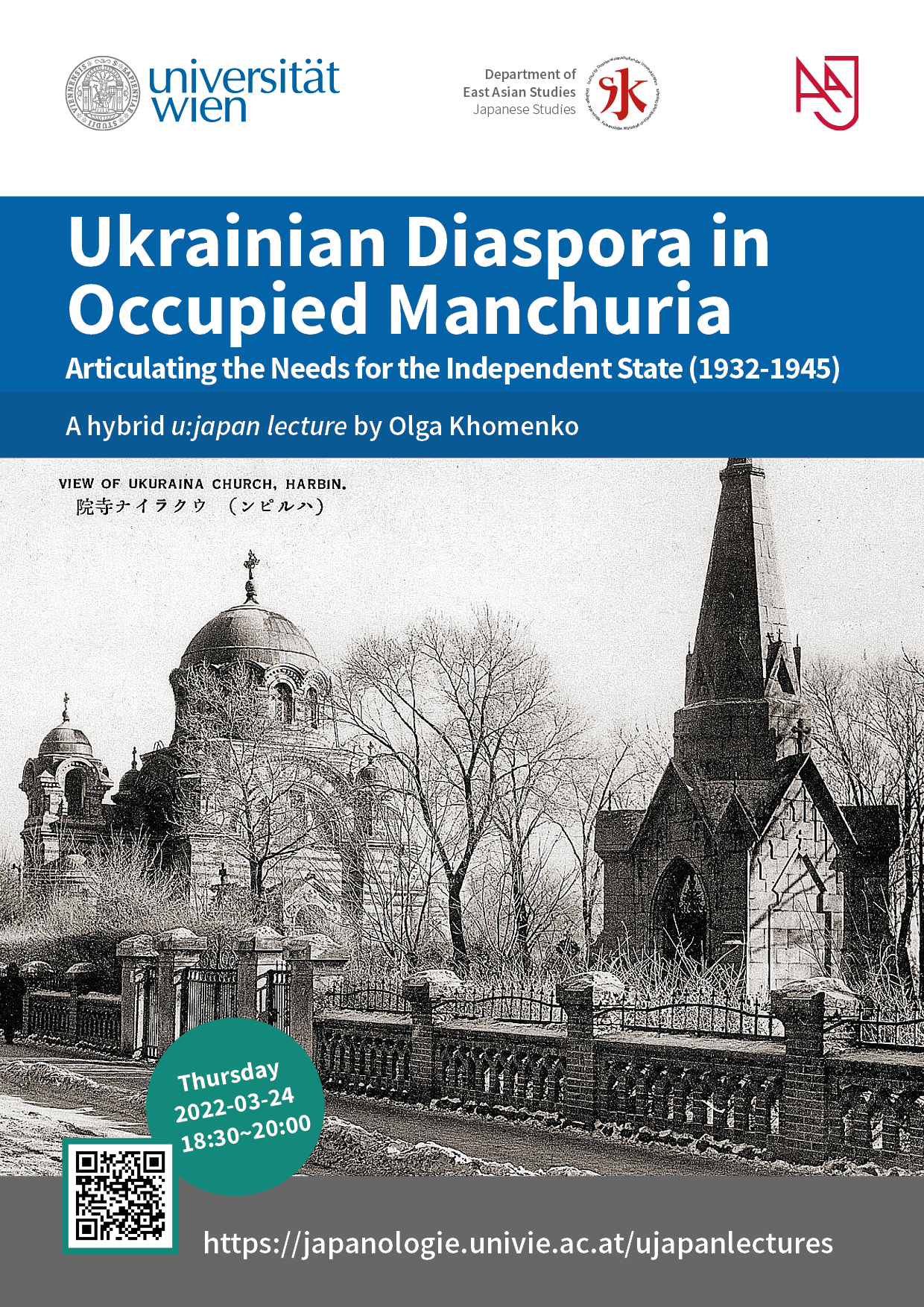 |
Season 4 | Spring 2022 | s04e03 | 24/03/2022 | en | Olga Khomenko | Kyiv Mohyla Business School (KMBS),The National University of Kyiv Mohyla Academy Ukraine | Dr. Olga Khomenko (Ольга Хоменко) is an Associate Professor and Japan Program Director at Kyiv Mohyla Business School (KMBS),The National University of Kyiv Mohyla Academy Ukraine. She holds a PhD in Area Studies, specifically on the history of Japan, from the University of Tokyo (2005), a PhD in world history from the Ukrainian Academy of Science (2013), and an MBA from the Kyiv School of Economics (2017). From 2018 to 2020, she was a Fulbright Visiting Scholar at Harvard University, USA, at the Ukrainian Research Institute and Davis Center. Her research interests include the history of postwar Japan, the history of Japanese business and consumption culture, the history of Ukraine-Japan relations, with a focus on Ukrainians in the Far East and Manchuria under Japanese occupation, as well as the history of the creation of Ukrainian national identity and Ukrainian literature. Her recent book The Far Eastern Odyssey of Ivan Svit [original Title Далекосхідна одіссея Івана Світа] was published in 2021, by Laurus in Kyiv. As well as her recent Japanese book Ukrainians who crossed the borders [original Title 国境を超えたウクライナ人] was published in February of 2022, by Gunzosha in Tokyo. | Ukrainian Diaspora in Occupied Manchuria: Articulating the Needs for the Independent State (1932-1945) | Since the abolition of serfdom in the Russian Empire and during the Chinese Railway construction and Stolypin reforms, both before and after the Russian Revolution, many Ukrainians moved to and lived in the Far East and China. For Ukrainians, who by their Cossack nature in the pursuit of freedom sought lands far from political centers and historically tended to settle in border areas, the Far East and Manchuria became safe havens from the Russian Empire where they could live and create their "little Ukraine" more freely away from the oppressive power of the capitals of Petersburg and Moscow. This talk is based on a book called "The Far Eastern Odyssey of Ivan Svit" published in Ukraine last December and telling a story of forgotten 100 000 people Ukrainian diaspora in Manchuria and its leader, Ivan Svit (1897–1989), a forgotten Ukrainian journalist, editor, historian, and social activist. They actively communicated with Japanese authorities under the occupation and advanced the processes of the self-identification of Ukrainians in the Far East and broader North-East Asia. The story of Ivan Svit is a microhistory of the life of Ukrainians in the Far East and Asia. Besides working in Russian Far East as a journalist, in China an as stamp dealer, a journalist and an editor running a couple of Ukrainian printed media publications included the "Manchurian Herald" (1932-1937) and "The Call of the Ukraine"(1941-1942) as well as radio programs, Svit helped to print a Map of Green Ukraine (1937) and to publish the first Ukrainian Japanese dictionary (1944). Thanks to the social, cultural, and political activities of enthusiasts like Ivan Svit and print media they ran, from the nationally diverse masses, they created a new social structure - the Ukrainian community, so-called imaginary Ukraine in Asia. By the end of World War II, Svit worked as a self-proclaimed Ukrainian consul and helped to evacuate large groups of Ukrainians from China. Through his work activity, Svit knew many of the participants in those historical events, which later enabled him to become a historian and write two books called "Short History of the Ukrainian Movement in the Far East/Asia (Harbin, 1938) and «Ukrainian-Japanese Relations (1903-1945). Historical Survey and Observations" (NY,1972). Active community members, such as Ivan Svit under Japanese occupation in Manchuria, did not give up and continued actively communicating with authorities, emphasizing their need for an independent Ukrainian state. Thanks to his communication skills, Svit became an important figure in the community, a cultural bridge, and a mediator between people of different political and cultural backgrounds in Northeast Asia. The story of Ivan Svit as a representative of the forgotten Ukrainian diaspora in Asia is an excellent example of Ukrainian identity creation through the printed media far away from the mainland, history of an active dialogue between West and East, and Ukrainian public and cultural diplomacy. | https://ustream.univie.ac.at/paella7/ui/watch.html?id=1888847b-4f56-4be4-8cf3-2e16ab4929ce | ua | hybrid | https://japanologie.univie.ac.at/ujapanlectures/s04/#e03 | History and Archaeology, Political Science and Law | Has Video | ||||||||
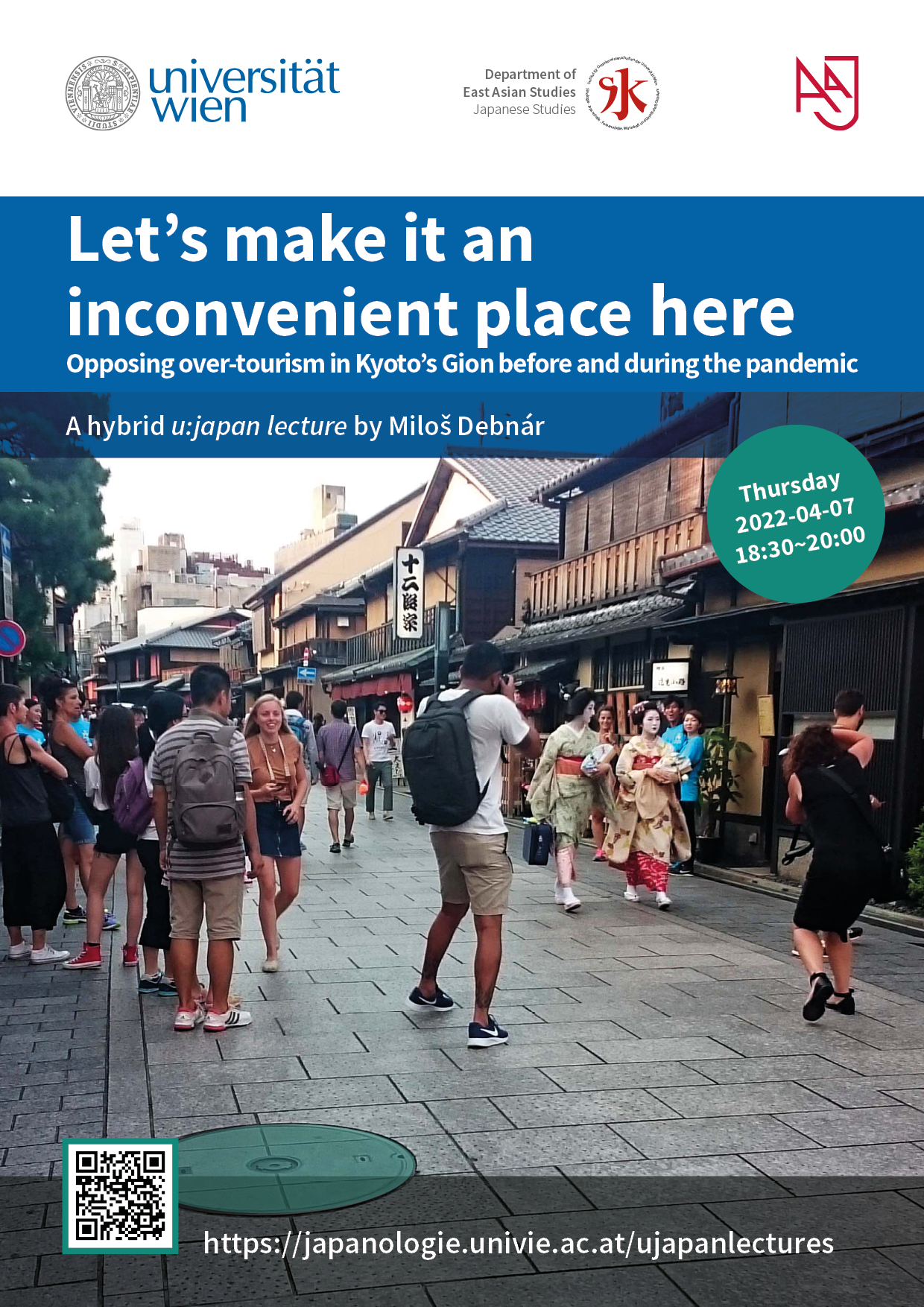 |
Season 4 | Spring 2022 | s04e05 | 07/04/2022 | en | Miloš Debnár | Ryukoku University, Kyoto | Miloš Debnár is a lecturer at the Faculty of International Studies, Ryukoku University in Kyoto. He received his Ph.D. in sociology from Kyoto University in 2014 and his main research interests are sociology of European migration to Japan and the issue of over-tourism in Kyoto. His main publications on these two topics include a monograph Migration, Whiteness, and Cosmopolitanism: Europeans in Japan (Palgrave, 2016) and Coping with the inbound tourism in Gion – resisting the touristic gaze (Intercultural Studies, 2019). | Let's make it an inconvenient place here: Opposing over-tourism in Kyoto’s Gion before and during the pandemic | Gion district in Kyoto is one of the popular symbols of the ancient capital and Japan with its preserved architecture, culture of geimaiko and tea houses. As such, the area became a highly popular destination for foreign tourists particularly in the recent years and at the same time, one of the symbols representing adverse effects of over-tourism. Despite being moderately frequented tourist destination in Kyoto for a longer period, the streets of Gion became flooded with tourists in the 2010s and issues related to the manners of the tourists, zero-dollar tourism, and the simple presence of crowds became negatively perceived by local residents and affects their business and everyday life. This presentation analyzes the main problems related to over-tourism and why and how the international tourism is perceived mainly as a problem rather than an opportunity. Despite being an entertainment district, the representatives of the South district of Gion have been actively opposing increasing tourism as well as looking for and implementing countermeasures in cooperation with the city and universities. Moreover, such activities continue even during the corona virus pandemic which brought tourism to a halt. The sudden disappearance of the tourists from the streets led to expressions of relieve, yet at the same time it continued to be a topic of discussion leading to a development of manner promotion online project as a preparation for the expected masses of tourists. Despite and because of the active resistance to over-tourism in recent years, as well as despite the physical absence of tourists during the pandemic, the (foreign) tourist and tourism became integral part of the district. | https://ustream.univie.ac.at/paella7/ui/watch.html?id=af6c86ff-bcbe-4a23-a72f-2846e15cbe6d | jp | hybrid | https://japanologie.univie.ac.at/ujapanlectures/s04/#e05 | Architecture and Urban Studies, Economics and Business Studies, Sociology and Social Sciences | Has Video | ||||||||
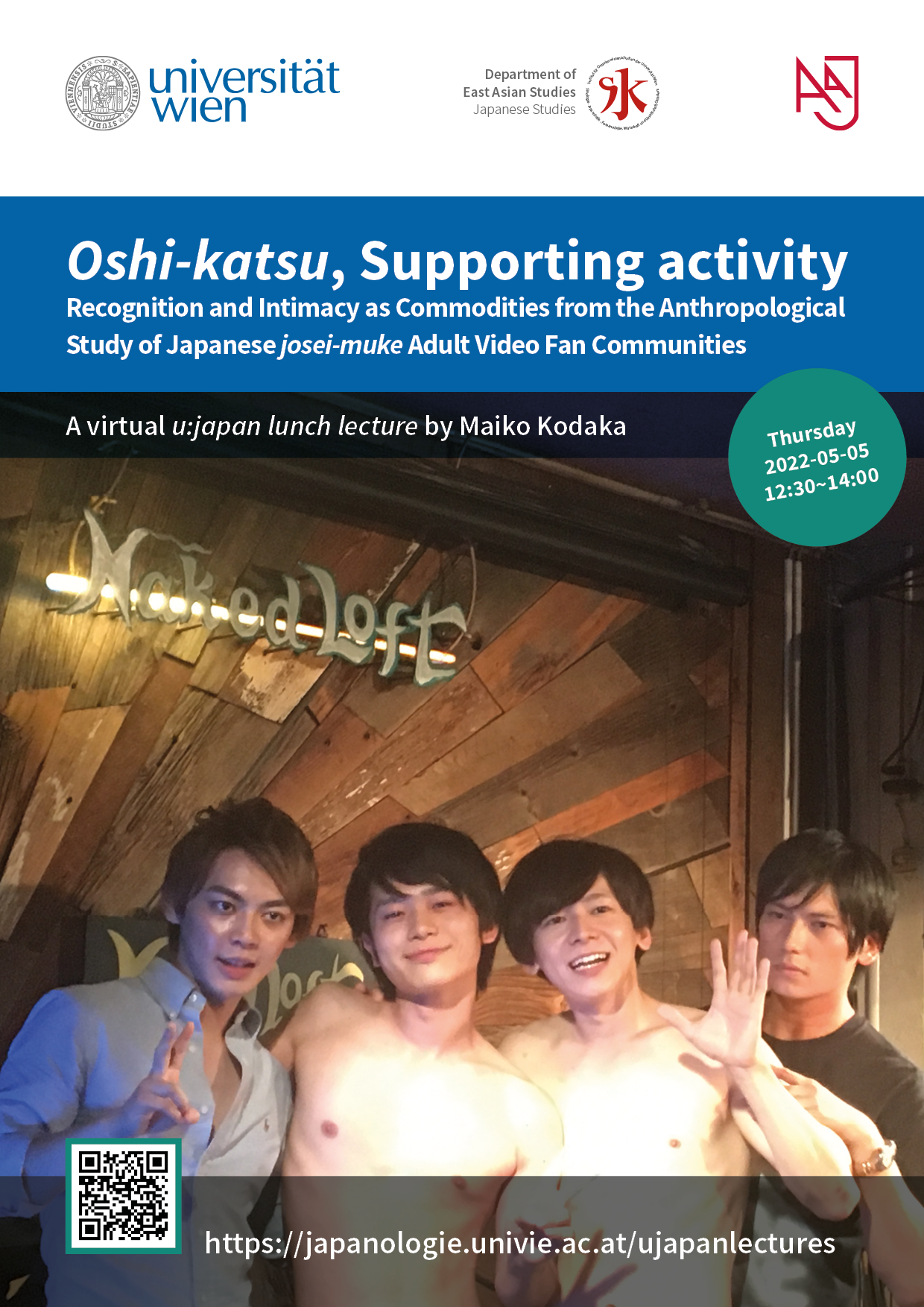 |
Season 4 | Spring 2022 | s04e07 | 05/05/2022 | en | Maiko Kodaka | SOAS, London | Maiko Kodaka is a PhD candidate in Anthropology and Sociology at the School of Oriental and African Studies, University of London. Before joining SOAS, she was awarded a BA in Art from Tokyo University of Foreign Studies in 2014. Born and raised in Tokyo, her main academic interest is gender, sexuality, and power dynamics in Japanese mass media. Her doctoral research is an anthropological study of the fan culture of pornography aimed at women in Japan, which is funded by the Sasakwa Studentship Programme and a JRC Fuwaku Scholarship. She also works as a freelance writer for Japanese web magazines. | Oshi-katsu, Supporting activity: Recognition and Intimacy as Commodities from the Anthropological Study of Japanese josei-muke Adult Video Fan Communities | Oshi-katsu 推し活 (oshi signifies an object of support while katsu is an activity), or supporting activity is a popular Japanese term to signify an act of support or to cherish on someone or something that one really likes. Oshi-katsu is often viewed positively because it provides mental welfare for those who engage (NHK news January 18th 2022); however, such activities heavily depend on the financial capacities of those who do the supporting. My research exploratory looks at female fans of male porn actors in josei-muke Adult Videos (AV) in Japan, as a form of oshi-katsu in order to explore its gendered dynamics. The genre of josei-muke is a form of pornography aimed at heterosexual women that features good-looking male porn actors called Eromen and Lovemen. This new genre has emerged in reaction to the decline of mainstream porn studios due to the popularity of porn streaming websites and captures heterosexual women who had been neglected as audiences as a new market. Despite the media attention that the new genre has garnered as a female sexual emancipation, the phenomenon is supported by “fans” of Eromen and Lovemen. Based on fieldwork at a series of Eromen and Lovemen fan events and interviews with those self-identified fans, it has become apparent that female fans look for intimate interactions with male actors at these events in order to be recognized as feminine and have their confidence restored. Axel Honneth’s theory of recognition (1995) argues that recognition has to be mutual in order to work socially; however, in this case, the monetary transaction changes the intentions of each actor (female fans / Eromen and Lovemen). For Eromen and Lovemen, it is about money and fame. On the other hand, female fans gain recognition even though they have to pay for it. The research draws on conversations with female fans to elucidate the expectations fans have regarding their interactions with Eromen and Lovemen, and how this fan community influences their everyday lives. | https://ustream.univie.ac.at/paella7/ui/watch.html?id=c0972303-b1be-4ca1-a290-ef284444ce25 | uk | online | https://japanologie.univie.ac.at/ujapanlectures/s04/#e07 | Anthropology and Ethnography, Gender Studies and Minority Studies | Has Video | ||||||||
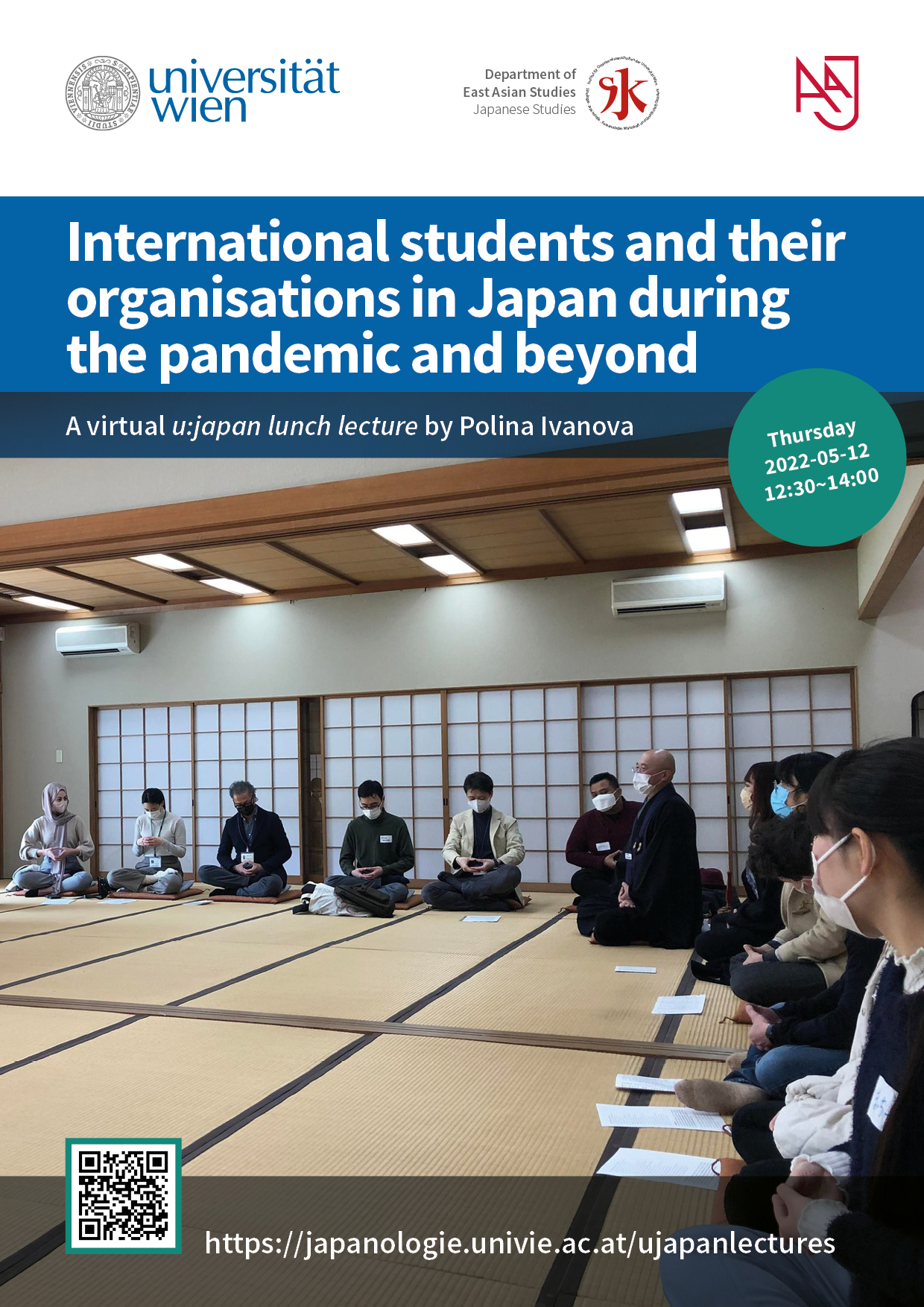 |
Season 4 | Spring 2022 | s04e08 | 12/05/2022 | en | Polina Ivanova | Ritsumeikan University, Kyoto | Polina Ivanova is a visiting researcher at Ritsumeikan University and a lecturer at Kyoto University of Foreign Studies. She holds a Ph.D. in International Relations from Ritsumeikan University. Her research interests lie in the areas of civil society, migration, and international education. Her doctoral research examined thirty civil society organisations supporting international students in the Kansai area of Japan and their contribution to creation of social capital in local communities. In addition, she participated in three collaborative projects in Japan, Australia, and the United States. Based on this work, Polina published five peer-reviewed articles and presented her findings at academic conferences, workshops and lecture series in the United Kingdom, Germany, Mexico, the United States, and Japan. Her recent projects focus on international students’ loneliness and social engagement in the United States and Japan, and civil society response to the pandemic in Japan, Australia, and the United States in the context of international student support. | International students and their organisations in Japan during the pandemic and beyond | This research examines the impact of changing times of the COVID-19 pandemic on international students enrolled at Japanese universities and on their support organisations. The crisis has significantly affected studies, health, social life, finances and career plans, both of those students staying inside the country and those stranded overseas and unable to enter their study destination. This study views international student mobility through the lens of human security and sees students as transnational agents instead of passive service recipients or guests in a conventional “guest-host” paradigm. The study increasingly relies upon digital methods of data collection: online interviews and observation of online events for international students organised by Japanese universities and alternative support providers, such as nonprofits, peer support groups, university clubs and informal hobby groups. Forced by the pandemic, international student support organisations (ISSOs) had to adapt to the “new normal”; however, elderly volunteers often failed to catch up with time and technology changes. In the absence of adequate support, especially during the first year of the pandemic, international students proactively searched for solutions and solidarity outside their universities and pre-pandemic support providers. As a result, transnational political activism emerged as an outcome of modern times, technologies and challenges of the pandemic. The study also follows more recent developments after the vaccine rollout, the spread of the Omicron wave and highlights fluidity of the immigration status of international students sometimes leading to their precarity. | https://ustream.univie.ac.at/paella7/ui/watch.html?id=9e9ef9af-cff9-4126-ab8b-8fd6ca10e74f | jp | online | https://japanologie.univie.ac.at/ujapanlectures/s04/#e08 | Sociology and Social Sciences, Anthropology and Ethnography | Has Video | ||||||||
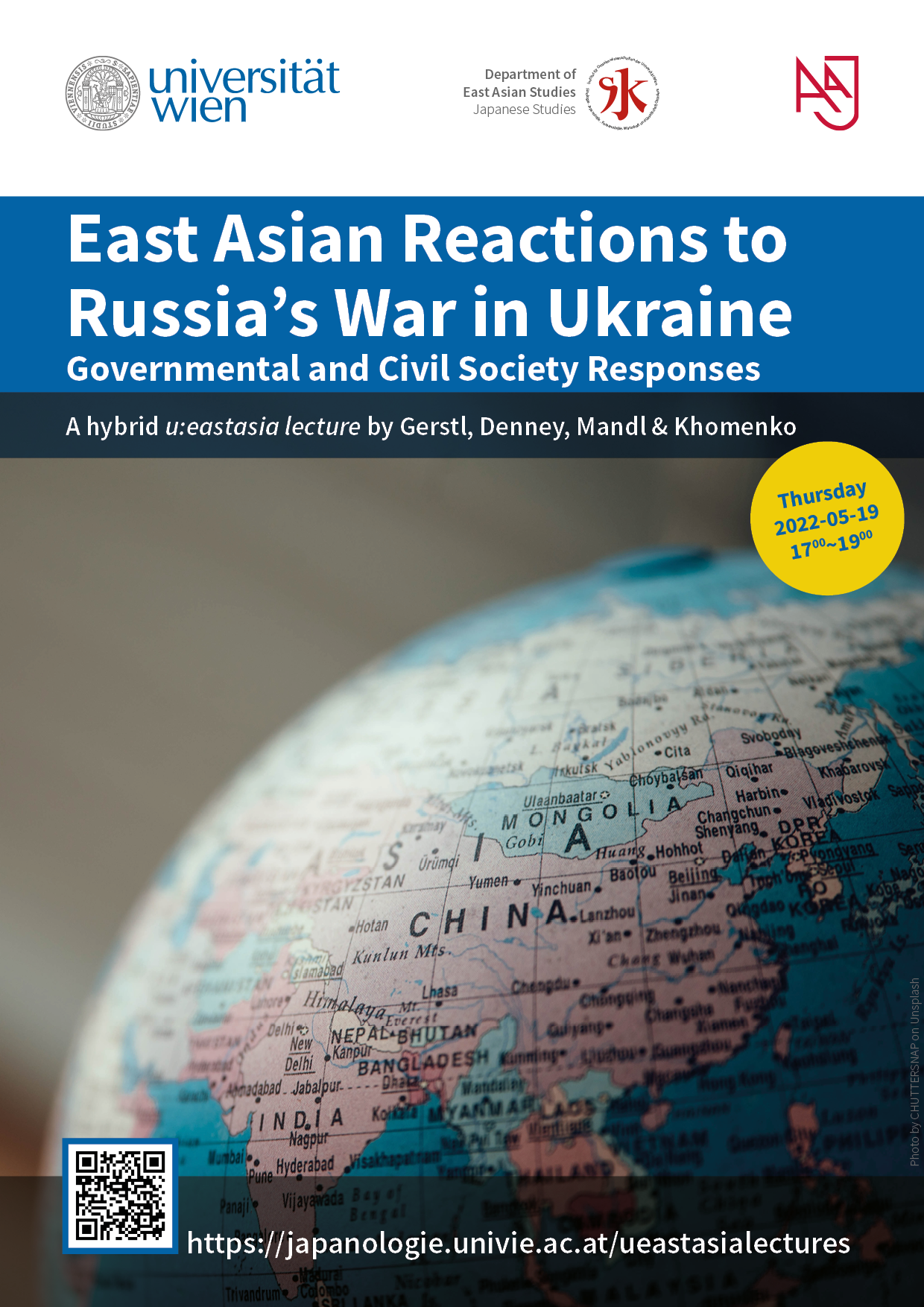 |
Season 4 | Spring 2022 | s04e09 | 19/05/2022 | de | Alfred Gerstl et al. | Universität Wien | Alfred Gerstl is Associate Professor at the Department of Asian Studies at Palacký University Olomouc (Czech Republic) and President of the Central European Institute of Asian Studies (CEIAS), a transnational think tank (Bratislava, Olomouc and Vienna). In addition, he is sessional lecturer at East Asian Economy and Society (EcoS) and University of Continuing Education Krems. He is a specialist in International Relations, notably on Southeast Asia and the Indo-Pacific region. His recent research focuses on the economic and strategic impacts of China’s Belt and Road Initiative on Southeast Asia and the South China Sea dispute. Dr. Olga Khomenko is an Associate Professor and Japan Program Director at Kyiv Mohyla Business School (KMBS),The National University of Kyiv Mohyla Academy Ukraine. She holds a PhD in Area Studies, specifically on the history of Japan,from the University of Tokyo (2005), a PhD in world history from the Ukrainian Academy of Science (2013), and an MBA from the Kyiv School of Economics (2017). From 2018 to 2020, she was a Fulbright Visiting Scholar at Harvard University, USA, at the Ukrainian Research Institute and Davis Center. Her research interests include the history of postwar Japan, consumption culture, Ukraine-Japan relations. Dr. Steven Denney is a lecturer of East Asian Economy and Society in the Department of East Asia Studies at the University of Vienna. He is a comparativist that specializes in East Asian affairs with a focus on the Koreas. His core research interests lie at the intersection of migration, citizenship, and entrepreneurship studies. He also reads and contributes to studies in democracy and authoritarianism. Steven holds a Ph.D. in Political Science from the University of Toronto, an M.A. in Global Affairs and Policy from Yonsei University, and a B.A. in Political Science from Harding University. Martin Mandl is a Junior Researcher at CEIAS and an Editorial Member of “ASIEN – The German Journal of Contemporary Asia”. He teaches on the political systems and international relations of East Asia and offers intercultural training on the region. As a passionate cook and former hospitality manager, Martin’s research is focused on the use of food in Taiwan’s public diplomacy. Agnes S. Schick-Chen is Associate Professor of Chinese Studies and Vice-Director of Studies at the Department of East Asian Studies, University of Vienna. Her main fields of research and teaching are the developments of legal and political culture in the PRC, Taiwan and Hong Kong. She has published books and papers on related topics, e.g. the discourse on Chinese legal culture and processes of coming to terms with the past in China and Taiwan. | East Asian Reactions to Russia's War in Ukraine: Governmental and Civil Society Responses | While the European Union and its member states strongly condemn Russia’s invasion of Ukraine on 24 February and have since provided humanitarian or even military support to Ukraine, the responses of the governments in Northeast and Southeast Asia are less unified. Japan, Singapore, South Korea and Taiwan joined the Western countries in sanctioning Russia, clearly emphasizing Russia’s responsibility for launching the war. Japanese Prime Minister Fumio Kishida drew a parallel to China’s perceived assertiveness in the South and East China Sea. Taiwanese President Tsai Ing-wen emphasized the unity of the Ukrainian citizens “to fight against the invasion by a powerful country”. Other nations, including Indonesia and Vietnam, but also the Association of Southeast Asian Nations (ASEAN), do neither make comparison to China’s policies nor openly criticize Russia. Rather, they demand to end the war, find a peaceful resolution and refer to rather abstract principles of international law. This panel discussion will analyze the various strategic, economic and domestic motives of the governments to either unequivocally condemn Russia or to avoid naming and shaming Moscow. Moreover, the panelists will also (discuss the) point to different reactions of civil societies in East Asia which are not necessarily in line with the positions taken by the respective national governments. The spectrum is (also very) quite broad (and not necessarily in line with the positions taken by the respective national governments), ranging from strong support for Ukraine to some sympathies for “strongman” Vladimir Putin allegedly fighting against a US-dominated international order. By bringing together the perspectives of the national governments and the civil societies, this panel aims to initiate a multi-facetted (and comprehensive) discussion of East Asian reactions to Russia’s war against Ukraine. | https://ustream.univie.ac.at/paella7/ui/watch.html?id=7218feaf-3edc-47d9-8469-bdb7806892e8 | at | hybrid | https://japanologie.univie.ac.at/ujapanlectures/s04/#e09 | Political Science and Law, Sociology and Social Sciences | Has Video | ||||||||
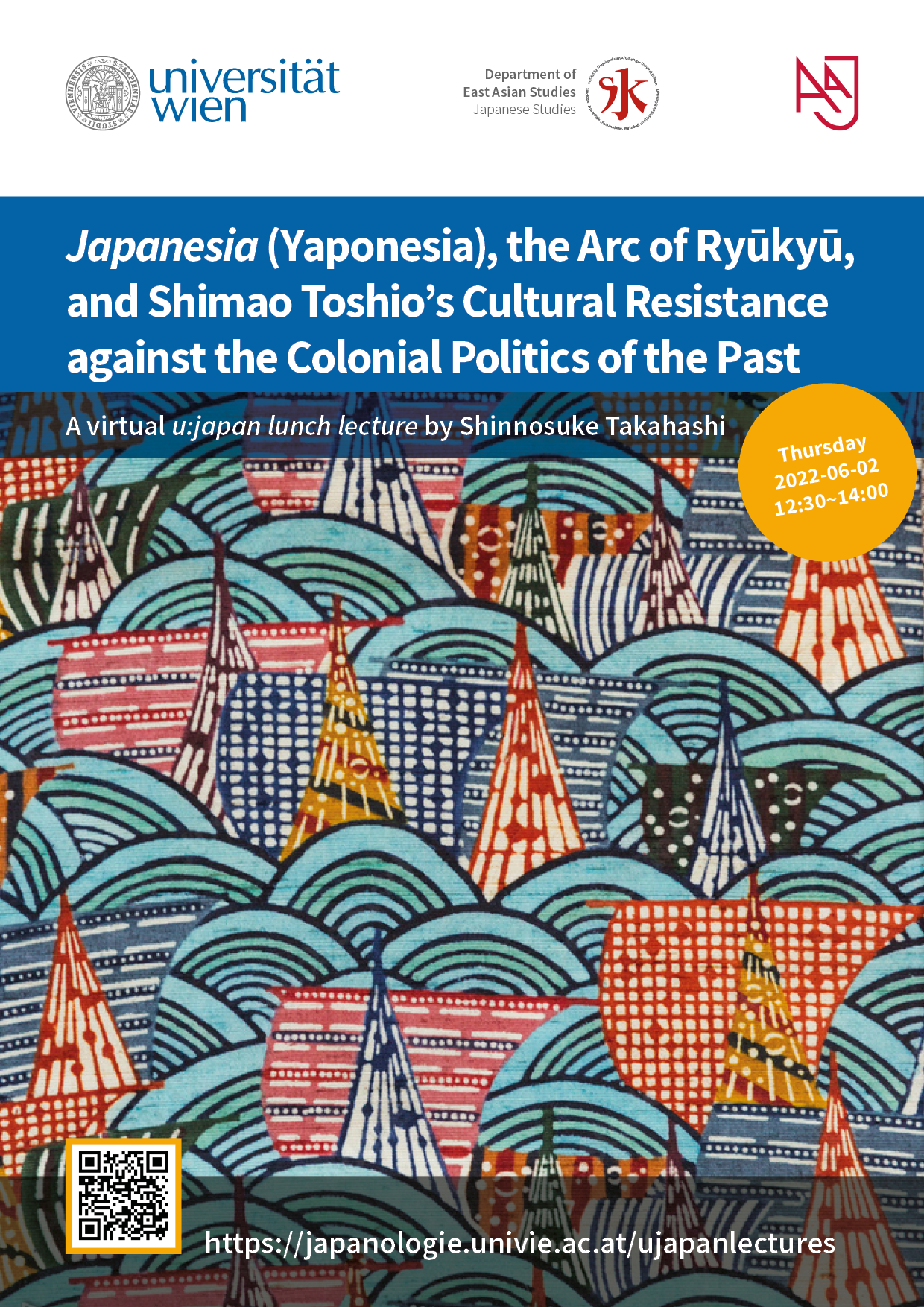 |
Season 4 | Spring 2022 | s04e10 | 02/06/2022 | en | Takahashi Shinnosuke | Te Herenga Waka — Victoria University of Wellington | Shinnosuke Takahashi is a lecturer in Asian Languages and Cultural Programme at Victoria University of Wellington in New Zealand. Prior to his appointment at Victoria University, he taught at Kumamoto University, Kobe University, and the Australian National University where he obtained his doctoral degree. His publications include Transnational Japan as History: Empire, Migrants, and Social Movements (Palgrave Macmillan, 2015); and Transpacific Visions: Connected Histories Across North and South (Lexington, 2021). He is currently writing up his first monograph, The Translocal Islands: The Okinawan Struggle and Grassroots Regionalism. | Japanesia, the Ryūkyū Arc, and Shimao Toshio’s Cultural Resistance Against the Colonial Politics of the Past | Shimao Toshio (1917-1986) is probably one of the most celebrated authors in the history of post-war Japanese literature. Shimao’s literary works were highly praised by his contemporaries, for example the literary critic Okuno Takeo, who called Shimao a ‘master’ of surrealist literature. Yet, Shimao’s works have also been seen as controversial, especially those related to his concept of Japanesia. First appearing in 1961, Japanesia is Shimao’s representative concept for revisiting the meaning of Japanese nationhood in the course of its historical development, not from the perspective of the centres of power, but from marginalised regions such as the southern islands and north-eastern region. The concept of Japanesia also questions Japan’s elite cultural orientations which he argues have been centred around the continental worlds, i.e., Asia and the West. In contrast, Shimao insists on the significance of the Pacific Ocean and island communities as a forgotten bedrock of Japan’s cultural life both in the past and present. While this concept is often seen as Shimao’s critical intervention in the discourses about Japan’s cultural homogeneity through his foregrounding of its deep geo-cultural diversity, some critics have disapproved, warning us of Shimao’s uncritical stance towards Japan’s colonial legacies in the Pacific. One of the key issues that have rarely been addressed in this regard is the historical context in which Shimao conceived his concept. Therefore, this presentation probes Shimao’s cultural politics in light of his community activities and trans-oceanic journeys as well as the content of his texts, especially during his first decade living in Amami-Ōshima. Historical analysis of Japanesia will allow us to have a clearer understanding of the criticality and the limit of the concept, which, I argue, is still of some great value to reflect upon today. | https://ustream.univie.ac.at/paella7/ui/watch.html?id=550860c4-58db-444b-83de-3aa4722739dc | nz | online | https://japanologie.univie.ac.at/ujapanlectures/s04/#e10 | Literature and Media Studies, History and Archaeology | Has Video | ||||||||
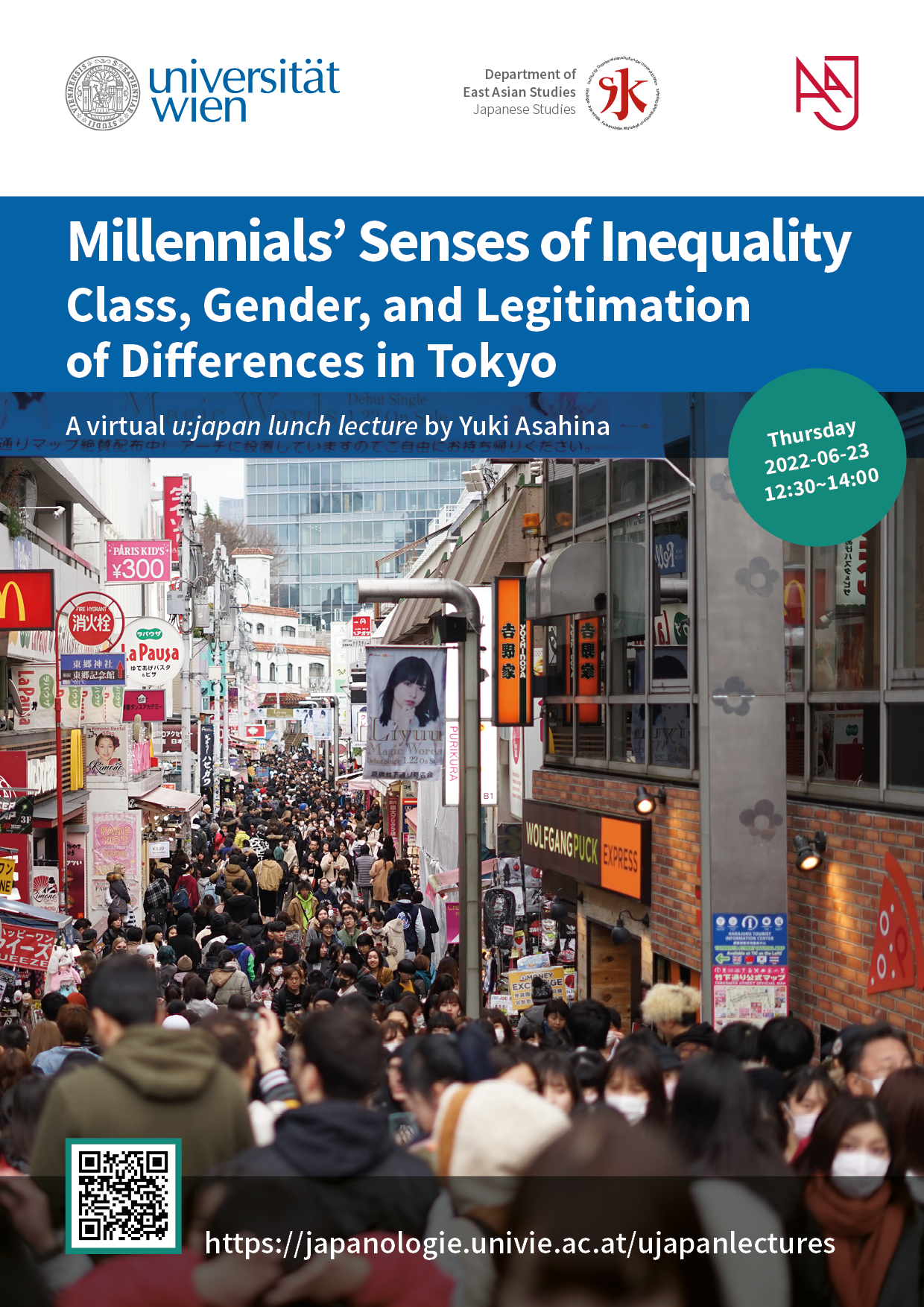 |
Season 4 | Spring 2022 | s04e12 | 23/06/2022 | en | Yuki Asahina | Hankuk University of Foreign Studies, Seoul | Yuki Asahina is Assistant Professor in the Graduate School of International and Area Studies at Hankuk University of Foreign Studies in Seoul, South Korea, where he teaches about Japanese society, inequality, and qualitative research methods. He received his PhD in sociology from the University of Hawai‘i at Mānoa and was previously a postdoctoral fellow at the Reischauer Institute of Japanese Studies and an affiliate of the Weatherhead Research Cluster on Comparative Inequality and Inclusion at Harvard University. His research has appeared or is forthcoming in Sociology, Politics&Society, Journal of Contemporary Asia, and Contemporary Japan, among other journals. | Millennials’ Senses of Inequality: Class, Gender, and Legitimation of Differences in Tokyo | Today's young adults face a labor market where precarity is the norm rather than the exception. They also confront the widening crevasse between the rich and the rest and persistent gender disparities. Scholars argue that this generation's shared experience of hardship shaped acute sensitivity to injustice, making them a 'new political generation.' In Japan, however, despite two decades of economic stagnation and a widening gap between the haves and have-nots, various surveys report that young citizens are surprisingly content with their situation; a sociologist called them 'the happy youth of a desperate country.' This talk examines how Japanese young adults experience inequality as something 'natural' with a particular focus on their experience of work. Drawing on longitudinal interview data and through a lens of comparison with the case of Seoul, South Korea, where young citizens maintain a strong sense of injustice, I show the persistent tendency among Japanese millennials to interpret inequality as a matter of individual efforts and talents. Then, I will examine differences in the ideas that various groups of young adults use to justify the inequalities they observe. Finally, I will ask when and how inequality and insecurity are experienced as 'unjust' to the extent that young adults can no longer tolerate them by focusing on the experience of precariously employed young men and women. | https://ustream.univie.ac.at/paella7/ui/watch.html?id=fc8446fd-69b9-456e-ba66-b21ea04d95de | kr | online | https://japanologie.univie.ac.at/ujapanlectures/s04/#e12 | Sociology and Social Sciences, Gender Studies and Minority Studies | Has Video | ||||||||
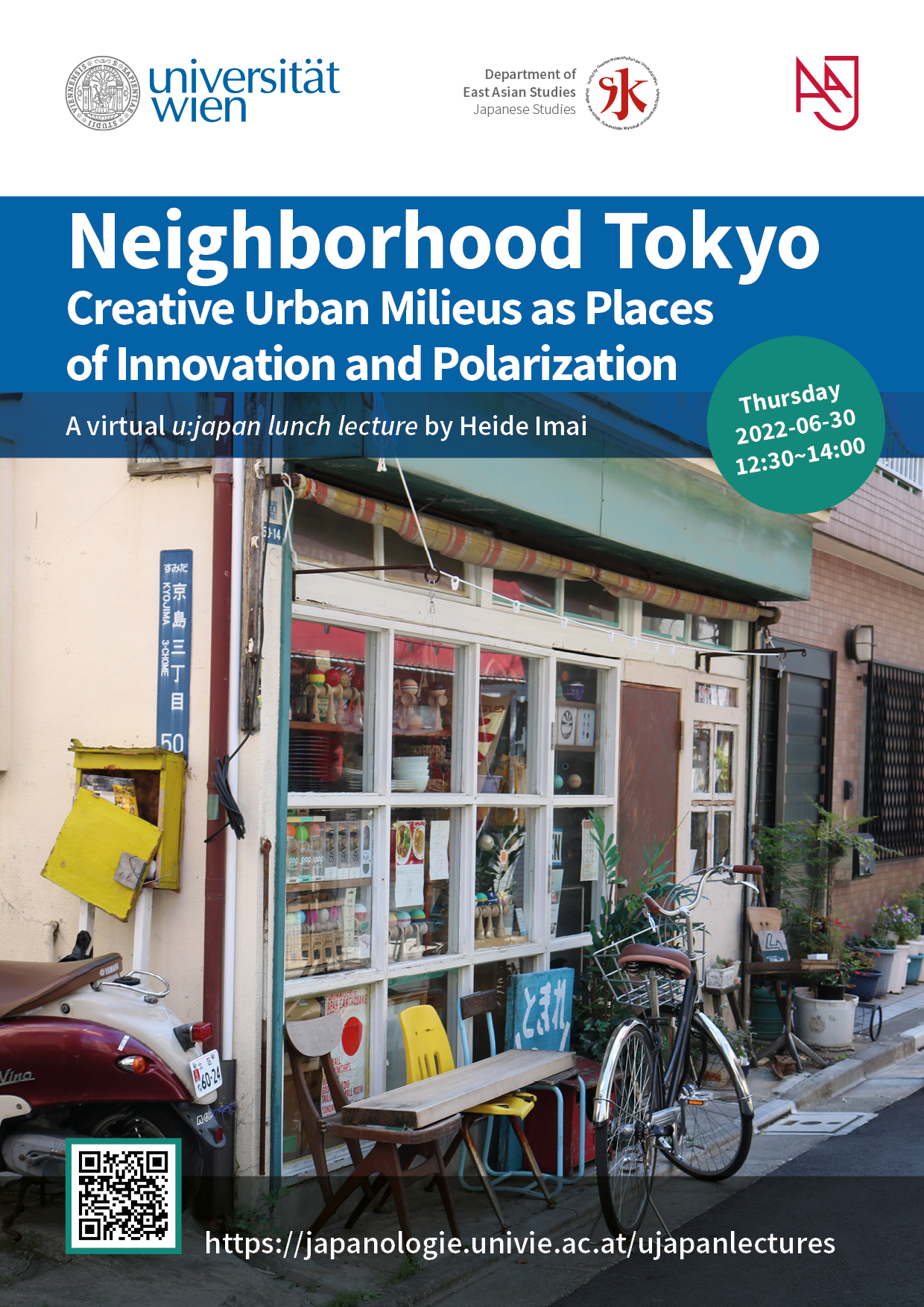 |
Season 4 | Spring 2022 | s04e13 | 30/06/2022 | en | Heide Imai | Senshu University | Dr. Heide Imai, Architect and since 2020 Associate Professor at Senshu University, Faculty of Intercultural Communication, and Research Associate at Keio University, studied architecture, cultural studies and urban sociology in Leipzig, Rotterdam, Oxford and Manchester. Author of Tokyo Roji: The Diversity and Versatility of Alleyways in a City in Transition (Routledge, 2017), Asian Alleyways: An Urban Vernacular in Times of Globalization (with M. Gibert-Flutre, Amsterdam University Press, 2020), Creativity in Tokyo : Revitalizing a Mature City (with M. Ursic, Palgrave Macmillan, 2020). She is primarily concerned with urban places, through which we can understand urban development processes between revitalization and decay, creativity and sustainability. A new publication on the subject entitled Everyday Yokohama – Neighborhoods between Decline and Revival will be published by Palgrave Macmillan in 2022. | Neighborhood Tokyo: Creative Urban Milieus as Places of Innovation and Polarization | Against the background of the new attractiveness of urban centers, creative people are gaining more and more importance as potential initiators for various urban development processes. On the one hand, the activation and participation of these creative people is important in order to integrate innovative potential into various development processes, on the other hand, creative people are showing increasing interest in the development of their city and are demanding their participation. In Tokyo, creatives represent a relatively hidden but important part of the larger creative ecosystem, made up of many different influential stakeholders (e.g. state, city authorities, big companies and foreign investors), all of which actively contribute to its functioning. As such, creative actors occupy a unique meta-position between the two worlds of creativity, as they are both part of everyday neighborhood life and part of the larger economic system in which they (want) to thrive. Therefore, they also can also be described as 'facilitators', bridging the two dimensions of Tokyo's creative ecosystem, as their hybrid, bi-directional role enables the important exchange between systematic/economic and neighborhood creativity. This lecture aims to illuminate and better understand the role of existing creative urban milieus in the urban development of Tokyo. Various neighborhoods of Tokyo are introduced and 'walked through' (Bakurochō, Hikifune, Kyōjima, Ichigaya, Kiyosumi Shirakawa, Kōenji, Kuramae) to capture how milieu-bound creativity as a collective network resource has and is affecting Tokyo's urban development, especially during and after the Covid -19 Pandemic. | https://ustream.univie.ac.at/paella7/ui/watch.html?id=28a4d62d-b2b1-4540-b492-d72be63b45e8 | jp | online | https://japanologie.univie.ac.at/ujapanlectures/s04/#e13 | Architecture and Urban Studies, Economics and Business Studies | Has Video | ||||||||
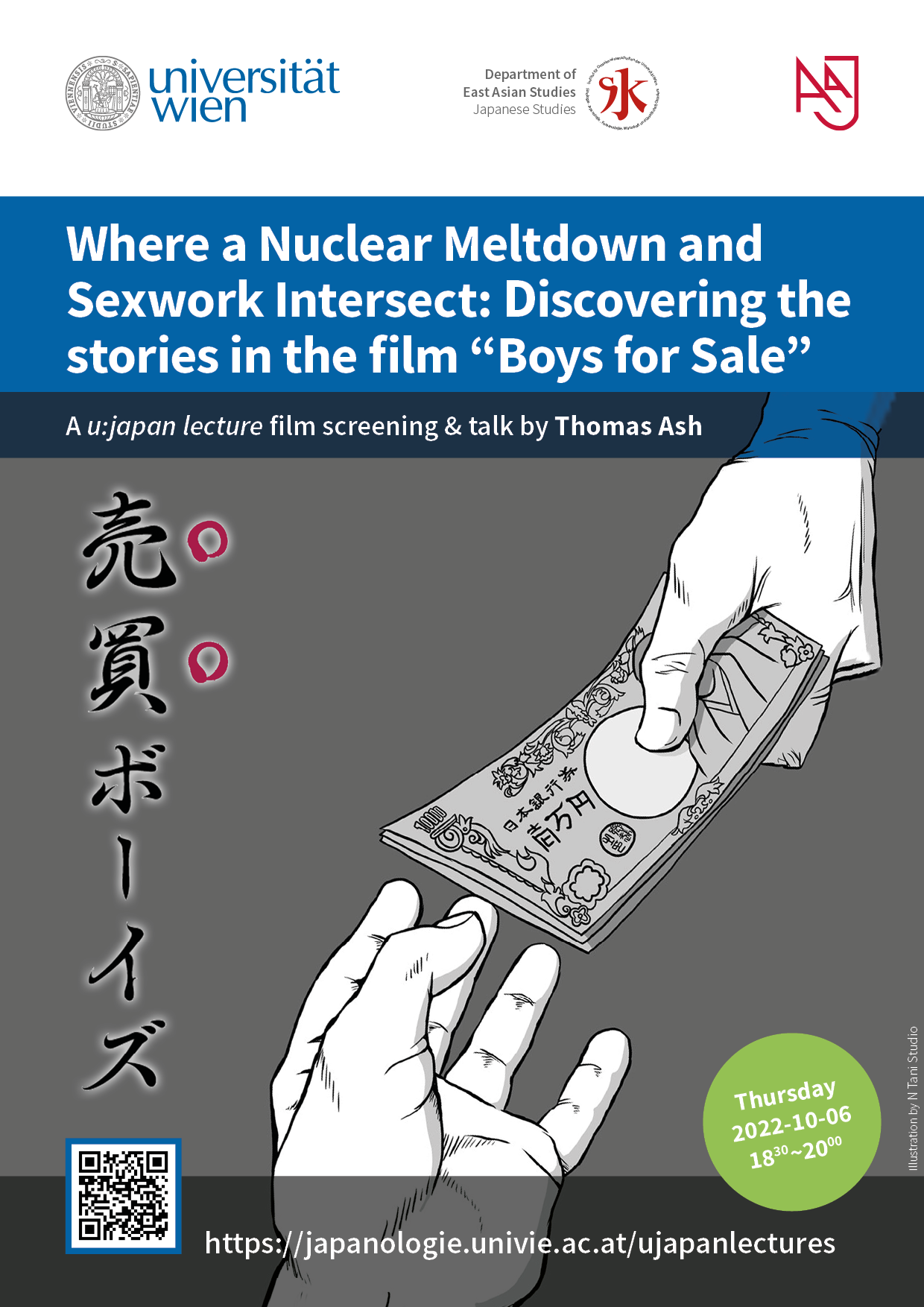 |
Season 5 | Autumn-Winter 2022/23 | s05e01 | 06/10/2022 | en | Thomas Ash | Filmmaker, Japan | Thomas Ash, born in America, earned an MA in Film and Television Production at the University of Bristol, UK (2005) and has lived in Japan for over 20 years. His first feature documentary was ‘the ballad of vicki and jake’ (2006), followed by two feature documentaries about children living in areas of Fukushima contaminated by the 2011 nuclear meltdown, ‘In the Grey Zone‘ (2012) and ‘A2-B-C‘ (2013), and one that dealt with themes surrounding health and medicine in Japan, ‘-1287‘ (2014). “Boys for Sale” (2017, dir. Itako), about male sex workers in Tokyo on which Thomas served as Executive Producer, screened in 40 film festivals across the world, receiving six awards for Best Feature Documentary. In 2019, Thomas released two films: “Sending Off” and “The Father’s Love Begotten”. Thomas’s newest documentary “Ushiku” (2021), is about asylum seekers to Japan who are detained at the infamous Ushiku immigration centre (More information on Thomas Ash’s website: www.documentingian.com/). | Where a Nuclear Meltdown and Sexwork Intersect: Discovering the stories in the film “Boys for Sale” | 売買ボーイズ | BOYS FOR SALE Boys are selling sex in Japan. Who is buying? In the Tokyo district of Shinjuku 2-chome there are bars that specialize in “Urisen”, young guys who have sex with men. Featuring candid interviews and interspersed with animation detailing the awkward, sweet, and sometimes horrific situations these young sex workers experience, the boys for sale boldly tell their stories of life in the Tokyo underground. This documentary is an illuminating look into a rarely seen world that tantalizingly shows the humanity of sex work. On topics as varied as the health of children following the Fukushima nuclear disaster („In the Grey Zone“, 2012 and „A2-B-C“, 2013), death and dying („-1287“, 2014 and „Sending Off“, 2019) and the treatment of asylum-seekers in immigration detention („Ushiku“, 2021), the films of Thomas Ash broadly deal with themes of health, medicine and human rights. While many of his films share the same quiet and observational style, „Boys for Sale“ (2017) is an outlier in terms of the production visuals and soundtrack, yet Thomas‘s influence is strongly felt, particularly in the depth and flow of the interviews with his subjects. In his speech,Thomas will speak about his conscious effort to prevent „Boys for a Sale“ from becoming sensational and exploitative and how his desire to quietly listen led to discoveries mid-interview which would echo back to his earlier work in Fukushima in a way in which he never could have predicted. | jp, uk | on site | https://japanologie.univie.ac.at/ujapanlectures/s05/#e01 | Gender Studies and Minority Studies, Arts (visual arts and performing arts) and Art History, Anthropology and Ethnography | ||||||||||
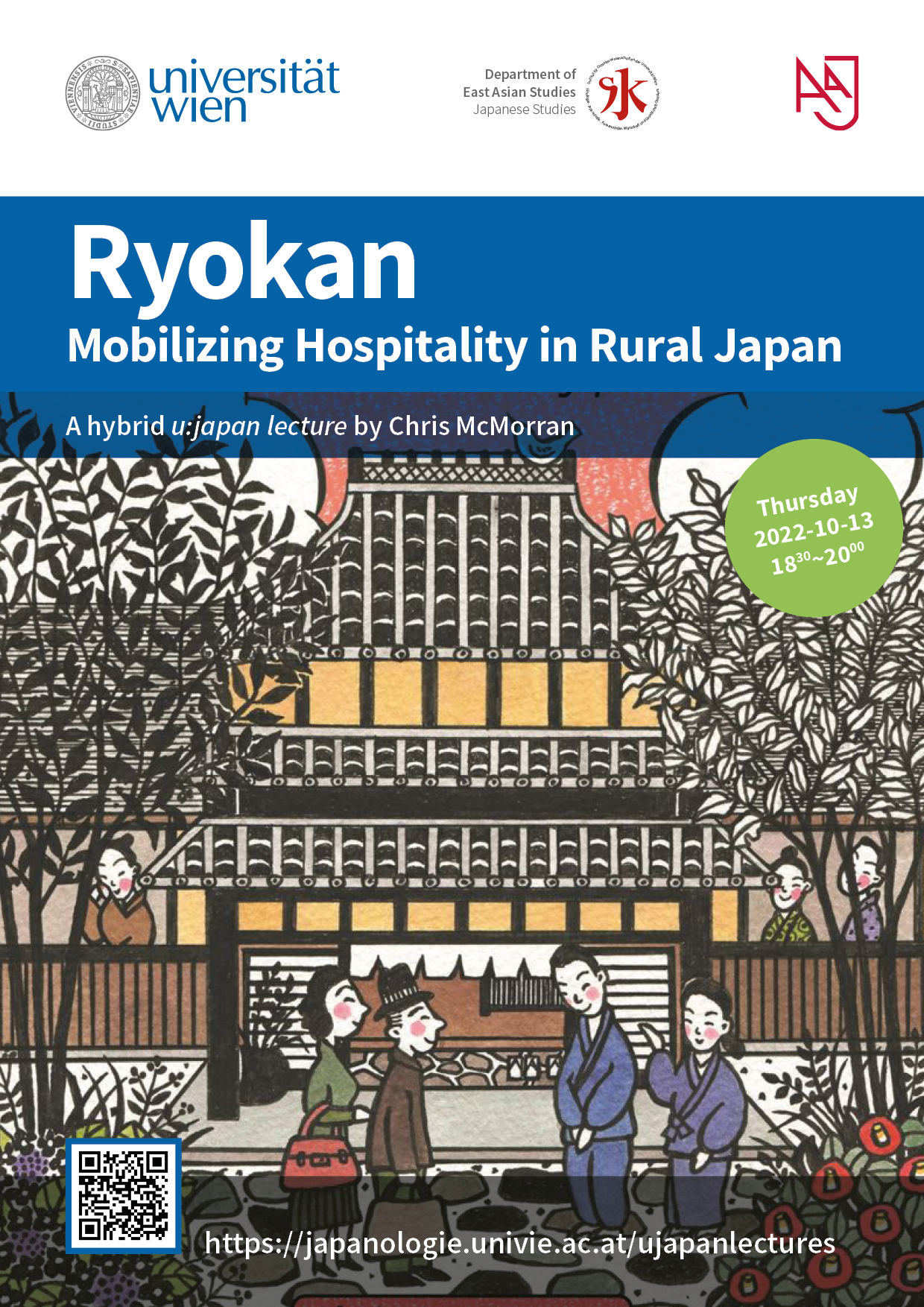 |
Season 5 | Autumn-Winter 2022/23 | s05e02 | 13/10/2022 | en | Chris McMorran | Singapur National University | Chris McMorran is Associate Professor of Japanese Studies at the National University of Singapore. He is a cultural geographer of contemporary Japan focusing on the geographies of home across scale, from the body to the nation. He is the author of Ryokan: Mobilizing Hospitality in Rural Japan (University of Hawai’i Press), an ethnography of a Japanese inn, based on twelve months spent scrubbing baths, washing dishes, and making guests feel at home at a hot springs resort. He also has published research on tourism, disasters, gendered labor, area studies, field-based learning, and the evolution of grading. He co-produces the Home on the Dot podcast with NUS students, which explores the meaning of home on the little red dot called Singapore. Chris grew up in a small town in Iowa but has lived outside the U.S. for much of his adult life, including Japan and Singapore, which he calls home. | Ryokan: Mobilizing Hospitality in Rural Japan | Amid the decline of many rural communities in Japan, the hot springs village resort of Kurokawa Onsen is a rare, bright spot. Its two dozen traditional inns, or ryokan, draw hundreds of thousands of tourists a year eager to admire its landscape, experience its hospitality, and soak in its hot springs. As a result, these ryokan have enticed village youth to return home to take over successful family businesses and revive the community. What does it take to produce this family business and one of Japan’s most relaxing spaces? In this talk, I share the behind-the-scenes work that keeps a ryokan running smoothly, from the everyday tasks of cleaning, serving, and making guests feel at home, to the generational work of producing and training a suitable heir who can carry on the family business. I draw on nearly two decades of research in and around Kurokawa, including a year spent welcoming guests, carrying luggage, scrubbing baths, cleaning rooms, washing dishes, and talking with co-workers and owners about their jobs, relationships, concerns, and aspirations. I discuss how Kurokawa’s ryokan mobilize hospitality to create a rural escape in contemporary Japan, emphasizing the strictly gendered work found in the ryokan, as well as the generational work of ryokan owners vs. the daily embodied work of their employees. I share the realities of ryokan work—celebrated, messy, ignored, exploitative, and liberating—and introduce the people who keep inns running by making guests feel at home. | https://ustream.univie.ac.at/paella7/ui/watch.html?id=95a98e1e-7581-4ef3-b304-99e1f68b2a40 | sg | hybrid | https://japanologie.univie.ac.at/ujapanlectures/s05/#e02 | Anthropology and Ethnography, Agriculture and Rural Studies | Has Video | ||||||||
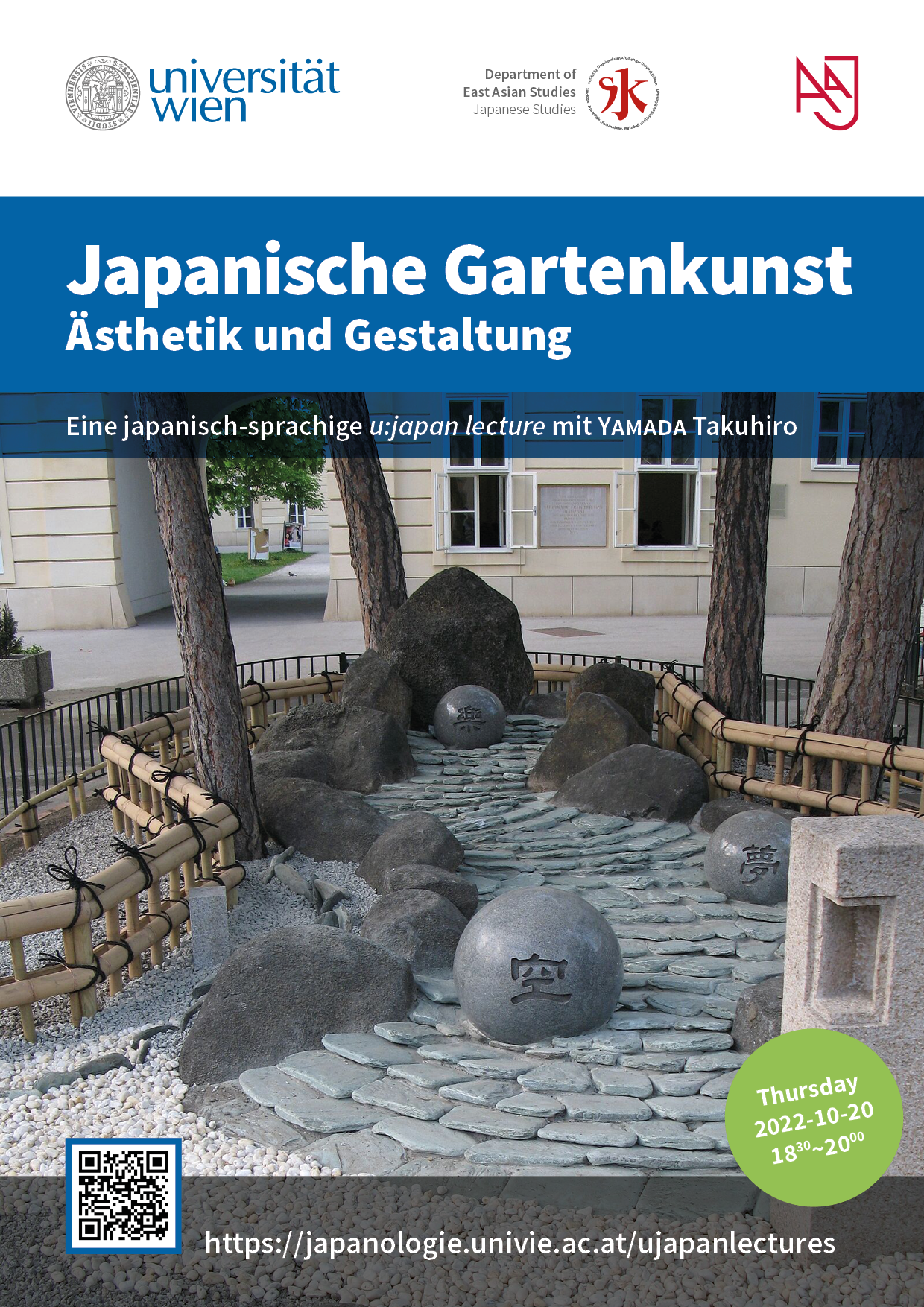 |
Season 5 | Autumn-Winter 2022/23 | s05e03 | 20/10/2022 | jp | Takuhiro Yamada | Gartenbaumeister, Japan | Yamada Takuhiro (Gartenbaumeister): Der ausgewiesene und international erfahrene Gartenbaumeister stammt aus einer Familie, die seit Generationen in der Gartenkunst tätig ist. Anlass seines Besuches in Wien ist die Restaurierung des japanischen Steingartens am Campus der Universität Wien. | Japanische Gartenkunst: Ästhetik und Gestaltung | In diesem Vortrag gibt der Gartenbaumeister Takuhiro YAMADA Einblicke in die Ästhetik der japanischen Gartentradition und ihre verschiedenen Gestaltungen. Sein Familienbetrieb in Kyoto (Hanatoyo Landscape Co., Ltd. / Kyoto) betreut seit Generationen Gärten von wichtigen Kulturerbestätten, wie beispielsweise die Gartenanlagen der kaiserlichen Villa Katsura Rikyu oder des Ryoanji-Tempels. Anlass seines Besuches in Wien ist die Restaurierung des japanischen Steingartens am Campus (Hof 2) der Universität Wien (s. Workshop „Japanische Gartenkunst hautnah“, 17.-19.10.2022). Der japanische Steingarten im Hof 2 des Campus ist die „Visitenkarte“ des Instituts für Ostasienwissenschaften. Er wurde 1999 anlässlich des 60-Jahre-Jubiläums des Faches Japanologie an der Universität Wien von Prof. Sepp Linhart initiiert, von Eishin Harada (Tokyo) konzipiert und gestiftet und von Hiraaki Kishimoto (Osaka) ausgeführt. Die Steine wurden eigens aus Japan importiert: Der Kies stammt aus Kyoto, die Wellensteine von der Insel Shikoku, die Mikage-Steinkugeln aus Kobe und der Wasserfall-Felsen vom Berg Ikoma bei Nara. In der japanischen Gartenkunst ist der Zaun auch essenzieller Bestandteil: So symbolisiert der Bambuszaun dieses Gartens ein Schiff und verweist auf den Wunsch, Studierende mögen das erworbene Wissen in die Welt weitertragen. | jp | on site | https://japanologie.univie.ac.at/ujapanlectures/s05/#e03 | Arts (visual arts and performing arts) and Art History, Architecture and Urban Studies | ||||||||||
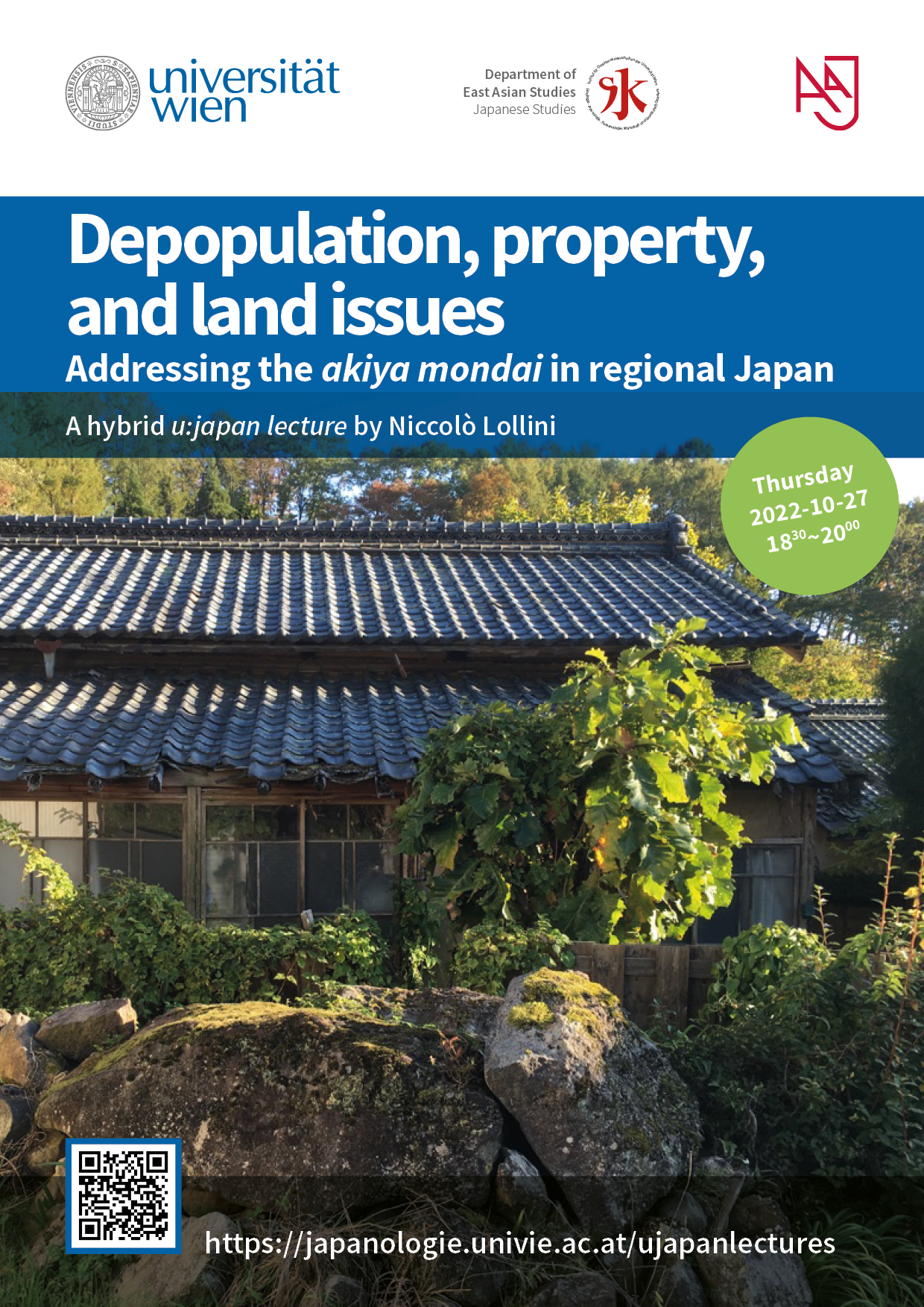 |
Season 5 | Autumn-Winter 2022/23 | s05e04 | 27/10/2022 | en | Niccolò Lollini | University of Oxford | Niccolò Lollini just completed a doctorate in social anthropology at the University of Oxford. His thesis explores the role of agriculture in the revitalization of regional Japan following the recent rise of pro-rural migration. His research interests include agri-food systems, property issues, and rural forms of organization. | Depopulation, property,and land issues: Addressing the akiya mondai in regional Japan | This talk explores the causes and the consequences of property abandonment in regional Japan, as well as the paradox of new settlers from the city struggling to find land and houses in depopulating rural areas. Property has long been conceptualized as a bundle of rights, a metaphor pointing to the complexity of ownership and the plurality of stakeholders involved. Only by unravelling this bundle is it possible to make sense of Japan’s vacant housing crisis and its paradoxes. Property abandonment is shown to be more than a consequence of depopulation and to largely depend on the institutional and social context surrounding land ownership. | https://ustream.univie.ac.at/paella7/ui/watch.html?id=3b6eac47-095f-4cbf-9878-4ec36458c06d | it, uk | hybrid | https://japanologie.univie.ac.at/ujapanlectures/s05/#e04 | Agriculture and Rural Studies, Sociology and Social Sciences | Has Video | ||||||||
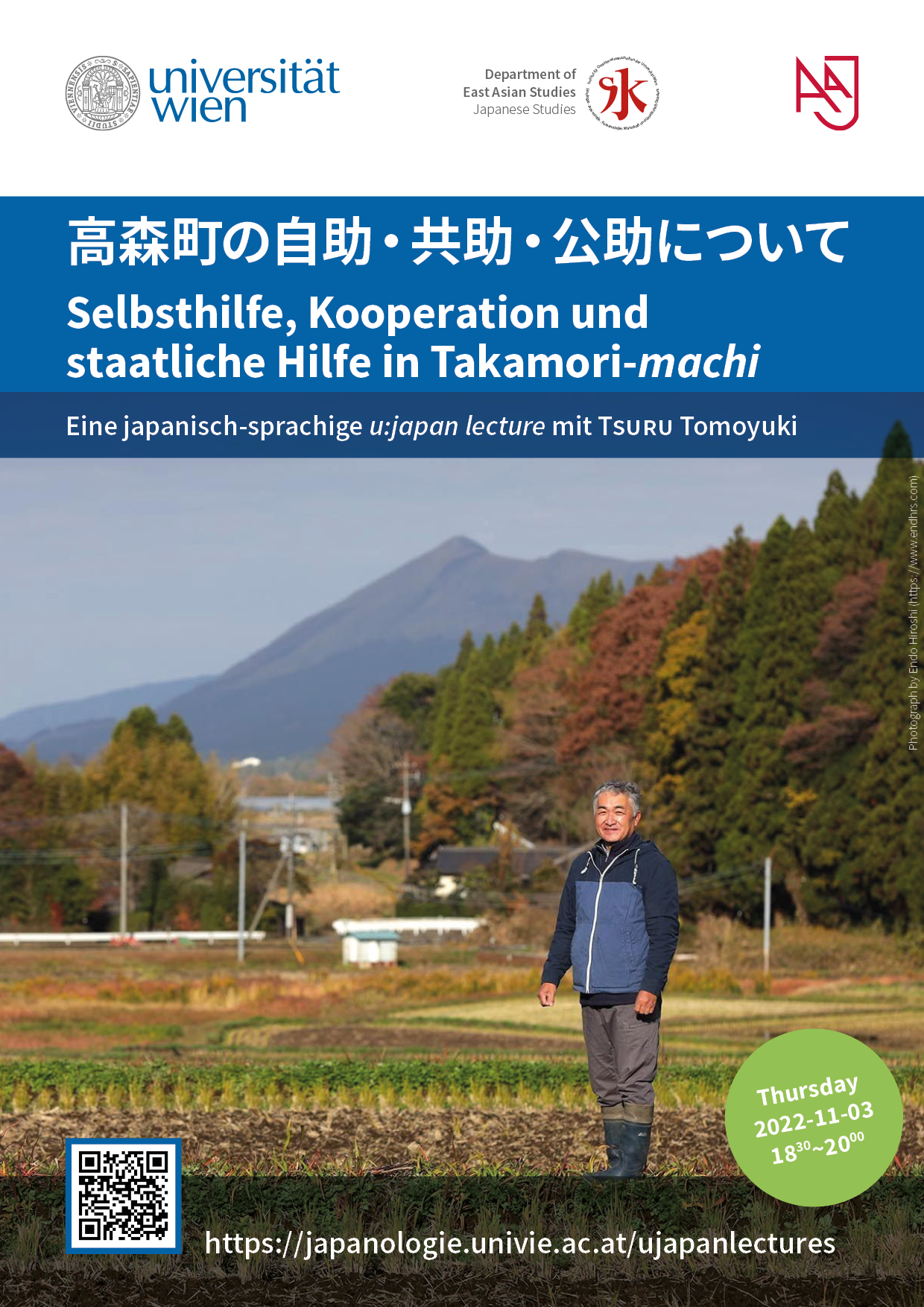 |
Season 5 | Autumn-Winter 2022/24 | s05e05 | 03/11/2022 | jp | Tsuru Tomoyuki | Takamori-machi | 津留智幸 [つる ともゆき] 1965年生まれ(57歳)、高校卒業後、農業を継承 (コメ・花栽培)、1991年 結婚 (3人の娘)、2019年高森町議会議員に初当選(現在1期目) 議員の仕事: 年4回の定例会・臨時議会に出席しての審議、行政のチェック・アドバイス、住民からの要望・意見の伝達、先進地視察 Tsuru Tomoyuki (Lokalpolitiker) geboren 1965, ist Landwirt (Reisanbau und Blumenzucht) und seit 2019 Abgeordneter im Stadtrat von Takamori-machi. In dieser Funktion nimmt er an regelmäßigen Ratssitzungen teil, kontrolliert bzw. berät die lokale Politik und sammelt Meinungen der Bevölkerung | 高森町の自助・共助・公助について - Selbsthilfe, Kooperation und staatliche Hilfe in Takamori-machi | 阿蘇山のカルデラ内に位置する高森町は、地形上、様々な災害の危機に面しています。 安全・安心に暮らすため、自分だけでなく隣近所のひと、集落のひと、行政の職員など、協力しながら過ごしています。また、少子高齢化、人口の減少など様々な課題を抱え、町民だけでなく外部からの人材を招いて解決策を検討しています。今回は以下の3点について紹介します。① 地域おこし協力隊の活動について(女性だけの歌劇団・観光推進機構)② 集落支援員の活動について(高齢者支援・集落の活性化)③ 自然災害の避難訓練について Takamori liegt in der Caldera des Aso-Vulkans und sieht sich aufgrund seiner topographischen Lage einer Vielzahl von Katastrophen gegenübergestellt. Um in Sicherheit leben zu können, ist eine Kooperation von den Bewohner*innen mit ihrer Nachbarschaft, der Siedlung, aber auch der Verwaltung unerlässlich. Zudem werden zunehmend Anstrengungen unternommen, vor dem Hintergrund der demographischen Herausforderungen auch Personen von außerhalb der Region einzuladen, sich in Takamori niederzulassen. Dieser Vortrag möchte Einblicke in das Leben in Takamori aus der Perspektive eines Lokalpolitikers geben und konzentriert sich dabei auf die folgenden Aspekte: 1) Vorstellung der Aktivitäten der Chiiki Okoshi Kyōryokutai (z.B. Die Frauenband oder Möglichkeiten der Förderung des Fremdenverkehrs). 2) Vorstellung der Aktivitäten der Shūraku Shien-in (Mitarbeiter*innen zur Unterstützung des Wohnorts), insbesondere Maßnahmen zur Unterstützung der älteren Bevölkerung sowie zur Revitalisierung der Gemeinde. 3) Vorstellung des Katastrophentrainings bei Naturkatastrophen. | jp | on site | https://japanologie.univie.ac.at/ujapanlectures/s05/#e05 | Agriculture and Rural Studies, Political Science and Law | ||||||||||
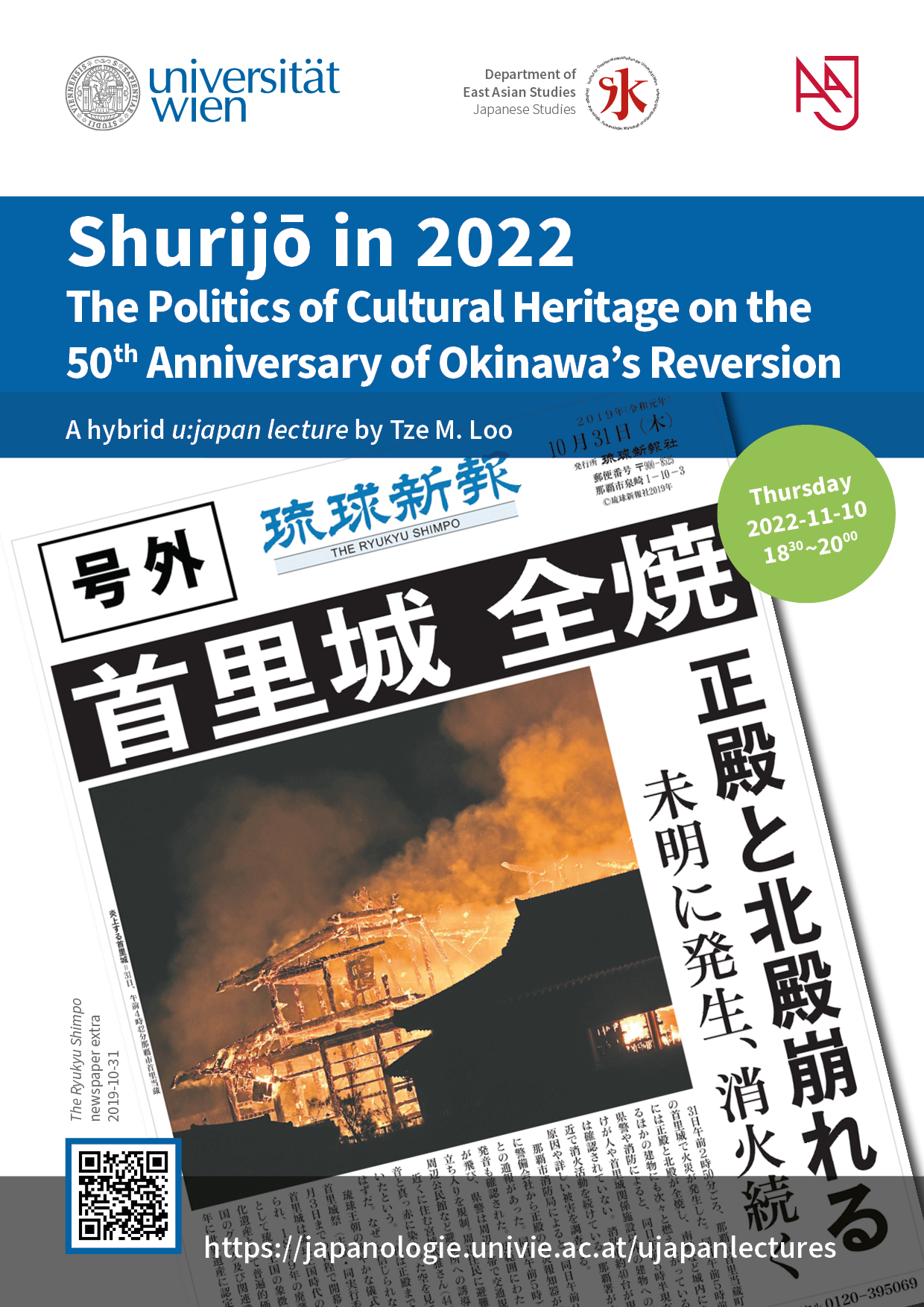 |
Season 5 | Autumn-Winter 2022/23 | s05e07 | 17/11/2022 | en | Tze M. Loo | University of Richmond | Tze M. Loo is an Associate Professor of History at the University of Richmond and is the author of Heritage Politics: Shuri Castle and Okinawa’s Incorporation into Modern Japan, 1879-2000 (Lanham: Lexington, 2014). Her current book project examines the transformations to Okinawa’s ritual landscapes that accompanied Okinawa’s incorporation into the modern Japanese nation state. | Shurijō in 2022: The Politics of Cultural Heritage on the 50th Anniversary of Okinawa’s Reversion | Fifty years after Okinawa’s reversion to Japan, the presence of U.S. military bases in the islands remains a source of deep friction between the prefecture and the central government in Tokyo. Okinawans’ repeated opposition to base construction at Henoko and Tokyo’s insistence on the base’s completion despite that popular opposition has come to encapsulate and symbolize that friction. The fact that construction crawls forward despite Okinawa’s attempts to stop it lays bare the profound asymmetry of power that endures between periphery and center. In contrast to the prefecture’s limited range of options in the base issue, this talk considers Okinawa’s deployment of its cultural heritage as a sphere of action from which a different picture of the prefecture emerges. Specifically, it shows how current plans to rebuild Shurijō – castle of the Ryukyuan court and putative symbol of Okinawan culture – following a devastating fire in 2019 suggest that the prefecture is strategically fashioning a more assertive self that gives it an ability to bend mainland agendas to better suit its purposes. This assertiveness impacts the castle’s rebuilding project, but also has the potential to contribute to the current prefectural leadership’s willingness to take a stronger position vis-à-vis Tokyo to safeguard Okinawa’s interests. | https://ustream.univie.ac.at/paella7/ui/watch.html?id=c3f79b12-4a5e-4dcc-8a62-afe9eca904e0 | us | hybrid | https://japanologie.univie.ac.at/ujapanlectures/s05/#e07 | History and Archaeology, Arts (visual arts and performing arts) and Art History, Architecture and Urban Studies | Has Video | ||||||||
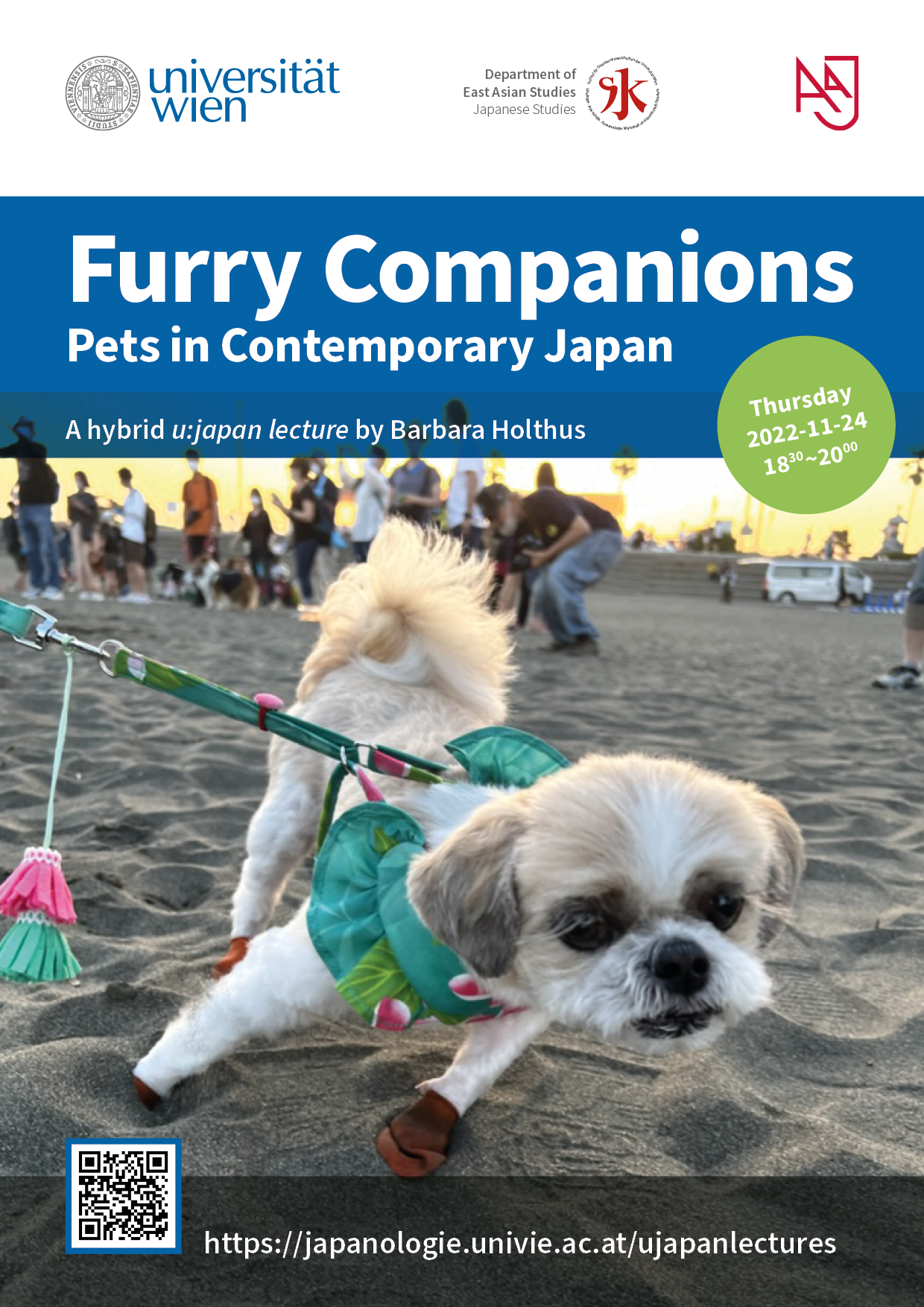 |
Season 5 | Autumn-Winter 2022/23 | s05e08 | 24/11/2022 | en | Barbara Holthus | DIJ Tokyo | Barbara Holthus, PhD in Sociology, Univ. of Hawaii at Manoa, is deputy director at the German Institute for Japanese Studies in Tokyo. Her research is on Japanese families, demographic change, happiness and wellbeing, the Tokyo Olympics, and social movements. Currently she is writing a book on pets in Japan. | Furry Companions: Pets in Contemporary Japan | The accelerated interest in pets in especially urban Japan has not started with the pandemic but certainly has been intensified by it. For more than two years, as anti-Covid measures, Japanese had been told to engage in physical distancing and “self-restraint”. This has led to many people spending extended periods of time at home while less time with family and friends. In response, pets as “substitute” family members often helped to fill the void in human-human interaction. While the U.S. and some European countries reported near-empty animal shelters in the early phase of the pandemic due to a sudden spike in people adopting an animal, Japanese animal shelters saw less of that – as Japanese remain more inclined to “shop” a new family member at a pet shop than adopt a shelter animal. The growing popularity of pets, together with the accompanying normative, social, and legal changes regarding pet ownership within Japanese society are the focus of this presentation. Data comes from interviews with pet owners, pet-business owners, shelter organizations and their volunteers, from participant observation at pet-related public events, in pet shops and pet cafes, as well as from the analysis of publications by the Ministry of the Environment, the National Police Agency, but also from sources such as Instagram, YouTube, as well as manga and TV dorama. This presentation tries to highlight the embeddedness and changing role of pets in Japanese society. | de, jp | on site | https://japanologie.univie.ac.at/ujapanlectures/s05/#e08 | Sociology and Social Sciences, Anthropology and Ethnography | ||||||||||
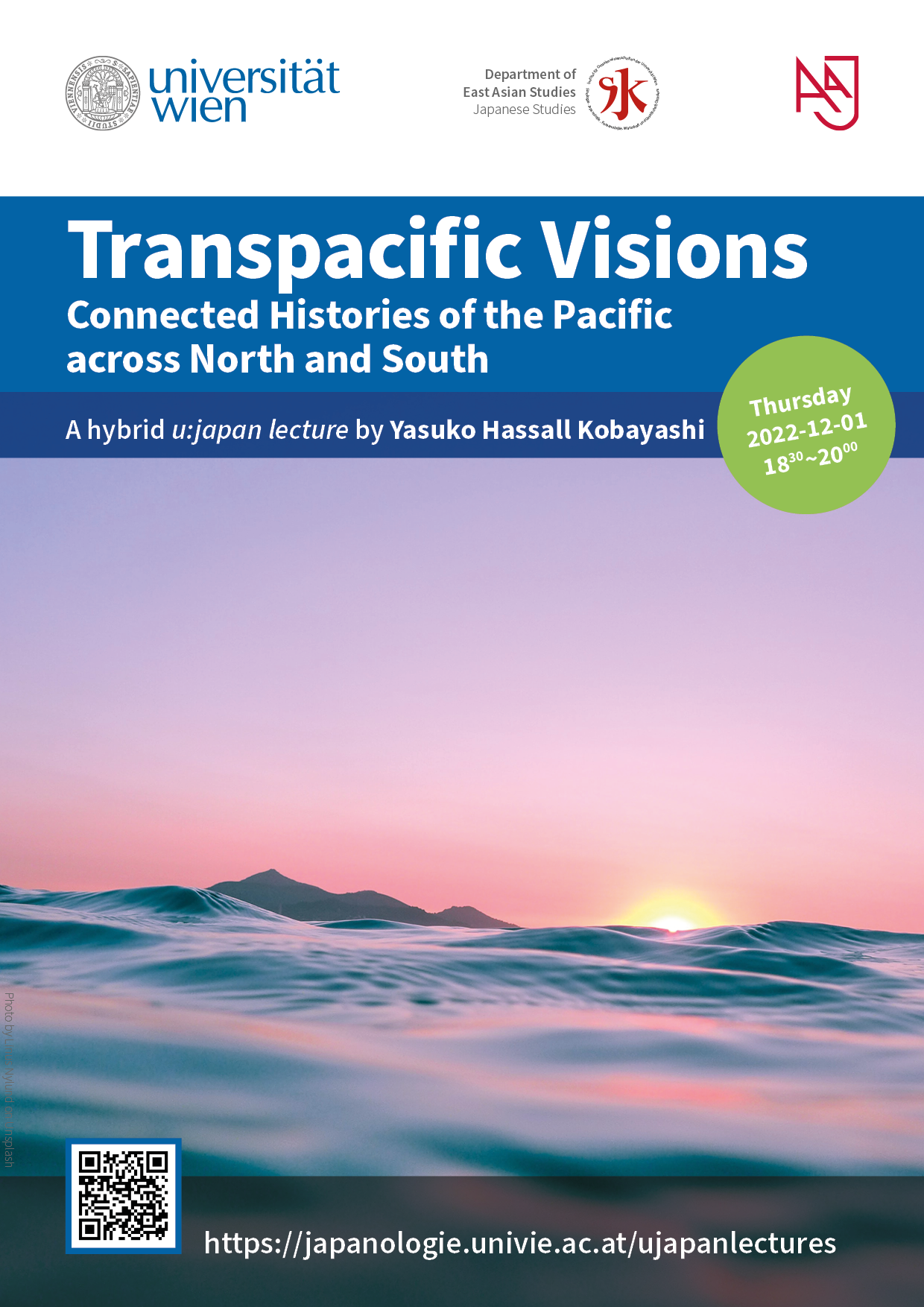 |
Season 5 | Autumn-Winter 2022/23 | s05e09 | 01/12/2022 | en | Yasuko Hassall-Kobayashi | Ritsumeikan University | Yasuko Hassall Kobayashi is Associate Professor at the College of Global Liberal Arts, Ritsumeikan University, Japan. She also holds the position of Assistant Executive Director, Division of Global Planning and Partnerships, Ritsumeikan University; and is an Honorary Associate Professor at the School of Culture, History and Language, ANU College of Asia and the Pacific, the Australian National University. Her main research interest lies in transnational migration and mobilities occurring within the Asia and Pacific region, and in social histories of transnational migration and mobilities. Her two recent books are: (1) (in English, co-edited) Transpacific Visions Connected Histories of the Pacific across North and South (2021, Lexington Books), and (2) (in Japanese, co-authored) A World History of Trade and Transportation (2021, Seizando-Shoten Publishing). | Transpacific Visions: Connected Histories of the Pacific across North and South | This seminar talk is about the book Transpacific Visions: Connected Histories of the Pacific across North and South, published in 2021. While transatlantic history has been much investigated, its counterpart, transpacific history, has only recently attracted scholarly interest. In addition, the focus of transpacific history has been predominantly northern Hemisphere-centric connections, basically US-Asian connections: i.e., those between a hegemonic western country and Asian countries -- either as colonies, trust territories or independent countries (e.g., Hoskins & Nguyen 2014). However, there is more to be explained in the transpacific space beyond such a Northern Hemisphere-centric perspective. This book argues that transpacific history cannot be comprehended without including “vertical” connections; namely, those between the southern hemisphere and the northern hemisphere. It explores such connections by uncovering small histories of ordinary people’s attempts at événements which they undertake by means of uneven, unlevel, and multidirectional mobilities. In this way, this book goes beyond the usual notion of transpacific history as a matter of Northern Hemisphere-centric connections and enables us to imagine the transpacific space as a more dynamic and multi-faceted world of human mobilities and connections. By exploring cases whose actors include soldiers, missionaries, colonial administrators, journalists, essayists, and artists, the book highlights the significance of "vertical" perspectives in understanding complex histories of the region. | https://ustream.univie.ac.at/paella7/ui/watch.html?id=febab699-c60e-478d-9093-a97ca0e2c60a | jp | hybrid | https://japanologie.univie.ac.at/ujapanlectures/s05/#e09 | History and Archaeology, Political Science and Law | Has Video | ||||||||
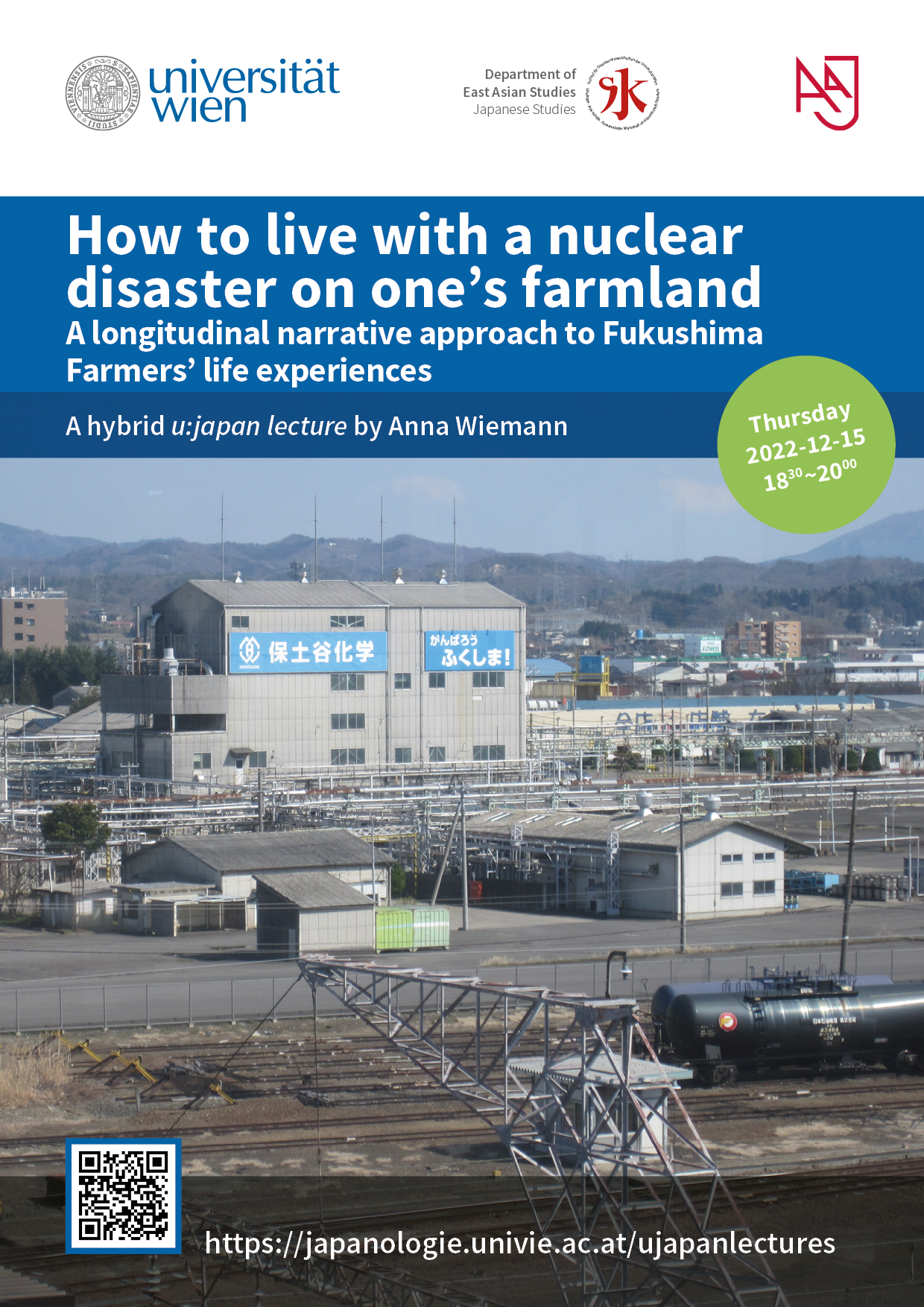 |
Season 5 | Autumn-Winter 2022/23 | s05e10 | 15/12/2022 | en | Anna Wiemann | Ludwig-Maximilians-Universität München | Anna Wiemann is Assistant Professor at the Japan-Center at Ludwig-Maximilians-Universität München, Germany. She is the author of Networks and Mobilization Processes: The Case of the Japanese Anti-Nuclear Movement after Fukushima (2018, München: Iudicium). Her research interests include social movements and civil society, social networks, and collective memory. She has published several peer-reviewed articles on social movements after 3.11 and currently conducts a research project on “collective memory and disaster”. | How to live with a nuclear disaster on one’s farmland: A longitudinal narrative approach to Fukushima Farmers’ life experiences | Almost twelve years have passed since the Great East Japan Earthquake, tsunami and subsequent nuclear disaster at the Fukushima Daiichi nuclear power plant in the little town of Ōkuma located at the coastline of Fukushima prefecture in Northeastern Japan. Researchers today observe a trivialization of the Fukushima disaster queuing in a long line of previous nuclear disasters worldwide (e.g. Bensaude-Vincent et al 2022). Yet, Fukushima Daiichi continues to emit radioactivity and people living in contaminated areas need to create and recreate their life narratives to deal with the consequences of the ongoing, invisible disaster (Creighton 2015). Within disaster research, there is significant consensus that disaster should be primarily defined socially, in terms of sudden occasions when a “fundamental disruption in the social system (of whatever size) […] renders ineffective whatever patterns of social intercourse prevail” (Perry 2018: 14). Still, there are differing views on the role of the hazard agent in disaster definition, including phenomena as broad as earthquake, tsunami, flooding, environmental contamination, climate change, health threats, war etc. I take the view that within a particular social system, patterns of disruption and vulnerability are implicitly shaped by the characteristics of the hazard agent. As such, disasters are unique and often related to social change. On a micro-level, disaster survivors need to incorporate disruptive experiences into their life stories, creating personal and social disaster memory narratives. According to the founder of the concept of social memory, Maurice Halbwachs, individual and social memory are inextricably linked to each other as individual memory narratives refer to established social frames. Thus, the act of remembering and the communicative sharing of experiences of the past enfold their meaning in the present and are linked to a wished-for future. Against this background, I analyze qualitative interviews with farmers in Fukushima prefecture. I question how this group of people whose livelihoods depend on a contaminated environment understand the disaster and what kind of meaning they attach to it for their lives over the course of the past decade. I also explore possible social frames referred to by the farmers at the point in time when the interviews took place. | https://ustream.univie.ac.at/paella7/ui/watch.html?id=5d75dec2-d80a-45be-b109-002fe3899991 | de | hybrid | https://japanologie.univie.ac.at/ujapanlectures/s05/#e10 | Agriculture and Rural Studies, Anthropology and Ethnography, Sociology and Social Sciences | Has Video | ||||||||
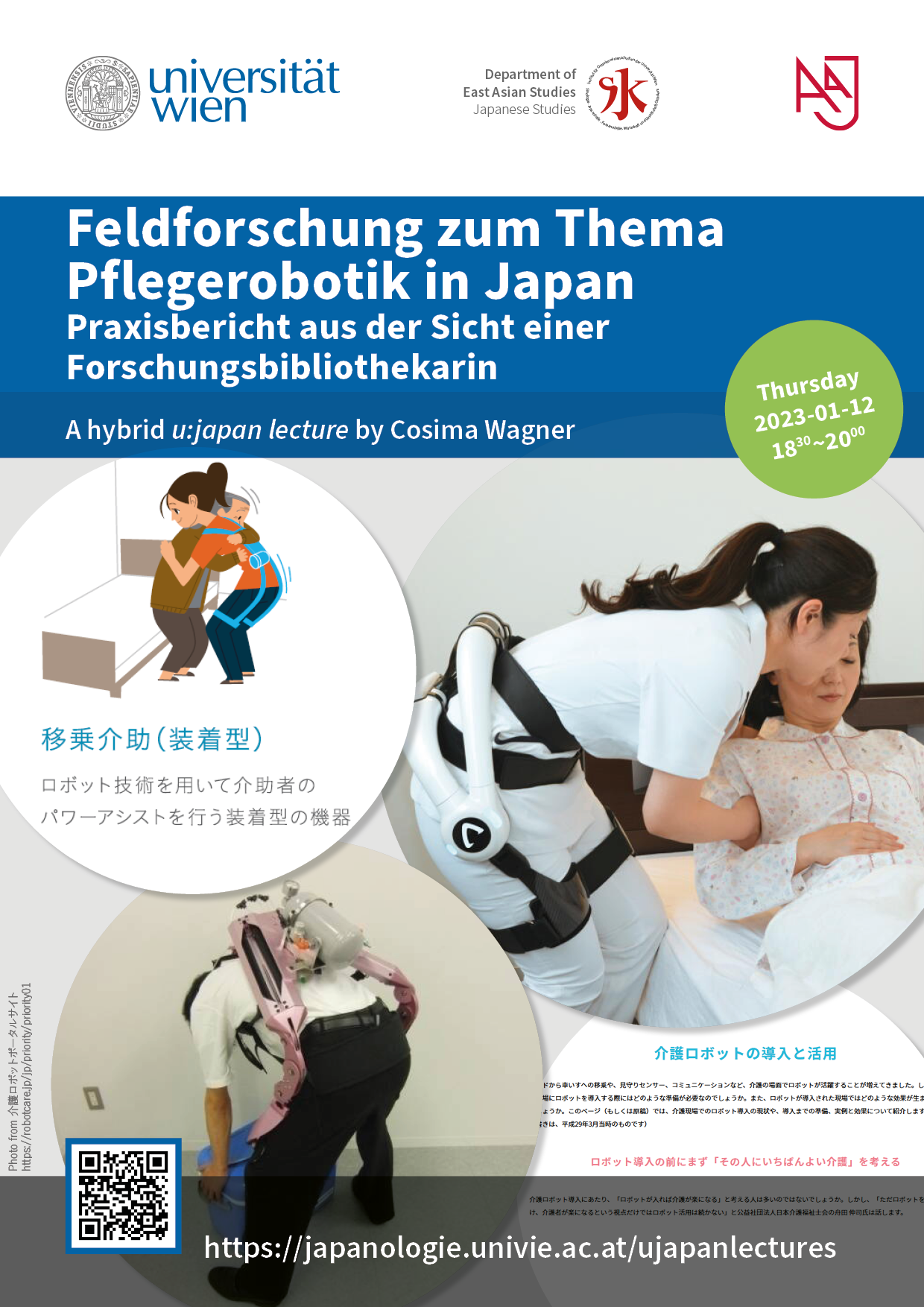 |
Season 5 | Autumn-Winter 2022/23 | s05e11 | 12/01/2023 | de | Cosima Wagner | Freie Universität Berlin | Dr. Cosima Wagner: Studium der Japanologie und Geschichte in Marbug, Kyōto und an der Freien Universität Berlin. 2008 Promotion an der Goethe-Universität Frankfurt im Fach Japanologie mit einer Dissertation zu „Robotopia Nipponica – Recherchen zur Akzeptanz von Robotern in Japan“ (erschienen bei Tectum/Nomos 2013). Seit 2014 gemeinsam mit Dr. Susanne Brucksch (Teikyo University, Japan) Technikstudien-Initiative in der Japanologie und Gründung einer Fachgruppe „Technik“ in der Vereinigung für Sozialwissenschaftliche Japanforschung (VSJF) e.V. 2017-2019 Fernmaster-Studiengang Bibliotheks- & Informationswissenschaften und Bibliotheksreferendariat an der Universitätsbibliothek der Freien Universität Berlin; 2019 Masterarbeit zu „Digitale Transformation und Forschungsinfrastrukturen“ mit Fokus auf Ostasienwissenschaften. Seit 2019 Forschungsbibliothekarin für Ostasienwissenschaften mit einem besonderen Schwerpunkt auf den Themen Digital Humanities, Forschungsdatenmanagement und Open Scholarship an der Universitätsbibliothek der Freien Universität Berlin. | Feldforschung zum Thema Pflegerobotik in Japan: Praxisbericht aus der Sicht einer Forschungsbibliothekarin | Seit Beginn der 2000er Jahre ist die Förderung der Entwicklung von Service-Robotern für das Alltagsleben in den Fokus staatlicher Planungen in Japan gerückt. Der demographische Wandel mache eine Roboter-gestützte Mechanisierung des Alltagslebens allgemein und der Pflege im besonderen unabdingbar, aufgrund eines positiven Images von Robotern seien diese der japanischen Bevölkerung leicht vermittelbar, ein prosperierender neuer Markt für Pflegeroboter habe das Potential, sich zu einer wichtigen Zukunftsindustrie zu entwickeln – lauten häufig genannte Argumente. Der Vortrag kontrastiert die staatlichen Pflegerobotik-„technology push“-Strategien mit den Ergebnissen einer Feldstudie vom Januar 2020 (Leitung: Prof. Dr. Patrick Grüneberg, Universität Kanazawa, Japan), in der die Referentin mit einem interdisziplinären Forschungsteam bei (potentiellen) Nutzer*innen von Pflegerobotik-Technologie nachgefragt und „genba kara no koe“ (Stimmen von vor Ort) im Krankenhaus, Pflegeheim, Pflegegeräte-Sanitätshaus eingefangen hat. Aus der Sicht einer Forschungsbibliothekarin werden dabei auch methodische Fragen der interdisziplinären Projektzusammenarbeit sowie des Forschungsdatenmanagements in den Blick genommen. | https://ustream.univie.ac.at/paella7/ui/watch.html?id=fbb0bd75-7eb2-404e-bd2f-ec064cf85314 | de | hybrid | https://japanologie.univie.ac.at/ujapanlectures/s05/#e11 | Science and Technology Studies (STS) and Digital Humanities, Sociology and Social Sciences | Has Video | ||||||||
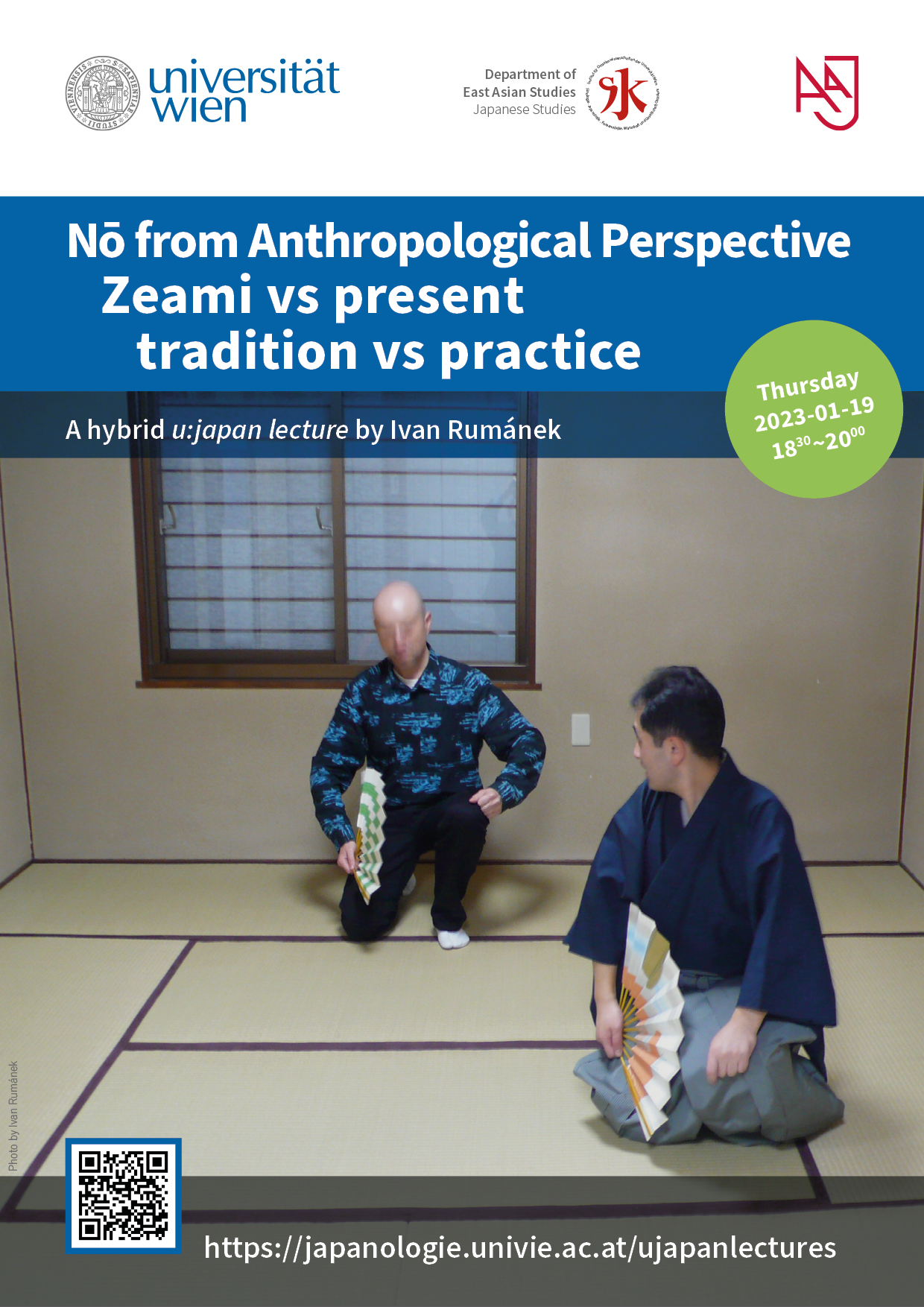 |
Season 5 | Autumn-Winter 2022/23 | s05e12 | 19/01/2023 | en | Ivan Rumánek | Masaryk University | Ivan Rumánek is a Japanologist and linguist coming from Slovakia. He deals predominantly with premodern Japan, classical literature of the Heian period, and classical Japanese theatre. His translation publications include poetry, prose and drama. His research output includes his major Slovak monograph Japanese Noh Drama – an Evolving Genre (2010) and other studies on the evolution of classical theatre (Nō Sumidagawa and jōruri Futago Sumidagawa: genesis of a story and of a genre, 2017) and prehistory of the Japanese language (Where did the principal Japanese Ama tsu kami (“celestial deities”) come from? – an analysis of the Nihon Shoki with ethnic and etymological Japanese-Okinawan-Ainu implications, 2021 and On some parallels in the verbal systems of Manchu-Tungusic and Old Japanese, with possible genealogical implications, 2016). He has done research at Slovak Academy of Sciences (Bratislava), Hōsei University (Tokyo), Waseda University (Tokyo) and University of London. He has been lecturing for Masaryk University (Brno, Moravia) since 2010. | Nō from Anthropological Perspective - Zeami vs present, tradition vs practice - | The theoretical introduction, the nō drama, including its farce companion kyōgen, is analysed from the broader anthropoligical perspective. Its various aspects are characterised according to biological, social, cultural and linguistic anthropology. The second part focuses on embodiment and performativity as observed in amateur nō training and in the practice of using the nō mask. | https://ustream.univie.ac.at/paella7/ui/watch.html?id=f42c96fc-b27e-4e9c-8797-735730c96cca | cz | hybrid | https://japanologie.univie.ac.at/ujapanlectures/s05/#e12 | Arts (visual arts and performing arts) and Art History, History and Archaeology | Has Video | ||||||||
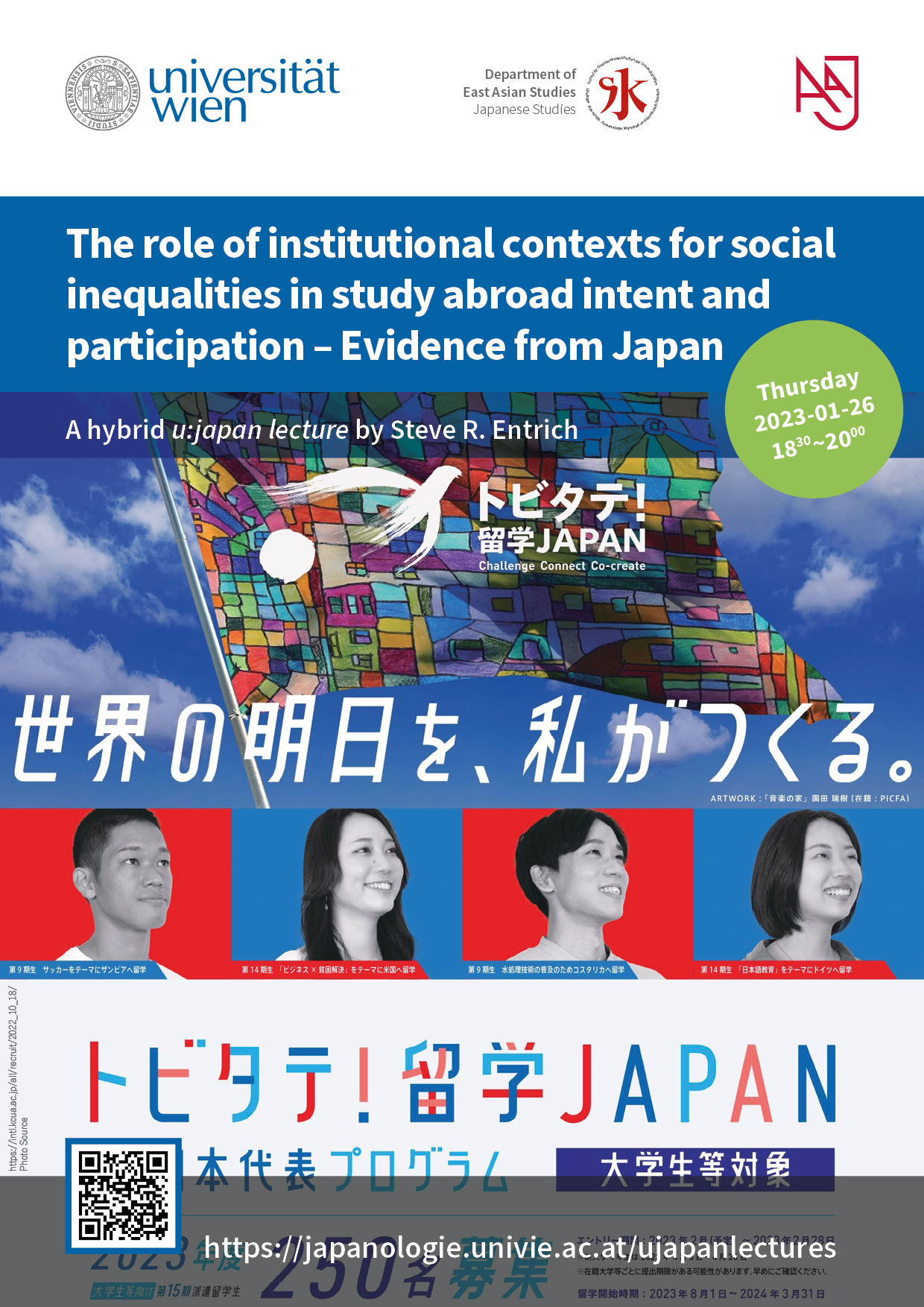 |
Season 5 | Autumn-Winter 2022/23 | s05e13 | 26/01/2023 | en | Steve R. Entrich | Universität Potsdam | Steve R. Entrich is interim Professor for Inclusion and Organizational Development at the Department of Education, the University of Potsdam, Germany. His research focuses on comparative, social science and empirical-quantitative educational research as well as educational policy analyzes on Japan, Germany, the USA and in international comparison with special emphasis on social inequality. Recent research examines implications of transnational, supplementary, and inclusive education in Japan and in cross-national comparison. | The role of institutional contexts for social inequalities in study abroad intent and participation – Evidence from Japan | The expansion of international student mobility (ISM) has become a central issue in educational policy. Governments around the world have implemented programs to internationalize higher education and promote ISM among future workers. However, existing research amply demonstrates that students’ socioeconomic status (SES) strongly influences study abroad intent and participation. Students whose parents have a higher education degree, abundant financial resources and/or high occupational status (higher-SES students) are generally more likely to (intend to) study abroad than lower-SES students. Previous research explained this pattern as the result of individual choices related either to SES-specific endowment with economic, social and cultural capital or cost-benefit assessments and probabilities of successfully completing stays abroad. Only recently have scholars directed their attention to the role of institutional contexts for students’ (SES-specific) chances of studying abroad. While this research did not empirically examine the relevance of actual ISM opportunity structures for (SES-specific) SA intent and participation, it remains unclear whether opportunity structures installed to foster ISM benefit all students, help reduce socioeconomic inequality, or exacerbate it. We address this research gap focusing on Japan. We intend to narrow the outlined research gaps by integrating context effects into a framework that combines rational choice theory (RCT) and the life course perspective (LCP). We test the resulting hypotheses using a multi-level approach (MLA). MLA allows us to determine the relative importance of SES and other individual factors relative to contextual factors, and thus to assess the importance of ISM opportunity structures for SA intent and participation, and corresponding social inequalities. Unlike earlier studies, we examine the effects of ISM opportunity structures at the university level on SA intent and participation under control of various individual-level factors. Using a nationwide and largely unexploited dataset from Japan, which we supplement with university-level data, we address the politically charged question about the role of universities’ ISM opportunity structures for (social inequalities in) SA intent and participation: Has Japan’s recent push towards internationalization of higher education created more opportunities for social distinction of the affluent, resulting in increasing horizontal inequalities, or rather narrowed corresponding SES gaps? | https://ustream.univie.ac.at/paella7/ui/watch.html?id=4dfb27c7-2faa-4b3e-86d3-4b18123d2278 | de | hybrid | https://japanologie.univie.ac.at/ujapanlectures/s05/#e13 | Sociology and Social Sciences | Has Video | ||||||||
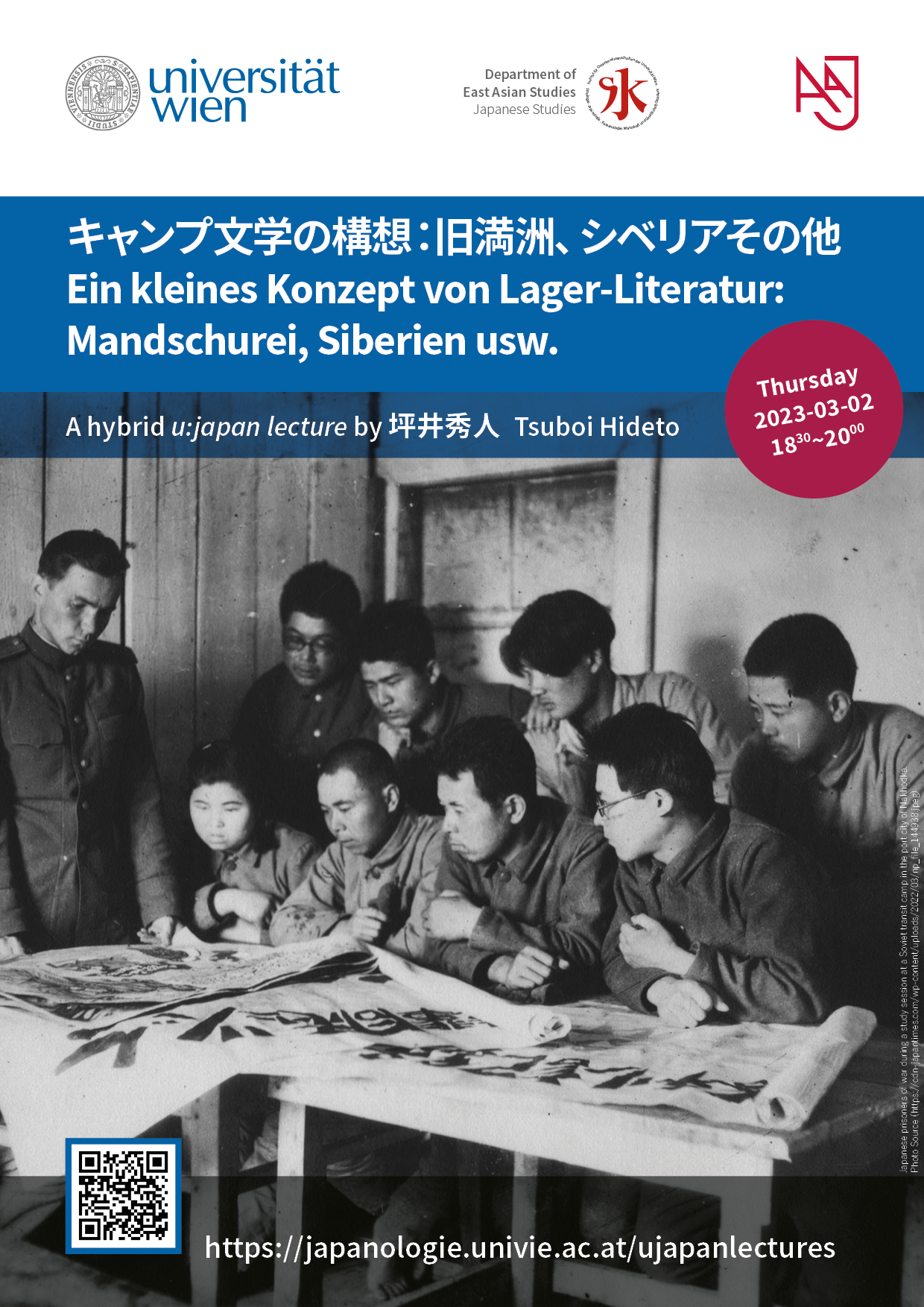 |
Season 6 | Spring 2023 | s06e01 | 02/03/2023 | jp | 坪井秀人 Tsuboi Hideto | Waseda University | Tsuboi Hideto (坪井秀人) is professor of Waseda University, Tokyo and professor emeritus of the International Research Center for Japanese Studies, Kyoto and of Nagoya University. He has written on the issues of body politics, sense representation and the other in modern Japanese literature. His publications include Koe no Shukusai: Nihon Kindaishi to Sensō (Fest of Voices: Modern Japanese Poetry and War), University of Nagoya Press, 1997, Kankaku no Kindai: Koe, Shintai, Hyōshō (Sensibilities in the Modern Age: Voice, Body and Representation), University of Nagoya Press, 2006, Sei ga kataru: 20 Seiki Nihon Bungaku no Sei to Shintai (Sexuality Speaks: Sex/Gender and Body in the Literature in Twentieth-Century Japan ), University of Nagoya Press, 2012, Nijûseiki Nihongo shi o omoidasu (Remembering the Twenty Century Japanese Language Poetry), Shichôsha, 2020. and Sengo Hyôgen: Japanese Literature after 1945 (Postwar Expression: Japanese Literature after 1945), University of Nagoya Press, 2023. | キャンプ文学の構想:旧満洲、シベリアその他 - Ein kleines Konzept von Lager-Literatur: Mandschurei, Siberien usw. | In his lecture, held in Japanese, the renown literary scholar Tsuboi Hideto analyses the post war production of Japanese literature in the former colony Manchuria and soviet Siberia and develops the concept of キャンプ文学 „camp-literature“. Besides stories from his fieldtrip where he visited the remains of historic sites (now in Russia and China) his talk features besides others the following works of literature: 蛙昇天 Kaeru shōten [The Ascension of a Frog], 1951 by 木下順二 Kinoshita Junji, シベリヤ詩集 Shiberia shishū [Siberian Poetry], 1952 by 長尾辰夫 Nagao Tatsuo, 俘虜記 Furyoki [Taken Captive], 1948 by 大岡昇平 Ōoka Shōhei and サンチョ・パンサの帰郷 Sancho Pansa no kikyō [Homecoming of Sancho Panza], 1963 by 石原吉郎 Ishihara Yoshirō. | https://ustream.univie.ac.at/paella7/ui/watch.html?id=4d1377f8-74e7-41b5-b493-44f91ac4d8fd | jp | hybrid | https://japanologie.univie.ac.at/ujapanlectures/s06/#e01 | Literature and Media Studies, History and Archaeology | Has Video | ||||||||
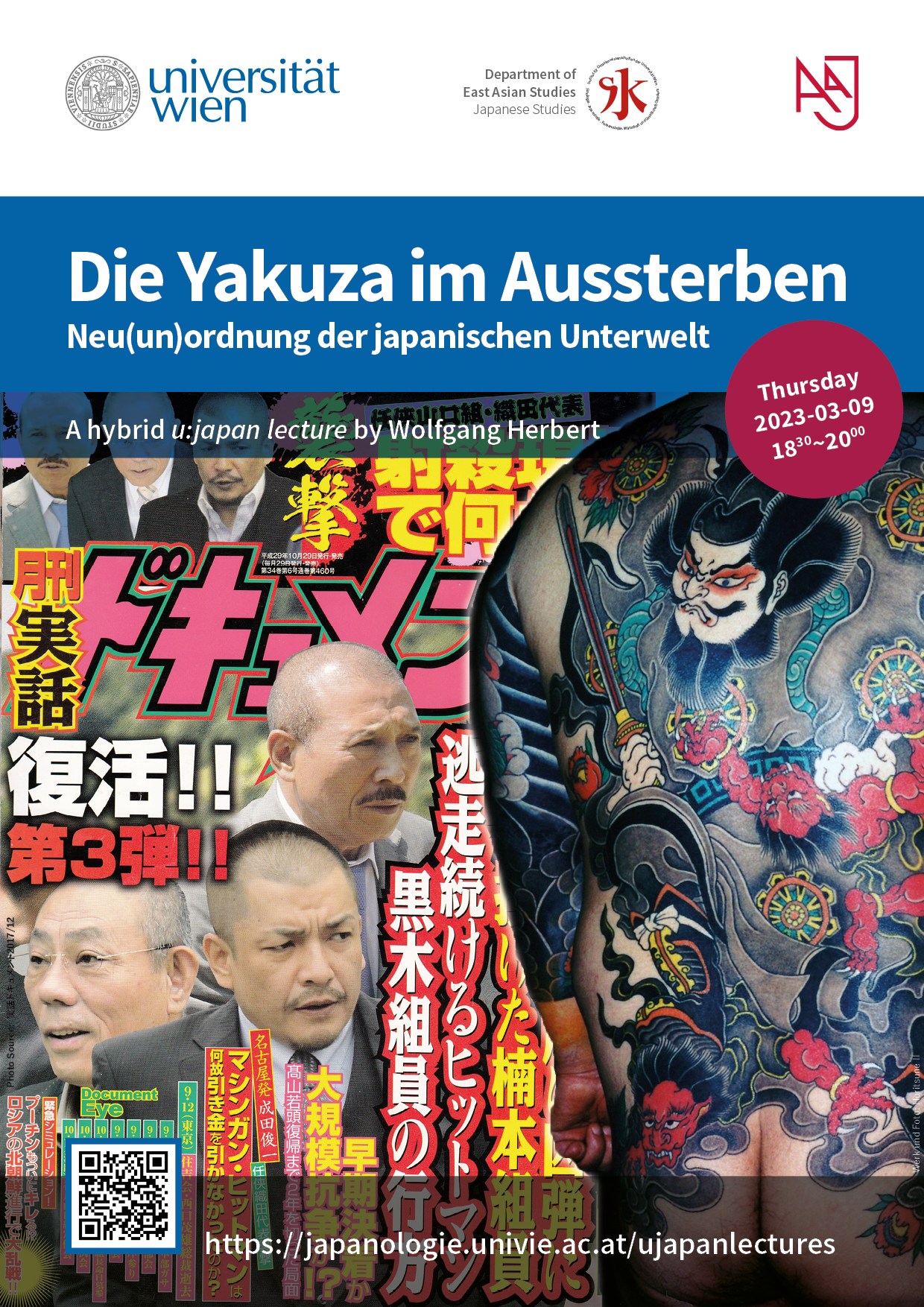 |
Season 6 | Spring 2023 | s06e02 | 09/03/2023 | de | Wolfgang Herbert | Tokushima University | Dr. Wolfgang Herbert, Promotion in Japanologie (Nebenfach: Religionswissenschaften) an der Universität Wien 1993, Professor für Vergleichende Kulturwissenschaften an der Universität Tokushima. Hauptautor (mit Dirk Dabrunz) des Buches: Japans Unterwelt. Reisen in das Reich der Yakuza. 2. aktualisierte Aufl. Berlin: Reimer 2022. Ein aktueller Artikel zum Thema erschien in den OAG Notizen 2022 (11) unter dem Titel „Saraba Yakuza – Aufstieg der Hangure“ | Die Yakuza im Aussterben: Neu(un)ordnung der japanischen Unterwelt | Der altgediente Kriminaljournalist Mizoguchi Atsushi spricht von „tektonischen Verschiebungen“ in Japans Unterwelt. Er hat auch den Begriff für neue kriminelle Cliquen geprägt: Hangure. Nicht rechtstreue Bürger, nicht Yakuza, beides zur „Hälfte“ (han) und „heruntergekommen“ (von „gureru“), aber eben auch nur auf halber Strecke. „Gure“ kann auch für „grau“ in Grauzone stehen. Anhand exemplarischer (Auto)Biographien wird der Referent versuchen, das Milieu und die Lebenswelt der hangure zu schildern. Es handelt sich bei ihnen um lose, netzwerkartige, kurzfristige, deliktzentrierte Zweckverbindungen, die Polizei spricht auch von „amöbenhafter“ Struktur. Meist handelt es sich um kleine Zellen, aber manche hangure imitieren die Yakuza-Organisationen in ihrem pyramidenhaften Aufbau und es sind Banden mit mehreren hundert Mitgliedern aufgeflogen. Ihre Haupteinnahmequelle sind Betrugsverbrechen, wobei betuchten Betagten mit diversen Schwindeleien die Ersparnisse abgeluchst werden (sog. furikomesagi = Betrügereien via Banküberweisung). Dazu gehört auch Investitionsbetrug. Daneben gibt es massiv gewaltbereite hangure, die zunehmend Yakuza-Domänen wie das Kredithaiwesen, Schuldeneintreiben, Schutzgelderpressung und die Sexindustrie übernehmen. Im Nachtleben sind sie heute dominant, betreiben „Girl Bars“ und Host-Clubs, in denen exorbitant überhöhte Preise abgepresst werden. Auch das Glücksspiel (Internet) und der Drogenhandel gehen in ihre Hände über. Es bilden sich hybride Formierungen aus: Yakuza und Ex-Yakuza fungieren als Auftraggeber oder Consiglieri oder werden gar Mitglieder. Es kommt zu Geldfluss zu den Yakuza, die für Protektion und Logistik sorgen. Die landesweite Mannstärke der Yakuza weist in den letzten Jahren einen beträchtlichen Schwund auf. Der Nachwuchsmangel ist eklatant. Ökonomisch haben die Yakuza eine Modernisierung und Adaption an die Informationsgesellschaft verpasst. Sie stehen unter fatalem Druck der Strafverfolgungsbehörden. Unter deren Radar bleiben hingegen die neuen kriminellen Gruppen, die nicht Objekt der rigorosen Anti-Yakuza-Gesetze und Ausschlussverordnungen sind. Auf dem kriminellen Markt geschieht ein Verdrängungswettbewerb und Generationswechsel, der die Yakuza mehr und mehr zum Verschwinden bringt. Dafür erleben sie eine filmische Auferstehung auf Netflix, worauf der Referent auch kurz verweisen wird. | https://ustream.univie.ac.at/paella7/ui/watch.html?id=191482b9-3725-4e32-ace5-783f2d082343 | jp | hybrid | https://japanologie.univie.ac.at/ujapanlectures/s06/#e02 | Sociology and Social Sciences | Has Video | ||||||||
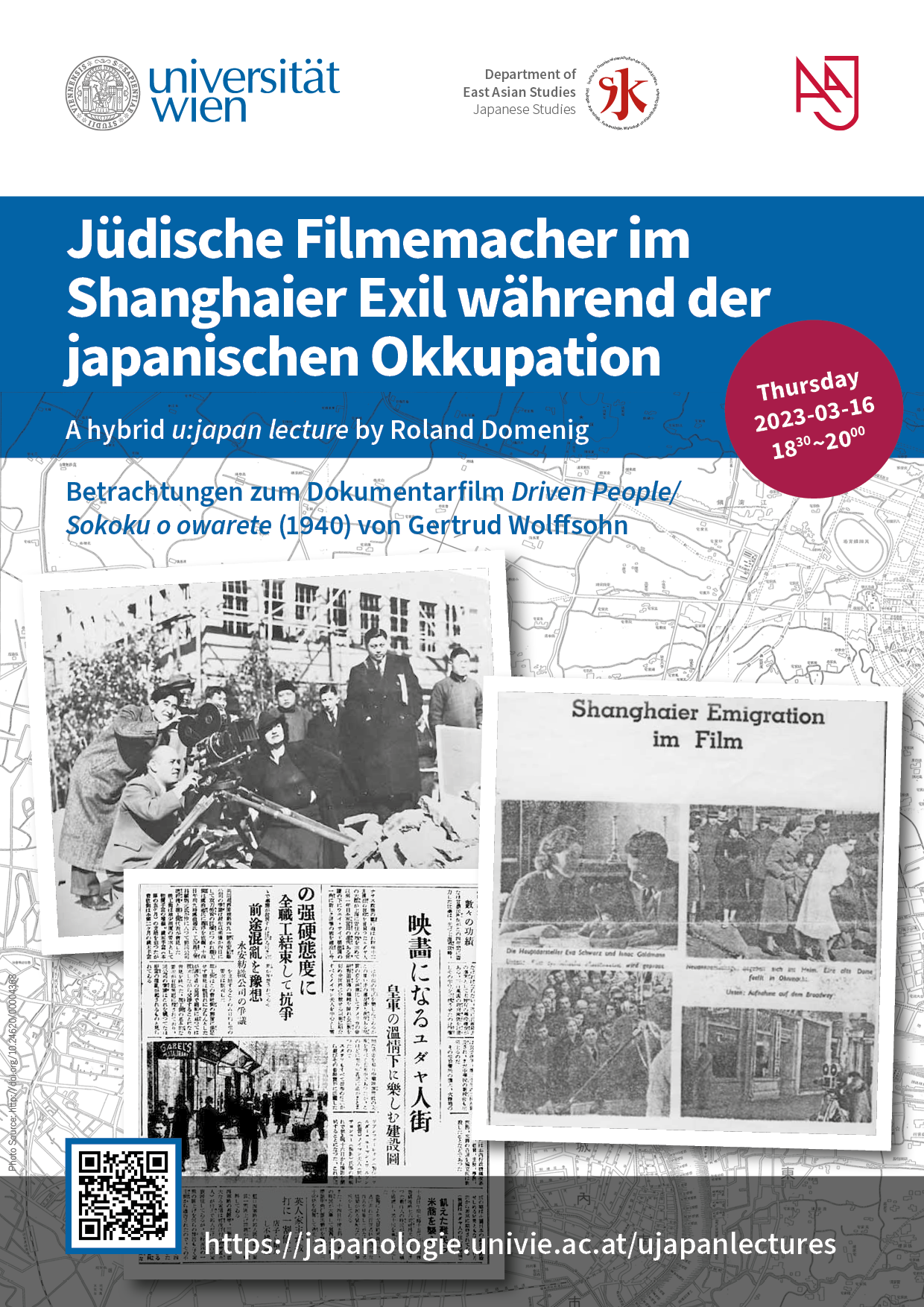 |
Season 6 | Spring 2023 | s06e03 | 16/03/2023 | de | Roland Domenig | Meiji Gakuin University | Dr. Roland Domenig, Associate Professor für japanische Filmgeschichte an der Meiji Gakuin Universität in Tokyo, hat an der Universität Wien im Fach Japanologie promoviert, und ist Vize-Präsitent des Akademischen Arbeitskreises Japan (AAJ). Sein hauptsächliches Forschungsgebiet ist die Geschichte des japanischen Films, insbesondere die des frühen Films und die des unabhängigen Kinos der 60er Jahre (u.a. ATG). Domenig ist auch als Kurator Japan-spezifischer Filmprogramme (u.a. für BFI, MoMA, Cinematheque Francaise sowie zahlreiche internationale Filmfestivals), Berater von Filmfestivals sowie als Untertitelübersetzer tätig. | Jüdische Filmemacher im Shanghaier Exil während der japanischen Okkupation: Betrachtungen zum Dokumentarfilm Driven People/ Sokoku o owarete (1940) von Gertrud Wolffsohn | In der einschlägigen Fachliteratur zur deutschen Filmgeschichte sucht man vergebens nach dem Namen der jüdischen Regisseurin Gertrud Wolffsohn, die nach ihrer Flucht vor den Nazis in Shanghai mit Unterstützung der von Kawakita Nagamasa geleiteten China Film Company einen Dokumentarfilm über die nach Shanghai emigrierten Juden drehte, der in der deutschsprachigen Filmgeschichtsschreibung und in der jüdischen Exilforschung im besten Fall als Fußnote Erwähnung findet. In japanischen Quellen zur Geschichte der China Film Company findet der Film zwar gelegentlich Erwähnung, man erfährt aus ihnen aber über die Regisseurin nicht viel mehr als ihren Namen und wenig Konkretes über den Film, der als Fundraising-Projekt für die jüdische Flüchtlingshilfe geplant war, dessen Produktion laut Quellen aber auf Befehl des japanischen Militärs eingestellt werden musste, weshalb er als unvollendet und verschollen gilt. Eine kritische Überprüfung der bisher bekannten japanischen Quellen sowie bislang unveröffentlichte neue Quellen stellen obige Darstellung jedoch in Frage. In dem Vortrag werde ich zunächst die Regisseurin des Films, Gertrud Wolffsohn, und dessen Produzenten Kawakita Nagamasa, kurz vorstellen, das Zustandekommen des Films und dessen Inhalt betrachten und schließlich eine Neubewertung des vermeintlich unvollendeten Films anstellen. | https://ustream.univie.ac.at/paella7/ui/watch.html?id=1092cac0-b907-4454-943c-6928bc00046f | jp | hybrid | https://japanologie.univie.ac.at/ujapanlectures/s06/#e03 | Literature and Media Studies, Arts (visual arts and performing arts) and Art History, History and Archaeology | Has Video | ||||||||
 |
Season 6 | Spring 2023 | s06e04 | 23/03/2023 | en | Carmen Sapunaru Tămaș | University of Hyogo | Carmen Sapunaru Tămaș is a professor and the coordinator of the Japanese language and culture program at the University of Hyogo. Her most recent publications include: “Ritual Practices and Daily Rituals. Glimpses into the World of Matsuri” (Pro Universitaria 2018), “Beliefs, Ritual Practices and Celebrations in Kansai” (Pro Universitaria 2019, 2022, 2023), “Forms of the Body in Contemporary Japanese Society, Literature, and Culture” (edited with Irina Holca, Lexington Books 2020), and “Epidemics and Ritual Practices in Japan” (edited with Kathryn M. Tanaka, Pro Universitaria 2022). | It’s a (Gentle)Men’s World: Gendered Communities within Tenjin Matsuri | This lecture is a brief overview of one of Japan’s three greatest festivals, Tenjin Matsuri, from the perspective of the first scholar/ non-Japanese national/ female who was allowed to attend all the annual events (from organizational meetings and formal shrine visits to budget reviews and drinking parties) of Otori Mikoshi Group. Tenjin Matsuri is supported by 24 active groups (kô), but the most significant ones are exclusively male: Gohoren Kô, Otori Mikoshi Kô, Taiko Naka Kô. Tenjin Kô is one of the six groups who make the major decisions related to the festival, they do have numerous female members, but those members, however, do not become kômoto (group leaders). This presentation will focus on the role each traditional gender plays in the management and performance of the festival, in an attempt to provide a better understanding of the social and sacred mechanisms at play, as well as the changes (if any) that have occurred in contemporary society. | https://ustream.univie.ac.at/paella7/ui/watch.html?id=b17d5d8e-501a-48b0-ab56-8673f15d6316 | jp | hybrid | https://japanologie.univie.ac.at/ujapanlectures/s06/#e04 | Gender Studies and Minority Studies, Religion and Philosophy | Has Video | ||||||||
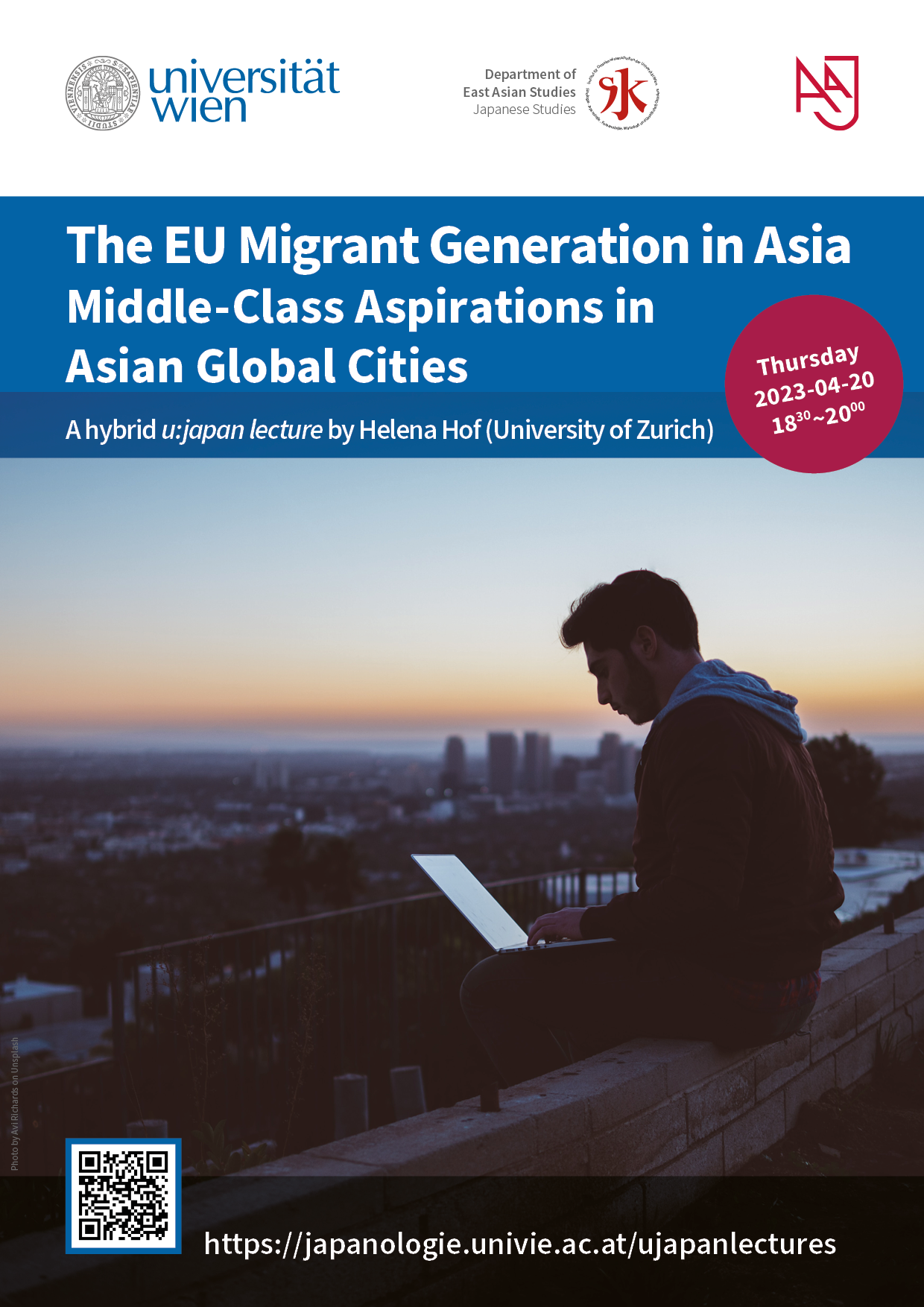 |
Season 6 | Spring 2023 | s06e06 | 20/04/2023 | en | Helena Hof | University of Zurich | Helena Hof is Senior Research and Teaching Fellow in Social Science of Japan at the University of Zurich and a Research Fellow at the Socio-Cultural Department of the Max Planck Institute for the Study of Religious and Ethnic Diversity. Her work focuses on Japan and lies at the nexus of migration studies, the sociology of work, gender, ethnicity and race, and global cities and entrepreneurship. She is currently part of a German government-funded collaborative project on the role of skills in labor migration processes in Asia, within which Helena examines foreign entrepreneurs in Tokyo’s and Singapore knowledge-intensive startup scene. Helena holds guest researcher affiliations with Waseda's Institute of Asian Migrations in Tokyo and the Asia Research Institute’s Migration Cluster at the National University of Singapore and has published widely in academic journals such as Social Science Japan Journal, Ethnic and Racial Studies, Asia Pacific Migration Journal, and Mobilities. | The EU Migrant Generation in Asia: Middle-Class Aspirations in Asian Global Cities | Looking at young Europeans who migrated to Tokyo and Singapore in the 2010s, this book sheds light on early-career migration and on socio-cultural change in Japan and Singapore. We see how migration to Asian business centres has become a way of distinction and an alternative way of middle-class reproduction for young Europeans. The book also reveals how perceived insecurities in the crisis-ridden EU result in these migrants’ migration or prolonged stays in Asia. This pioneering work makes the case for EU citizens’ aspired lifestyles and professional employment that is no longer only attainable in Europe or the West. Tokyo and Singapore have become their temporary homes. Having spent the crucial first life stage of ‘full’ adulthood and economic independence in Asia, the migrants have established grounds for a middle-class lifestyle that they might not be able to replicate back home. Japan’s and Singapore’s changing migration regimes, however, pose different barriers to the migrants, which results in ambiguous feelings towards their host societies. The analysis reveals a diametrical change in both country's migration policies and offers a nuanced portrayal of the way continous ethnic diversification and globalization affect the daily lives of foreign professionals in Tokyo and Singapore. | https://ustream.univie.ac.at/paella7/ui/watch.html?id=e770add2-85d4-4e71-ad13-18d27934eb20 | ch | hybrid | https://japanologie.univie.ac.at/ujapanlectures/s06/#e06 | Sociology and Social Sciences, Economics and Business Studies | Has Video | ||||||||
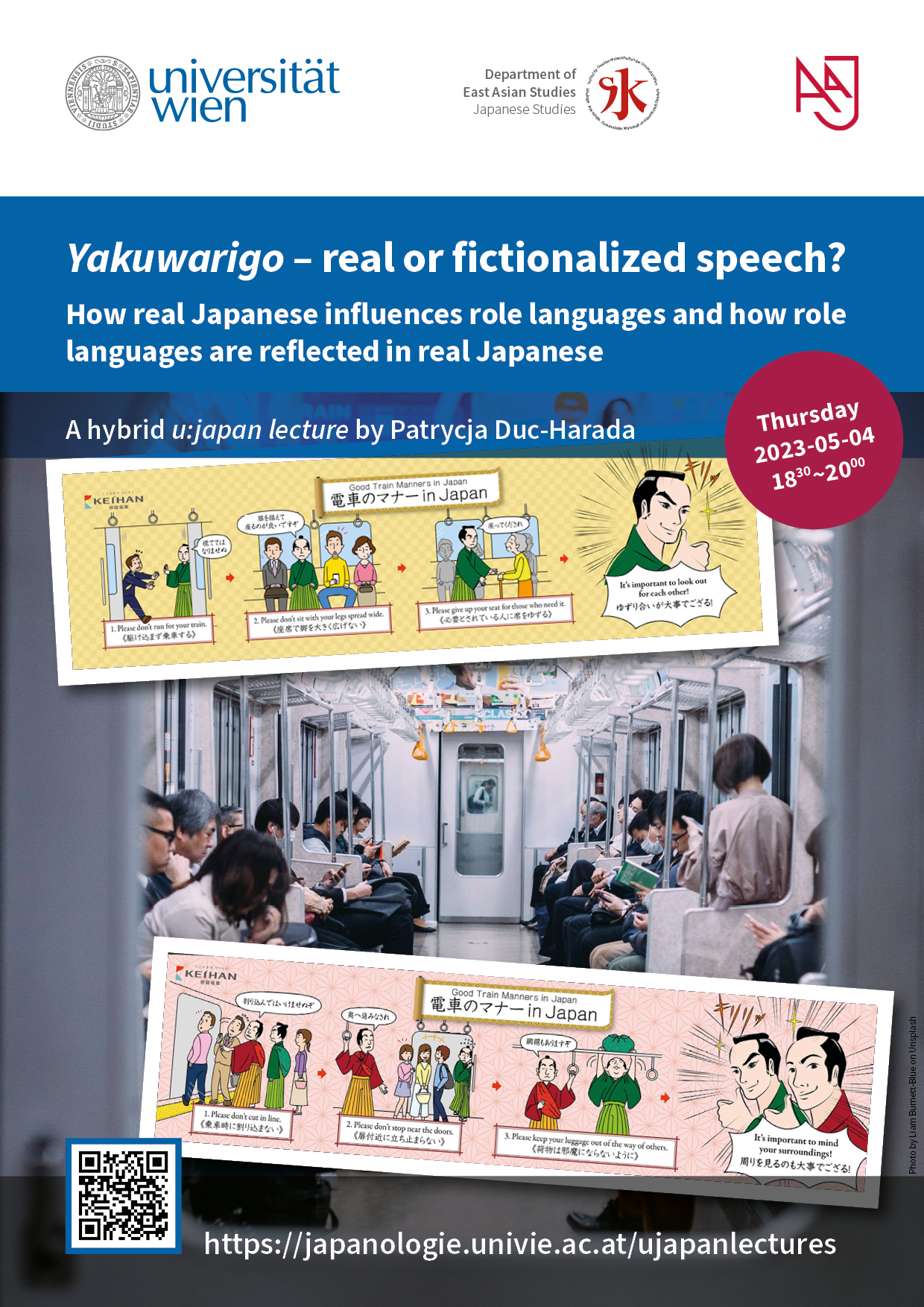 |
Season 6 | Spring 2023 | s06e08 | 04/05/2023 | en | Patrycja Duc-Harada | Jagiellonian University in Cracow | Patrycja Duc-Harada is an assistant professor at the Department of Japanese and Chinese Studies of Jagiellonian University in Cracow, Poland. She obtained her Ph.D. degree in linguistics in 2017, with a dissertation on Japanese youth sociolect. Her doctoral thesis was published as a monograph entitled Japoński socjolekt młodzieżowy jako manifestacja świadomości językowej młodego pokolenia (Eng. Japanese Youth Sociolect as a Manifestation of Linguistic Awareness of the Young Generation) in 2020. Her research focuses on various aspects of Japanese sociolinguistics, ethnolinguistics, pragmatics, as well as Japanese language education. She has conducted qualitative research on Japanese language during several fieldwork stays in Japan. Her recent research interest focuses on changes and transformations occurring within the category of Japanese honorifics. | Yakuwarigo – real or fictionalized speech? How real Japanese influences role languages and how role languages are reflected in real Japanese | The aim of this lecture is to present the widely discussed concept of yakuwarigo 役割語 ‘role language’ from two perspectives: fictionalized speech (using examples of characteristic lines and dialogue taken from popular anime, manga and drama series), as well as real Japanese language used in private and public spheres. This discussion promises to reach interesting conclusions concerning the impact of Japanese language and culture on role and character languages, and the ways and reasons for which role languages are occasionally and intentionally implemented in real speech as a communicative strategy. The first part of the lecture discusses major terms (yakuwari and yakuwarigo, kyarakutā and kyarakutā gengo, kyara, rashisa, sutereotaipu, rejisutā, etc.) from the perspective of linguistic stylization and Japanese sociolinguistics. In this part, standard language (hyōjungo), Japanese standard honorifics (keigo), but also non-standard honorifics (e.g. -ssu form) will be introduced as examples of role languages that play a significant part in portraying appropriate (demanded) or inappropriate (undemanded) behaviours. The topic of yakuwarigo’s potential impact on the language and behaviours of contemporary people and their speech will also be briefly discussed. In the second part, selected examples of role languages and character languages that occur in real Japanese communication will be introduced. Two communicative spheres: private (e.g. teacher’s speech, parent’s speech), as well as public (e.g. posters, announcements, commercials, blogs, celebrity speech) will be distinguished in order to discover major tendencies and also explain motivations for using stylized speech. Finally, the occurrence of role language in language education (based on examples from textbooks) will be briefly presented to indicate the impact of role language and stylized language on young people’s linguistic competencies. The lecture is based on selected published sources referring to the discussed subjects, as well as the outcomes of the individual research conducted by the author in recent years. | https://ustream.univie.ac.at/paella7/ui/watch.html?id=92d75981-48fc-4fd0-b4b4-aac272eef2c3 | pl | hybrid | https://japanologie.univie.ac.at/ujapanlectures/s06/#e08 | Linguistics and Language Education | Has Video | ||||||||
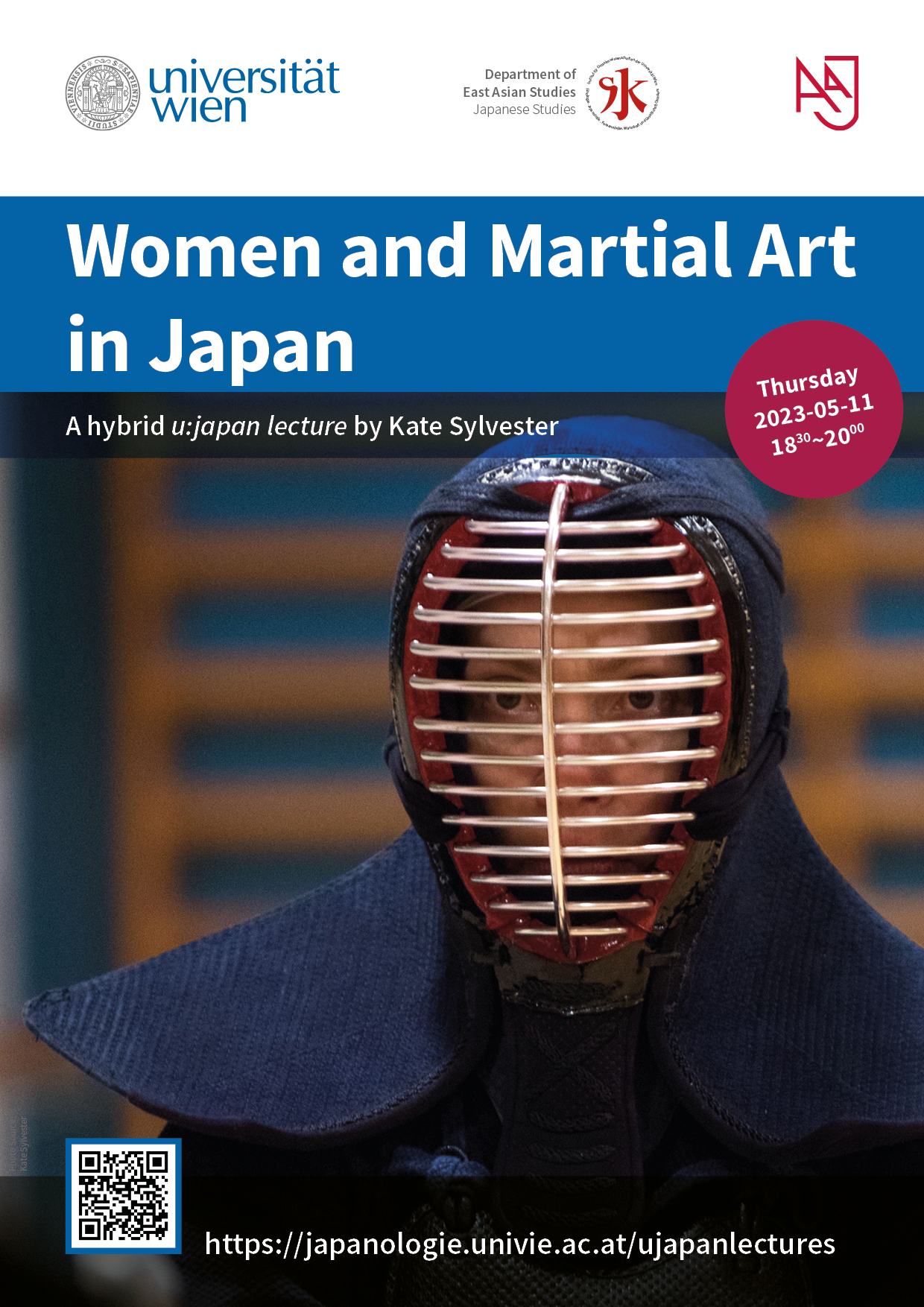 |
Season 6 | Spring 2023 | s06e09 | 11/05/2023 | en | Kate Sylvester | The Swedish School of Sport and Health Sciences, GIH | Dr Kate Sylvester is a research affiliate of The Swedish School of Sport and Health Sciences (GIH). Her work intersects school club sport (bukatsudō), gender identity politics, and cross-cultural transformations of body culture with a special focus on Japanese martial arts (budō). Kate has trained and competed in kendo for 31-years across multiple (cultural, international) settings. She is the head coach of the Swedish Women’s National Kendo Team. | Women and Martial Art in Japan | This lecture will focus on the ethnographic work and key arguments from Dr Kate Sylvester’s recent publication, Women and Martial Art in Japan. The book, based on extensive original research, examines the practice by women in a university sport setting of kendo, the Japanese martial art which, using bamboo swords as well as protective armour, and descended from traditional swordsmanship, instils in its practitioners, besides physical skills, societal values of etiquette and resilience as well connecting them to a “traditional” outlook, which includes a gendered cultural identity. The book therefore illustrates an unexplored example of identity construction in Japan, one which legitimises women’s sport experiences within a male-centric physical culture, unpacks the notion of “tradition” in kendo and unravels its stultifying control over women’s kendo participation, and discusses the androgenicity of women’s participation to highlight its subversive potential to develop women as leaders in sport, politics, and other fields which continue to be very male dominated in Japan. | https://ustream.univie.ac.at/paella7/ui/watch.html?id=660703b9-c8c4-4d24-b16b-6c069ddc27c0 | se | hybrid | https://japanologie.univie.ac.at/ujapanlectures/s06/#e09 | Gender Studies and Minority Studies, Sociology and Social Sciences | Has Video | ||||||||
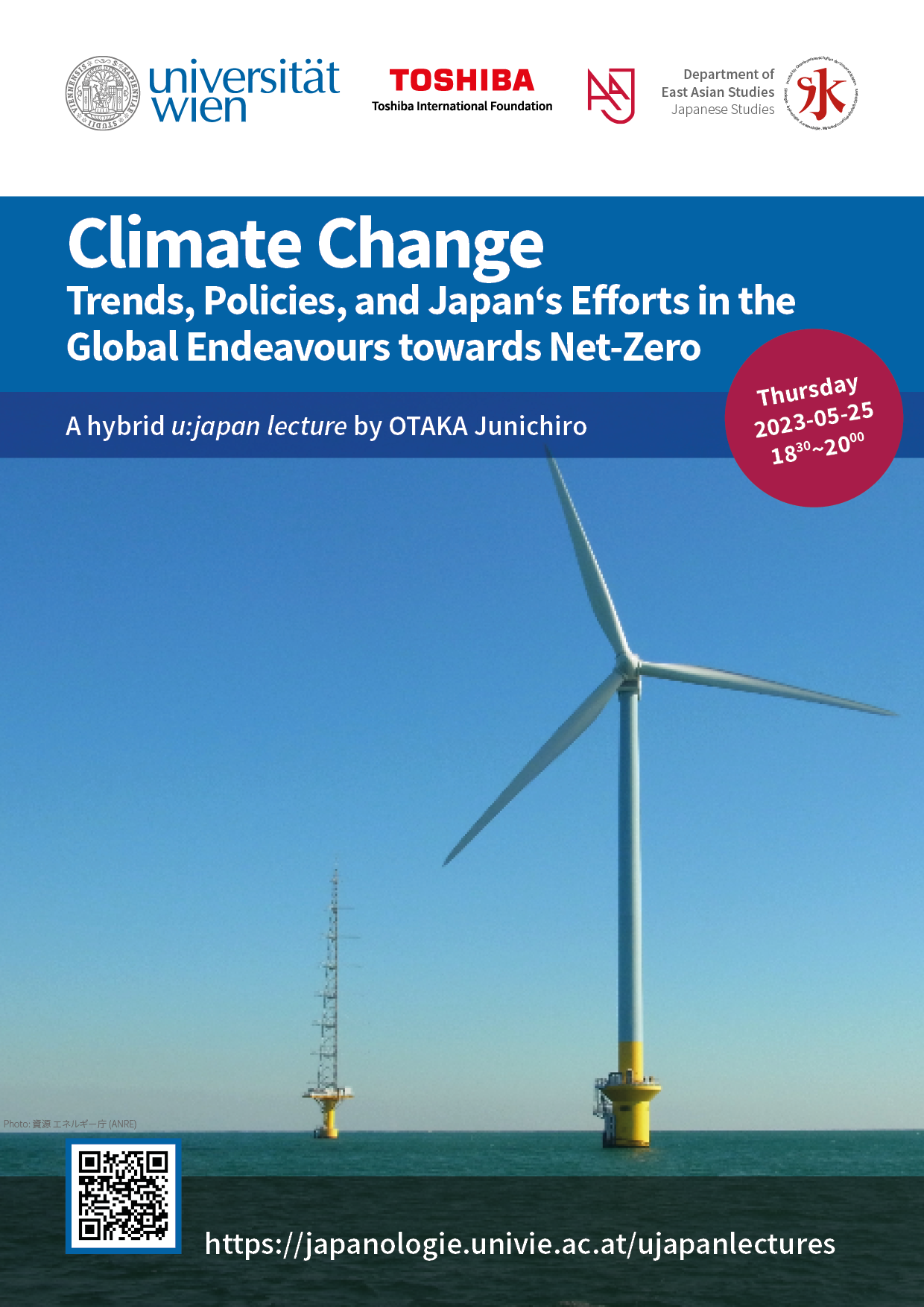 |
Season 6 | Spring 2023 | s06e10 | 25/05/2023 | en | Otaka Junichiro | Deputy Chief of Mission at the Embassy of Japan in Austria | Mr. OTAKA Junichiro (大髙準一郎) is Minister (Deputy Chief of Mission) at the Embassy of Japan in Austria since August 2022. He joined the Ministry of Foreign Affairs, Japan (MOFA) in 1995. Working in the foreign service for 28 years, his career has focused on the area of the development of multilateral rule-making in international fora, including those relating to the international environment, human rights, disarmament, chemical and biological weapons, conventional weapons, and non-proliferation. He has taken part in coordinating and negotiating processes in these sectors during his appointments in relevant departments in Tokyo and abroad. Most recently, Mr. Otaka was directly involved in the foreign policy concerning climate change as the Director of Climate Change Division in the Ministry of Foreign Affairs from 2020 to 2022. During this time, he attended the COP26 held in Glasgow as a core member of the Japanese Delegation. Mr. Otaka holds a BA in International Relations from the University of Tokyo as well as a MSc in European and International Politics from the University of Edinburgh and a Master of Laws from the University of Cambridge, respectively. | Climate Change: Trends, Policies, and Japan‘s Efforts in the Global Endeavours towards Net-Zero | In their recently published 6th Assessment Report in March 2023, the Intergovernmental Panel on Climate Change (IPCC) has painted a bleak climate future, stating that “continued greenhouse gas emissions will lead to increasing global warming, with the best estimate of reaching 1.5°C in the near term” (IPCC 2023:p12), further highlighting that climate change remains a crucial global issue that requires urgent attention and action from all countries. To address these issues, the international community has been developing several policies, mechanisms and multilateral agreements, such as The Paris Agreement, signed in 2015. However, achieving these goals requires significant efforts from all countries - particularly those with high levels of carbon emissions - while simultaneously having to balance the energy needs of developing and developed countries alike. Japan, as member of the international community, has been internationally committed to combat climate change, playing an active role in various international forums and initiatives and working to reconcile its national energy needs with international climate change needs. As former Director of Climate Change Division (2020-2022) at the Ministry of Foreign Affairs Japan, Otaka Junichiro gives unique insights on Japan’s engagement in international climate change cooperation and the country’s position on climate change policies while discussing current trends and examining the development of several multilateral climate change initiatives in this short lecture. | https://ustream.univie.ac.at/paella7/ui/watch.html?id=ed78d38b-9a09-4e5c-afe6-4f3fda926a15 | at | hybrid | https://japanologie.univie.ac.at/ujapanlectures/s06/#e10 | Political Science and Law | Has Video | ||||||||
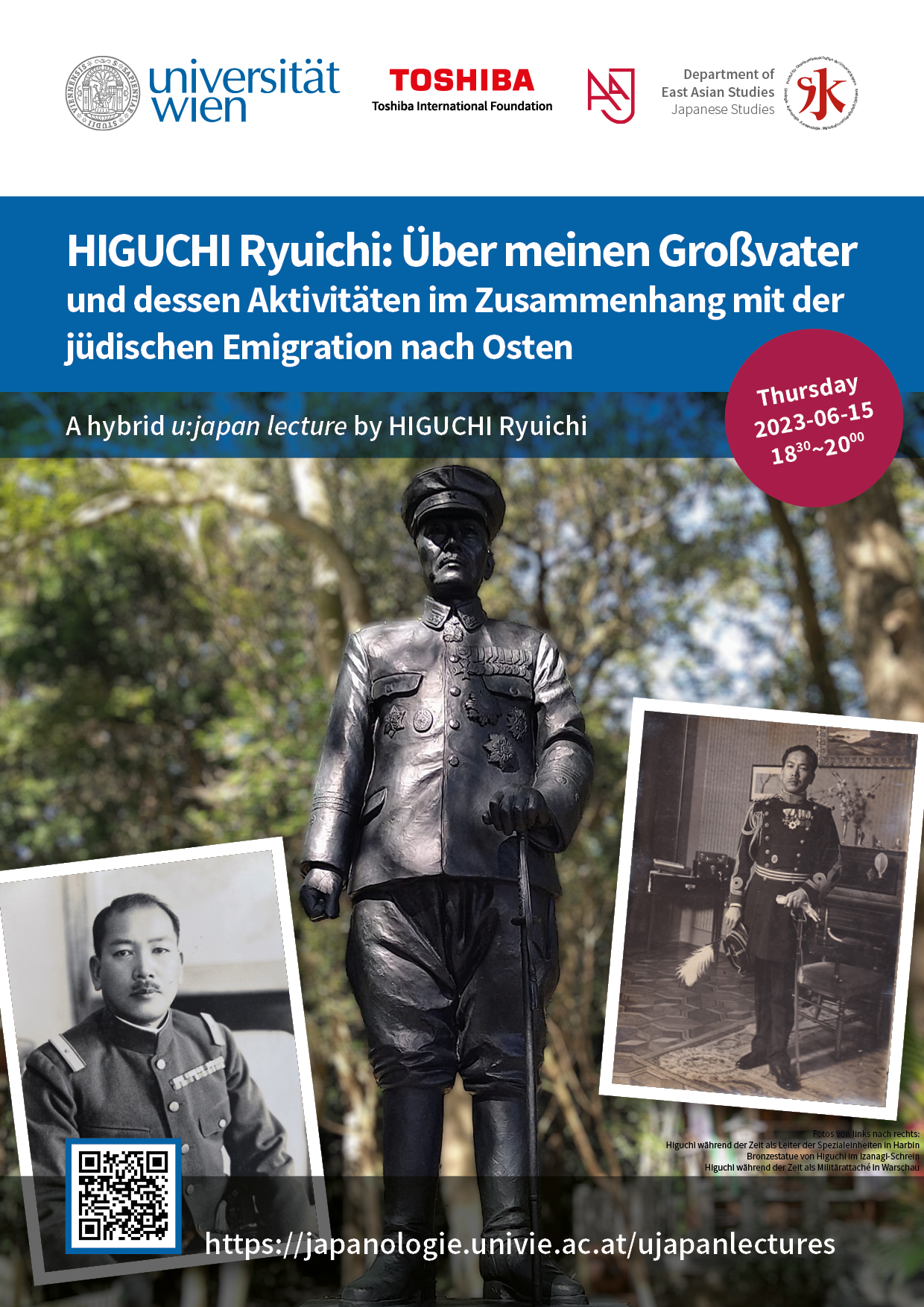 |
Season 6 | Spring 2023 | s06e12 | 15/06/2023 | de | Higuchi Ryuichi | Meiji Gakuin Universität | Higuchi Ryuichi (geb. 1946) ist ein renommierter Bach-Forscher und Dirigent in Japan und aktuell Professor Emeritus für Musikwissenschaft an der Meiji Gakuin Universität. Er ist auch bekannt als Enkel von Generalleutnant Kiichiro Higuchi, der sich für den freizügigen Transit jüdischer Flüchtlinge in Ostasien 1937-1941, einschließlich nach Mandschukuo, einsetzte. Sein Großvater gilt als Verteidiger von Hokkaido gegen die russische Aggression unter Stalin nach der Akzeptanz der Potsdamer Deklaration durch Japan im August 1945. Ryuichi Higuchi studierte an der Keio Universität in Tokio und besuchte 1972 das Bach-Archiv Leipzig, wo er die Grundlage für seine Bachforschung bei Werner Neumann schuf. 1974-79 studierte er als Stipendiat des DAADs bei Georg von Dadelsen in Tübingen und edierte im Rahmen seiner Dissertation sieben Kirchenkantaten J. S. Bachs (Neue Bach-Ausgabe I-34). Das Dirigieren erlernte er bei Alexander Sumski und wurde Chorleiter an der Marienkirche in Stuttgart. Seit seiner Rückkehr nach Japan ist er vielseitig tätig als Musikwissenschaftler, Dirigent und Kritiker für die Bach-Forschung in Japan. Im Jahr 2000 begründete er unter der Schirmherrschaft Helmut Rillings die Konzert-Vereinigung "Bach Akademie Meiji Gakuin Tokyo" mit eigenem Chor und Orchester auf Originalinstrumenten. In seiner Funktion als künstlerischer Leiter gab er viele Konzerte und verantwortete deren CD- Aufnahmen. Von 1985-1992 war er Generalsekretär der Alban Berg Gesellschaft Japan und seit 2022 ist er als deren Präsident tätig. 1998 war er Gastforscher des Musikwissenschaftlichen Instituts der Universität Wien und hielt u.a. den Vortrag „Die Japanischen Blätter Op.15 – Gottfried von Einems Beschäftigung mit Japan“ im Rahmen des Internationalen Einem-Kongresses der Gesellschaft der Musikfreunde in Wien. 2006 war er Gastforscher des Arnold Schönberg Centers Wien. 2012-17 war er als Vizepräsident der Internationalen Gesellschaft der Musikforschung, mit Sitz in Basel, tätig und realisierte deren Weltkongress 2017 in Tokio. 2015 wurde ihm vom Deutschen Akademischen Austauschdienst der Theodor-Berchem-Preis verliehen. Im Jahr 1988 erhielt er den Kioto-Musikpreis und wurde 2002 mit dem Österreichischen Ehrenkreuz für Kunst und Wissenschaft ausgezeichnet. Nachdem er 2018 Gastvorträge über seinen Großvater in Jerusalem und Tel Aviv auf Einladung der dortigen Japanischen Botschaft gehalten hatte, wurde er wiederholt zu Vorträgen in verschiedenen Städten Japans eingeladen. Außerdem publizierte er die beiden Bücher Kiichiro Higuchis Nachlässe – ein General, der die jüdischen Flüchtlinge und Hokkaido rettete (陸軍中将樋口季一郎の遺訓 ユダヤ難民と北海道を救った将軍), 532 Seiten, Bensei Shuppan, 2020 und Kiichiro Higuchis Memoir(陸軍中将樋口季一郎回想録), revidierte Neuausgabe, Japanisch, 723 Seiten, Keibunsha Shobo, 2022. | Higuchi Ryuichi: "Über meinen Großvater und dessen Aktivitäten im Zusammenhang mit der jüdischen Emigration nach Osten" | S.E. MIZUUCHI Ryuta, außerordentlicher und bevollmächtigter Botschafter von Japan in Österreich wird zunächst einen kurzen Überblick über den Hintergrund der Judenpolitik der japanischen Regierung vor dem zweiten Weltkrieg und die Fakten zur Rolle Higuchi Kiichiros geben, bevor es zum Vortrag von Prof. Higuchi übergeht. Am 11. Oktober 2022 wurde eine Statue meines Großvaters Kiichiro Higuchi im Izanagi Schrein (伊弉諾神宮) auf der Insel Awajishima (淡路島) enthüllt. In jüngster Zeit wird er in Japan als Retter der jüdischen Flüchtlinge in der Mandschurei vor dem letzten Krieg und als Verteidiger von Hokkaido gegen die ungerechtfertigte Invasion der Sowjetischen Armee nach dem Kriegsende 1945 verehrt. Kiichiro Higuchi wurde 1888 auf der Insel Awajishima geboren. Nach den beiden Kriegen gegen China (1894-96) und Russland (1904-05) entschied er sich spontan, eine militärische Laufbahn einzuschlagen. Nach dem Abschluss der Kriegsschule und Militärakademie wurde er zum Offizier für Nachrichtenwesen. Im Zuge der Sibirischen Intervention (1918-22) wurde er nach Wladiwostok entsandt und wohnte bei einer jüdischen Familie, durch die er die tragische Geschichte der Juden kennenlernte. 1925-28 war er als Militärattaché in Warschau tätig, wo er seine Kenntnisse nicht nur über die politische Lage innerhalb Europas, sondern auch die damalige Situation der jüdischen Bevölkerung vertiefte. 1937 entsandte ihn der Generalstab für kurze Zeit nach Berlin, um die Politik des Dritten Reichs kritisch zu untersuchen. Infolge des Ausbruchs des japanisch-chinesischen Krieges wurde er nach Tokio abberufen und anschließend als Leiter der “Spezialeinheiten” (Anm: des Nachrichtendienstes) nach Harbin in der damaligen Mandschurei geschickt, das als Zentrum der jüdischen Gemeinde im Fernen Osten galt. Es war vermutlich die Freundschaft mit deren Vorsitzenden, Dr. Abraham Kaufman, die ihn veranlasste, in Folge eine judenfreundliche Politik vorerst in der Mandschurei und dann innerhalb der japanischen Regierung zu etablieren. Einem heftigen Protest Deutschlands gegen das japanische Außenministerium und den Generalstab wegen seiner pro-jüdischen Ansprache beim ersten jüdischen Kongress im Fernen Osten 1937 folgte seine Abberufung nach Tokio, wo er zum Leiter der 2. Sektion des Generalstabs befördert wurde. In dieser Funktion gelang es ihm im Hintergrund, den “Fünf-Minister-Beschluss“, Grundprinzipien der damaligen Judenpolitik Japans, Ende 1938 unter dem Heeresminister Seishiro Itagaki zugunsten der Juden zu verfassen und infolgedessen mehreren tausenden aus dem Dritten Reich fliehenden jüdischen Flüchtlingen den Weg in die Freiheit zu verschaffen. Prof. Meron Medzini der Hebrew Universität schreibt in seinem Buch, „Under the Shadow of the Rising Sun. Japan and the Jews during the Holocaust Era”, Boston 2016: “ in the empire the Japanese created beginning in 1931 (Anm: Kaiserreich Mandschukuo), numbering a total of some thirty-five to forty thousand Jews who were lucky compared to their brethren who were extermised in Europe”. | https://ustream.univie.ac.at/paella7/ui/watch.html?id=d74466f3-7aa9-4402-9439-bbf70478b841 | jp | hybrid | https://japanologie.univie.ac.at/ujapanlectures/s06/#e12 | History and Archaeology | Has Video | ||||||||
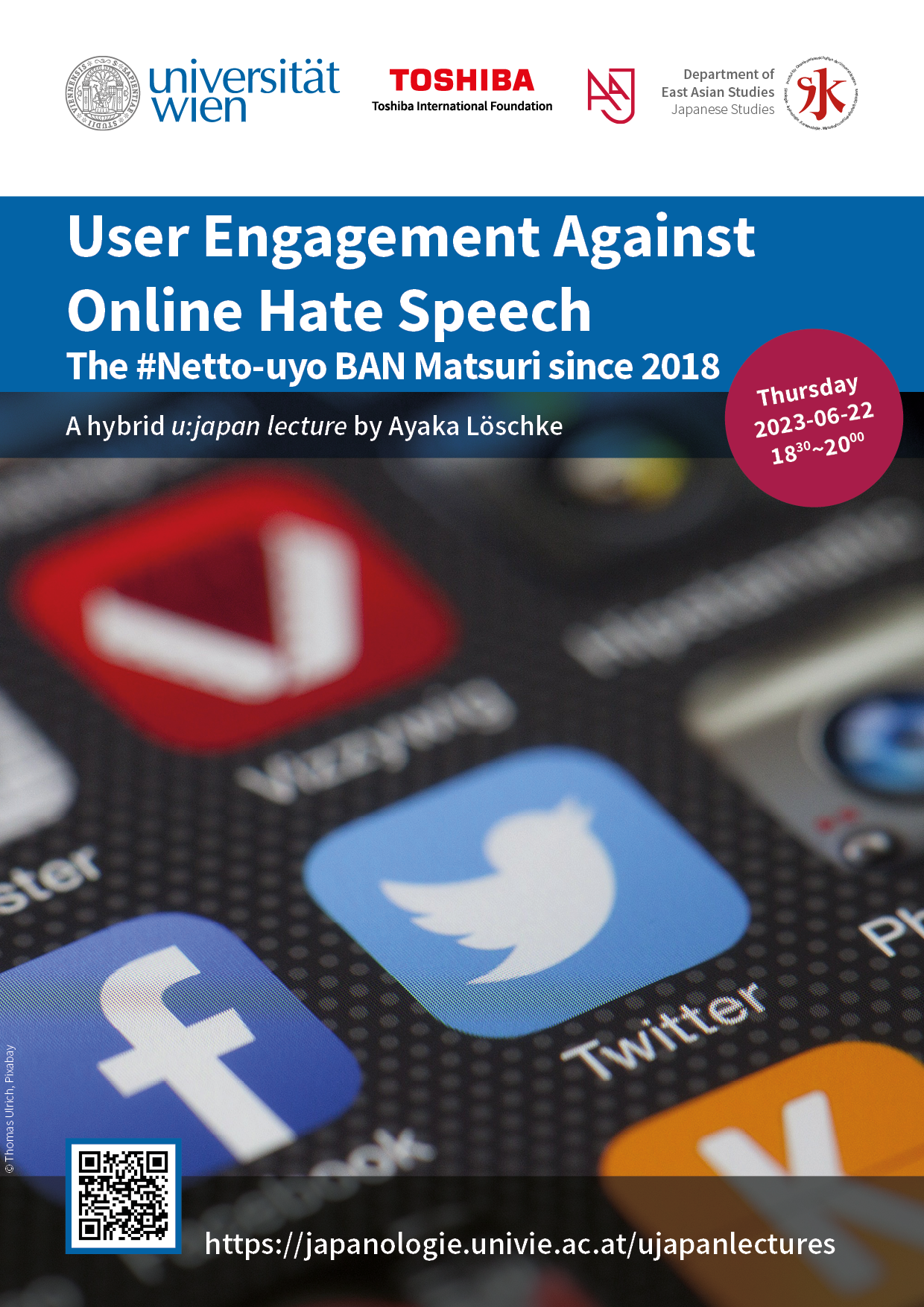 |
Season 6 | Spring 2023 | s06e13 | 22/06/2023 | en | Ayaka Löschke | FAU Erlangen-Nürnberg | Ayaka Löschke (ayaka.loeschke@fau.de) is a Junior Professor of Japanese Studies at the University of Erlangen-Nuremberg since 2019. She holds an MA in Philosophy from Sophia University in Tokyo (2008), a second MA in Philosophy from the University of Bonn (2012). In 2013, she changed her major from philosophy to social scientific Japanese studies. She obtained a PhD in Japanese Studies from the University of Zurich in 2018. Her research fields encompass Japanese politics, civil society, and social movements, with a specific focus on the regulation of hate speech in Japan (ongoing project) and the legacies of post-Fukushima activism aimed at protecting people from radiation (dissertation project). | User Engagement Against Online Hate Speech: The #Netto-uyo BAN Matsuri since 2018 | The social media industry, despite its vast membership, has experienced a significant decline in advertisement revenue since 2022, leading to mass layoffs. These cutbacks have also affected content moderators responsible for regulating hateful content. In this situation, user engagement becomes an indispensable part of content moderation, particularly in addressing online hate speech. This guest lecture focuses on Japanese internet users who have taken on the challenging task of systematically reporting online hate speech and other forms of hateful content to social media companies. It addresses two questions: (1) What types of users participate in such user engagement? (2) What motivates and sustains Twitter users in their engagement? To address these questions, the #Internet Rightists Ban Festival (Netto-uyo Ban Matsuri) is selected as the Japanese case study. Launched in May 2018, this collective action has continued to the present day, resulting in the removal of over 990,800 videos and 4,000 channels from YouTube, as well as the deletion of more than 270 million tweets and 11,000 accounts from Twitter. The lecture will begin by providing background information on the Japanese case study, including the Japanese internet culture, which is marked by cynicism and gamification, and the analytical framework offered by the German case study since 2016 (#ichbinhier). In the main part, the lecture will present the results of a qualitative content analysis of 3,821 tweets posted in 2018 and 2020, examining three determinants of user engagement against hateful content proposed by scholars specializing in the German case study. The lecture argues that Japanese user engagement has been driven particularly by the perception of personal abilities, including gaming and comment-writing skills, as well as the perception of personal benefits, especially derived from gamification and irony. | https://ustream.univie.ac.at/paella7/ui/watch.html?id=2dcd2fb8-b165-42fc-8fa5-f56b224db9de | de | hybrid | https://japanologie.univie.ac.at/ujapanlectures/s06/#e13 | Welche Benutzer:innen gehen online gegen Hassrede (hate speech) vor? Was motiviert aktive Benutzer:innen ihren digitalen Aktivismus zu verfolgen? | Science and Technology Studies (STS) and Digital Humanities, Political Science and Law, Sociology and Social Sciences | Inductive qualitative text analysis | Digitaler Aktivismus, Hassrede (hate speech) | Tweets, Youtube Kommentare | Hall, Jeffrey J. 2021. Japan's Nationalist Right in the Internet Age: Online Media and Grassroots Conservative Activism. New York und London: Routledge. | Has Video, Has classroom material | |||
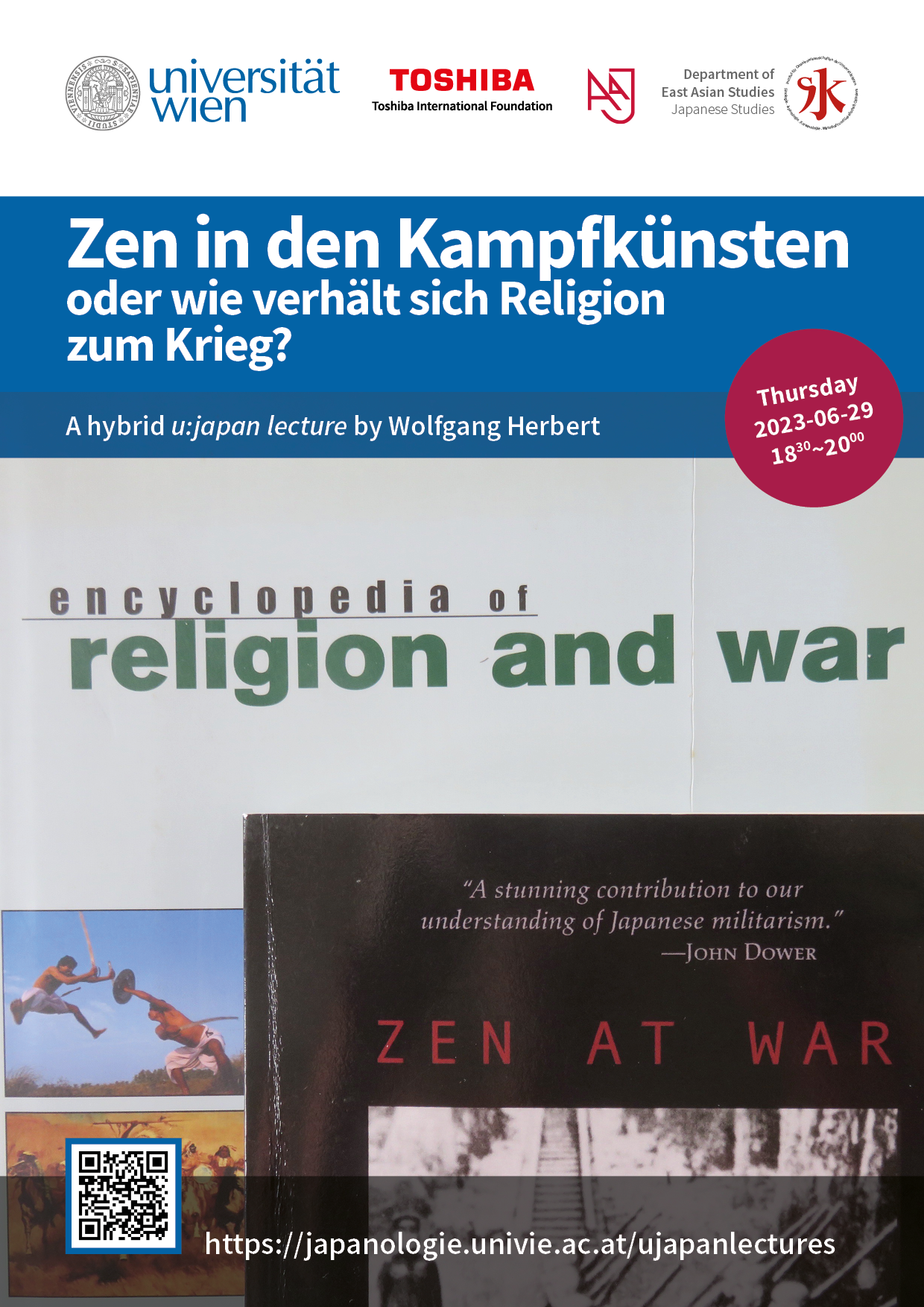 |
Season 6 | Spring 2023 | s06e14 | 29/06/2023 | de | Wolfgang Herbert | Tokushima University | Dr. Wolfgang Herbert, Studium der Japanologie, Philosophie und Religionswissenschaften an der Universität Wien, Professor für Vergleichende Kulturwissenschaften an der Universität Tokushima, 6. Dan Shotokan Karate-dô; Autor des Buches: Buddha, Zen und Achtsamkeit. Eine kurze Geschichte des Buddhismus im deutschen Sprachraum. Essen: Oldib 2012, und des Artikels „Was hat Bodhidharma im Karate-dōjō verloren?“ in OAG Notizen 2019/05 (https://oag.jp/img/2019/05/Notizen-1905_Bodhidharma.korr_.pdf). | Zen in den Kampfkünsten, oder wie verhält sich Religion zum Krieg? | Was hat das Zen, verwurzelt in einer Religion, deren höchstes Gebot das Nicht-Töten, ja Nicht-Verletzen lebender Wesen ist, mit den Kriegskünsten zu schaffen? „Mind Fitness Training“ basierend auf mindfulness (urbuddhistisches Achtsamkeitstraining) wird vom US-Militär praktiziert, um mit erhöhter Aufmerksamkeit Drohnen zu steuern oder Feuerwaffen zu bedienen. Hat das mit der Lehre des Buddha noch irgendetwas zu tun? Kann es analog aus christlicher Sicht einen heiligen oder auch nur gerechten Krieg geben, wenn man die fundamental pazifistische Bergpredigt ernst nimmt? Am Beispiel des Zen-Buddhismus möchte der Referent diesen Ambivalenzen nachgehen. Schon der erste Patriarch des Zen in China, Bodhidharma, wird der Legende nach mit der Entwicklung einer Faustkampfmethode in Verbindung gebracht. Als Zen im frühen Mittelalter nach Japan kam, geriet es unter die Patronanz der zu politischer Macht aufgestiegenen Kriegerkaste (der bushi, vulgo Samurai). Das rigorose Geistestraining und Detachment des Zen wurde in die Kunst des ungerührten Tötens integriert. Auf die Schriften berühmter Schwertkämpfer beriefen sich auch Zen-Priester, die in den von Japan im 20. Jh. geführten Kriegen ideologische Beihilfe geleistet haben. Ihre verkorksten Legitimationen des Tötens in der Schlacht sollen analysiert werden. Handelt es sich um perverse Verdrehungen der Lehre oder sind Zweckentfremdungen dieser Art dem Zen inhärent, wenn es auf eine reine Psychotechnik reduziert und seiner ethischen Grundlagen beraubt wird? Anhand historischer und gegenwärtiger Beispiele sollen diesbezügliche Sondierungen vorgetragen werden. Die Anrufung höherer Mächte oder der Einsatz spiritueller Fähigkeiten bei der Mobilisierung zum Krieg dürften seit Anbeginn der Geschichte der Menschheit eine Rolle gespielt haben und können starke emotionale und motivationale Kräfte wecken. Den möglichen Tod vor Augen habend, eröffnet sich ein Nexus zur Transzendenz wie von selbst. Da kann dann (jede) Religion umstandslos für martialische Ziele instrumentalisiert werden und wird es auch – quod erat demonstrandum. | https://ustream.univie.ac.at/paella7/ui/watch.html?id=f2092289-fda9-453c-822b-351b43e71fc8 | jp | hybrid | https://japanologie.univie.ac.at/ujapanlectures/s06/#e14 | Religion and Philosophy, History and Archaeology | Has Video | ||||||||
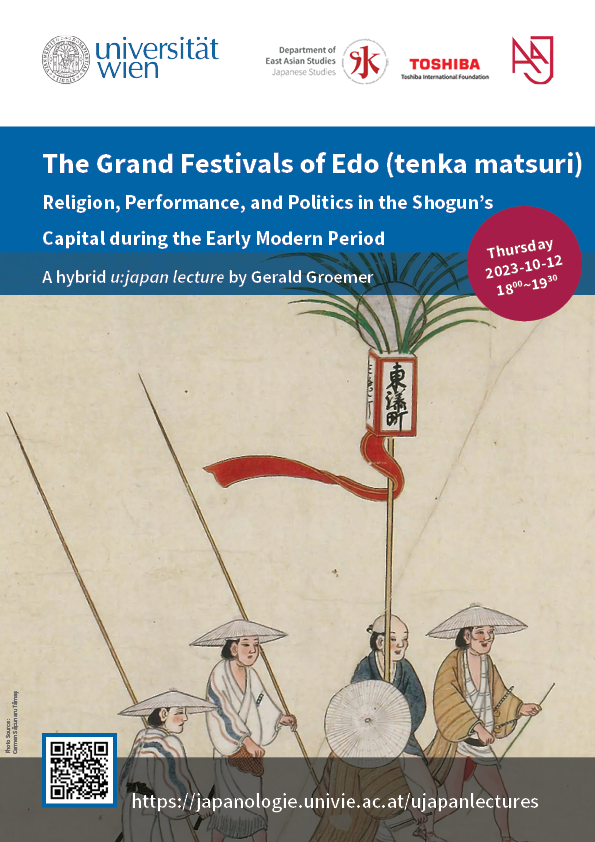 |
Season 7 | Autumn-Winter 2023/24 | s07e01 | 12/10/2023 | de | Gerald Groemer | University of Yamanashi | Gerald Grömer, geboren in 1957 in den USA, studierte Klavier an der Peabody Institute of Music in Baltimore und Musikwissenschaft an der Tokyo University of Fine Arts and Music. Von 1998 bis 2023 war er Professor an der University of Yamanshi in Kōfu (Japan), seit Sommer 2023 wohnt er in Wien. Viele seiner Zahlreichen Bücher und anderen Veröffentlichungen beschäftigen sich mit japanischen Strassenkünstlern und blinde Musikerinnen der Frühmoderne. Seit 2016 erschienen auch drei Bände von Übersetzungen von japanischen Essays (zuihitsu) der Edo Zeit (1600-1868). | The Grand Festivals of Edo (tenka matsuri): Religion, Performance, and Politics in the Shogun's Capital during the Early Modern Period | During the Edo period (1600-1868), several great festivals honoring the Tokugawa bakufu were staged in Edo in an annual rotation. These were the Sannō Festival, the Kanda Festival, and in 1714 the Nezu Festival. Each event was accompanied by an enormous parade, in which the three sponsoring shrines and supporting city wards presented portable shrines, huge floats, colorful exhibits, exuberant performances of music and dance, and much else. For the bakufu, the shrines, and ward residents the meaning of these festivals changed in conjunction with the social, economic, political, and religious contexts in which the celebrations were embedded. This talk will trace some of these changes in order better to understand what the great festivals of the city signified to sponsors, participants, and spectators alike. | jp | on site | https://japanologie.univie.ac.at/ujapanlectures/s07/#e01 | Religion and Philosophy, History and Archaeology, Political Science and Law | ||||||||||
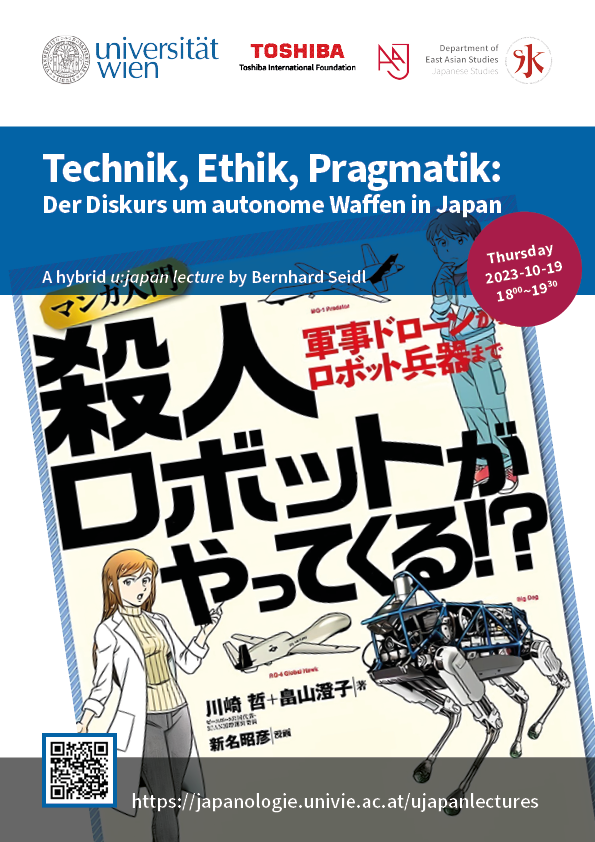 |
Season 7 | Autumn-Winter 2023/24 | s07e02 | 19/10/2023 | de | Bernhard Seidl | University of Vienna | Dr. Bernhard Seidl ist Senior Lecturer am Institut für Ostasienwissenschaften der Universität Wien. Er interessiert sich insbesondere für die Dynamik gesellschaftlicher Diskurse im gegenwärtigen Japan, deren Struktur, Akteure und sprachliche Handlungsmuster er über korpuslinguistische Methodik zu erschließen versucht. | Technik, Ethik, Pragmatik: Der Diskurs um autonome Waffen in Japan | KI-gesteuerte Waffensysteme ([Lethal] Autonomous Weapons, [L]AWS), werden oft als "dritte Revolution in der Kriegstechnologie" bezeichnet. Doch während Forscher*innen und Intellektuelle mahnen, dass das Urteil über ein Menschenleben niemals einem Roboter überlassen werden dürfe und im Rahmen der UN-Waffenkonvention bisher ohne viel Erfolg über Regulierungen oder Verbote von LAWS verhandelt wird, verschwimmen zunehmend auch die Grenzen zwischen militärischer und ziviler Technik angesichts selbstfahrender Autos, breit zugänglicher KI-Assistenten und ziviler Drohnen. Diese vielschichtige Debatte, die von technischen Möglichkeiten, ethischen Bedenken und pragmatischen Abwägungen geprägt ist, wird auch in Japan geführt. In der Tat ist Japan ein spannendes Beispiel für einen Diskurs über solche neuen militärische Technologien: Wie schließlich geht ein Land mit dieser "dritten Revolution" um, dessen in der Verfassung verankerter Verzicht auf das Recht, Krieg zu führen und reguläre Streitkräfte zu unterhalten, integraler Bestandteil seiner pazifistisch geprägten Sicherheitsidentität ist? Und inwiefern spielt die Roboter- und Technikaffinität, die sich häufig in Japanbildern findet, eine Rolle? In Annäherung an eine Antwort auf diese Fragen werden im Vortrag mehrere Diskursebenen (Politik, Forschung, NGOs, Tagespresse) betrachtet und ihre Verflechtungen auf inhaltlicher, sprachlich-symbolischer und auch personeller Ebene erörtert. | https://ustream.univie.ac.at/paella7/ui/watch.html?id=1232f554-0196-4039-9498-1e1545c57898 | at | hybrid | https://japanologie.univie.ac.at/ujapanlectures/s07/#e02 | Science and Technology Studies (STS) and Digital Humanities, Linguistics and Language Education | Has Video | ||||||||
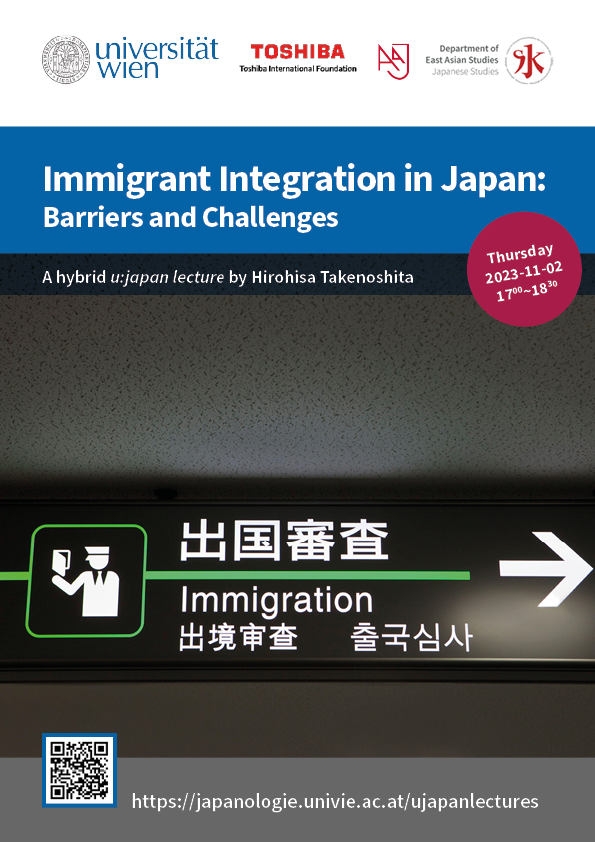 |
Season 7 | Autumn-Winter 2023/24 | s07e03 | 02/11/2023 | en | Hirohisa Takenoshita | Keio University | Hirohisa Takenoshita is a professor of sociology and stratification research at the Department of Political Science, Keio University. Before joining Keio University, he worked at Shizuoka University and Sophia University. He published several journal articles and book chapters. These articles were published in the Journal of Ethnic and Migration Studies, International Migration, Journal of International Migration and Integration, Comparative Social Research, Japanese Journal of Sociology, and Sociological Theory and Methods. Book chapters were published in Routledge, Springer, Palgrave Macmillan, and Trans Pacific Press. | Immigrant Integration in Japan: Barriers and Challenges | This lecture discusses immigrant integration in Japan. It focuses on economic and psychological integration. We also explore social and cultural integrations as predictors for economic and psychological integrations. Hence, we investigate integration from different angles and what hinders the integration of immigrants in Japan. We discuss the characteristics of the contexts under which immigrants are received in Japan. This discussion includes immigration control policies, labor market structures, and ethnic communities. To examine immigrant integration in Japan, we use the statistical data derived from the nationally representative survey targeting immigrants in 2018. To consider economic integration, we focus on the role of education and labor market segmentation in shaping logged hourly wages. For the study of psychological integration, we observe mental health and intentions to settle or return. | https://ustream.univie.ac.at/paella7/ui/watch.html?id=e2f66957-9cd8-4afb-bd05-6cb2e8921920 | jp | hybrid | https://japanologie.univie.ac.at/ujapanlectures/s07/#e03 | Political Science and Law, Sociology and Social Sciences, Gender Studies and Minority Studies | Has Video | ||||||||
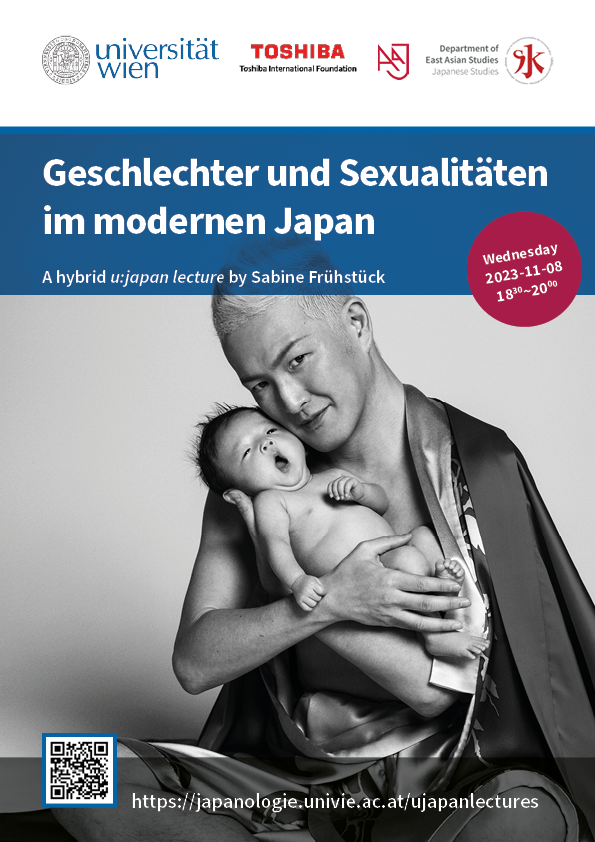 |
Season 7 | Autumn-Winter 2023/24 | s07e04 | 08/11/2023 | de | Sabine Frühstück | University of California, Santa Barbara | Sabine Frühstück ist Professorin und der Koichi Takashima Chair für japanische Kulturwissenschaften an der University of California Santa Barbara. Sie interessiert sich für Japans Moderne und Gegenwart im globalen Kontext, schreibt manchmal über die Konventionen wissenschaftlicher Arbeit und stellt gerne die Grenzen nationaler, kultureller und disziplinärer Ordnung in Frage. Im vergangenen Jahr erschienen u.a. ihr Buch Gender and Sexuality in Modern Japan (Cambridge UP) sowie die russische Übersetzung ihres Buches Uneasy Warriors: Gender, Memory, and Popular Culture in the Japanese Army [Тревожные воины. Гендер, память и поп-культура в японской армии]und die japanische Übersetzung ihres Buches Playing War: Children and the Paradoxes of Militarism in Modern Japan [『「戦争ごっこ」の近現代史—児童文化と軍事思想』]. | Geschlechter und Sexualitäten im modernen Japan | Wohl eher unerwartet war das Jahr 2023 von breiten öffentlichen Debatten geprägt, die alte Fragen von Gender und Sexualität neu in den Blick nahmen. Unter anderem haben sich AktivistInnen, das Rechtssystem, und die Politik mit transgender Operationen als Voraussetzung für einen rechtlichen Geschlechtswechsel, der Zustimmung des Partners für eine sichere Abtreibung, der Legalisierung der gleichgeschlechtlichen Ehe, und der Anerkennung der Vergewaltigung ohne Gewaltanwendungsnachweis auseinandergesetzt. Der Vortrag nimmt diese Debatten zum Anlass, die Geschichte der Geschlechter und Sexualitäten im modernen Japan zu reflektieren. | https://ustream.univie.ac.at/paella7/ui/watch.html?id=ad3de5e5-7945-4bb8-bdf8-c4e22a9b49f0 | usa | hybrid | https://japanologie.univie.ac.at/ujapanlectures/s07/#e04 | Gender Studies and Minority Studies, Sociology and Social Sciences | Has Video | ||||||||
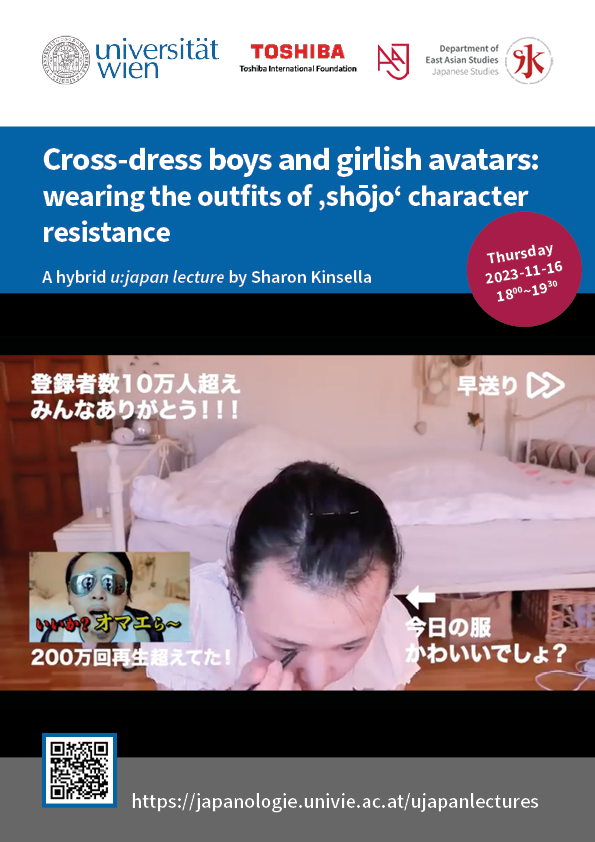 |
Season 7 | Autumn-Winter 2023/24 | s07e05 | 16/11/2023 | en | Sharon Kinsella | University of Manchester | Sharon Kinsella's earlier work looked at cuteness and infantilism as rebellion; the educational and class factors behind the institutional and commercial transformation of manga for adults in the 1990s; otaku subculture and Lolita complex subcultures. Sharon's second full-length book, Schoolgirls, Money and Rebellion in Japan (2014) incorporates research on girls' street styles and male journalism and an examination of the 'cult of girls' in the late 1990s to the 2010s. Sharon's most recent research focus has been on the rise of female cross dress amongst younger men in the 2010s. In this research phase she has written 3 articles and made a collaborative film, Josō, exploring the political-economic and social class factors surrounding cross-dress fashion and cuteness for men (otoko no ko) in Tokyo. | Cross-dress boys and girlish avatars: wearing the outfits of 'shōjo' characters to become non-binary and refuse social and gender categories | As the final decade of pre-online mediated street culture came to an end in the early 2000s, curated interest in girls' fashions, culture and postures of defiance vanished along with street fashion and public subculture in its last stand. What arose and has taken attention in the twenty first century have been various animation, ero ge-mu, and boys' screen and bedroom cultures which have picked up and run the theme of defiance from schoolgirl actors in the media gaze of the 1990s to early 2000s. In this lecture we will explore the combatative girl character in cross-dressed male parody of real girls, cross-dressed play and virtual shōjo avatar livestreaming. This paper will explore the transfer of bombastic girls' street style into boys parodic cross-dressing, and the re-assemblage of girls' cute aesthetics as a form of masculine virtual style and some of the underlying context for these riveting performances in social class and gender rearrangements in the late recessionary period of the 2000s. | https://ustream.univie.ac.at/paella7/ui/watch.html?id=213f31d1-ae11-4846-8fa3-43e49b3a671e | uk | hybrid | https://japanologie.univie.ac.at/ujapanlectures/s07/#e05 | Gender Studies and Minority Studies, Sociology and Social Sciences | Has Video | ||||||||
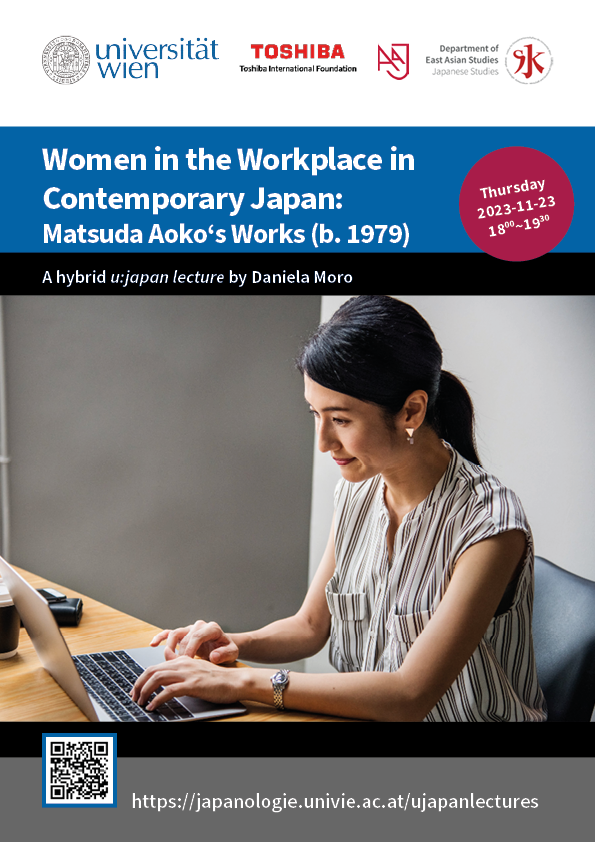 |
Season 7 | Autumn-Winter 2023/24 | s07e06 | 23/11/2023 | en | Daniela Moro | Università di Torino | Daniela Moro received her Master's Degree from Waseda University in Tokyo and her Ph.D. from Ca' Foscari University of Venice, with a thesis on the works of Enchi Fumiko that was later published as a monograph. She is currently Associate Professor in Japanese Studies in the Department of Humanities at the University of Turin. She is interested in the relationship between Japanese literature and feminist, gender and queer studies. In particular, she focuses on female writers working between the 1960s and the 1980s, but she also looks at contemporary writers. Recently she has published an article on Matsuda Aoko's work (2023): "A silent fight to challenge the norm in Matsuda Aoko's 'Sutakkingu Kanō' (2012)", Japan Forum, 35:4, 410-43. DOI: 10.1080/09555803.2023.2248156 | Women in the Workplace in Contemporary Japan: Matsuda Aoko's Works (b. 1979) | In Matsuda Aoko‘s creations, she weaves together traditional feminist themes like gender roles, women in the workplace, marriage, and maternity with more modern discussions on gender identity, sex, and sexuality. Her works often unfold against the backdrop of contemporary Japan, particularly in work settings, shedding light on stories involving gender-based violence and inequalities like sexual harassment, sexism, and abuses of power. This lecture focuses on some of the most representative works by the author and their theoretical impact. We examine to what extent they challenge gender normativity and reflect on the preponderant use of devices like metamorphosis, irony and repetition and their different outcomes. We also see how her works, which are generally focused on women‘s characters, in reality reveal an urge for men too to set themselves free from established roles. | https://ustream.univie.ac.at/paella7/ui/watch.html?id=2fa3bfdf-960b-43a0-8012-1abffccb6405 | it | hybrid | https://japanologie.univie.ac.at/ujapanlectures/s07/#e06 | Gender Studies and Minority Studies, Literature and Media Studies | Has Video | ||||||||
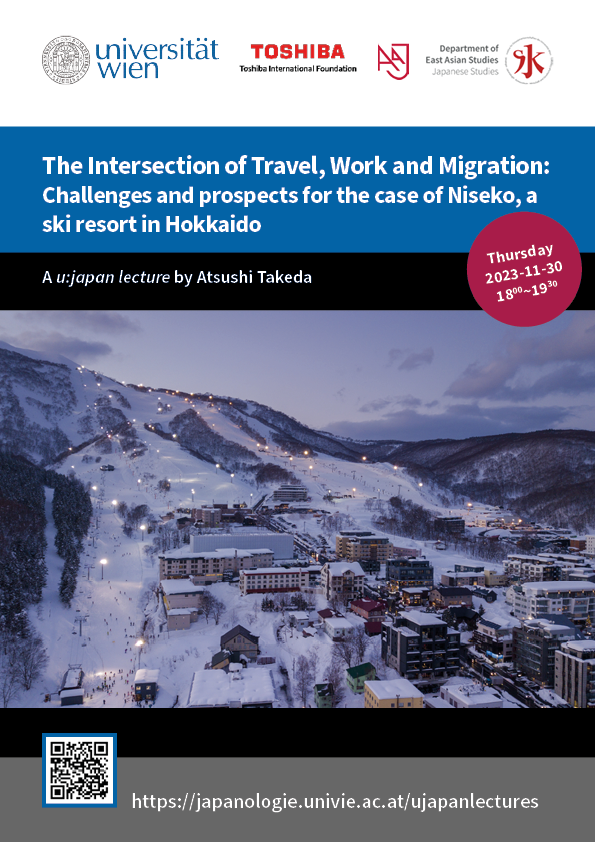 |
Season 7 | Autumn-Winter 2023/24 | s07e07 | 30/11/2023 | en | Atsushi Takeda | Ritsumeikan University | Atsushi Takeda is a Professor at Ritsumeikan University’s College of Social Sciences in Japan. His research interests include international mobility, migration, tourism, transnationalism, and popular culture. He has published book chapters and peer-reviewed articles on these topics in various journals, including Sociology Compass, International Journal of Social Research Methodology, Asian Anthropology, Studies in Ethnicity and Nationalism, and International Journal of Intercultural Relations. Additionally, he serves as an editorial board member for Qualitative Research and the Romanian Journal of Sociological Studies. | The Intersection of Travel, Work and Migration: Challenges and Prospects for the case of Niseko, a ski resort in Hokkaido | After the peak of the ski boom in Japan during the 1990s, many ski resorts either retrenched or ceased operations. However, Niseko, one of the ski resorts in Hokkaido, was an exception. Since 2001, Niseko has been attracting international tourists, particularly from Australia, and has even been referred to as “Little Australia.” As a result, the area has taken on a more Western atmosphere, complete with English signage, Western-style restaurants, and cafes. The influx of international tourists to Niseko has also created a demand for foreign workers to accommodate guests. During the ski season, a large number of temporary workers come to Niseko to work in the tourism sector. While this is temporary mobility, as they are employed seasonally, there are also people who migrate to Niseko, attracted by the lifestyle. This lecture examines the flow of people to Niseko and its impact on the community, highlighting the voices of local residents. | jp | on site | https://japanologie.univie.ac.at/ujapanlectures/s07/#e07 | Sociology and Social Sciences, Economics and Business Studies, Agriculture and Rural Studies | ||||||||||
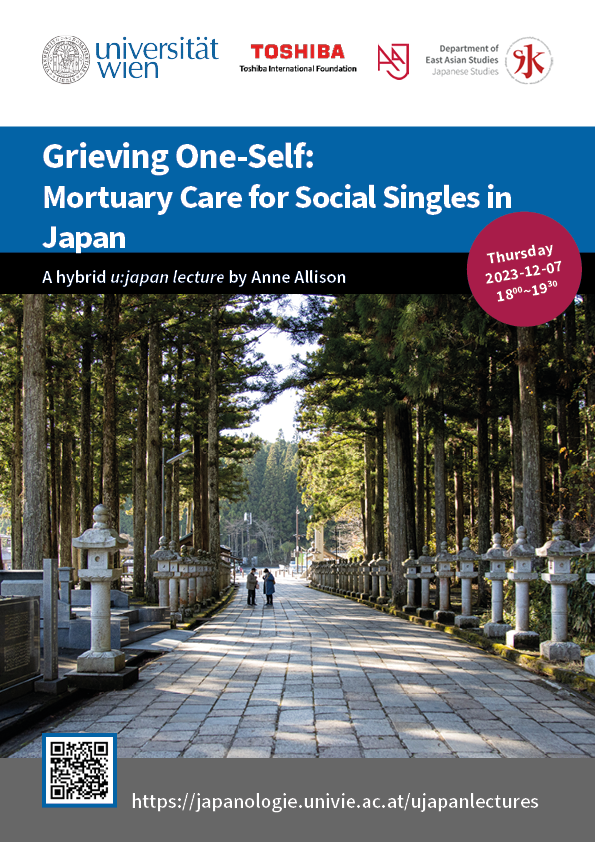 |
Season 7 | Autumn-Winter 2023/24 | s07e08 | 07/12/2023 | en | Anne Allison | Duke University | Anne Allison is Professor of Cultural Anthropology at Duke University, United States. A specialist in contemporary Japan, her books include Nightwork: Sexuality, Pleasure, and Corporate Masculinity in a Tokyo Hostess Club (1994), Millennial Monsters: Japanese Toys and the Global Imagination (2006), and Precarious Japan (2013). Published this year is Being Dead Otherwise on new Japanese practices regarding the dead, and the relations between self and other in caregiving them. | Grieving One-self: Mortuary Care for Social Singles in Japan | In the face of socio-economic shifts—a high aging/low childbirth population, decline in marriage and co-residence, irregularization of labor —the family model of mortuary care that once prevailed in Japan is coming undone. As more and more Japanese live and die alone, they face the prospect of becoming “disconnected dead:” stranded without a grave nor social others to be tended by once there. Given the specter of such a bad death, new designs and trends are emerging for both necro-habitation and care-giving the dead. Prominent here is making mortuary arrangements for and by oneself while still alive (seizen seiri). Such anticipatory death-planning is the issue taken up in this talk. Based on fieldwork with new initiatives and services catering to a clientele of aging singles in Japanese, it is asked: What kind of grievability is this when the sociality of being cared for by others is handled by the self in anticipation of death? Mortuary presentism; a new ontology of the dead? | https://ustream.univie.ac.at/paella7/ui/watch.html?id=b902dd30-0507-444b-9f58-480b0d996347 | usa | hybrid | https://japanologie.univie.ac.at/ujapanlectures/s07/#e08 | Religion and Philosophy, Sociology and Social Sciences | Has Video | ||||||||
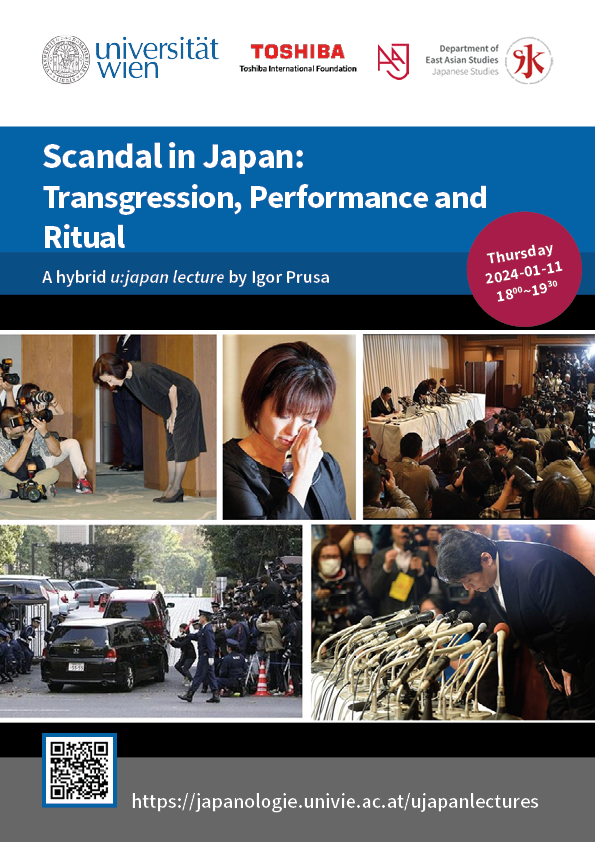 |
Season 7 | Autumn-Winter 2023/24 | s07e09 | 11/01/2024 | en | Igor Prusa | Ambis University, CZ | Mgr. Igor Prusa, Ph.D. et Ph.D. is a Czech scholar in Japanese studies and media studies, currently affiliated with Ambis University, Prague. He worked at the Czech Academy of Sciences. Prusa received his first PhD in media studies at Prague’s Charles University in 2010. In 2017 he defended his second doctoral thesis at the University of Tokyo. His research interests include contemporary Japanese society, media scandals, and anti-heroism in popular fiction. His research has appeared in a wide range of publications, including Media, Culture & Society and Japan Forum. Apart from his academic activities, Igor Prusa is a music composer in a Japan-themed band, Nantokanaru. | Scandal in Japan: Transgression, Performance, and Ritual | This talk is an exploration of media scandals in contemporary Japanese society. In shedding new light on the study of scandal in Japan, the talk offers a novel view of scandal as a highly mediatized “ritual” which manifests and manages revealed transgressions throughout Japanese history. The first part of the talk focuses on Japanese scandal as “media product”, and it delves into the media's role in constructing, shaping, and distributing scandals in Japan. Here, Igor Prusa explicates the role of Japanese media organizations in a symbolic process of transforming leaked gossip into a full-fledged scandal. The second part of the talk approaches Japanese scandal as “social ritual”. It explores the performative nature of scandal, highlighting how the scandal actors become characters in a larger social drama. Further, it demonstrates how the social drama of confession, exclusion and reintegration is turned into a spectacular media event with a high degree of ritualization. | https://ustream.univie.ac.at/play/97a0dcb3-a3d5-4c84-b21c-b080e3aaf4c2 | cz | hybrid | https://japanologie.univie.ac.at/ujapanlectures/s07/#e09 | Literature and Media Studies, Sociology and Social Sciences | Has Video | ||||||||
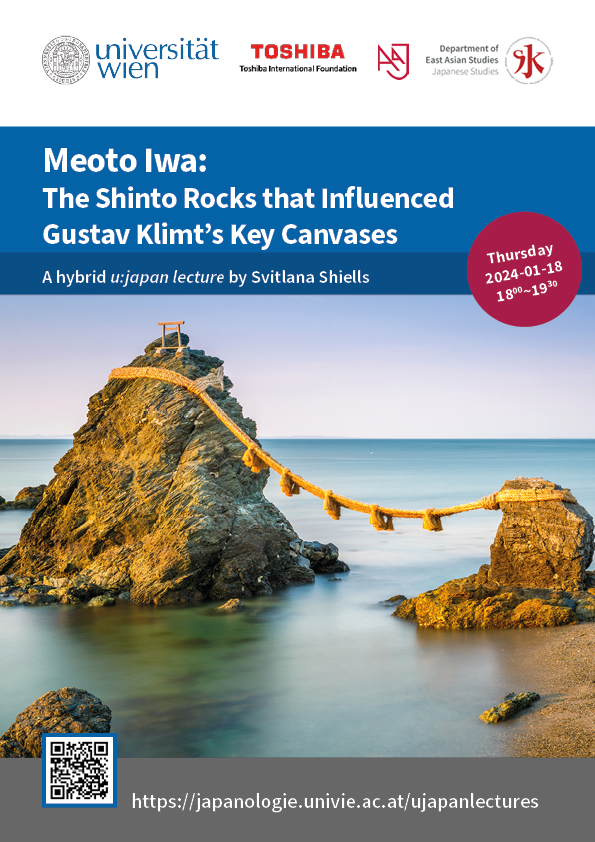 |
Season 7 | Autumn-Winter 2023/24 | s07e10 | 18/01/2024 | en | Svitlana Shiells | National Museum of Asian Art, Washington, D.C, USA | Svitlana Shiells, a former professor of art history, has taught at a number of universities in Ukraine, America, and Austria (among them University of Maryland, College Park, American University, Washington, D.C., George Mason University (GMU), Fairfax, VA, Webster University, and Vienna). She completed her studies, including a Ph. D. in art history, in Ukraine. Dr. Shiells has also worked as a Research Associate at the National Museum of Asian Art, Washington, D.C, where she was Director of the Washington Cultural Fund. The focus of her research is Japonisme in Eastern and Central European modern art. Dr. Shiells has published widely and presented her research at numerous lectures and seminars, for instance, at Harvard University, Tokyo University of the Arts, the College Art Association, the Library of Congress, the Salzburg Seminar, and other art museums, as well as at conferences in London, Tokyo, Paris, Barcelona, Chicago, Montreal, Baltimore, Salzburg, Washington, D.C., Kharkiv, Budapest, Lviv, etc. Dr. Shiells is a recipient of fellowships in the field of art in the U.S., Ukraine, and Japan. Currently, as an affiliated faculty of GMU, she is living in Vienna, Austria and working on a monograph on Japonisme in Gustav Klimt’s art. | Meoto Iwa: The Shinto Rocks that Influenced Gustav Klimt’s Key Canvases | The two rocks of the famous Shinto monument Meoto Iwa, a symbol of divine marriage, have inspired many Japanese and foreign visitors. One of those so inspired was Austrian art collector Adolf Fischer, who developed a strong interest in Japanese art after visiting the Weltausstellung 1873 in Vienna. In his book "Bilder aus Japan", Fischer offers an arresting description of Meoto Iwa, accompanied by a small illustration. Gustav Klimt, who had a close and productive relationship with Fischer, not only knew his book but also—and not without Fischer’s help—assembled his own collection of Japanese art. This paper argues that Fischer’s engaging account of Meoto Iwa in the book (as well as undoubtedly in his private conversations with the artist) inspired a series of Klimt’s key paintings. At first, the modified version of the two rocks of Meoto Iwa appeared in the second Portrait of Emilie Flöge (1902), Klimt’s life-long friend and companion.The two rocks of the famous Shinto monument Meoto Iwa, a symbol of divine marriage, have inspired many Japanese and foreign visitors. One of those so inspired was Austrian art collector Adolf Fischer, who developed a strong interest in Japanese art after visiting the Weltausstellung 1873 in Vienna. In his book "Bilder aus Japan", Fischer offers an arresting description of Meoto Iwa, accompanied by a small illustration. Gustav Klimt, who had a close and productive relationship with Fischer, not only knew his book but also—and not without Fischer’s help—assembled his own collection of Japanese art. This paper argues that Fischer’s engaging account of Meoto Iwa in the book (as well as undoubtedly in his private conversations with the artist) inspired a series of Klimt’s key paintings. At first, the modified version of the two rocks of Meoto Iwa appeared in the second Portrait of Emilie Flöge (1902), Klimt’s life-long friend and companion. A few years later, Klimt, an ardent adherent of Symbolism, return to the gripping symbolism of Meoto Iwa in his key work The Kiss (1908), placing an embraced coupled on top of a large rock. This research illuminates stylistic, iconographic, symbolic, and even thematic parallels between the two paintings. Klimt’s interest in Shinto symbolism continued until the end of his life. The highly synthesized rock-like ‘construction’ that encapsulates human bodies—similar to kami that occupy rocks—reappears in his subsequent paintings The Virgin (1913), Death and Life (1910-11), The Bride (1918), etc. Offering an analytical approach and, accordingly, critically reevaluating and reexamining prevailing concepts, this lecture illuminates not only Klimt’s interest in Shinto and its symbolism but also elucidates that without taking in account the role of Japonisme in Klimt’s oeuvre it is impossible to fully understand the intricacy of his complex art. | https://ustream.univie.ac.at/play/3cb63298-ce37-4c25-ab34-91e0402a1164 | usa | hybrid | https://japanologie.univie.ac.at/ujapanlectures/s07/#e10 | Arts (visual arts and performing arts) and Art History, History and Archaeology | Has Video | ||||||||
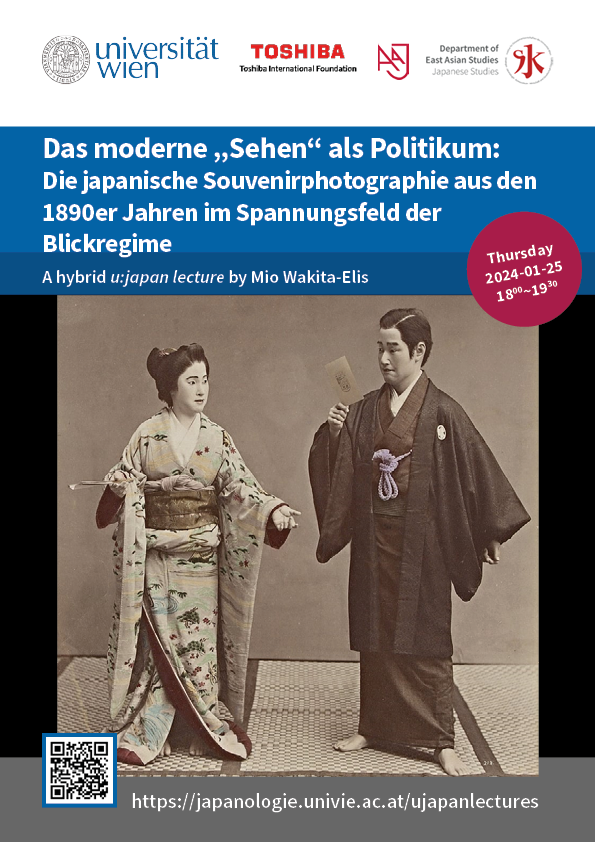 |
Season 7 | Autumn-Winter 2023/24 | s07e11 | 25/11/2024 | de | Mio Wakita-Elis | MAK – Museum für angewandte Kunst, Wien, Österreich | Dr. Mio Wakita-Elis ist Leiterin der Sammlung Asien und Kuratorin am Museum für angewandte Kunst in Wien (MAK). Nach ihrem Studium der Politikwissenschaft an der Keiō-Universität in Tokyo schloss sie das Studium der Europäische und Orientalische Kunstgeschichte sowie Japanologie an der Universität Köln und Universität Bonn ab. An der Universität Heidelberg hat sie in Japanischer Kunstgeschichte promoviert. Nach Forschungsaufenthalt am German Historical Institute in Washington D.C. und London sowie Forschungstätigkeit am Exzellenzcluster der Universität Heidelberg lehrte sie bis 2019 Japanische Kunstgeschichte am Institut für Kunstgeschichte Ostasiens in Heidelberg. Die von ihr kuratierten Sonderausstellungen mit Bezug zu Ostasien-relevanten Themen sind u.a. „Kuniyoshi+: Design und Entertainment im japanischen Farbholzschnitt“ (2019, zusammen mit J. Wieninger), „UKIYOENOW“ (2019, zusammen mit J. Wieninger), „FALTEN / FOLDS“ (2023) und „Wiener Weltausstellung 1873 Revisited: Ägypten und Japan als Europas “ (2023, mit J. Wieninger als wissenschaftlicher Berater). Die Schwerpunkte ihrer Forschung sind Kunst- und Designgeschichte Japans und Asiens im globalen Kontext, postkoloniale Geschichten asiatischer Kunst in Mitteleuropa, Provenienzforschung chinesischer und japanischer Sammlungen in Österreich, feministisch-postkoloniale Repräsentationskritik und visuelle und materielle Kultur Japans des 19., 20. und 21. Jahrhunderts | Das „Sehen“ als Politikum: die japanische Souvenirphotographie aus den 1890er Jahren im Spannungsfeld der Blickregime | In diesem Vortrag wird die Souvenirphotographie aus dem Yokohama der 1890er Jahre, die in dieser Zeit den Gipfel ihrer Popularität erreichte, aus dem Blickwinkel des modernen „Sehens“ untersucht. Im 19. Jahrhundert, einer Epoche, in der eine Vielzahl neuer gesellschaftlicher Phänomene auftraten, wurden neue Sehgewohnheiten zu einem festen Bestandteil des modernen Lebens, in dem u.a. das künstliche Licht und neue Fortbewegungsmittel die Wahrnehmung der Welt entscheidend transformierten. In verschiedenen Feldern wie visuelle Kultur, Unterhaltungsindustrie, Kulturpolitik und Ausstellungswesen veränderte sich darüber hinaus der Prozess des Sehens, das teils ideologisch aufgeladen wurde. Die visuellen Souvenire aus dem Meiji-zeitlichem Japan, die in diesem Umfeld entstanden sind, stellen daher ein besonderes Format interkultureller Begegnung dar, bei denen Machtverhältnisse durch Fotografien zu Tage treten und spezielle Blickregime sichtbar werden. Der Vortrag beleuchtet die Zentralität des Phänomens des (modernen) Sehens für die Meiji-zeitliche Souvenirphotographie, und geht auf die enge Verbindung zwischen der Souvenirphotographie-Industrie, dem Globetrotter-Tourismus, der Unterhaltungsindustrie, den Völkerschauen, dem Ausstellungswesen und der Rationalisierung des Sehens ein. Mit diesem Ansatz zeigt der Vortrag eine neue Perspektive für die Analyse der kommerziellen Photographie der späten Meiji-Zeit auf. | at | hybrid | https://japanologie.univie.ac.at/ujapanlectures/s07/#e11 | Arts (visual arts and performing arts) and Art History, History and Archaeology | ||||||||||
| Language | Discipline | Methodology | Keywords | Filter |
Poster:
ID:
Date:
Language:
Name:
Affiliation:
Biographie:
Lecture Title:
Abstract:
Video:
Research Question:
Discipline:
Methodology:
Keywords:
Primary Material:
Literature:
Material:
